ProSoft Technology IHN RLXIB-IHN, RLXIB-IHN-W, RLXIB-IHN-WC, RLXIB-IH2N, RLXIB-IH2N-W, & RLXIB-ICN User Manual RLXIB IHN User Manual
ProSoft Technology, Inc RLXIB-IHN, RLXIB-IHN-W, RLXIB-IHN-WC, RLXIB-IH2N, RLXIB-IH2N-W, & RLXIB-ICN RLXIB IHN User Manual
Contents
- 1. User Manual
- 2. Updated User Manual
User Manual
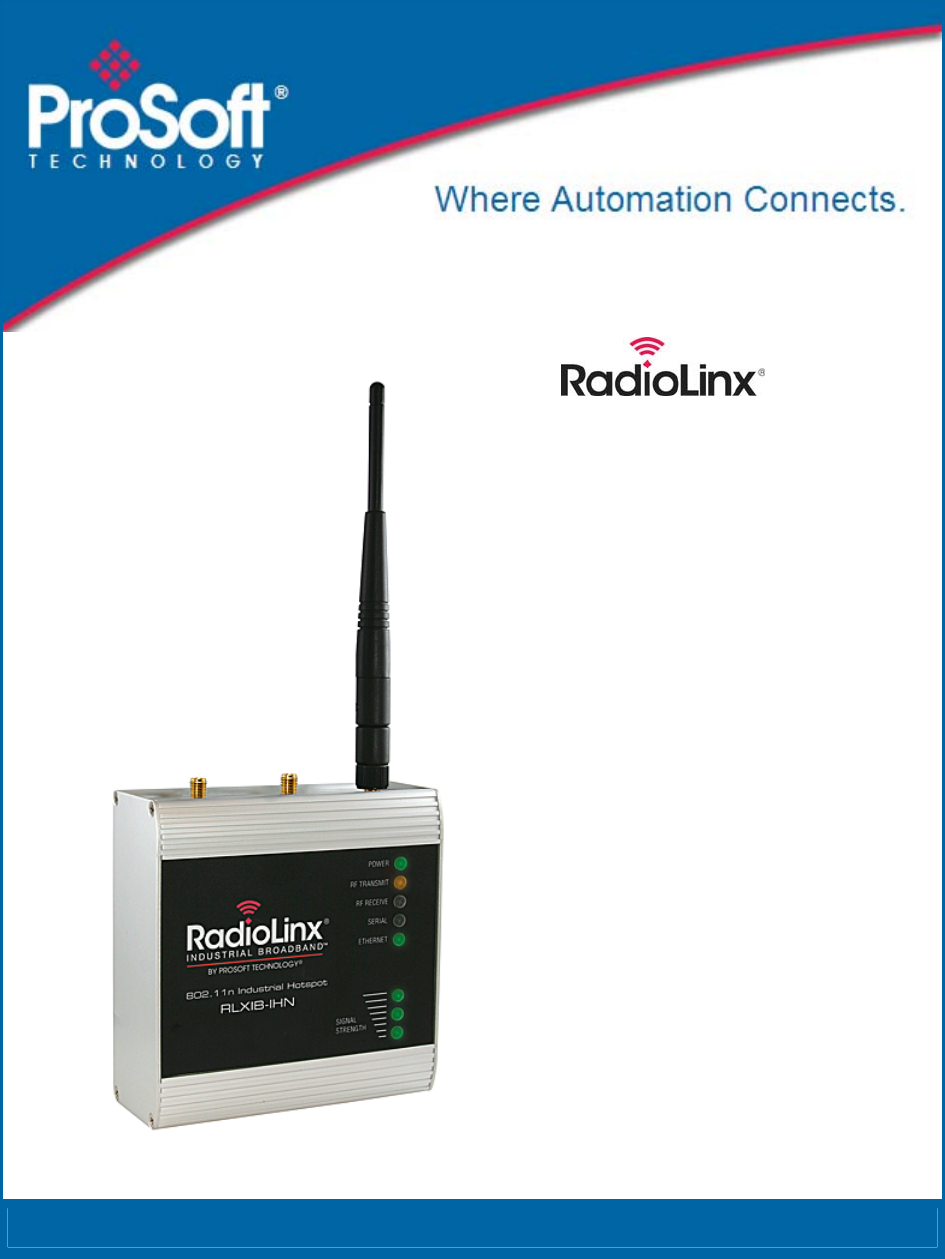
RLXIB-IHN
802.11n
Industrial Hotspot
April 8, 2011
USER MANUAL
Your Feedback Please
We always want you to feel that you made the right decision to use our products. If you have suggestions, comments,
compliments or complaints about our products, documentation, or support, please write or call us.
How to Contact Us
ProSoft Technology
5201 Truxtun Ave., 3rd Floor
Bakersfield, CA 93309
+1 (661) 716-5100
+1 (661) 716-5101 (Fax)
www.prosoft-technology.com
support@prosoft-technology.com
Copyright © 2011 ProSoft Technology, Inc., all rights reserved.
RLXIB-IHN User Manual
April 8, 2011
ProSoft Technology ®, ProLinx ®, inRAx ®, ProTalk ®, and RadioLinx ® are Registered Trademarks of ProSoft
Technology, Inc. All other brand or product names are or may be trademarks of, and are used to identify products
and services of, their respective owners.
ProSoft Technology® Product Documentation
In an effort to conserve paper, ProSoft Technology no longer includes printed manuals with our product shipments.
User Manuals, Datasheets, Sample Ladder Files, and Configuration Files are provided on the enclosed CD-ROM,
and are available at no charge from our web site: www.prosoft-technology.com
Important Safety Information
The following Information and warnings pertaining to the radio module must be heeded:
WARNING – EXPLOSION HAZARD – DO NOT REPLACE ANTENNAS UNLESS POWER HAS BEEN SWITCHED
OFF OR THE AREA IS KNOWN TO BE NON-HAZARDOUS.
"THIS DEVICE CONTAINS A TRANSMITTER MODULE, FCC ID: . PLEASE SEE FCC ID LABEL ON BACK OF
DEVICE."
"THIS DEVICE USES AN INTERNAL COMPACT FLASH RADIO MODULE AS THE PRIMARY RADIO
COMPONENT. THE COMPACT FLASH RADIO MODULE DOES NOT HAVE AN FCC ID LABEL. THE COMPACT
FLASH RADIO MODULE HAS NO USER SERVICEABLE PARTS."
"THIS DEVICE COMPLIES WITH PART 15 OF THE FCC RULES. OPERATION IS SUBJECT TO THE FOLLOWING
TWO CONDITIONS: (1) THIS DEVICE MAY NOT CAUSE HARMFUL INTERFERENCE, AND (2) THIS DEVICE
MUST ACCEPT ANY INTERFERENCE RECEIVED, INCLUDING INTERFERENCE THAT MAY CAUSE
UNDESIRED OPERATION."
"CHANGES OR MODIFICATIONS NOT EXPRESSLY APPROVED BY THE PARTY RESPONSIBLE FOR
COMPLIANCE COULD VOID THE USER’s AUTHORITY TO OPERATE THE EQUIPMENT."
Industry Canada Requirements:
"THIS DEVICE HAS BEEN DESIGNED TO OPERATE WITH AN ANTENNA HAVING A MAXIMUM GAIN OF 24 dB.
AN ANTENNA HAVING A HIGHER GAIN IS STRICTLY PROHIBITED PER REGULATIONS OF INDUSTRY
CANADA. THE REQUIRED ANTENNA IMPEDANCE IS 50 OHMS."
"TO REDUCE POTENTIAL RADIO INTERFERENCE TO OTHER USERS, THE ANTENNA TYPE AND ITS GAIN
SHOULD BE CHOSEN SUCH THAT THE EQUIVALENT ISOTROPICALLY RADIATED POWER (EIRP) IS NOT
MORE THAN THAT REQUIRED FOR SUCCESSFUL COMMUNICATION."
"THE INSTALLER OF THIS RADIO EQUIPMENT MUST INSURE THAT THE ANTENNA IS LOCATED OR
POINTED SUCH THAT IT DOES NOT EMIT RF FIELD IN EXCESS OF HEALTH CANADA LIMITS FOR THE
GENERAL POPULATION; CONSULT SAFETY CODE 6, OBTAINABLE FROM HEALTH CANADA."

Recommended Antennas
Part Number Max
Gain
Part number Max gain Part Number Max gain
A2503S6-O 3 dBi A2406S3-DP 6 dBi A5017NJ3-DP 17 dBi
A2408NJ-DP 8 dBi A2419NJ-DP 19 dBi A5024NJ-DP 24 dBi
A2506NJ6-0 6 dBi A2503S6-O 3 dBi A2412NJ3-DP 12 dBi
A5007S3-DP 7 dBi A2415NJ-OC 15 dBi A082503-80-OBH 3 dBi
A2402S-OS 2 dBi A2402S-OSLP 2 dBi A2403NBH-OC 3 dBi
A2404NBHW-OC 4 dBi A2404NJ-OC 4 dBi A2405S-OA 5 dBi
A2405S-OM 5 dBi A2405S-OS 5 dBi A2406NJ-OC 6 dBi
A2406NJ-OCD 6 dBi A2408NJ-OC 8 dBi A2409NJ-OCD 9 dBi
A2502S-OA 2 dBi A2504S-OA 4 dBi A2506NJ-OC 6 dBi
A5003S-OBH 3 dBi A5006NJ-OC 6 dBi A5009NJ-OC 9 dBi
A2508NJ-DP 8 dBi A2413NJ-DP 13 dBi A2416NJ-DS 16 dBi
A5019NJ-DP 19 dBi A2419NJ-DB 19 dBi A2424NJ-DB 24 dBi
A5829NJ-DB 29 dBi A2410NJ-DY 10 dBi A2415NJ-DY 15 dBi
A5812NJ-OC 12 dBi
An adapter may be needed for some of the listed antennas to operate with the specified radio.
Antenna spacing requirements for user safety
It is important to keep the radio's antenna a safe distance from the user. To meet the requirements of FCC part
2.1091 for radio frequency radiation exposure, this radio must be used in such a way as to guarantee at least 20 cm
between the antenna and users. Greater distances are required for high-gain antennas. The FCC requires a
minimum distance of 1 mW *cm2 power density from the user (or 20 cm, whichever is greater).
If a specific application requires proximity of less than 20 cm, the application must be approved through the FCC for
compliance to part 2.1093.
Agency Approvals and Certifications
Wireless Approvals
Visit our web site at www.prosoft-technology.com for current wireless approval information.
Hazardous Locations
ANSI/ISA 12.12.01 Groups A, B, C, D
UL/cUL C22.2 No. 213-M1987
ATEX EN60079-0 and EN60079-15
Ordinary Locations
CSA/CB EN60950 N. America & W. Europe
FCC/IC Part 15, Class A and ICES-003
ETSI ETSI EN300 328 and ETSI EN301 893

CSA C22.2 213-M1987 and N. American Standard ANSI/ISA 12.12.01 listing
In accordance with Canadian Standard CSA C22.2 213-M1987 and ANSI Standard ISA 12.12.01, the RLXIB-IHN
radios have been UL listed for operation in Class I, Division 2, Groups A, B, C, and D Locations.
THIS EQUIPMENT IS SUITABLE FOR USE IN CLASS I, DIVISION 2, GROUPS A, B, C, AND D, HAZARDOUS
LOCATIONS ONLY IF INSTALLED IN AN APPROVED ENCLOSURE AND POWERED BY A CLASS 2 POWER
SUPPLY.”Limited Power Source”.
WARNING: EXPLOSION HAZARD! SUBSTITUTION OF ANY COMPONENTS MAY IMPAIR SUITABILITY FOR
CLASS I, DIVISION 2.
WARNING – EXPLOSION HAZARD – Do not disconnect equipment unless power has been removed or the area is
known to be non-hazardous.
AVERRTISSEMENT - RISQUE D'EXPLOSION - LA SUBSTITUTION DE COMPOSANTS PEUT RENDRE CE
MATERIEL INACCEPTABLE POUR LES EMPLACEMENTS DE CLASSE I, DIVISION 2.
WARNING: EXPLOSION HAZARD! DO NOT DISCONNECT EQUIPMENT UNLESS POWER HAS BEEN
SWITCHED OFF OR THE AREA IS KNOWN TO BE NON HAZARDOUS.
AVERRTISSEMENT - RISQUE D'EXPLOSION - AVANT DE DECONNECTER L'EQUIPEMENT, COUPER LE
COURANT OU S'ASSURER QUE L'EMPLACEMENT EST DESIGNE NON DANGERUEX.
This radio has been designed to operate with the Omnidirectional Multi-Band Articulating Antenna, model A2502S-
OA and having a maximum gain of 3dBi @ 2.4GHz and 4dBi @ 5.0GHz. Antennas not listed herein having a gain
greater than that listed are strictly prohibited. The required antenna impedance is 50ohms nominal. This statement is
in accordance with RSS-Gen Section 7.1.4.
The following label is applied to the radio to indicate that it is listed under ANSI/ISA standard 12.12.01 and CSA
standard C22.2 213-M1987.
Conforms to ANSI/ISA Std. 12.12.01 – Certified to CSA Std. C22.2 No. 213-M1987
Class I Division 2 10-24 Volts DC 6 Watts
48 Volts DC using the PoE Injector
Groups A, B, C & D
Max. Ambient: 60ºC
ATEX Approval
II 3 G
Ex nA nL IIC X
-30° C <= Ta <= 60° C
ProSoft Technology, Inc., Bakersfield, CA USA
Model: RLXIB
S/N: XXXXXXXXXX
Caution: Read instructions before operating in Hazardous Areas
N. America
All RLXIB 802.11n radios must be installed inside an IP54 enclosure which requires a special tool for access; except
the RLXIB-IH2N-W, which is made so that no special enclosure is required for this specific model.
Explosive Atmosphere
Power, Input, and Output (I/O) wiring must be in accordance with the authority having jurisdiction
A Warning – Explosion Hazard – Do not make or break connections in an explosive atmosphere.
B Caution – Use only approved recommended power supply.
C Warning - Power supply should be installed in a non-hazardous area.
D Warning – DO NOT OPEN WHEN ENERGIZED.

E These products are intended to be mounted in an IP54 enclosure. The devices shall provide external means to
prevent the rated voltage being exceeded by transient disturbances of more than 40%. This device must be used
only with ATEX certified backplanes.
United States FCC & Industry Canada rules
Note: This equipment has been tested and found to comply with the limits for a Class A digital device, pursuant to
Part 15 of the FCC Rules. These limits are designed to provide reasonable protection against harmful interference
when the equipment is operated in a commercial environment. This equipment generates, uses, and can radiate
radio frequency energy and, if not installed and used in accordance with the instruction manual, may cause harmful
interference to radio communications. Operation of this equipment in a residential area is likely to cause harmful
interference in which case the user will be required to correct the interference at his own expense.
This device complies with Part 15 of the FCC Rules. Operation is subject to the following two conditions: The device
may not cause harmful interference, and it must accept any interference received, including interference that may
cause undesired operation.
This Class A digital apparatus complies with Canadian ICES-003.
Cet appareil numérique de la classe A est conforme à la norme NMB-003 du Canada.
CAUTION: Changes or modifications not expressly approved by the manufacturer could void the user’s authority to
operate the equipment.

European CE certification
The radio modem has been approved for operation under the RTT&E directive, passing the following tests: ETS300-
826 (EMC), ETS300-328 (Functionality), and EN60950 (Safety).
The following is the appropriate label that is applied to the radio modem product line to indicate the unit is approved
to operate with CE certification:
The following is the appropriate label that is applied to the radio modem product line shipping package to indicate the
unit is approved to operate with CE certification:
AUS B DK FIN
F D GR IRE
I LUX NL P
E S UK
Note: Member states in the EU with restrictive use for this device are crossed out. This device is also authorized for
use in all EFTA member states (CH, ICE, LI, and NOR).
EU Requirements
1. For outdoor use, France has a frequency restriction of 2.4 GHz to 2.454 GHz for an output power greater than 10
mW and below 100 mW.
2. For outdoor use in France, the output power is restricted to 10 mW in the frequency range of 2.454 GHz to 2.4835
GHz.
3. 5.15 GHz to 5.35 GHz is restricted to 200 mW EIRP throughout the European Union.
Power Supply and Accessories Warning
The certifications listed in this document apply to only the radio mentioned herein. These certifications do not extend
to any other items, including accessories or any external means of supplying power to the radio. Accessories and
power supplies shipped with the radio have not been tested and are not covered by these certifications. Any non-
certified items added to the radio, including any means of supplying power, must be located in an area known to be
non-hazardous. All wiring to and from the Power-over-Ethernet (PoE) injector supplied with the radio must be routed
and installed inside the building or plant and never routed or installed outside of the building or plant.

RLXIB-IHN ♦ 802.11n Contents
Industrial Hotspot User Manual
ProSoft Technology, Inc. Page 9 of 171
May 23, 2011
Contents
Your Feedback Please........................................................................................................................2
How to Contact Us ..............................................................................................................................2
ProSoft Technology® Product Documentation....................................................................................2
Important Safety Information...............................................................................................................3
Antenna spacing requirements for user safety ...................................................................................4
Agency Approvals and Certifications ..................................................................................................4
CSA C22.2 213-M1987 and N. American Standard ANSI/ISA 12.12.01 listing .................................5
ATEX Approval ...................................................................................................................................5
United States FCC & Industry Canada rules ......................................................................................6
European CE certification ...................................................................................................................7
EU Requirements................................................................................................................................7
Power Supply and Accessories Warning............................................................................................7
1Start Here 13
1.1About the RadioLinx® RLXIB-IHN ...........................................................................14
1.1.1Radio Specifications................................................................................................ 15
1.1.2Agency Approvals & Certifications ..........................................................................16
1.2Package Contents ................................................................................................... 17
1.3System Requirements .............................................................................................18
1.4Install the WirelessN Discovery Tool....................................................................... 19
1.5Install ProSoft Wireless Designer............................................................................20
1.6Planning the Network ..............................................................................................21
1.6.1Installation Questions .............................................................................................. 22
1.6.2ProSoft Wireless Designer ...................................................................................... 22
1.6.3Planning the Physical Installation............................................................................23
1.7Configuring the Radios............................................................................................24
1.7.1Personality Module..................................................................................................25
1.7.2Start WirelessN Discovery Tool ..............................................................................25
1.7.3Plug In the Cables ................................................................................................... 26
1.7.4Detecting the Radio................................................................................................. 27
1.7.5Assign an IP Address ..............................................................................................28
1.7.6Set up the Master Radio..........................................................................................29
1.7.7Save the Radio Configuration .................................................................................32
1.7.8Set the Date and Time ............................................................................................32
1.7.9Set up a Repeater ...................................................................................................33
1.7.10Set up a Client.........................................................................................................35
1.8Verify Communication .............................................................................................36
2Installing the Radios 37
2.1Connecting antennas ..............................................................................................39
2.1.1Using Multiple Antennas (MIMO) ............................................................................39
2.2Test the Network Installation Plan...........................................................................40
3Diagnostics and Troubleshooting 41
3.1Diagnostics..............................................................................................................42
3.2Check the Ethernet cable........................................................................................43
3.3LED display .............................................................................................................44

Contents RLXIB-IHN ♦ 802.11n
User Manual Industrial Hotspot
Page 10 of 171 ProSoft Technology, Inc.
May 23, 2011
3.4Retrieve the Default Password ............................................................................... 45
3.5Troubleshoot missing radios................................................................................... 46
3.6Improve signal quality ............................................................................................. 47
3.6.1Understanding Signal to Noise Ratio...................................................................... 47
4RadioLinx Configuration Manager 49
4.1Login ....................................................................................................................... 52
4.1.1Login User Name and Password ............................................................................ 52
4.1.2Session Timeout ..................................................................................................... 52
4.2Configuration........................................................................................................... 53
4.2.1Overall..................................................................................................................... 53
4.2.2Radio 1.................................................................................................................... 55
4.2.3IPv6 Configuration .................................................................................................. 58
4.2.4Radio Configuration ................................................................................................ 59
4.2.5Security Configuration ............................................................................................ 61
4.2.6Parent Selection ..................................................................................................... 64
4.2.7RSTP Configuration................................................................................................ 68
4.2.8VLAN Configuration ................................................................................................ 72
4.2.9IGMP / Multicast Configuration ............................................................................... 78
4.2.10Access Configuration.............................................................................................. 80
4.2.11SNMP Configuration ............................................................................................... 81
4.3Diagnostics ............................................................................................................. 86
4.3.1Radio Status ........................................................................................................... 86
4.3.2Address Table......................................................................................................... 87
4.3.3Statistics.................................................................................................................. 87
4.3.4Child Links .............................................................................................................. 88
4.3.5802.11 Traffic.......................................................................................................... 89
4.3.6Tools ....................................................................................................................... 90
4.4Utilities .................................................................................................................... 93
4.4.1Saving and Restoring Settings ............................................................................... 93
4.4.2Factory Reset.......................................................................................................... 96
4.4.3Rebooting the Radio ............................................................................................... 99
4.4.4Upload................................................................................................................... 100
4.4.5View Event Logs ................................................................................................... 105
4.4.6Logs Settings ........................................................................................................ 105
5WirelessN Discovery Tool 107
5.1View the List of Detected Radios.......................................................................... 108
5.2View Radio Network Diagram(s)........................................................................... 109
5.3Configure Radios .................................................................................................. 110
5.4Scan the Network ................................................................................................. 111
5.5Save and Load Snapshots.................................................................................... 112
5.6Event Log.............................................................................................................. 113
5.7Firewall Requirements .......................................................................................... 114
5.8Radio List .............................................................................................................. 115
5.9Topology View ...................................................................................................... 116
5.9.1Display tools.......................................................................................................... 118
5.9.2View Radio Details................................................................................................ 119
5.9.3Download Radio Settings ..................................................................................... 119
5.9.4Upload Radio Settings .......................................................................................... 120
5.9.5Upgrade Radio Firmware...................................................................................... 120

RLXIB-IHN ♦ 802.11n Contents
Industrial Hotspot User Manual
ProSoft Technology, Inc. Page 11 of 171
May 23, 2011
5.9.6Right click Context Menu.......................................................................................121
5.10Radio Detailed View..............................................................................................122
5.10.1Summary ...............................................................................................................122
5.10.2Radio # ..................................................................................................................124
5.10.3Ethernet Devices ...................................................................................................126
5.10.4Bridges ..................................................................................................................127
5.11Discovery Tool Menus and Toolbars.....................................................................128
5.11.1File Menu...............................................................................................................128
5.11.2Scan Menu ............................................................................................................128
5.11.3View Menu.............................................................................................................129
5.11.4Help Menu .............................................................................................................130
5.11.5Toolbars.................................................................................................................130
6Reference 133
6.1Product Overview ..................................................................................................134
6.2Radio hardware .....................................................................................................136
6.2.1Radio Power Requirements ..................................................................................136
6.2.2Ethernet Cable Specifications ...............................................................................137
6.2.3Ethernet Cable Configuration................................................................................137
6.3Antennas ...............................................................................................................138
6.3.1Antenna Pattern ....................................................................................................138
6.3.2Antenna Gain ........................................................................................................139
6.3.3Antenna Polarity ....................................................................................................139
6.3.4Whip antennas ......................................................................................................140
6.3.5Collinear array antennas .......................................................................................140
6.3.6Yagi Array Antenna ...............................................................................................141
6.3.7Parabolic reflector antennas .................................................................................142
6.3.8Antenna location, spacing, and mounting .............................................................143
7Support, Service & Warranty 145
Contacting Technical Support.........................................................................................................145
7.1Return Material Authorization (RMA) Policies and Conditions..............................147
7.1.1Returning Any Product ..........................................................................................147
7.1.2Returning Units Under Warranty ...........................................................................148
7.1.3Returning Units Out of Warranty ........................................................................... 148
7.2LIMITED WARRANTY...........................................................................................149
7.2.1What Is Covered By This Warranty.......................................................................149
7.2.2What Is Not Covered By This Warranty ................................................................150
7.2.3Disclaimer Regarding High Risk Activities ............................................................150
7.2.4Intellectual Property Indemnity..............................................................................151
7.2.5Disclaimer of all Other Warranties ........................................................................151
7.2.6Limitation of Remedies **......................................................................................152
7.2.7Time Limit for Bringing Suit ...................................................................................152
7.2.8No Other Warranties .............................................................................................152
7.2.9Allocation of Risks .................................................................................................152
7.2.10Controlling Law and Severability........................................................................... 153

Contents RLXIB-IHN ♦ 802.11n
User Manual Industrial Hotspot
Page 12 of 171 ProSoft Technology, Inc.
May 23, 2011
Glossary of Terms 155
Index 169

RLXIB-IHN ♦ 802.11n Start Here
Industrial Hotspot User Manual
ProSoft Technology, Inc. Page 13 of 171
May 23, 2011
1 Start Here
In This Chapter
About the RadioLinx® RLXIB-IHN.......................................................... 14
Package Contents .................................................................................17
System Requirements ...........................................................................18
Install the WirelessN Discovery Tool .....................................................19
Install ProSoft Wireless Designer ..........................................................20
Planning the Network ............................................................................21
Configuring the Radios..........................................................................24
Verify Communication ...........................................................................36
For most applications, the installation and configuration steps described in the
following topics will work without additional programming. ProSoft Technology
strongly recommends that you complete the steps in this chapter before
developing a custom application.

Start Here RLXIB-IHN ♦ 802.11n
User Manual Industrial Hotspot
Page 14 of 171 ProSoft Technology, Inc.
May 23, 2011
1.1 About the RadioLinx® RLXIB-IHN
The RadioLinx 802.11n Industrial Hotspot series provides enterprise-class
technology, optimized for rugged industrial performance and easy deployment in
the field. These 802.11n Hotspots use multiple-input/multiple-output (MIMO)
technology supporting up to 3 antennas. This allows fast data rates up to
300Mbps with EtherNet/IP Requested Packet Interval (RPI) times as low as 2
ms. The Dual Radio (RLXIB-IH2N) is a great selection for use as a repeater
maintaining full bandwidth from each radio, repeating traffic without sacrificing
speed.
More than just a new 802.11 technology, the RLXIB-IHN family adds RADIUS
security for centralized management of security policies, VLANs for network
traffic segmentation, and data prioritization while continuing to include the
industrial wireless features that have made previous Industrial Hotspots
successful.

RLXIB-IHN ♦ 802.11n Start Here
Industrial Hotspot User Manual
ProSoft Technology, Inc. Page 15 of 171
May 23, 2011
1.1.1 Radio Specifications
Frequency Band Frequency Channel
(Varies by country) 2.412 GHz to 2.462 GHz (FCC)
2.412 GHz to 2.472 GHz (ETSI)
1-11
1-13
5.150 GHz to 5.250 GHz
(FCC/ETSI)
5.250 GHz to 5.350 GHz
(FCC/ETSI)
5.470 GHz to 5.725 GHz
(FCC/ETSI)
5.725 GHz to 5.850 GHz (FCC)
36 - 48
52 - 64
100 - 140
149 - 165
Wireless Standards 802.11n, 802.11h, 802.11i,
802.11a, 802.11g (Legacy)
Transmit Power (Programmable)
*Subject to Regional Regulatory
Limits
22 dBm @ MCS0, MCS8 (802.11an/gn)
17 dBm @ MCS7, MCS15 (802.11an/gn)
22 dBm @ 6 Mbps (802.11a/g)
17 dBm @ 54 Mbps (802.11a/g)
Antenna Impact:
3 Antennas/ MIMO: Use values above
2 Antennas: Subtract 3 dB from values above
1 Antenna: Subtract 5 dB from values above
Channel data rates (802.11n) MCS0 – MCS15, 1-2 Channels & 1-2 Streams
1 Channel 2 Channels Rate Streams
7 Mbps 15 Mbps MCS0 1 Stream
72 Mbps 150 Mbps MCS7
14 Mbps 30 Mbps MCS8 2 Streams
144 Mbps 300 Mbps MCS1
5
Channel data rates (802.11a/g) 802.11a/g: 54, 48, 36, 24, 18, 12, 9, 6 Mbps
Receiver Sensitivity (Typical) -92 dBm @ MCS0, MCS8 (802.11an/gn)
-70 dBm @ MCS7, MCS15 (802.11an)
-74 dBm @ MCS7, MCS15 (802.11gn)
-92 dBm @ 6 Mbps (802.11an/gn)
-74 dBm @ 54 Mbps (802.11a)
-78 dBm @ 54 Mbps (802.11g)
Security WPA2 Enterprise – 802.11i AES w/ RADIUS
WPA2 Personal – 802.11i AES w/ Passphrase
Legacy WPA TKIP, WEP support
MAC ID filter

Start Here RLXIB-IHN ♦ 802.11n
User Manual Industrial Hotspot
Page 16 of 171 ProSoft Technology, Inc.
May 23, 2011
Physical
Enclosure Extruded aluminum with DIN and panel mount
Size 115 x 117 x 45 mm (W x H x D)
4.5 x 4.6 x 1.75 inches
Vibration IEC 60068 2-6 (20g, 3-Axis)
Shock IEC 60068 2-27 (5g, 10 Hz to 150 Hz)
Ethernet Ports One 10/100 Base-T connector, shielded RJ45
IEEE 802.3, 802.3u, 802.3x
Antenna Port (3) RP-SMA connector
Personality Module Industrial SD Memory Module
Weight 1.1 lbs (499 g)
Environmental
Operating Temperature -40°C to +75°C
Humidity Up to 100% RH, with no condensation
External Power
PoE Injector
10 Vdc to 24 Vdc
802.3af PoE Powered Device
Average Power <9W
1.1.2 Agency Approvals & Certifications
Wireless Approvals
Visit our web site at www.prosoft-technology.com for current wireless approval information.
Hazardous Locations
ANSI/ISA 12.12.01 groups A, B, C, D
CSA C22.2 No. 213-M1987
ATEX EN60079-0 and EN60079-15
Ordinary Locations
CSA/CB EN60950 N. America & W. Europe
FCC/IC Part 15, Class A and ICES-03
ETSI ETSI EN300 328 and ETSI EN301 893

RLXIB-IHN ♦ 802.11n Start Here
Industrial Hotspot User Manual
ProSoft Technology, Inc. Page 17 of 171
May 23, 2011
1.2 Package Contents
The following components are included with your RLXIB-IHN radio, and are all
required for installation and configuration.
Important: Before beginning the installation, please verify that all of the following items are
present.
Qty. Part Name Part Number Part Description
1 RLXIB-IHN Radio RLXIB-IHN Industrial Hotspot
1 Cable 085-1007 6 foot RS232 serial cable
1 Cable RL-CBL025 5 foot Ethernet Straight-Thru Cable (Gray)
1 Antenna A2502S-OA 2 dBi Omni RP-SMA articulating, 2.4/5GHz
1 Power Supply RL-PS005-2 AC Power Adapter, 12V1.25A w/2 pin & 4
plug Set
1 ProSoft Solutions CD Contains sample programs, utilities and
documentation for the RLXIB-IHN module.
If any of these components are missing, please contact ProSoft Technology
Support for replacement parts.

Start Here RLXIB-IHN ♦ 802.11n
User Manual Industrial Hotspot
Page 18 of 171 ProSoft Technology, Inc.
May 23, 2011
1.3 System Requirements
The RadioLinx WirelessN Discovery Tool is designed for the following Microsoft
Windows versions:
Microsoft Windows XP,
Microsoft Windows 2000
Microsoft Windows 2003
Microsoft Windows Vista
Microsoft Windows 7
Minimum hardware requirements are:
Pentium® II 450 MHz minimum. Pentium III 733 MHz (or better)
recommended
Supported operating systems:
o Microsoft Windows XP Professional with Service Pack 1 or 2
o Microsoft Windows 2000 Professional with Service Pack 1, 2, or 3
o Microsoft Windows Server 2003
o Microsoft Windows Vista
128 Mbytes of RAM minimum, 256 Mbytes of RAM recommended
CD-ROM drive
100 MB available hard drive space
Available RS-232 serial port and null modem cable
256-color VGA graphics adapter, 800 x 600 minimum resolution (True Color
1024 x 768 recommended)
Ethernet hub with standard RJ45 Ethernet cable
or
Ethernet port with RJ45 crossover cable for direct connection to module
A web browser, for example Microsoft Internet Explorer or Firefox
In addition, you will need
A connection to an existing wired or wireless Ethernet network, with a Static
or Dynamic IP address for your computer
Obtain from your system administrator an IP address, Subnet Mask and
Gateway address for each RadioLinx device you plan to install

RLXIB-IHN ♦ 802.11n Start Here
Industrial Hotspot User Manual
ProSoft Technology, Inc. Page 19 of 171
May 23, 2011
1.4 Install the WirelessN Discovery Tool
1 Insert the ProSoft Solutions CD in your CD-ROM drive. On most computers,
a menu screen will open automatically. If you do not see a menu within a few
seconds, follow these steps:
a Click the Start button, and then choose Run.
b In the Run dialog box, click the Browse button.
c In the Browse dialog box, click "My Computer". In the list of drives,
choose the CD-ROM drive where you inserted the ProSoft Solutions CD.
d Select the file prosoft.exe, and then click Open.
e On the Run dialog box, click OK.
2 On the CD-ROM menu, select WIRELESSN DISCOVERY TOOL. This action
opens the Setup Wizard for WirelessN Discovery Tool.
3 Follow the instructions on the installation wizard to install the program with its
default location and settings.
4 When the installation finishes, you may be prompted to restart your computer
if certain files were in use during installation. The updated files will be
installed during the restart process.

Start Here RLXIB-IHN ♦ 802.11n
User Manual Industrial Hotspot
Page 20 of 171 ProSoft Technology, Inc.
May 23, 2011
1.5 Install ProSoft Wireless Designer
1 On the CD-ROM, navigate to the folder containing ProSoft Wireless
Designer, and then double-click the file SETUP.EXE. This action starts the
installation wizard.
2 Follow the instructions on the installation wizard to install the program.
3 Click FINISH to complete the installation. If you are prompted to restart your
computer, save your work in any applications that are running, close the
applications, and allow the computer to restart.

RLXIB-IHN ♦ 802.11n Start Here
Industrial Hotspot User Manual
ProSoft Technology, Inc. Page 21 of 171
May 23, 2011
1.6 Planning the Network
Before you configure and install the network, you should create a plan for it. The
following points assume that you are creating a bridge network of a master and
repeaters, as needed, to work with devices on existing wireless LANs.
The simplest way to design the physical network of radios, antennas, connectors,
cables, amplifiers and other accessories, is to use ProSoft Wireless Designer
(page 22). This application determines your hardware needs based on your
answers to a few questions, and then generates a Bill of Materials specifying all
the components you will need for your installation.
To begin, determine where you need radios and then choose locations for
them accordingly. For example, you might decide to install your master radio
near a PC in a central plant location (You can use the PC to configure the
radios through the RadioLinx Configuration Manager). If the plant is an oil
refinery, for example, you might decide to install radios near the oil tanks.
The next important issue is how to link the radios. Unless the radios are very
close together, you must make sure that each pair of radio antennas in the
network has a line of sight between them. In other words, you must be able to
see from one antenna to another, either with the naked eye, or with
binoculars.
If a line of sight does not exist between antennas, you must choose a site for
installing a repeater radio, which will create a bridge between the radio
antennas.
Choose the appropriate antennas for the network. If an antenna will be
connected to the radio by a long cable, you might need to purchase a power
amplifier, which is available from ProSoft Technology. The more distance
between an antenna and its radio, the more signal loss the radio will have.
For more information, see Antennas (page 138).
Consider drawing up your network plans on paper. As part of the drawing,
you should assign a logical name to each radio. You can use these names
later when configuring the radios in the RadioLinx Configuration Manager.
As part of your planning, you might want to conduct a site survey. ProSoft
Technology can perform this survey, you can do it yourself, or you can hire a
surveyor.
Protect radios from direct exposure to weather, and provide an adequate,
stable power source. Make sure that your plan complies with the radio’s
power requirements and cable specifications (page 137, page 137).
Important: Radios and antennas must be located at least 8 inches (20 cm) away from personnel.

Start Here RLXIB-IHN ♦ 802.11n
User Manual Industrial Hotspot
Page 22 of 171 ProSoft Technology, Inc.
May 23, 2011
1.6.1 Installation Questions
Answer the following questions to make your installation easier and to familiarize
yourself with your system and what you want to do.
How many radios in your network?
Master ID
Repeater ID
Client ID
Locations
Is there a Line of Sight between them?
Selected the appropriate antennas for
your network?
1.6.2 ProSoft Wireless Designer
ProSoft Wireless Designer simplifies the task of specifying a ProSoft Wireless
installation, and provides a variety of views containing an accurate description of
each site in a wireless network, including:
Visual diagram of site layout
Location (latitude/longitude, based on GPS coordinates)
Radio type, frequency range, and country-specific channel and power
requirements
Length, type and estimated signal loss for cables
Required accessories, including lightning protection, cable adaptors and
antennas
Complete parts list
Use ProSoft Wireless Designer when conducting a site audit for a customer, and
then provide the customer with a complete list of components and a detailed
description for each site and link. Customers can use this information to
understand and visualize their network, and provide necessary information for
technical support and maintenance.
Functional Specifications:
Contains a database of all currently available RadioLinx radios, antennas,
cables, connectors and accessories
Exports Parts List, Site and Link Details, and Wizard settings into a variety of
common file formats, for import into applications such as spreadsheets,
databases and word processors
Checks wireless link feasibility based on path length and recommended
accessories
Predicts signal strength based on distance, local regulations and hardware
choices

RLXIB-IHN ♦ 802.11n Start Here
Industrial Hotspot User Manual
ProSoft Technology, Inc. Page 23 of 171
May 23, 2011
Fully documents your ProSoft Wireless network plan
1.6.3 Planning the Physical Installation
A network's performance is affected by attributes specific to the installation site.
Consider the following cautions, where possible, to optimize your network
installation:
Design the network to use less than 2048 radios (per network)
Place radios within the specified 15 miles of each other
Add repeater to extend distance or where line of sight is limited
Radios or antennas CANNOT be placed within 8 inches (20 cm) of where
people will be
Though radio frequency communication is reliable, sometimes its performance
can be affected by intangibles. A good network installation plan includes time
and resources for performance testing and installation changes.
Test the installation plan (page 40) before the network installation is complete.

Start Here RLXIB-IHN ♦ 802.11n
User Manual Industrial Hotspot
Page 24 of 171 ProSoft Technology, Inc.
May 23, 2011
1.7 Configuring the Radios
To configure the network radios, follow these steps.
Use the WirelessN Discovery Tool to display all radios on the network, and then
use a Web browser or SNMP manager to view and change radio settings. The
radio package includes the program CD, power supply, Ethernet cable, and,
sometimes, a small antenna. You must install the antenna later, but it is not
needed to get started.
To configure the radios in a network
1 Start the WirelessN Discovery Tool configuration application (page 25).
The PC must have a wired or wireless Ethernet connection configured with a
static or dynamic IP address.
2 Plug in the power cable and Ethernet cable to the RLXIB-IHN radio, wait
about a minute for the radio to power up, and then examine the radio's LED
display to make sure the radio is working properly (page 44).
3 Assign an IP address: Right-click the radio listing in the WirelessN Discovery
Tool, and then choose ASSIGN IP. In the next window, select an IP address
from the list, and then click OK.
4 Double-click the radio listing again in the WirelessN Discovery Tool to open
the Radio Configuration / Diagnostic Utility in your web browser. Enter
"admin" for the user name, and "password" for the password (lower case, no
quotes) in the next window, and then click APPLY.
When you have finished the initial configuration, you should change the
Administrator password to prevent unauthorized access to the radio
configuration (page 80).
5 Set up the master radio (page 29) first, using the RADIO SETTINGS window in
the RadioLinx Configuration Manager.
6 Click APPLY to save the master radio settings.
To cancel the settings and start over, click the CLEAR button.
7 Unplug the Ethernet cable from the radio and plug it into the next radio to be
configured.
8 Set up a Repeater (page 33). Return to the WirelessN Discovery Tool. To be
sure that you are seeing the latest status of the radio(s), go to the toolbar
(page 130) and click the CLEAR icon (eraser) followed by the SCAN icon
(magnifying glass). Double-click the listing of the next radio to configure, and
configure it as a repeater radio.
9 Save the Radio Configuration. Save the repeater radio settings by clicking
APPLY at the bottom of the Radio Settings screen. Repeat steps 7 through 9
to configure each repeater in the network.
10 After configuring the network and its radios, physically label each radio.
Labeling eliminates confusion about which radios correspond with which
radio configurations in the software. You should identify the radio's name,
network SSID, and IP address, if set.
11 Install the radios and antennas.
The rest of this section describes each of these steps in more detail.
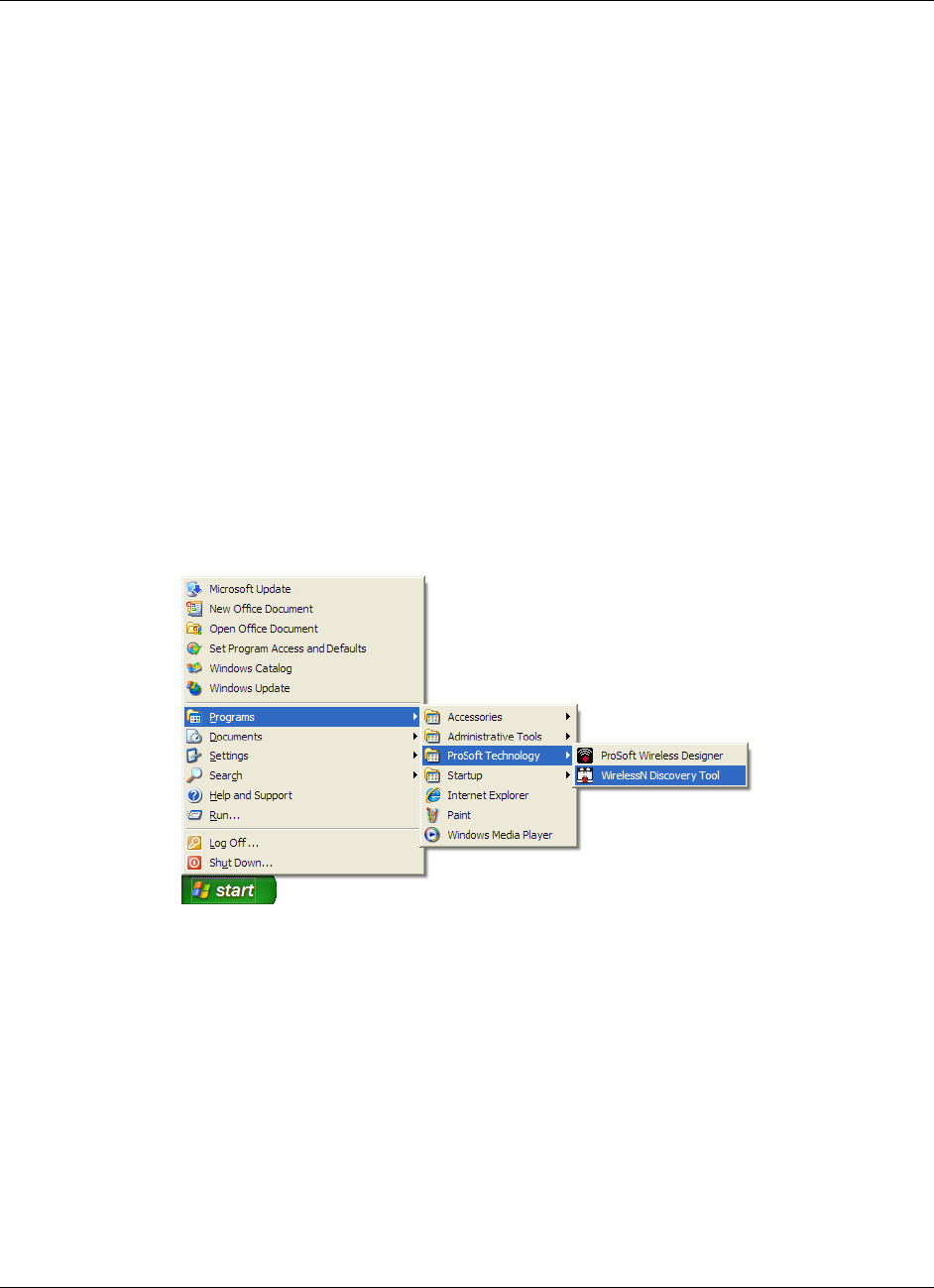
RLXIB-IHN ♦ 802.11n Start Here
Industrial Hotspot User Manual
ProSoft Technology, Inc. Page 25 of 171
May 23, 2011
1.7.1 Personality Module
The radio comes equipped with a Personality Module. The Personality Module
feature consists of an SD card and the radio’s capability to read and write
configuration information to that card. The Personality Module can be used for
disaster recovery for a failed radio site to bring it back into operation.
In the event of a failure, the SD card can be removed from a the radio that is no
longer operational and inserted into a new radio. When booted, that new radio
will take on the setting from the Personality Module, bringing the site back into
operational status without the difficulty of reprogramming all the necessary
settings manually. This will increase the uptime of the network.
When a radio is configured with a Personality Module , the radio writes the new
configuration to the Personality Module when those settings are applied. The
radio accesses the Personality Module on bootup, if present, and writes those
settings to its internal flash. The radio is able to function normally with or without
a Personality Module installed
1.7.2 Start WirelessN Discovery Tool
1 Click the START button, and then navigate to PROGRAMS / PROSOFT
TECHNOLOGY
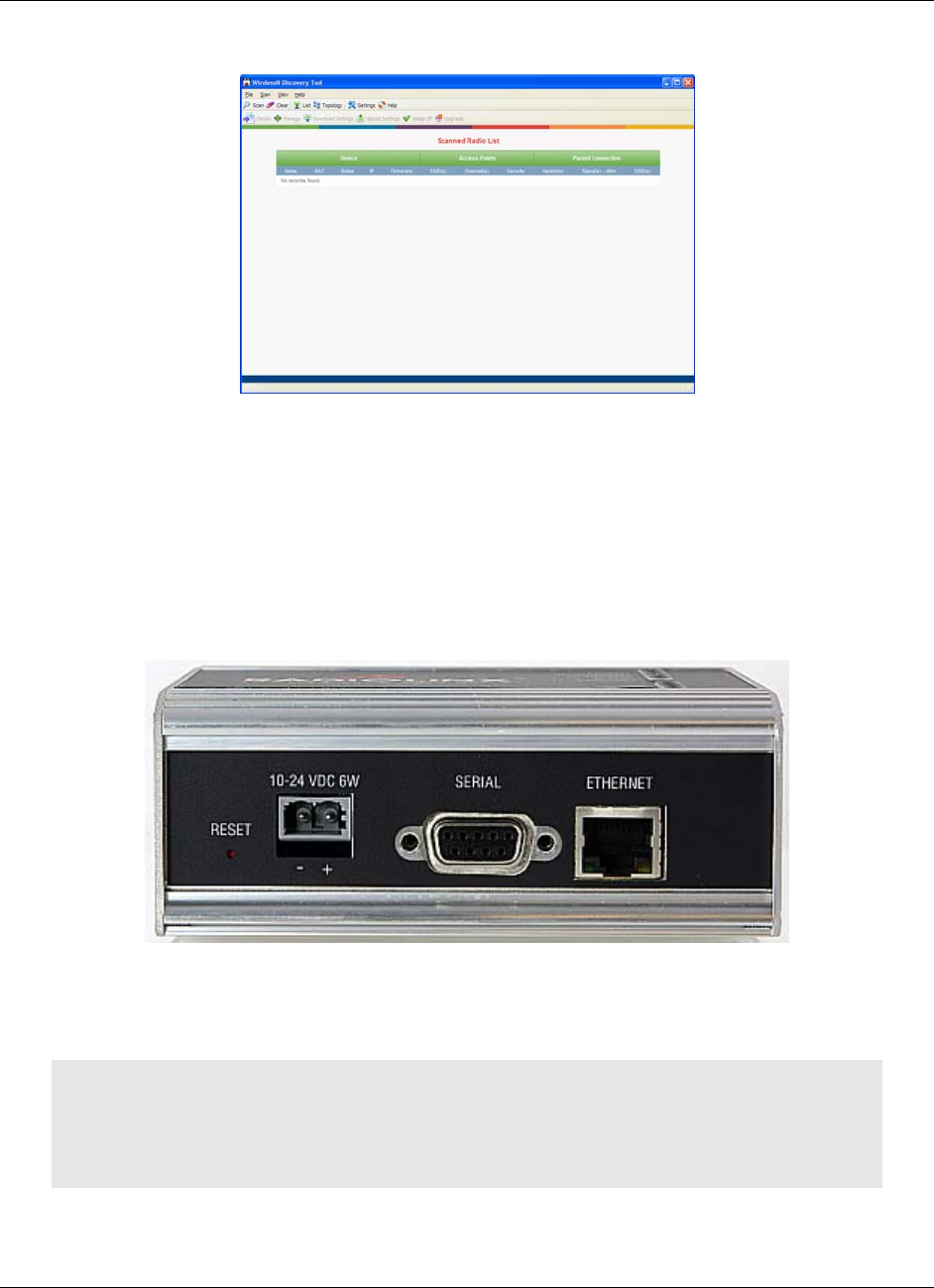
Start Here RLXIB-IHN ♦ 802.11n
User Manual Industrial Hotspot
Page 26 of 171 ProSoft Technology, Inc.
May 23, 2011
2 Click to start RADIOLINX WIRELESSN DISCOVERY TOOL.
The window lists all the radios your computer can access. The MAC ID number is
essentially the serial number of the radio; this number is also printed on the side
of the radio. If a radio listing does not appear in the window, click the SCAN
button. If you still do not see a radio listing, see Troubleshooting (page 46).
1.7.3 Plug In the Cables
You can configure the RLXIB-IHN using the Ethernet port on the radio. On the
underside are three ports: Ethernet, Serial, and Power (10 to 24 VDC).
From left to right: Power connector, Serial port, and Ethernet port.
Use the Ethernet cable to configure the radio for the first time.
Note: After you plug in the power cable and Ethernet cable, the radio performs a startup procedure
that includes a self-test, loading the main program, and initializing the radio. The front panel Power
LED will turn Amber immediately after power has been applied. When the radio has finished the
startup procedure, the power LED will turn Green.
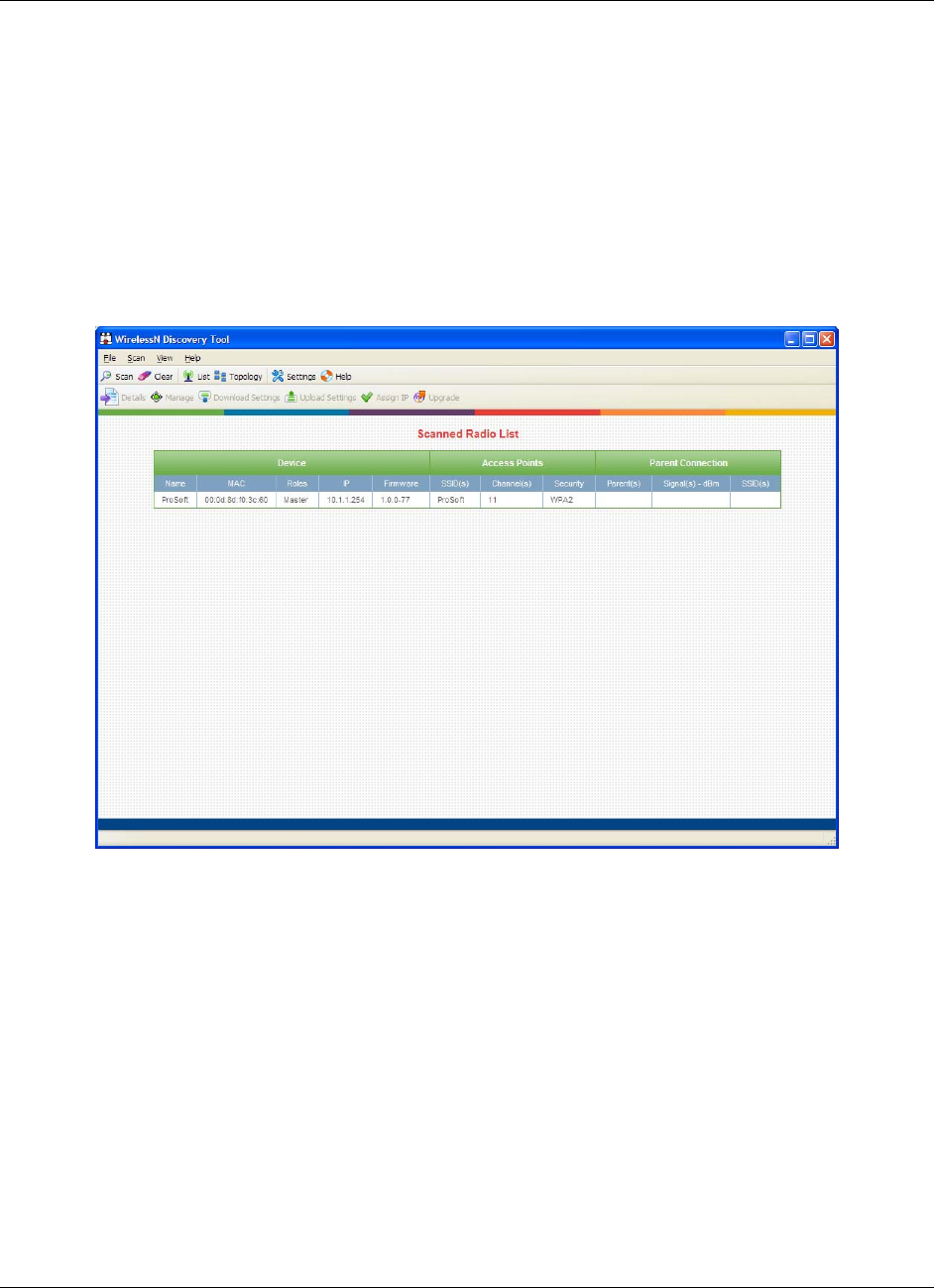
RLXIB-IHN ♦ 802.11n Start Here
Industrial Hotspot User Manual
ProSoft Technology, Inc. Page 27 of 171
May 23, 2011
After the startup procedure has completed successfully, the Power LED should
be green, meaning that the radio has power. The Ethernet LED should also be
green, meaning that the Ethernet connection is working. The RF Transmit and
RF Receive LEDs should blink.
For information on making connections, see Radio Power Requirements and
Cable Specifications (page 137, page 137).
1.7.4 Detecting the Radio
After the radio has completed its startup procedure, the radio will appear in the
WirelessN Discovery Tool window.
The window lists all the radios your computer can access. The MAC ID number is
essentially the serial number of the radio; this number is also printed on the side
of the radio. If a radio listing does not appear in the window, click the SCAN
button on the toolbar. If you still do not see a radio listing, refer to Diagnostics
and Troubleshooting (page 41) in the RLXIB-IHN User Manual.
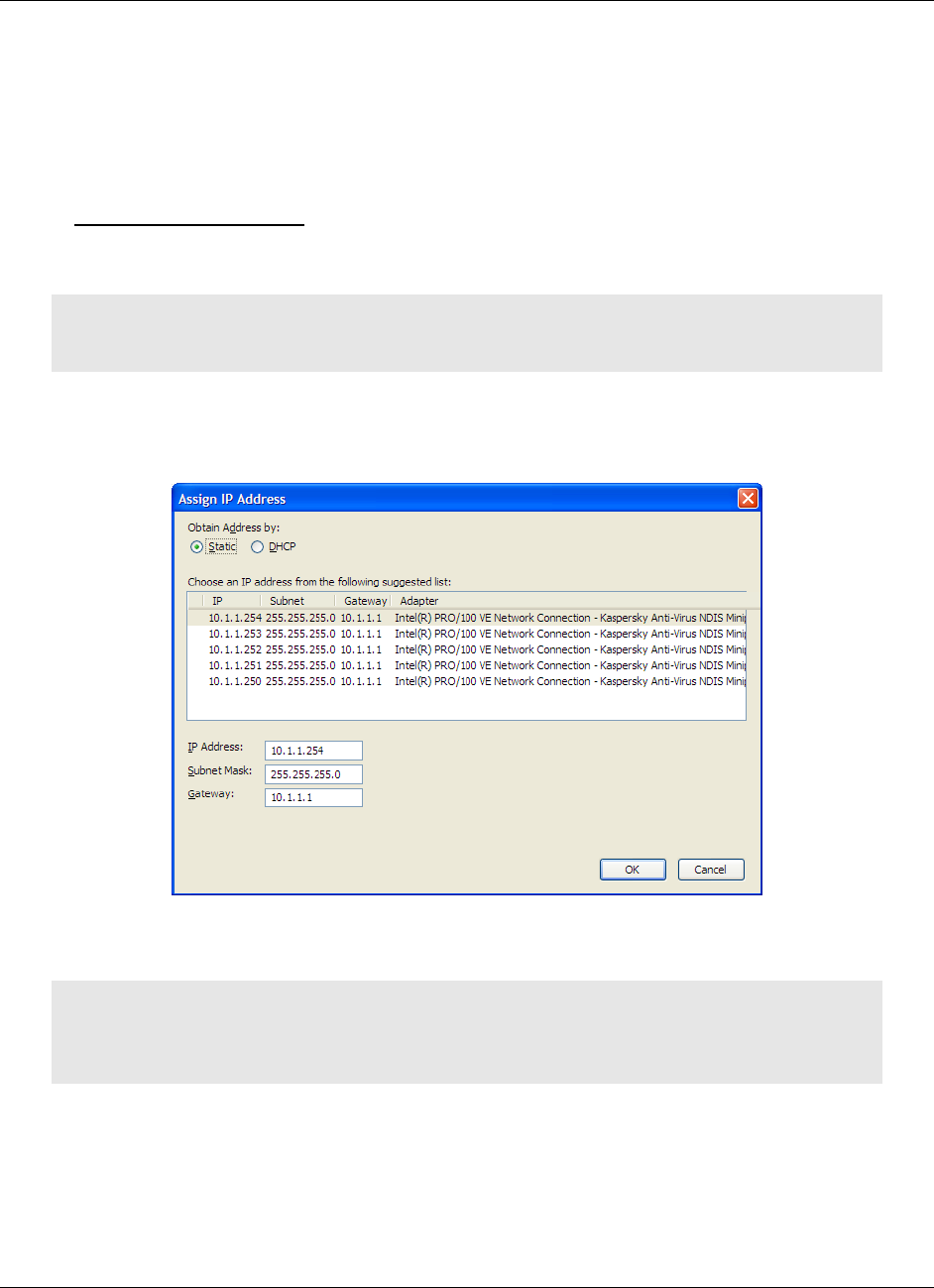
Start Here RLXIB-IHN ♦ 802.11n
User Manual Industrial Hotspot
Page 28 of 171 ProSoft Technology, Inc.
May 23, 2011
1.7.5 Assign an IP Address
You need the IP address to log into the RadioLinx Configuration Manager and
configure the radio settings. If the radio is connected to a network with a DHCP
server, the radio may already have an IP address assigned to it.
If a DHCP server is not available, or if you prefer to assign a static IP address,
you can enter an IP address here.
To assign an IP Address
1 In WirelessN Discovery Tool, click to select the radio.
Tip: If a radio listing does not appear in the window, click the Scan button on the toolbar. If you still
do not see a radio listing, refer to Diagnostics and Troubleshooting (page 41).
2 Right-click on the radio to open a shortcut menu, and then choose ASSIGN IP.
This action opens the Assign IP Address dialog box.
3 Select one of the unused IP addresses, and then click OK.
Tip: You must also assign a Gateway address. The Gateway assigned to your PC’s Ethernet port
is offered as a suggestion. If your PC does not have a Gateway setting, the Gateway field in the
Assign IP Address dialog will be blank. You will need to enter a Gateway before clicking OK.
For information, see Radio Access settings (page 80).
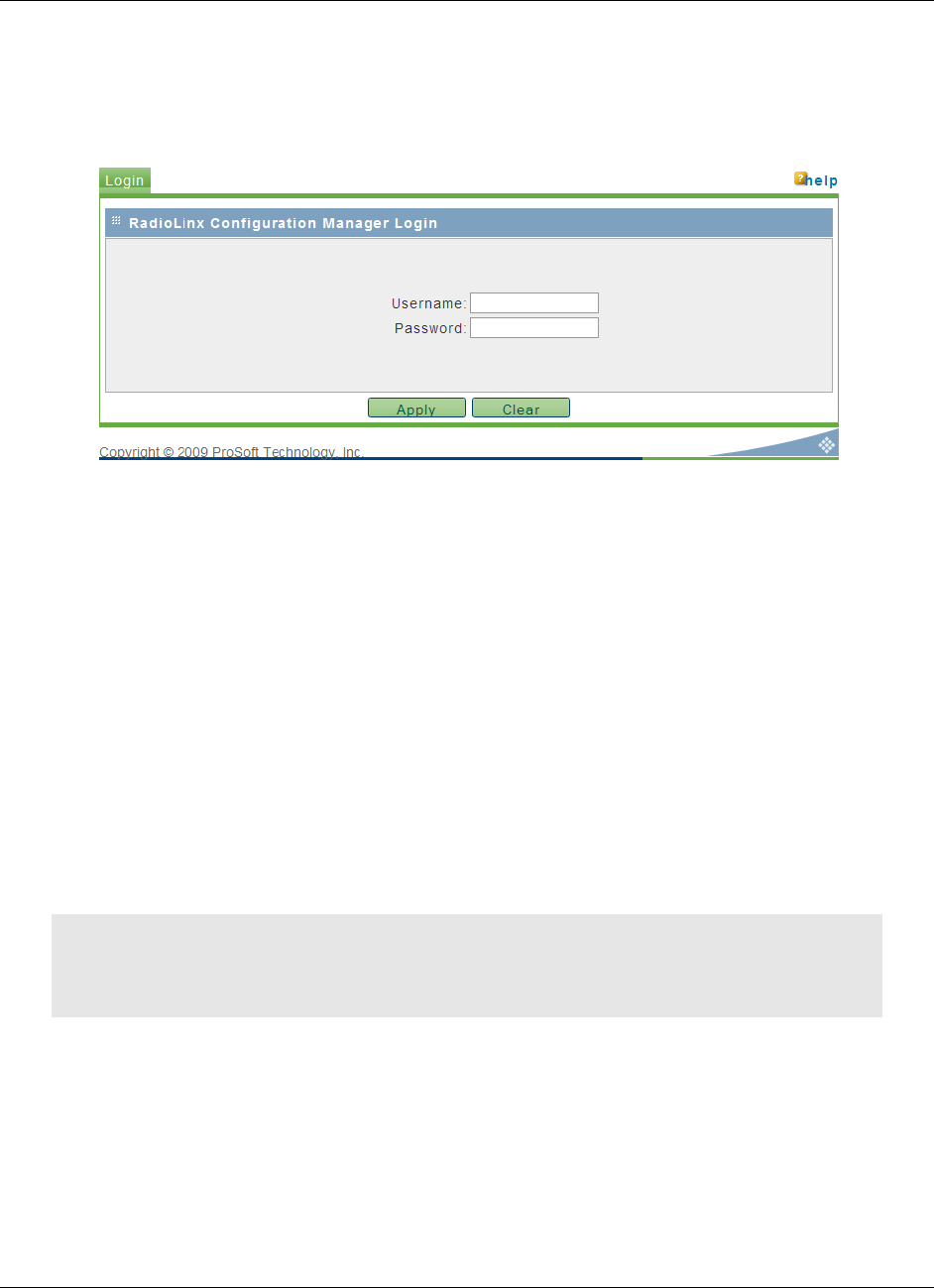
RLXIB-IHN ♦ 802.11n Start Here
Industrial Hotspot User Manual
ProSoft Technology, Inc. Page 29 of 171
May 23, 2011
1.7.6 Set up the Master Radio
To configure the radio, double click on the radio (Radio1) in the WirelessN
Discovery Tool window. This action opens a web browser (for example Microsoft
Internet Explorer or Firefox) and loads the Radio’s web configuration interface.
Administrator login
With administrative privileges, you can view or modify the configuration of the
access point.
Enter the user name in lower case, no quotes.
The default administrator user name is "admin"
The default password is "password"
The user name and password are case sensitive
Guest login
With guest privileges, you can view the existing configuration, but you cannot
make changes.
Enter the user name in lower case, no quotes.
The default guest user name is "guest".
The default password is "password".
Important: You should change the default user names and passwords, write down the settings,
and keep a copy in a safe place, to protect the radio from being reconfigured or viewed by
unauthorized users.
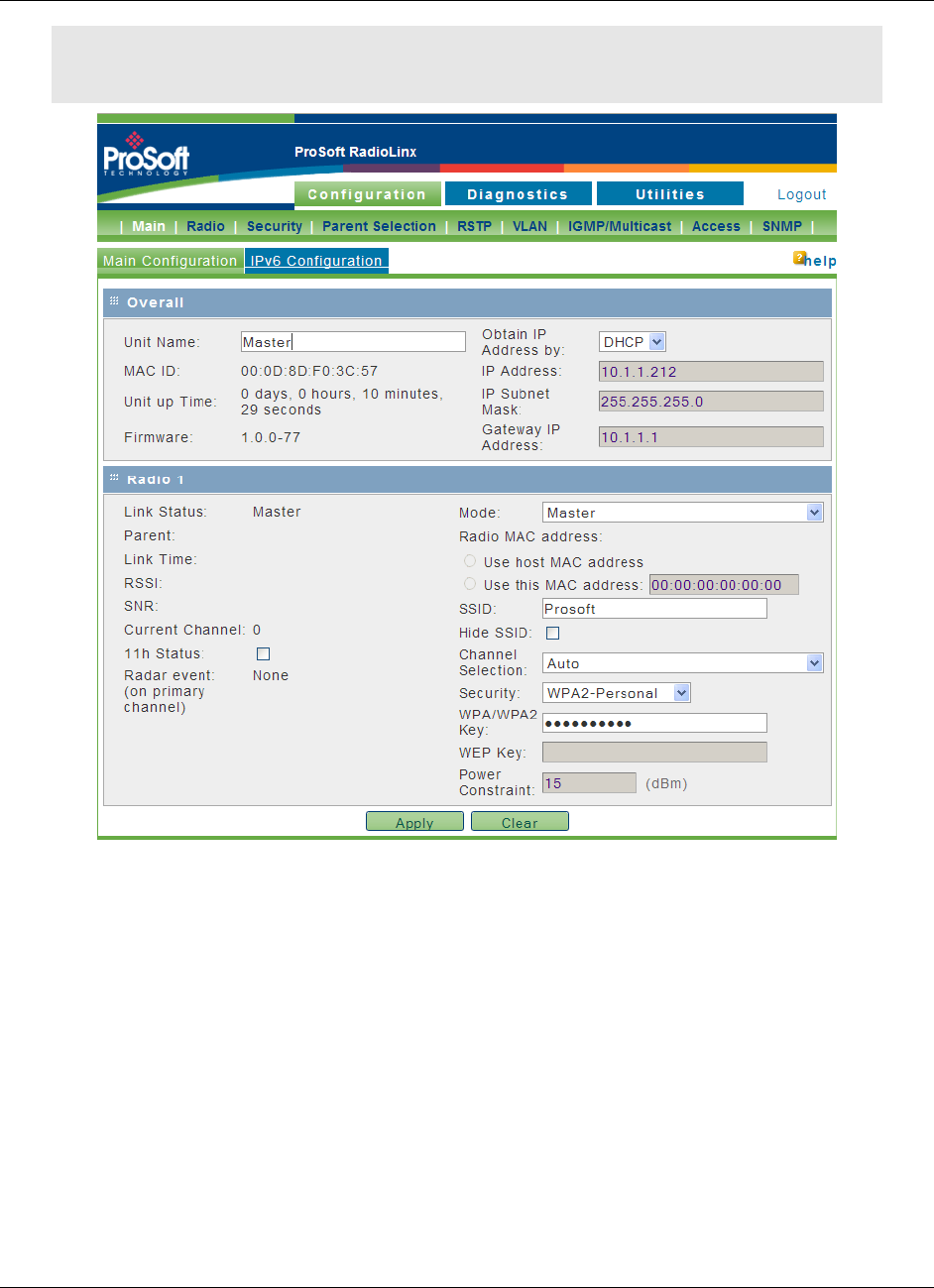
Start Here RLXIB-IHN ♦ 802.11n
User Manual Industrial Hotspot
Page 30 of 171 ProSoft Technology, Inc.
May 23, 2011
Note: The master is the "root" or central radio in a network. You must have at least one master
radio per network. For redundancy, you can assign more than one master to a network.

RLXIB-IHN ♦ 802.11n Start Here
Industrial Hotspot User Manual
ProSoft Technology, Inc. Page 31 of 171
May 23, 2011
To configure a Master radio, make the following changes to the web
configuration form:
Overall Settings
Unit Name: Enter a unique name for the radio.
Obtain IP Address by: If a DHCP (Dynamic Host Control Protocol) server is
configured on your local area network, the DHCP server can assign IP
addresses automatically.
If you prefer to assign a Static (Fixed) IP address, select STATIC, and then
enter the IP Address, Subnet Mask and Default Gateway in the Overall area
of the Radio web configuration form.
Important: If you intend to assign IP addresses manually, you must not duplicate an IP address
that is already in use on your network. If you are not sure what IP addresses are available, ask
your network administrator for assistance.
Select MASTER as the radio mode.
SSID: Assign a network name (SSID) of up to 32 characters. The radio uses
this name in all network references. All radios in a network must have the
same SSID.
Channel Selection: Choose the channel selection mode.
Network channels allow radios to avoid sharing a frequency with other
networks in the same location. For most applications, you should choose a
specific channel number. If you choose AUTO, the radio will scan available
channels, and will select a channel that appears to have little traffic.
Important: The RLXIB-IHN radio is supplied with a dual-band antenna that supports both
frequency ranges. If you use a different antenna with the RLXIB-IHN radio, you must choose a
channel and frequency range supported by the antenna.
Security: Encryption scrambles data so that only intended viewers can
decipher and understand it. Although "none" is an available encryption type,
ProSoft Technology strongly recommends encrypting all data sent and
received from every radio on your network with WPA2, to help prevent your
data from being intercepted and decoded.
WPA/WPA2 Key: To use AES encryption on packets sent between the
radios, select WPA2 - PERSONAL in the Encryption Type field. Next, in the
WPA phrase field, enter a pass phrase of between eight and 63 normal
keyboard characters. This phrase automatically generates an encryption key
of 128 hexadecimal characters. The default pass phrase is "passphrase"
(lower case, no quotes). For more information on encryption, see Security
settings (page 61).
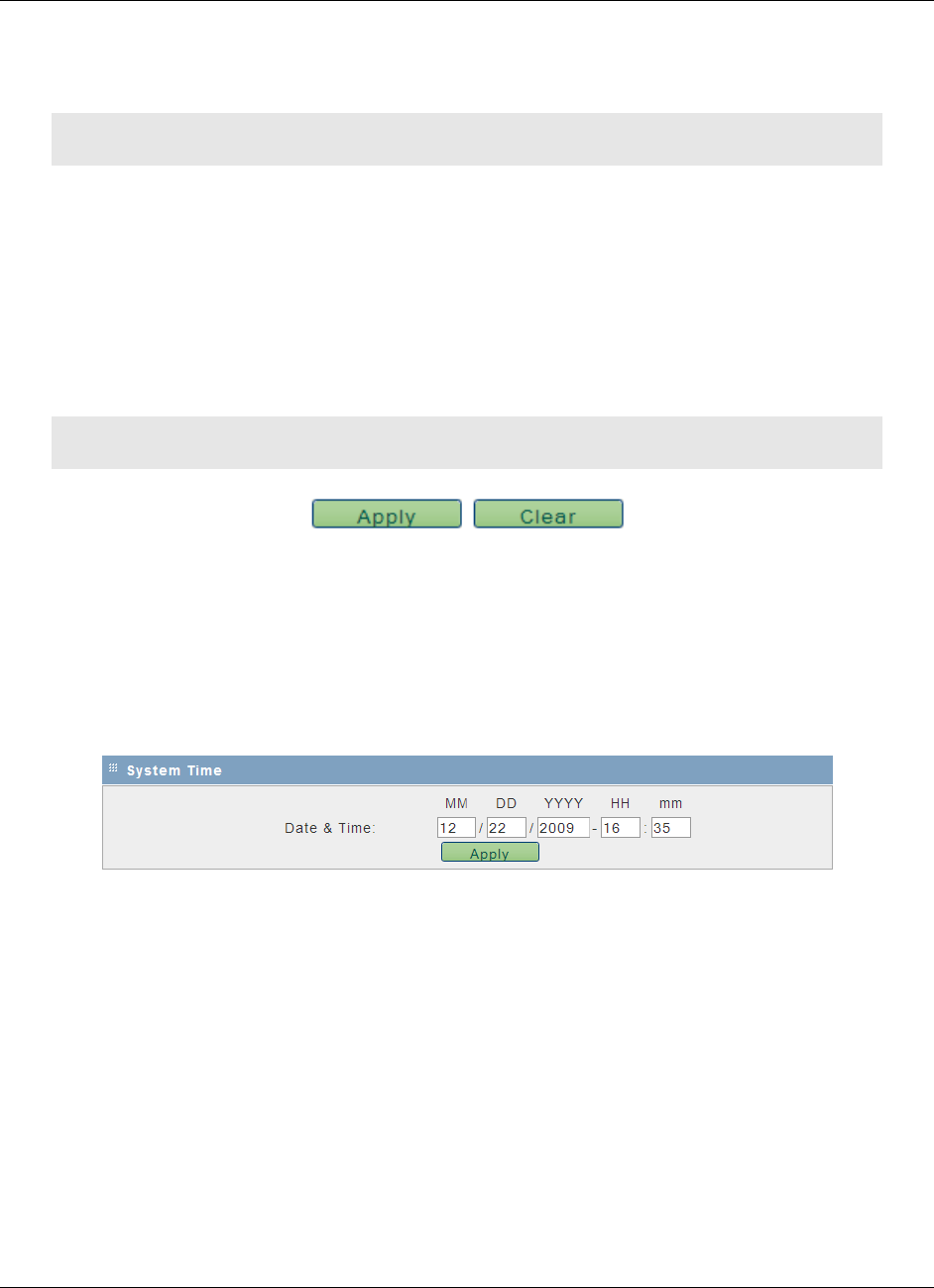
Start Here RLXIB-IHN ♦ 802.11n
User Manual Industrial Hotspot
Page 32 of 171 ProSoft Technology, Inc.
May 23, 2011
Because you must assign the same Network SSID and WPA phrase to the
repeater radios later in this procedure, you should write down the settings.
Note: Network SSID and WPA key are both case-sensitive.
Network SSID:_________________
WPA phrase:__________________
1.7.7 Save the Radio Configuration
Before browsing to other pages in the Radio Configuration window, you must
apply your changes. Click APPLY to save your configuration and restart the radio.
Note: To discard your changes and start over, click CLEAR.
1.7.8 Set the Date and Time
The radio has a real time clock (RTC) used to keep time. Accurate system time is
useful for logging, and is required as part of certificate validity confirmation;
expired certificates cannot be used in 802.1X authentication.
To set the date and time, click the UTILITIES button, and then click UPLOAD.
Enter the date and time in the System Time box, and then click APPLY to save.
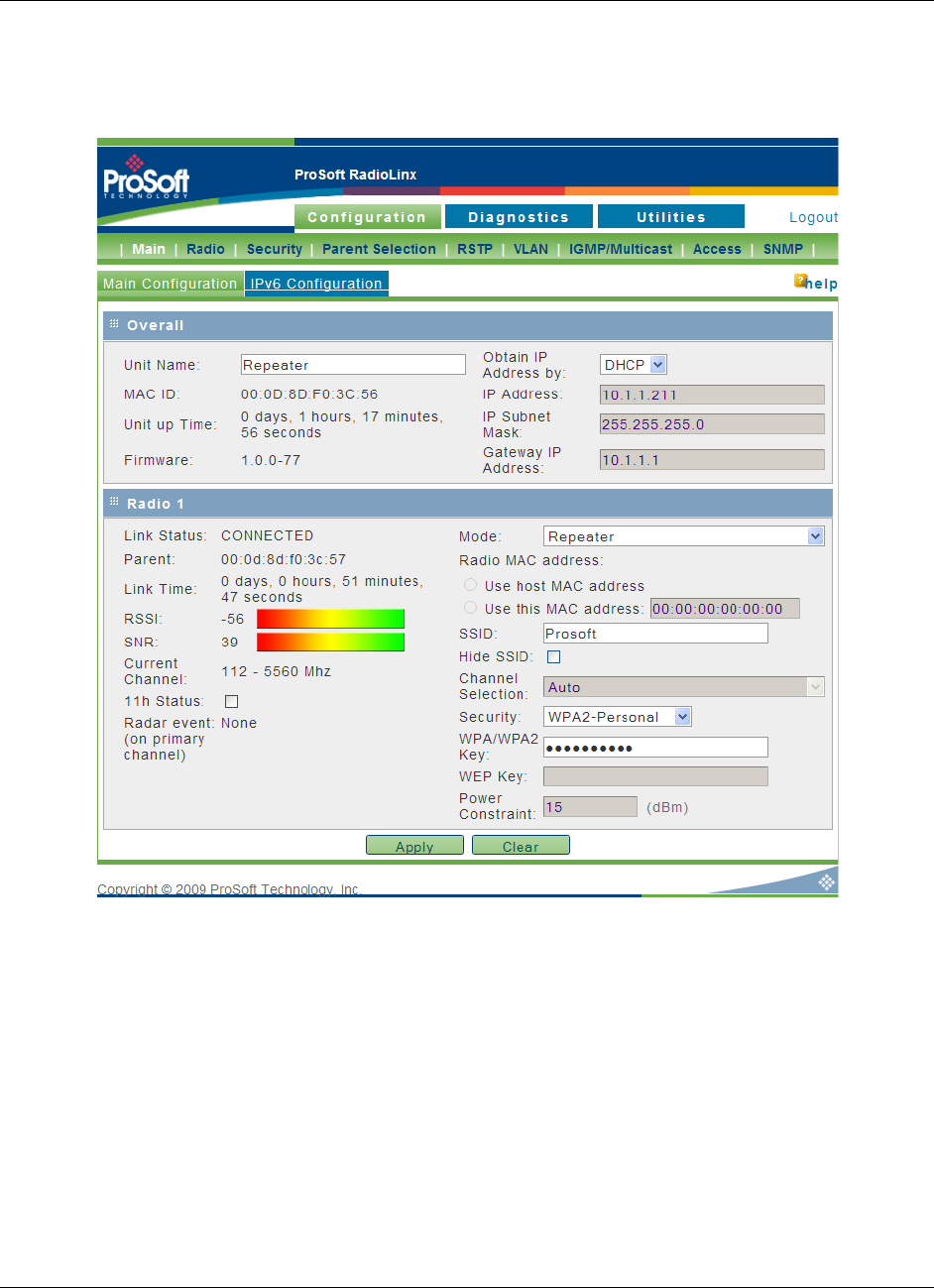
RLXIB-IHN ♦ 802.11n Start Here
Industrial Hotspot User Manual
ProSoft Technology, Inc. Page 33 of 171
May 23, 2011
1.7.9 Set up a Repeater
To configure a radio as a Repeater, make the following changes to the web
configuration form:

Start Here RLXIB-IHN ♦ 802.11n
User Manual Industrial Hotspot
Page 34 of 171 ProSoft Technology, Inc.
May 23, 2011
Radio Network Settings
Unit Name: Enter a unique name for the radio.
Obtain IP Address by: If a DHCP (Dynamic Host Control Protocol) server is
configured on your local area network, the DHCP server can assign IP
addresses automatically.
If you prefer to assign a Static (Fixed) IP address, select STATIC, and then
enter the IP Address, Subnet Mask and Default Gateway in the Overall area
of the Radio web configuration form.
Important: If you intend to assign IP addresses manually, you must not duplicate an IP address
that is already in use on your network. If you are not sure what IP addresses are available, ask
your network administrator for assistance.
Select REPEATER as the radio mode.
SSID: Enter the SSID you configured for the Master radio. All radios in a
network must have the same SSID.
Security: Encryption scrambles data so that only intended viewers can
decipher and understand it. Choose the same encryption type you configured
for the Master radio.
WPA/WPA2 Key: Enter the pass phrase you configured for the Master radio.
Important: The Network SSID and WPA phrase are case sensitive. Use exactly the same
combination of upper case and lower case letters you entered for the Master radio, otherwise the
Repeater radio will not be able to connect to the Master radio.
By default, a repeater connects automatically to the best available parent radio
on the network. If necessary, however, you can click the Parent Link button and
specify how repeater radios connect to the network. See Parent Link settings
(page 64) for information.

RLXIB-IHN ♦ 802.11n Start Here
Industrial Hotspot User Manual
ProSoft Technology, Inc. Page 35 of 171
May 23, 2011
1.7.10 Set up a Client
Client mode is a special mode in the radio that allows a user to connect an
Ethernet device to a wireless network through any 802.11n access point. Any
Ethernet device that has an RJ45 Ethernet port can, in effect, be transformed into
an 802.11n wireless client by attaching the radio. Only a single device can be
connected to the radio in client mode. Do not connect to more than one Ethernet
device (using a switch or hub).
You only use client mode if you need to connect to another brand 802.11n
access point. If you are using RLXIB-IHN radios, you should always use them as
repeaters (and masters).
To connect a device to a radio in client mode, click the Client button for the radio
and try programming the radio’s client mode using the Auto setting. To test
whether the Auto setting will work:
1 Connect the cable between the device and the radio.
2 Turn ON the radio power, or cycle the power if the radio is already on.
3 Turn ON the device. Watch the radio to see if it initializes. The Auto setting
will work if the device advertises its MAC ID to the radio.
If the radio’s RF LEDs do not show consistent activity after a few minutes, then
you may need to modify the radio’s client settings. Click the Specify radio button,
determine the MAC ID of the Ethernet device, and type the ID into the Client
MAC field.
Client devices are identified in the ROLE column in the WirelessN Discovery Tool.
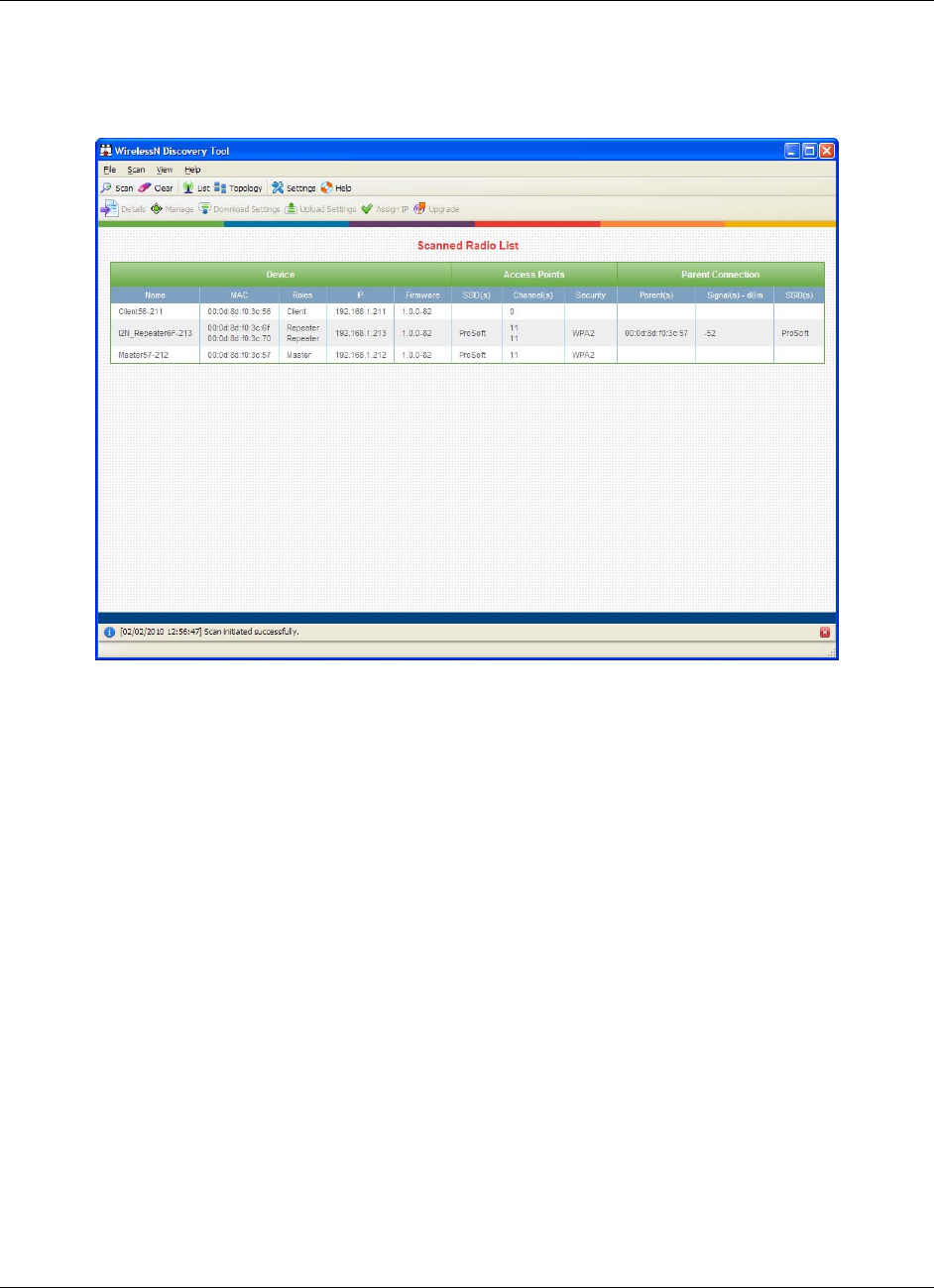
Start Here RLXIB-IHN ♦ 802.11n
User Manual Industrial Hotspot
Page 36 of 171 ProSoft Technology, Inc.
May 23, 2011
1.8 Verify Communication
When configured, the Roles column identifies each radio as a Master, Repeater,
or Client.
Observe the LEDs to ensure good link quality, as explained in LED display (page
44).
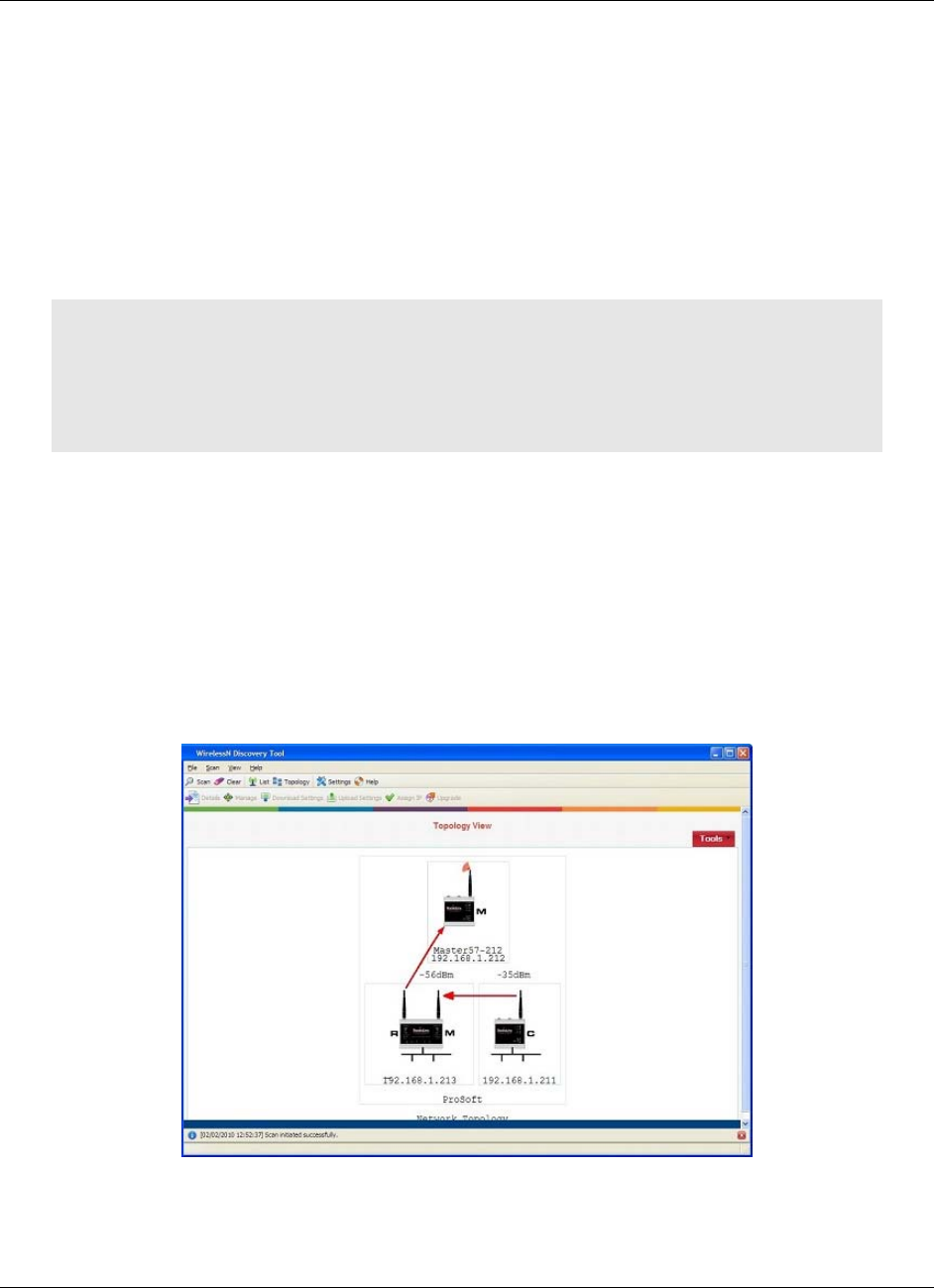
RLXIB-IHN ♦ 802.11n Installing the Radios
Industrial Hotspot User Manual
ProSoft Technology, Inc. Page 37 of 171
May 23, 2011
2 Installing the Radios
If possible, you should configure all the radios side by side in an office setting
and make sure they link before you install them in the field. If feasible, it would be
even better if you could set up the entire system in the office and make sure your
equipment communicates properly through the radio network.
Important: If the radios are close enough to each other that their received signal strength is
greater than -40dBm, performance may be degraded. Disconnect antennas from radios during
bench testing, or move the radios further apart from each other.
Tip: To make it easier to physically identify the radios you are configuring, apply a label to each
radio indicating the radio name and IP address.
After you have configured each radio using WirelessN Discovery Tool and the
web configuration form, you can install the radios and test their performance.
Install the radios in their proposed permanent locations, and then temporarily
place each radio’s antenna near its proposed mounting location. The temporary
placement of the antenna can be by hand; however, with this testing method, one
person must hold the antenna while another monitors the radio’s signal strength.
To see how a radio is linked in the network, make sure that the radio is
connected to a PC, and then select TOPOLOGY VIEW from the View menu in the
WirelessN Discovery Tool.
The Topology view shows a diagram of the network’s wireless connections. Use
this view to see whether all the radios are linked, and that you approve of the
way the radios are linked.

Installing the Radios RLXIB-IHN ♦ 802.11n
User Manual Industrial Hotspot
Page 38 of 171 ProSoft Technology, Inc.
May 23, 2011
Devices connected to the wireless network are identified by an arrow. The arrow
points from the child radio (supplicant) to the parent radio. To view available
alternate parents, right-click on the network diagram to open the context menu,
and then select SHOW ALTERNATE PARENTS. A dashed green line indicates
eligible potential parents in the network. To change how radios link to the
network, see Parent Link settings (page 64).
Refer to Improve Signal Quality (page 47) for more information on overcoming
poor connectivity.

RLXIB-IHN ♦ 802.11n Installing the Radios
Industrial Hotspot User Manual
ProSoft Technology, Inc. Page 39 of 171
May 23, 2011
2.1 Connecting antennas
Each radio must have an antenna connected to the Main antenna port on the
RLXIB radio; without an antenna for each radio, the network will not function.
All antennas for radios that communicate directly with each other should be
mounted so they have the same antenna polarity. Small antennas with a reverse-
polarity SMA connector can be mounted directly on the radio. Screw the antenna
onto the antenna port connector until it is snug.
Larger antennas and antennas that do not have a reverse-gender SMA
connector must be mounted separately and connected to the radio using a
coaxial antenna cable. Because the antenna cable attenuates the RF signal, use
an antenna cable length that is no longer than necessary to ensure optimum
performance.
Important: If the radio is to be used in a hazardous location, the radio must be mounted in an
enclosure approved for hazardous locations. The radio requires a separate cable connection to the
SMA connector that leads to an internal antenna.
2.1.1 Using Multiple Antennas (MIMO)
802.11n radios can use up to 3 antennas at a time. MIMO antennas contain three
antennas within a single enclosure, providing three antenna connections to the
radio. You can use these antennas for several purposes depending on the
configuration.
You can use multiple antennas to:
send more data simultaneously (streams)
1 Antenna 2 Antennas 3 Antennas
1 Stream 1 Antenna - Stream 1 2 Antenna - Stream 1 3 Antenna - Stream 1
2 Streams N/A 1 Antenna - Stream 1
1 Antenna - Stream 2
1 Antenna - Stream 1
2 Antenna - Stream 2
improve the ability of the radio to receive weak signals, therefore giving better
range.
1 Antenna 2 Antennas 3 Antennas
17dBm 20dBm 22dBm

Installing the Radios RLXIB-IHN ♦ 802.11n
User Manual Industrial Hotspot
Page 40 of 171 ProSoft Technology, Inc.
May 23, 2011
2.2 Test the Network Installation Plan
Test proposed installations before finalizing the installation.
After you have configured the network and the radios:
install the Master radio in its proposed permanent location
cable the Configuration PC to the Master radio
place the Remote radios in their proposed locations
temporarily place each radio's antenna near its proposed mounting location.
The temporary placement of the antenna can be by hand, however, with this
testing method, one person must hold the antenna while another monitors the
Remote radio's signal strength as displayed on the Configuration PC.
To improve the signal quality of each Remote's communication:
increase the height of the antenna's placement
use higher-gain antennas
increase the radio's transmission power, cable the radio to the Configuration
PC, and reconfigure it
select a new location for the Remote radio and/or its antenna
decrease the length of antenna cable
determine and resolve sources of "electrical" noise which may be interfering
with the radio transmission
add a repeater between the radios that are not communicating, or reconfigure
an existing radio as a repeater if line of sight is available

RLXIB-IHN ♦ 802.11n Diagnostics and Troubleshooting
Industrial Hotspot User Manual
ProSoft Technology, Inc. Page 41 of 171
May 23, 2011
3 Diagnostics and Troubleshooting
In This Chapter
Diagnostics............................................................................................ 42
Check the Ethernet cable ......................................................................43
LED display ........................................................................................... 44
Retrieve the Default Password.............................................................. 45
Troubleshoot missing radios..................................................................46
Improve signal quality............................................................................47

Diagnostics and Troubleshooting RLXIB-IHN ♦ 802.11n
User Manual Industrial Hotspot
Page 42 of 171 ProSoft Technology, Inc.
May 23, 2011
3.1 Diagnostics
The Radio Configuration / Diagnostic Utility (the web configuration form for the
radio) provides information that can help you troubleshoot problems with the
radio.
Use the program’s diagnostic and signal strength settings in the Main
Configuration window to make sure the network is working properly.
RSSI / SNR graph: This setting graphically shows the radio’s signal strength.
Link Status field
Master: The radio is configured as a Master.
Connected: The radio is currently connected to a Parent
Associated: The radio is associated with a Parent, but is not currently
connected
Connecting: The radio is attempting to connect to a Parent
Disconnected: The radio is unable to connect to a Parent
The following configuration forms in the Radio Configuration / Diagnostic Utility
provide information about current radio operation:
Unit Status (page 53)
Radio 1/2 Status (page 86)
Statistics (page 87)
802.11 Traffic (page 89)
Event Logs (page 105)
The following topics describe troubleshooting routines:
Check the Ethernet cable (page 43)
Retrieve the default password (page 45)
Troubleshoot missing radios in the WirelessN Discovery Tool (page 46)
For more troubleshooting information, visit the ProSoft web site at
www.prosoft-technology.com

RLXIB-IHN ♦ 802.11n Diagnostics and Troubleshooting
Industrial Hotspot User Manual
ProSoft Technology, Inc. Page 43 of 171
May 23, 2011
3.2 Check the Ethernet cable
If you connect a radio and the Ethernet LED does not light on the radio, there
may be a problem with the Ethernet cable. Verify that the cable is plugged into
the radio at one end, and to an Ethernet hub or a 10/100 Base-T Ethernet switch
at the other end.
Note: The RLXIB-IHN radio auto-detects the Ethernet connection type, and does not require a
crossover cable for direct connection to a PC.

Diagnostics and Troubleshooting RLXIB-IHN ♦ 802.11n
User Manual Industrial Hotspot
Page 44 of 171 ProSoft Technology, Inc.
May 23, 2011
3.3 LED display
The RLXIB-IHN front panel includes a set of LEDs that indicate the radio’s status:
LED Description
Power This green LED indicates that the radio has power.
RF Transmit This yellow LED indicates RF transmission.
RF Receive This green LED indicates RF reception.
Serial Reserved for future use.
Ethernet If this green LED is on, the Ethernet cable is connected. If this LED is flashing,
an Ethernet packet is being transmitted or received.
Signal Strength If only one of these three LEDs is on, then the radio is linked. If two LEDs are on,
the radio’s signal strength is fair. If all three LEDs are on, the signal strength is
good.
If a radio is configured as a master, the middle light of the three Signal Strength
LEDs will always be on, and the bottom Signal Strength LED will always be off.
The top LED on the master will flash if any radios are linked to this master.
After you first plug in the power cable and Ethernet cable to the radio, the
Power/Status LED should be green, meaning that the radio has power. If the
Ethernet LED is green, then the Ethernet connection is working. The RF Transmit
and RF Receive LEDs should blink.
All three LEDs will blink just after the radio links to the Master’s signal but before
it has been fully authenticated. Normally you will see this last only a few seconds.
If it blinks longer, or never turns on, it usually means the encryption keys are not
correct.
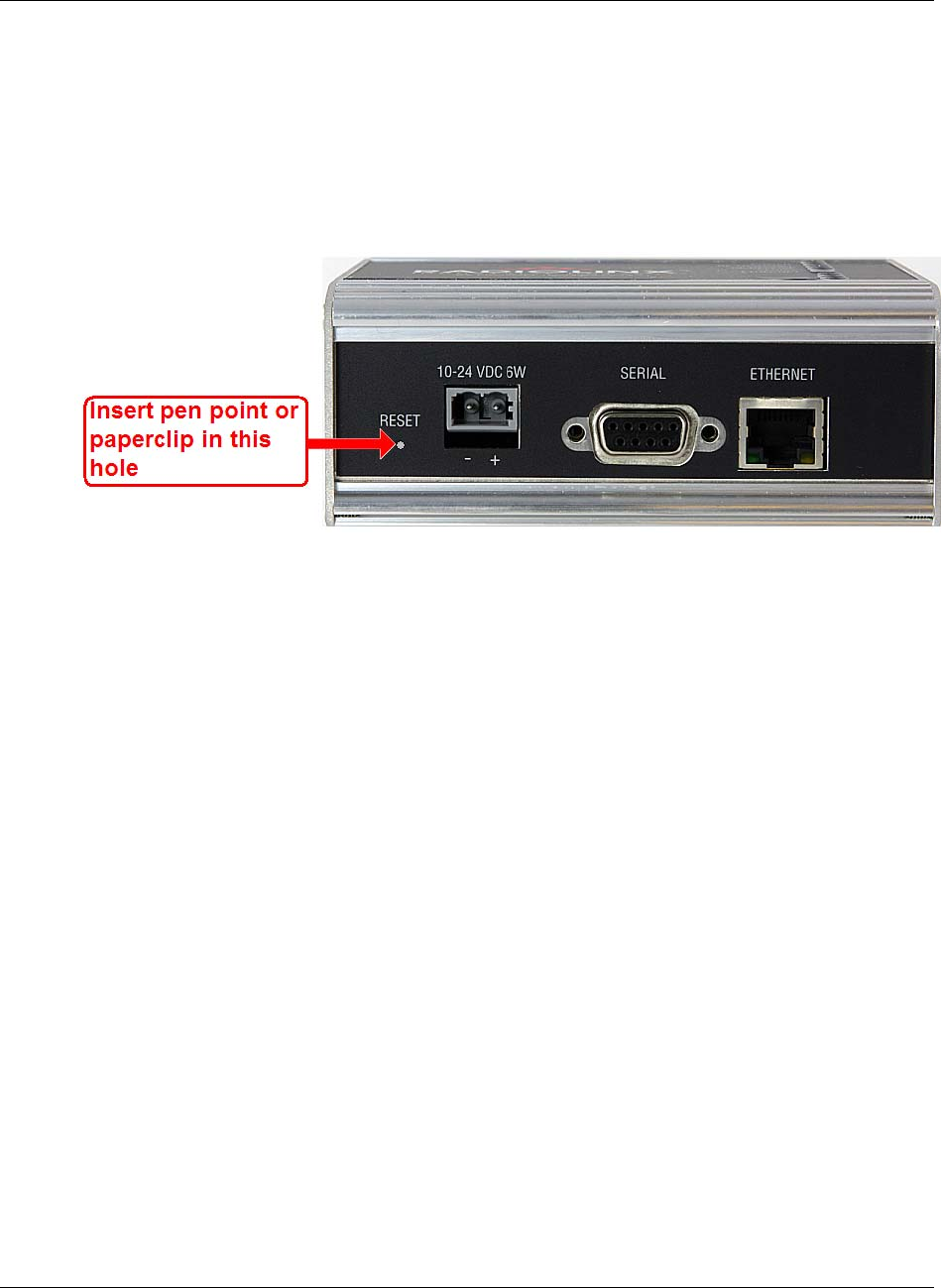
RLXIB-IHN ♦ 802.11n Diagnostics and Troubleshooting
Industrial Hotspot User Manual
ProSoft Technology, Inc. Page 45 of 171
May 23, 2011
3.4 Retrieve the Default Password
If you forget your password, you will be unable to change the radio settings. You
can retrieve the default password to use the software again, but you will lose all
the settings you programmed before. To retrieve the default password and return
the radio to its default settings, follow these steps:
1 Turn off power to the radio.
2 Locate the reset hole, located to the left of the power connector.
3 Turn on power to the radio.
4 Insert the end of a paperclip or similar device into the hole, and wait for the
Power LED to turn green.
5 When the Power LED turns green, press and hold the reset button for at least
five seconds.
6 The radio will reload its default settings, including the password. You should
now be able to log in using the default password, which is "password".

Diagnostics and Troubleshooting RLXIB-IHN ♦ 802.11n
User Manual Industrial Hotspot
Page 46 of 171 ProSoft Technology, Inc.
May 23, 2011
3.5 Troubleshoot missing radios
If radios are not visible in the WirelessN Discovery Tool, try the following:
First, click the SCAN button again. Scans are sent as broadcast messages,
which can be dropped in RF connections, requiring the user to scan again.
Second, disable any software firewall running on your PC (This is most
common in Windows XP and newer). Open the NETWORK CONNECTIONS
folder in your Windows Control Panel, then open the LOCAL AREA
CONNECTION PROPERTIES window and verify that the check box under
INTERNET CONNECTION FIREWALL is not checked.
If the preceding approaches do not help, the PC running the WirelessN
Discovery Tool and the radios are probably not connected to the same local
network. Verify your connections.
If you are in topological view, any unlinked radios may be at the bottom of the
window. Scroll down to see all radios. If you still cannot see radios with the
WirelessN Discovery Tool, call technical support.

RLXIB-IHN ♦ 802.11n Diagnostics and Troubleshooting
Industrial Hotspot User Manual
ProSoft Technology, Inc. Page 47 of 171
May 23, 2011
3.6 Improve signal quality
If you need to improve a radio’s signal quality, try the following steps:
Adjust the direction of the high-gain antennas.
Increase the height of the antenna’s placement.
Use higher-gain antennas or external preamplifiers.
Select a new location for the radio and/or its antenna.
Decrease the length of the antenna cable.
Determine and resolve sources of interfering electrical noise.
Add a repeater between radios that are not communicating.
3.6.1 Understanding Signal to Noise Ratio
All radio networks experience background "noise", known as Electromagnetic
Interference (EMI), which consists of such things as stray signals from other
radios on the same frequency, or random interference generated by non-radio
devices that "leak" or emanate EMI as a by-product or side effect of their actual
function. There are also natural sources of EMI, including atmospheric
disturbances and sunspots. The "snow" on an unused or distant television
channel, or "static" on a car radio when passing under high voltage power lines,
are two common examples of background noise.
Unwanted noise, or EMI, on a data network can cause data transmission errors,
or stop a radio network from functioning at all. Most modern devices, including
RadioLinx radios, are designed to prevent unwanted emanation of EMI from the
device. Radios are also typically designed to tolerate a certain amount of
interference from other devices, however when the amount of noise reaches a
certain threshold, typically within 10dB of a link's RSSI, the radio may be unable
to distinguish between wanted and unwanted signals.
The Main Diagnostics tab in the RadioLinx Configuration Manager shows the
current Signal to Noise Ratio (SNR) in dB. This data can help determine if there
is a signal that is interfering with radio communications. You can use this
diagnostic information during a site survey to check for RF signals already
present in an area, or to detect network issues caused by RF interference.

Diagnostics and Troubleshooting RLXIB-IHN ♦ 802.11n
User Manual Industrial Hotspot
Page 48 of 171 ProSoft Technology, Inc.
May 23, 2011
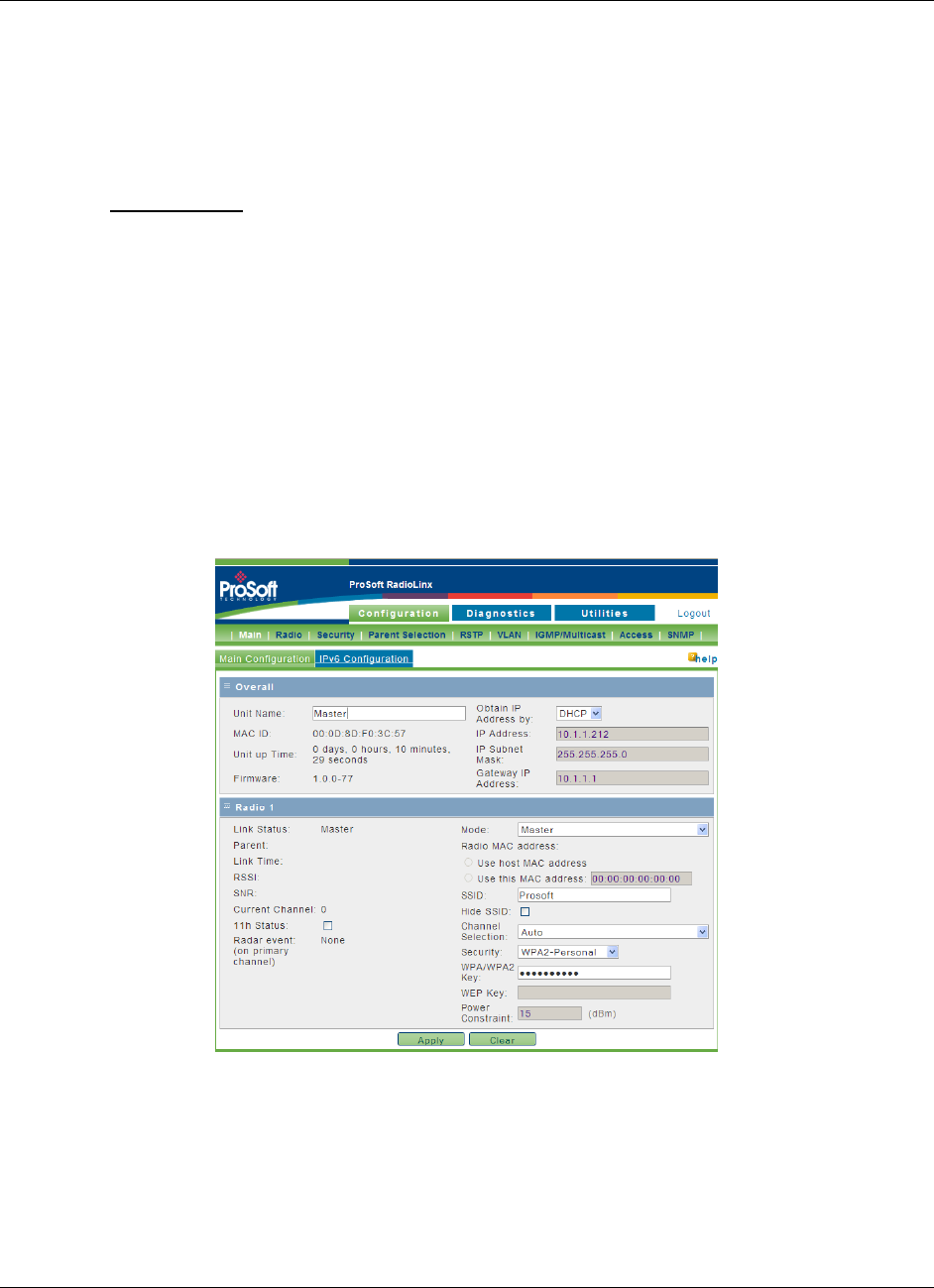
RLXIB-IHN ♦ 802.11n RadioLinx Configuration Manager
Industrial Hotspot User Manual
ProSoft Technology, Inc. Page 49 of 171
May 23, 2011
4 RadioLinx Configuration Manager
In This Chapter
Login .....................................................................................................52
Configuration ......................................................................................... 53
Diagnostics............................................................................................ 86
Utilities...................................................................................................93
The RadioLinx Industrial Hotspot radio has a built-in Configuration Manager
(radio web configuration form) that allows you to configure the radio from any
computer that can connect to the radio, through a wired Ethernet connection, or
through a Wireless connection.
You can use a web browser such as Microsoft Internet Explorer or Firefox on
your network-enabled desktop computer, laptop or Personal Data Assistant
(PDA) to monitor and change the settings within the RadioLinx Industrial Hotspot
radio.

RadioLinx Configuration Manager RLXIB-IHN ♦ 802.11n
User Manual Industrial Hotspot
Page 50 of 171 ProSoft Technology, Inc.
May 23, 2011
To open the RadioLinx Configuration Manager
1 In the WirelessN Discovery Tool, select the radio to configure from the list
view or topography view, and then click the right mouse button to open a
shortcut menu.
2 On the shortcut menu, choose MANAGE. The Radio Configuration / Diagnostic
Utility will open in your web browser.
Or,
Double-click the selected radio to launch the Radio Configuration / Diagnostic
Utility.
You can also open the Radio Configuration / Diagnostic Utility directly from your
web browser.
Important: Your desktop computer, laptop, or PDA must be connected to the same network as the
RadioLinx Industrial Hotspot radio.
1 Open your web browser.
2 In the address bar, type "http://", followed by the IP address for the radio,
and then click the "Go" button. For example,
http://192.168.6.10
Read-Only fields
Some of the fields on the Radio Configuration / Diagnostic Utility form are read-
only, meaning that the content of the field is provided for information only, and
cannot be directly modified. Notice also that depending on the way the radio is
configured, some fields and buttons may be unavailable because they do not
affect the configuration you have selected. Review the topics in this section for
more information on when and how to use each configuration option.
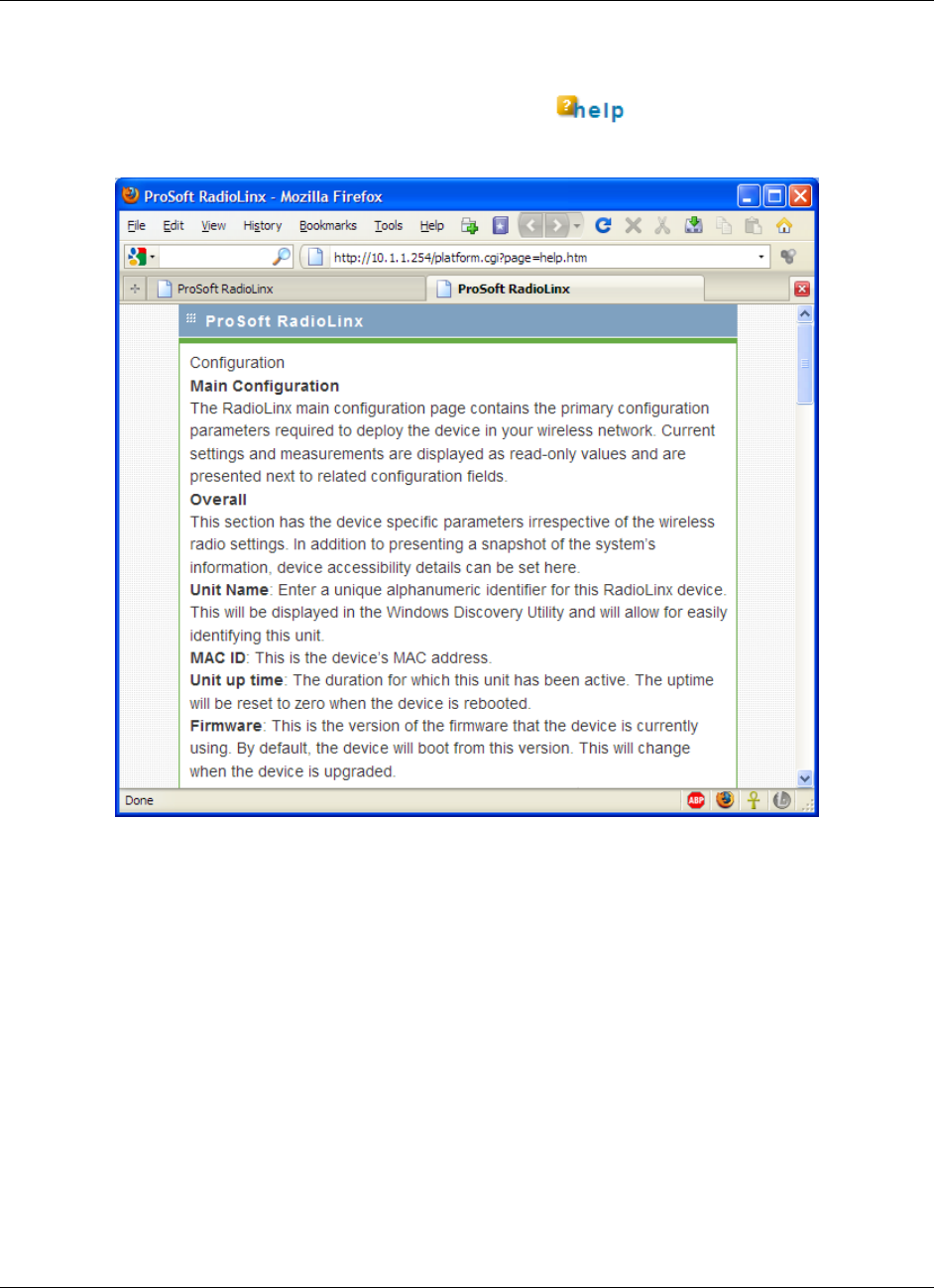
RLXIB-IHN ♦ 802.11n RadioLinx Configuration Manager
Industrial Hotspot User Manual
ProSoft Technology, Inc. Page 51 of 171
May 23, 2011
Configuration Help
Help is available for each page in the Radio Configuration / Diagnostic Utility.
To view help about the current page, click the button. This action
opens a help page in a new browser window.

RadioLinx Configuration Manager RLXIB-IHN ♦ 802.11n
User Manual Industrial Hotspot
Page 52 of 171 ProSoft Technology, Inc.
May 23, 2011
4.1 Login
The login page authenticates users and ensures that only authorized users can
view or modify this device's settings.
4.1.1 Login User Name and Password
The RLXIB-IHN accepts two types of logins:
Administrator
Guest
Administrator login
With administrative privileges, you can view or modify the configuration of the
radio.
Enter the user name in lower case, no quotes to login to the device and view/edit
its configuration.
The default administrator user name is "admin".
The default password is "password".
The user name and password are case sensitive.
Guest login
With guest privileges, you can view the existing configuration, but not change it.
The default guest user name is "guest".
The default password is "password".
4.1.2 Session Timeout
For extra security, administrators will be logged out of the radio automatically,
after a period of inactivity. The inactivity timeout is five minutes. You can change
the inactivity timeout on the Access Configuration tab (page 80).
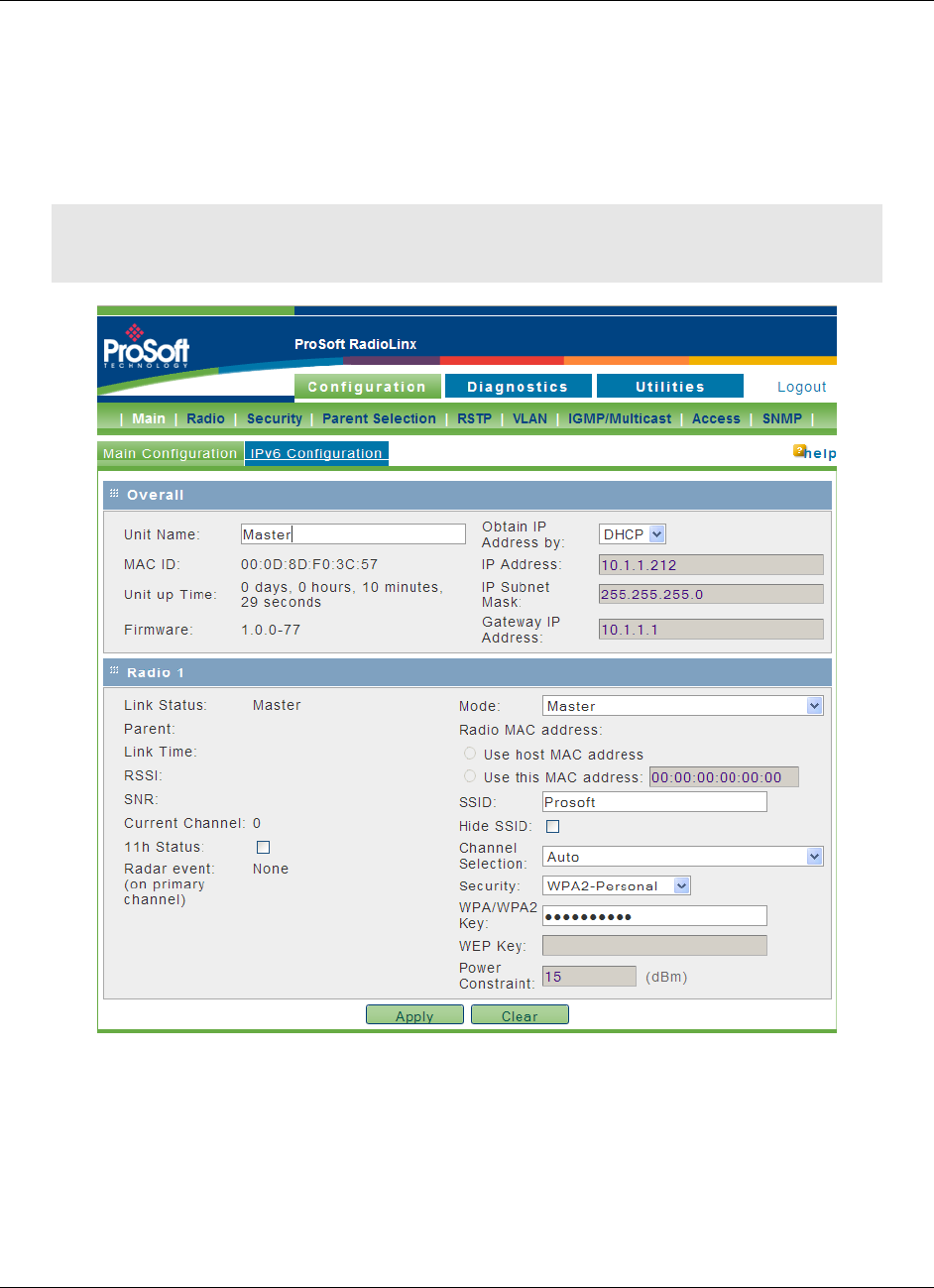
RLXIB-IHN ♦ 802.11n RadioLinx Configuration Manager
Industrial Hotspot User Manual
ProSoft Technology, Inc. Page 53 of 171
May 23, 2011
4.2 Configuration
4.2.1 Overall
The radio's Home Page contains an overview of the radio's configuration and
status. It also contains navigation links (tabs) to other configuration pages.
Note: Different versions of the RLXIB Radios support different functionality. You may see more or
fewer options on this page, depending on the version of the radio you purchased.

RadioLinx Configuration Manager RLXIB-IHN ♦ 802.11n
User Manual Industrial Hotspot
Page 54 of 171 ProSoft Technology, Inc.
May 23, 2011
Important: In order to connect to a RLXIB-IHN radio from a web browser or SNMP agent, both
your computer and the radio must have IP addresses, and these IP addresses must be on the
same subnet.
Parameter Description
Unit Name The name of the selected radio.
MAC ID The MAC address of the selected radio. The MAC ID is also printed on
the side of the radio.
Unit up time The length of time the radio has operated since the last system power-
up, or the last system reset.
Firmware The version of firmware currently installed. All radios on the network
must have the same firmware versions installed. For more information
on firmware versions, refer to Update firmware (page 101)
Obtain IP address by If a DHCP (Dynamic Host Control Protocol) server is configured on your
local area network, the DHCP server can assign IP addresses
automatically.
If you prefer to assign a Static (Fixed) IP address, select STATIC, and
then enter the IP Address, Subnet Mask and Default Gateway in the
Overall area of the Radio web configuration form.
Note: You must assign a static IP address If you are using the radio in
client mode.
IP Address If you are using a static IP address for this radio, enter an IP address
that will not interfere with any other devices on the network. Your
network administrator can provide a block of IP addresses you can use.
IP Subnet Mask Enter the Subnet Mask provided by your Network Administrator.
Gateway IP Address Enter the Default Gateway address provided by your Network
Administrator.
DHCP (Dynamic Host Control Protocol) is a service provided by a server
(typically a router or a firewall) on a local area network. Devices on a network
that supports DHCP can request and receive an IP address from the DHCP
server. RLXIB radios support DHCP; by default, they attempt to obtain an IP
address from a DHCP server.
If a DHCP server is not available, the radio will not be able to acquire an IP
address automatically, therefore you must assign an IP address, subnet mask
and default gateway to the radio so that it can communicate on the network.
You can also assign a Static (fixed or permanent) IP address to the radio to
make it easier to identify and configure the radio. Static IP addresses are
particularly useful when configuring radios to serve as Access Points, or for
radios that must be accessible through a firewall.
A detailed discussion of TCP/IP networking is beyond the scope of this manual.
Refer to the following Microsoft knowledgebase article for more information:
http://support.microsoft.com/kb/164015
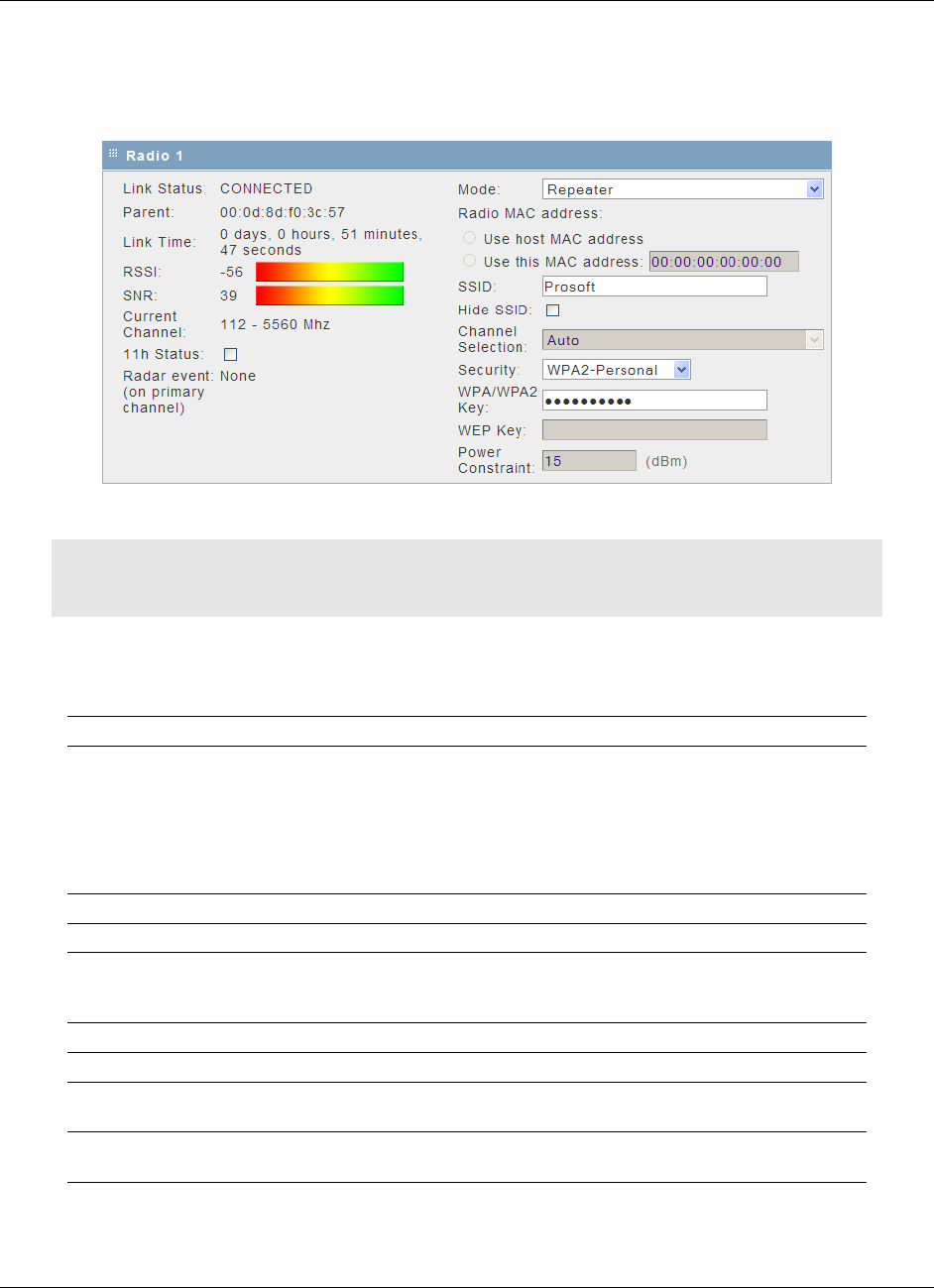
RLXIB-IHN ♦ 802.11n RadioLinx Configuration Manager
Industrial Hotspot User Manual
ProSoft Technology, Inc. Page 55 of 171
May 23, 2011
4.2.2 Radio 1
The following fields appear in the Radio Status area of the Main Configuration
page.
Note: Each Radio's configuration is unique. If the hardware supports two radios, there will be two
instances of the Radio Configuration/Status area, one per radio.
For advanced radio configuration, click the Radio tab (page 59).
Parameter Description
Link Status Master: The radio is configured as a Master.
Connected: The radio is currently connected to a Parent
Associated: The radio is associated with a Parent, but is not
currently connected
Connecting: The radio is attempting to connect to a Parent
Disconnected: The radio is unable to connect to a Parent
Parent The MAC address of the parent radio, if connected
Link Time The amount of time the parent link has been active
RSSI The received signal strength indicator (RSSI) value in dBm from the
parent link; this is a measurement of how strong the connected parent's
signal is as seen by this device.
SNR This is the signal to noise ratio of the parent link.
Current Channel The frequency channel used by the parent link, if connected
11h status Select this check box to enable 802.11h dynamic frequency detection
when operating in the 5 GHz band.
Radar event If 802.11h is enabled, this field indicates if a radar event has been
detected on the 5 GHz channel in use by the parent link

RadioLinx Configuration Manager RLXIB-IHN ♦ 802.11n
User Manual Industrial Hotspot
Page 56 of 171 ProSoft Technology, Inc.
May 23, 2011
Parameter Description
Mode Choose the mode for this radio in the wireless network
Master (there can be only 1 per wireless network)
Repeater
Client
Use host MAC address Select this option to use the MAC address of the Ethernet device
connected to the client radio, rather than the radio's own MAC address.
Use this setting if devices communicating to the host require a
connection to a specific MAC address.
Note: This setting is only applicable in client mode.
Use this MAC address Select this option to enter a custom MAC address for the device.
Note: This setting is only applicable in client mode. In all other roles,
the Radio1 MAC address is applied to all traffic from the radio.
SSID Assign a network name (SSID) of up to 32 characters. The radio uses
this name in all network references. All radios in a network must have
the same SSID. SSID names are case-sensitive.
Hide SSID Select this option to prevent broadcast of the SSID.
Channel Selection The Master devices in the wireless network define the channel of
operation; this field is not available for repeater or client roles. If
configuring an 802.11n radio, select a channel from the list of 2.4 GHz
or 5 GHz channels or choose "auto" to let system determine the best
channel to use based on the environment noise levels for the available
channels.

RLXIB-IHN ♦ 802.11n RadioLinx Configuration Manager
Industrial Hotspot User Manual
ProSoft Technology, Inc. Page 57 of 171
May 23, 2011
Parameter Description
Security The RLXIB-IHN supports a variety of consumer and enterprise security,
encryption, and authentication options. The Master device in the
wireless network defines the security. If this RLXIB-IHN radio is a
Repeater or Client mode, you must use the same security settings as
the network defined by the Master. Choose from one of the following
options:
Parameter Description
None Open/no security. Any wireless device can
connect to this AP (subject to an ACL policy).
WEP 64 bit Select this to use WEP (Wired Equivalent
Privacy) encryption on the data packets. WEP is
not considered secure, and can be easily
broken. Select this only if there are clients that
can only support WEP security. The 64-bit
encryption type is the least strong of WEP
encryption options.
WEP 128 bit This uses 128 bit-encryption for WEP security.
The larger size WEP keys provide stronger
encryption, thus making the key more difficult to
crack (i.e. 64 WEP has a 40 bit key, which is
less secure than the 128 WEP, which has a 104
bit key).
WPA - Personal WPA (Wi-Fi Protected Access) is part of the
wireless security standard (802.11i)
standardized by the Wi-Fi Alliance. It supports
TKIP/CCMP encryption (default is TKIP). The
personal authentication is the pre-shared key
(PSK) that is an alphanumeric pass phrase
shared with the wireless peer.
WPA - Enterprise This selection allows you to use WPA with
RADIUS server authentication. The
Configuration > Security pages contain
configuration parameters to enable RADIUS
server authentication.
WPA2 - Personal WPA2 is the implementation of the security
standard specified in final 802.11i. It supports
AES encryption, and uses pre-shared key (PSK)
based authentication.
WPA2 - Enterprise WPA2 is the implementation of the security
standard specified in final 802.11i. It supports
TKIP/AES encryption (default is AES), and uses
RADIUS server (Enterprise) based
authentication.
WPA/WPA2 Key Enter the alphanumeric password for WPA or WPA2 PSK
authentication. Upstream parents or downstream clients must also be
configured with the same password.
WEP Key Choose any alphanumeric phrase (longer than 8 characters for optimal
security) that is shared with upstream parents or downstream clients.
Power Constraint This limits the maximum power that the client can use. This parameter
is applicable only for MASTER/REPEATER mode.
Click Apply to save your changes.
Click Clear to discard your changes.
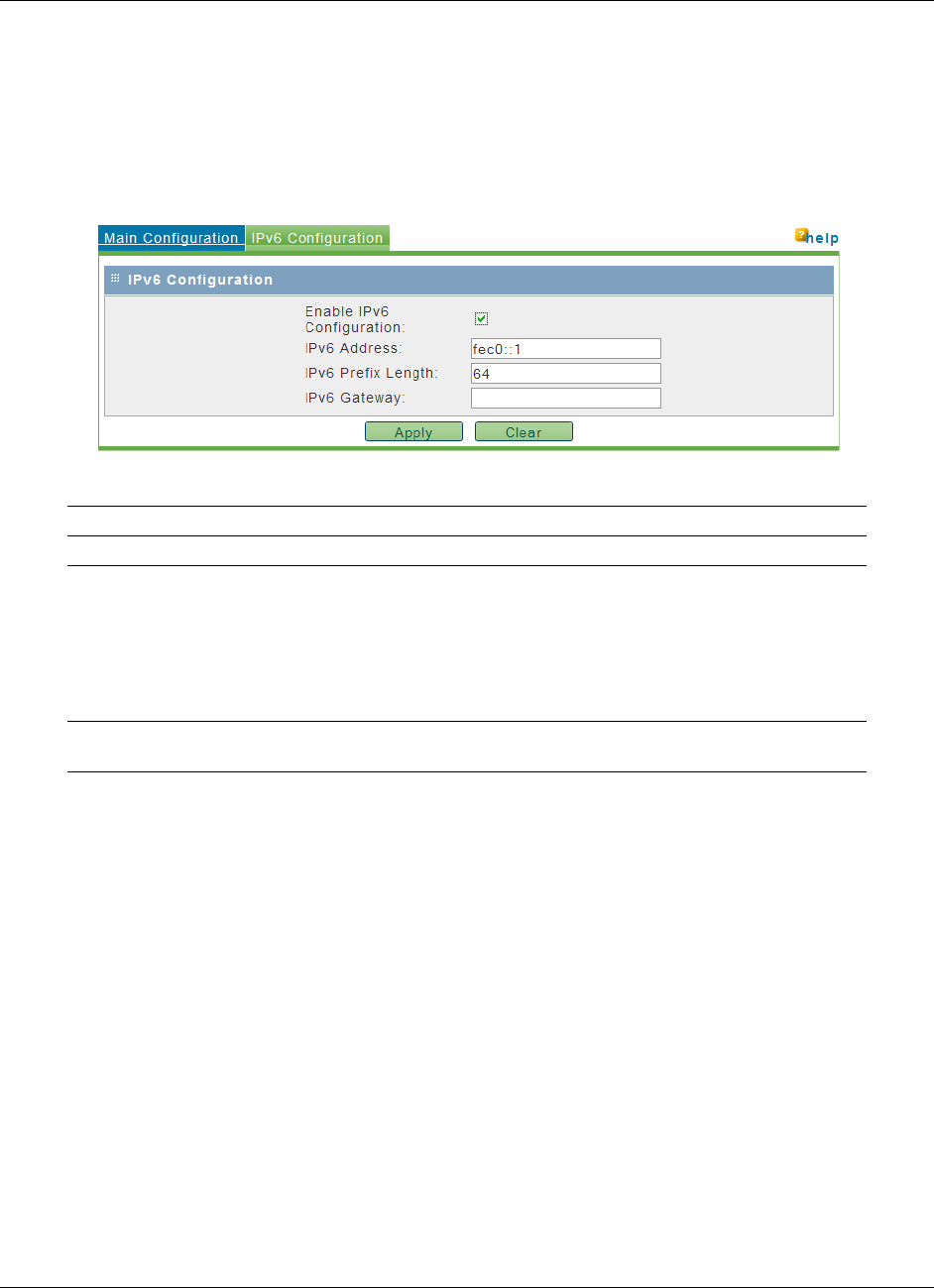
RadioLinx Configuration Manager RLXIB-IHN ♦ 802.11n
User Manual Industrial Hotspot
Page 58 of 171 ProSoft Technology, Inc.
May 23, 2011
4.2.3 IPv6 Configuration
The RLXIB-IHN can operate as an IPv6 host. When this mode is enabled, and
the static IPv6 networking parameters are configured, the management interface
is accessible in an IPv6 network.
To use the RLXIB-IHN in an IPv6 network, select (check) the ENABLE IPV6
CONFIGURATION checkbox.
Enter the following parameters to configure the static IPv6 networking:
Parameter Description
IPv6 Address The static IPv6 address to assign to the RLXIB-IHN Device.
IPv6 Prefix Length The IPv6 network (subnet) is identified by the initial bits of the address
called the prefix. All hosts in the network use the same initial bits for
their IPv6 address; the number of common initial bits in the network's
addresses is set by the prefix length field.
Note: If you change the LAN IP address of the device, the browser will
not respond when you 'Apply' changes. You must use the new IP
address to connect to the web management interface of the device.
IPv6 Gateway IPv6 address of the gateway through which the destination host or
network can be reached.
Click Apply to save your changes.
Click Clear to discard your changes.
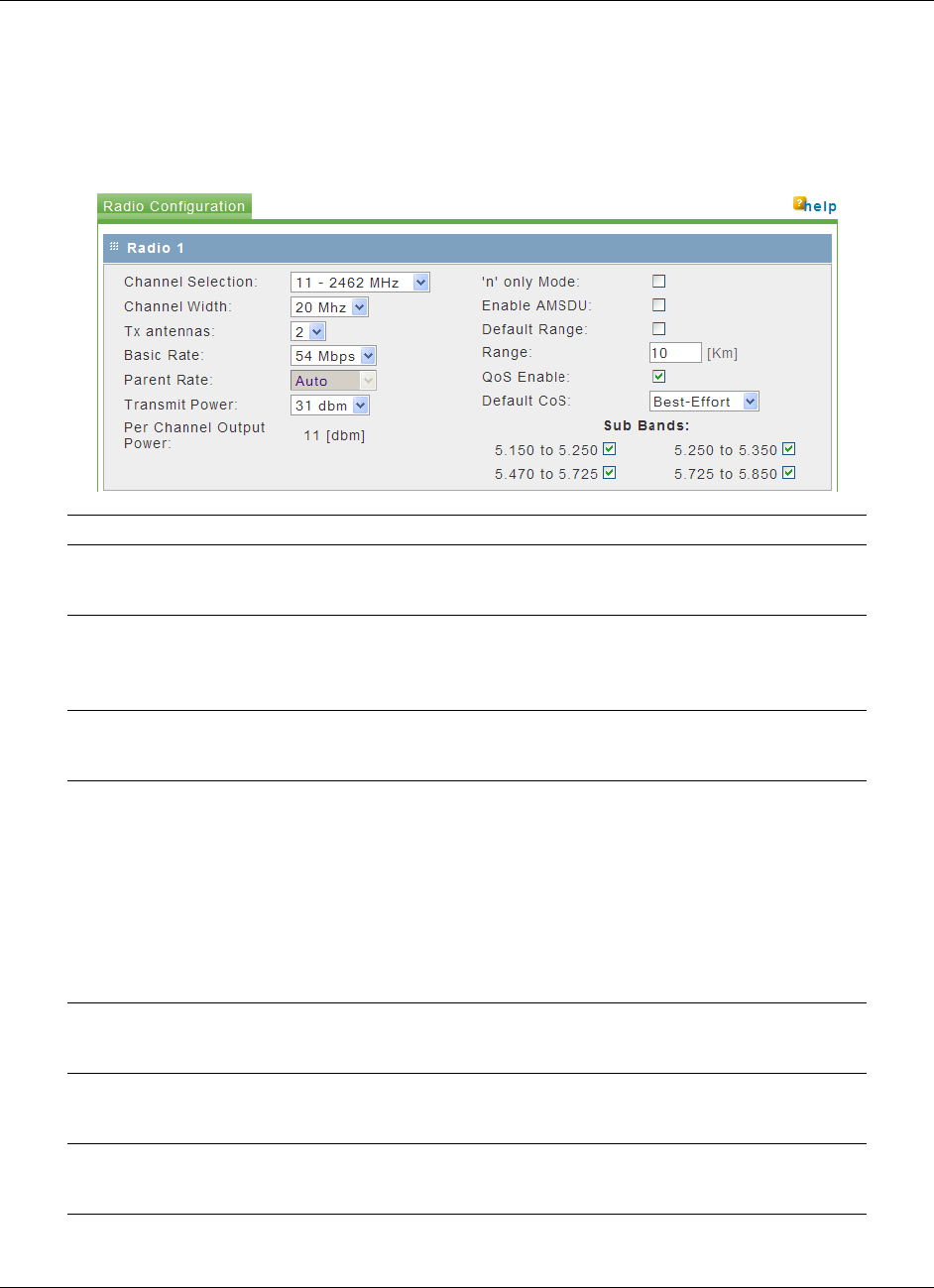
RLXIB-IHN ♦ 802.11n RadioLinx Configuration Manager
Industrial Hotspot User Manual
ProSoft Technology, Inc. Page 59 of 171
May 23, 2011
4.2.4 Radio Configuration
Use the settings in the Radio Configuration tab to configure advanced settings for
the radio. Here you can define the wireless link rate of the radio's connection to
parents or children, and set 802.11 channels, power levels, and bands to use for
the link.
Parameter Description
Channel Selection Select a channel from the dropdown list, or choose 'auto' to let the radio
determine the best channel to use based on the environment noise
levels for the available channels.
Channel Width Select the channel width: either 20 MHz or 40 MHz channel bonding
(spacing), or choose 'auto' to let the radio determine the best channel
spacing to use.
Note: This setting applies to 802.11n traffic only.
Tx antennas This field allows you to limit the number of transmit antennas to use,
thereby limiting the potential 802.11 rates. Two transmit antennas are
required for full 802.11n speeds.
Basic Rate The basic rate governs the transmission speed to use in a wireless link
with a parent, child, or 802.11 true client.
Select 'auto' from the dropdown list to let the radio determine the
optimal rate to use based on environmental conditions and the endpoint
capabilities.
You can also select 802.11a and 802.11g rates (6, 9, 12, 18, 24, 48,
and 54 Mbps), as well as 802.11n MCS index values ranging from 0 to
15, assuming both Tx antennas are available for use. If the Tx antenna
field is set to 1, or only a single antenna is installed, the 802.11n MCS
index values are from 0 to 7.
Parent Rate This parameter is for radios in a Repeater or Child role, and defines the
maximum rate to use when connecting to the parent. Select 'auto', or
choose the 802.11 link rate from the dropdown list.
Transmit Power Select the output power from the dropdown list. Higher transmit power
allows the radio to connect over greater distances. The maximum
output power is determined by the region in which the radio is sold.
'n' only Mode Select (check) this check box to disable legacy (802.11a or 802.11g)
connections. This will ensure that the radio's bandwidth is only available
for clients connecting at 11n rates.

RadioLinx Configuration Manager RLXIB-IHN ♦ 802.11n
User Manual Industrial Hotspot
Page 60 of 171 ProSoft Technology, Inc.
May 23, 2011
Parameter Description
Enable AMSDU Select (check) this check box to aggregate small size TCP packets.
Small frames with the same physical source and destination endpoints
are combined into a single, larger frame to improve overall throughput
and decrease transmission overhead.
Range The Range setting allows the radios to account for round trip delays.
The Range settings should be the same in all radios in the network and
should be at least large enough to account for the length of any links.
Increasing the Range beyond what is necessary can cause a slight
decrease in throughput.
CAUTION: Decreasing the Range setting to less than the actual range
can prevent the radios from linking.
QoS Enable Select this check box to enable Quality of Service (QoS) for this radio.
When this is selected, the radio will use one of the following Default
CoS selections.
Default CoS Class of Service (CoS) prioritizes data traffic over the wireless link.
Select the default Class of Service that best matches the type of data
on your wireless network.
Parameter Description
Voice Highest priority queue, minimum delay. Used
typically to send time-sensitive data such as
Voice over IP (VoIP)
Video High priority queue, minimum delay. Used
typically to send time-sensitive data such as
Video and other streaming media
Best Effort Medium priority queue, medium throughput and
delay. Most traditional IP data is sent to this
queue.
Background Lowest priority queue, high throughput. Bulk data
that requires maximum throughput and is not
time-sensitive is typically sent to this queue (FTP
data, for example).
Sub Bands When in 802.11a mode (the 5 GHz band), you can allow the radio to
use one or more of the following available sub-bands for transmission:
5.150 to 5.250 GHz
5.250 to 5.350 GHz
5.470 to 5.725 GHz
5.725 to 5.850 GHz
The 5.25 and 5.47 bands require the radio to search for and avoid radar
from legacy systems. If radar is found, the radio must change to a
different band. You can disable these sub-bands if necessary, however
this limits the selection of channels the radio can use.
Another reason to disable some sub-bands is to prevent the radio from
moving to a band that is not supported by the antenna.
Click Apply to save your changes.
Click Clear to discard your changes.
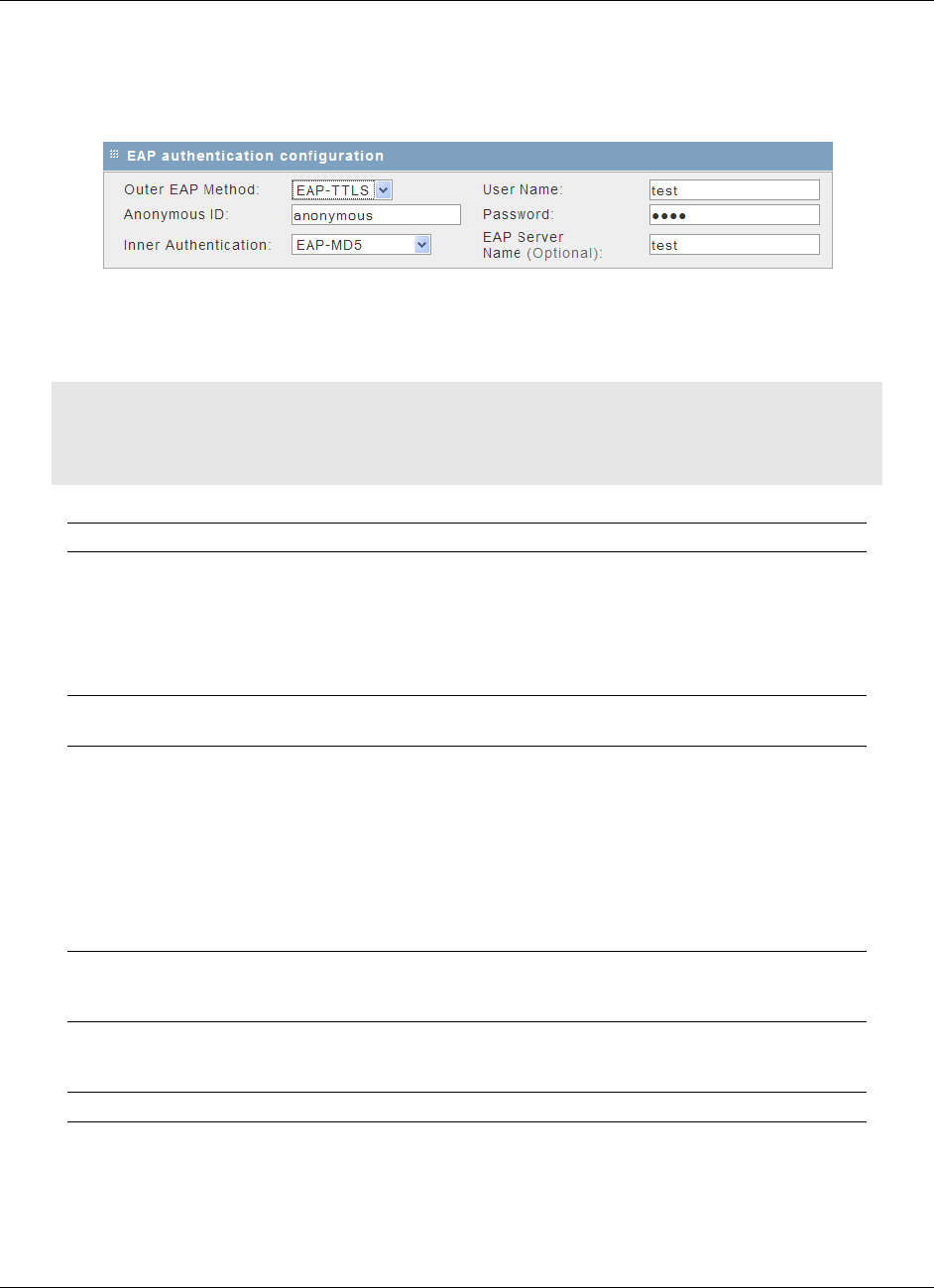
RLXIB-IHN ♦ 802.11n RadioLinx Configuration Manager
Industrial Hotspot User Manual
ProSoft Technology, Inc. Page 61 of 171
May 23, 2011
4.2.5 Security Configuration
The security tab allows you to configure external authentication servers, for
example, RADIUS, or other servers that support 802.1X link authentication.
These options are only available when the wireless network uses WPA-
ENTERPRISE or WPA2-ENTERPRISE security (page 55).
Note: A detailed discussion of RADIUS authentication and certificates is outside the scope of this
manual. Refer to the documentation for your RADIUS server to determine the proper procedure to
create and use authentication certificates.
Parameter Description
Outer EAP Method Outer authentication establishes a secure tunnel, over which the
username and passwords (inner authentication) will be exchanged.
Select the outer authentication method from the dropdown list. This
method must match the configuration of your authentication server.
EAP-TTLS (Tunneled Transport Layer Security)
EAP-PEAP (Protected Extensible Authentication Protocol)
Anonymous ID The Anonymous ID string is used as unencrypted identity with different
EAP types.
Inner Authentication Inner Authentication is the second layer for authorizing a client. This
layer encrypts the username and password, and sends them to the
authentication server over the tunnel created as part of outer
Authentication.
Select the inner authentication method from the dropdown list. This
method must match the configuration of your authentication server.
EAP-MD5 (Message-Digest algorithm 5)
EAP-MSCHAPv2 (Microsoft Challenge Handshake Authentication
Protocol version 2)
Username Enter the username configured on the authentication server for this
wireless network. This value is CaSe SeNsItIvE, and can contain any
alphanumeric characters.
Password Enter the password configured on the authentication server for this
wireless network. The password is CaSe SeNsItIvE, and can contain
alphanumeric, '_', or '-' characters.
EAP Server Name This option field is used to reference configured security servers.
Click Apply to save your changes.
Click Clear to discard your changes.
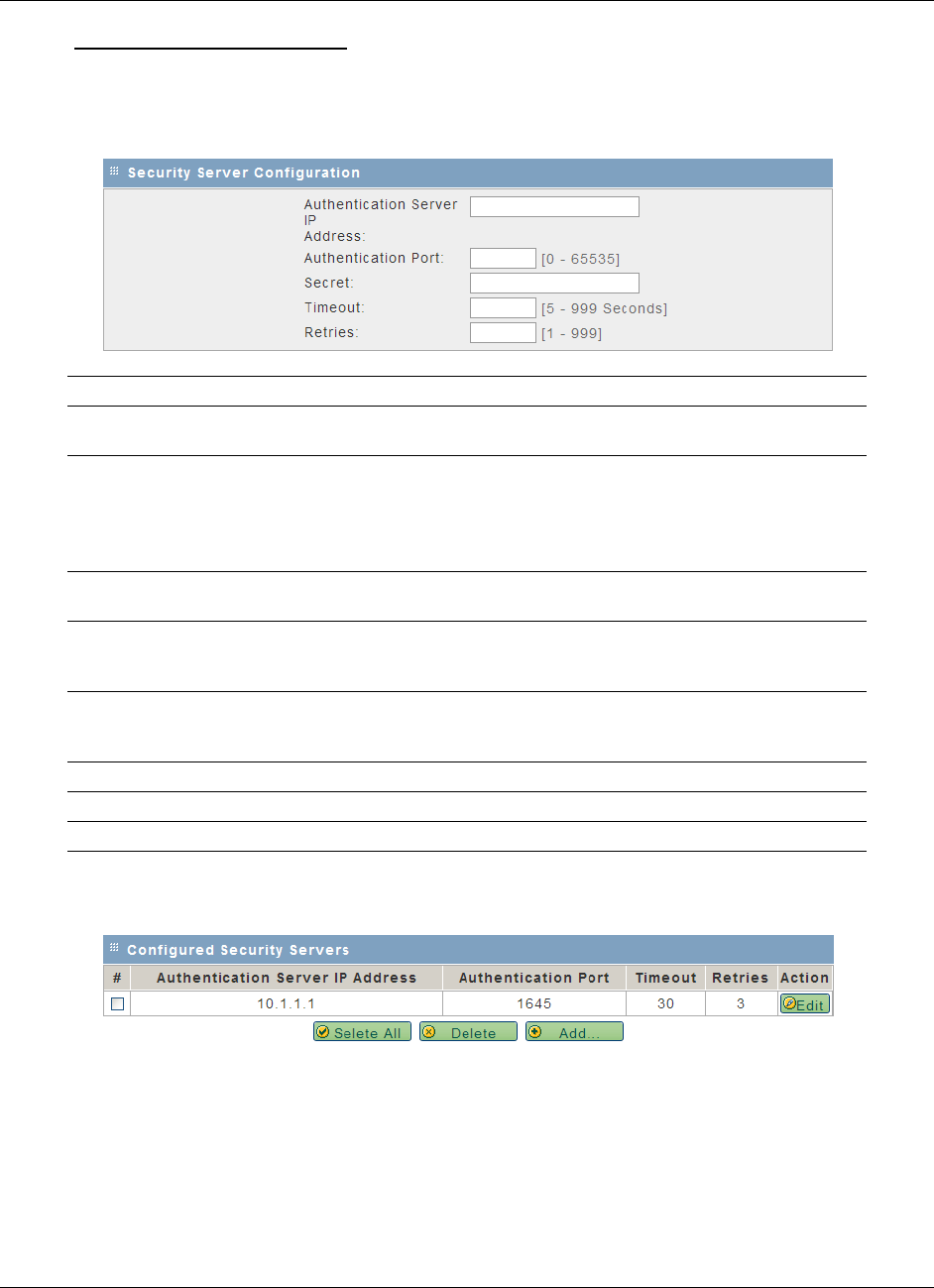
RadioLinx Configuration Manager RLXIB-IHN ♦ 802.11n
User Manual Industrial Hotspot
Page 62 of 171 ProSoft Technology, Inc.
May 23, 2011
Configured Security Servers
To use Security Server authentication, you must add one or more RADIUS
servers to the list. To add a server, click the Add button, and enter the server
information.
Parameter Description
Authentication Server IP
Address
IP address on the network where the RADIUS server is located.
Authentication Port The most commonly used authentication ports for RADIUS are 1812
(the default for Microsoft RADIUS server), or 1645 (legacy, the default
for Cisco and Juniper Networks RADIUS servers).
Other configurations are possible. Refer to the documentation for your
RADIUS server to determine the UDP port number to use (0 to 65535).
Secret Enter the Shared Secret for this RADIUS client (the RLXIB-IHN radio).
Obtain this information from the administrator for the RADIUS server.
Timeout The time in seconds for an authentication attempt to time out after no
response from the server. The value in seconds should be between 5
and 999.
Retries This field sets the number of times to retry authentication with this
server after a timeout before the authentication attempt fails. This value
should be between 1 and 999.
Select All Selects all configured security servers in the list
Delete Deletes the selected configured security servers from the list
Add Opens the Security Server Configuration page.
The following illustration shows a security server configured for RADIUS
authentication (Port 1645).
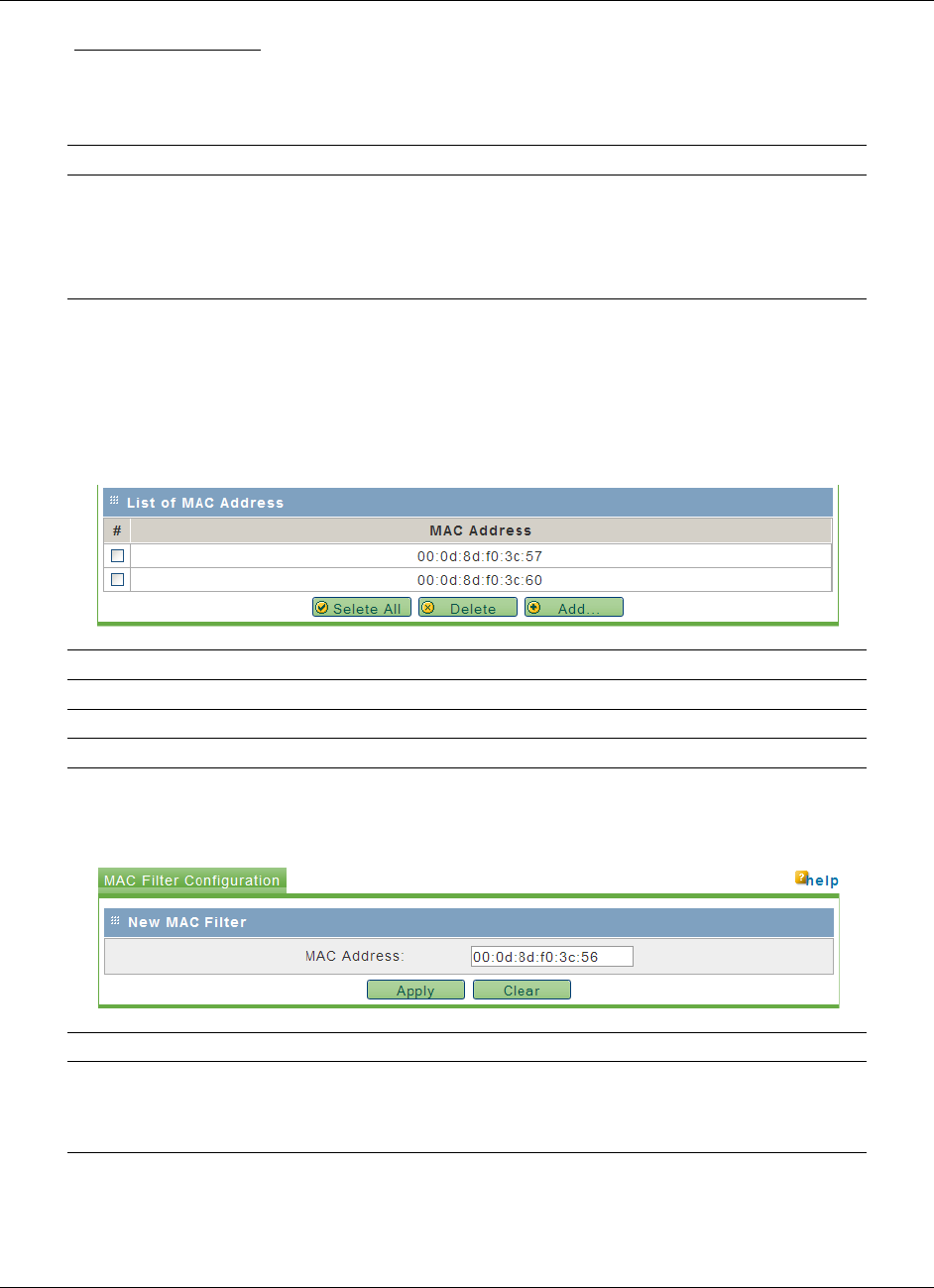
RLXIB-IHN ♦ 802.11n RadioLinx Configuration Manager
Industrial Hotspot User Manual
ProSoft Technology, Inc. Page 63 of 171
May 23, 2011
Access Control List
This page allows you to define specific MAC addresses to permit or deny client
connections to this device.
The default is "open" access, which does no filtering on specific MAC addresses.
Parameter Description
ACL Policy Status Select Allow, Deny, or Open.
Allow: only MAC addresses in the list can connect to the radio.
Deny: clients with a MAC address in the may not connect to the
radio.
Open: Any client can connect.
Click Apply to save your changes.
Click Clear to discard your changes.
List of MAC Addresses
This list shows all MAC addresses of devices to include in the Access Control
List for this radio.
Parameter Description
Select All Selects all the MAC addresses in the list.
Delete Deletes the selected MAC address from the list.
Add Opens the MAC Filter Configuration page.
MAC Filter Configuration
Use this page to add MAC addresses to the Access Control List.
Parameter Description
MAC Address Enter the hexadecimal MAC (Media Access Control) address of the
client that you would like to add to the list of MAC addresses, in the
format XX:XX:XX:XX:XX:XX where X is a number from 0 through 9 or A
through F.
Click Apply to save your changes.
Click Clear to discard your changes.
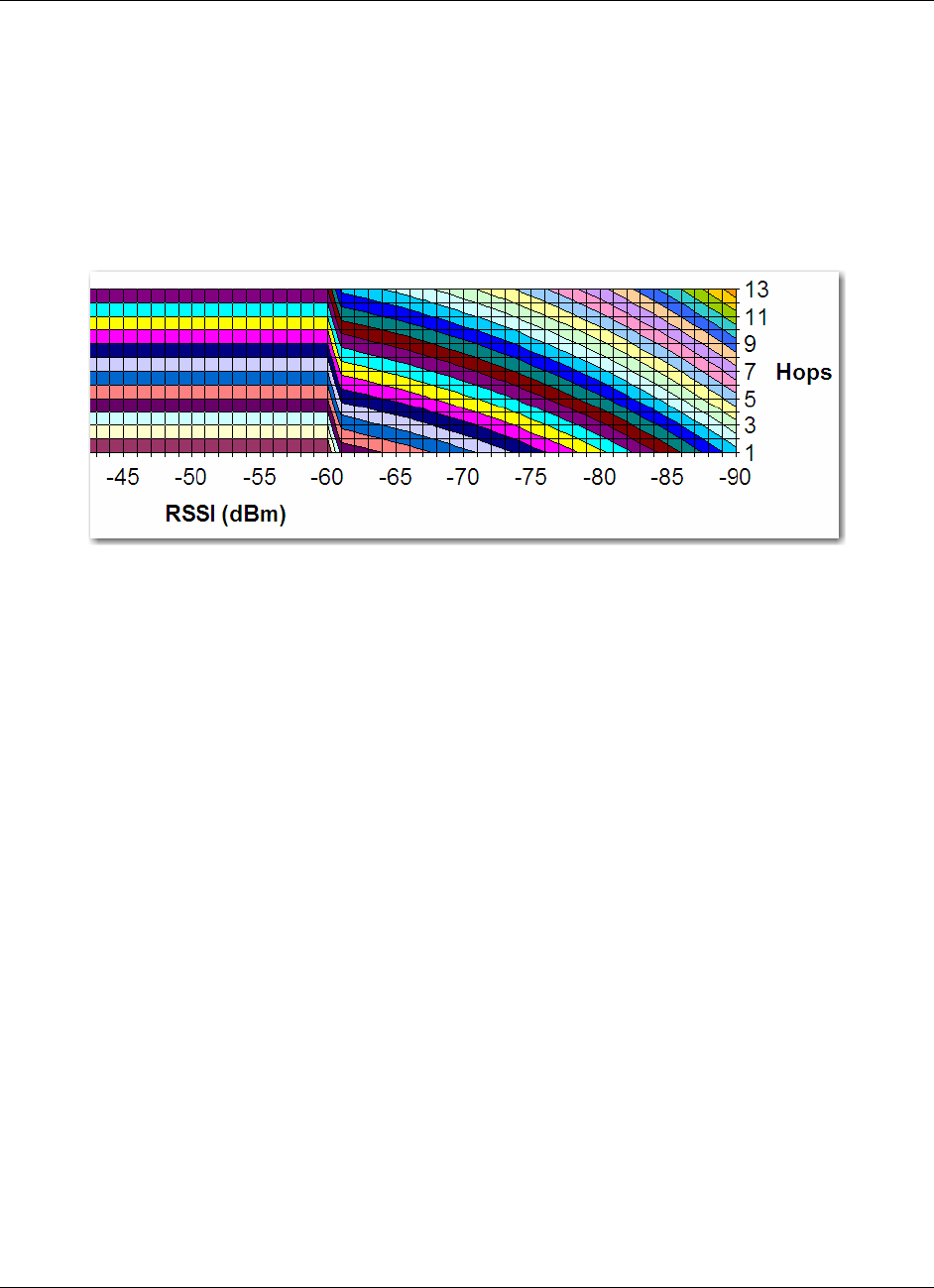
RadioLinx Configuration Manager RLXIB-IHN ♦ 802.11n
User Manual Industrial Hotspot
Page 64 of 171 ProSoft Technology, Inc.
May 23, 2011
4.2.6 Parent Selection
Parent selection allows repeater or client mode RLXIB-IHN radios to join a
wireless network using a predefined link selection method as defined in these
pages. At least one radio in the wireless network must be configured as a
Master, in order to define the operating channel and security of the network.
The Automatic Parent Selection algorithm uses a calculation to create a cost for
each possible parent radio that it detects. The following graph describes how the
cost is calculated when the signal strength threshold is set to -60 dBm.
Once per second, the RLXIB-IHN radio evaluates the link it has to its parent to
determine if this link is the best parent to use. A cost is calculated for each entry
and can be seen in the column labeled "Cost" in the preceding table. The cost
calculation is based not only on the strongest signal, but on several other factors
to provide optimum network communication. There is built in hysteresis to
prevent frequent link fluctuations.
When a repeater is not associated in the network, it will scan the available
channels for potential parents.
The following parameters allow you to specify additional parent selection rules.

RLXIB-IHN ♦ 802.11n RadioLinx Configuration Manager
Industrial Hotspot User Manual
ProSoft Technology, Inc. Page 65 of 171
May 23, 2011
Parameter Description
Selection Method When the "Available Parents List" is populated, the radio will use one of
the following selection methods to determine the parent to use for the
wireless network:
Parameter Description
Auto The auto mode uses a custom algorithm to assign
a cost of association to each detected potential
parent. This algorithm is a function of the potential
parent's signal strength, distance in hops from the
Master device.
Branch This selection requires the radio to connect to
parents that are a specific number of hops away
from the Master, up to a maximum of 10 hops.
If Branch Length of 1 is chosen, the radio will link
only to the Master radio. If Branch Length of 2 is
chosen, the radio will link only to another RLXIB-
IHN that is linked to the Master radio, and so on.
List Selection method using a preferred list of radio
MAC addresses. Parents are selected by priority
list or weighted list.
List/Priority: This selection method uses a
list of preferred parents. List/Priority
compares the list of detected available
parents to the prioritized list of parents to
determine the preferred parent connection
link.
List/Weight: This option combines the
automatic mode with the preferred list of
parents. If there are two or more available
parents that are also part of a user defined
preferred list, the automatic algorithm
chooses the parent from the preferred list.
Hop Count The number of hops to allow between this radio and the Master (1 to
10)
A value of 1 requires this radio to connect directly to the Master
Preferred List Select the preferred list type from the dropdown list. This selection only
applies If the selection method above is "List".
Parameter Description
Best in List The radio compares the list of radio MAC
addresses configured on this page with the
available parents. If two or more parents match
the MAC addresses on the preferred list, the
radio will select the best parent within the
preferred list.
Follow List Priority The radio uses the list of radio MAC addresses
to a parent from the list, in order from 1 to 8.
If the MAC address in List 1 is available, the
radio will use this link. If this parent is
unavailable, the radio will attempt to connect
with the address in List 2, and so on.
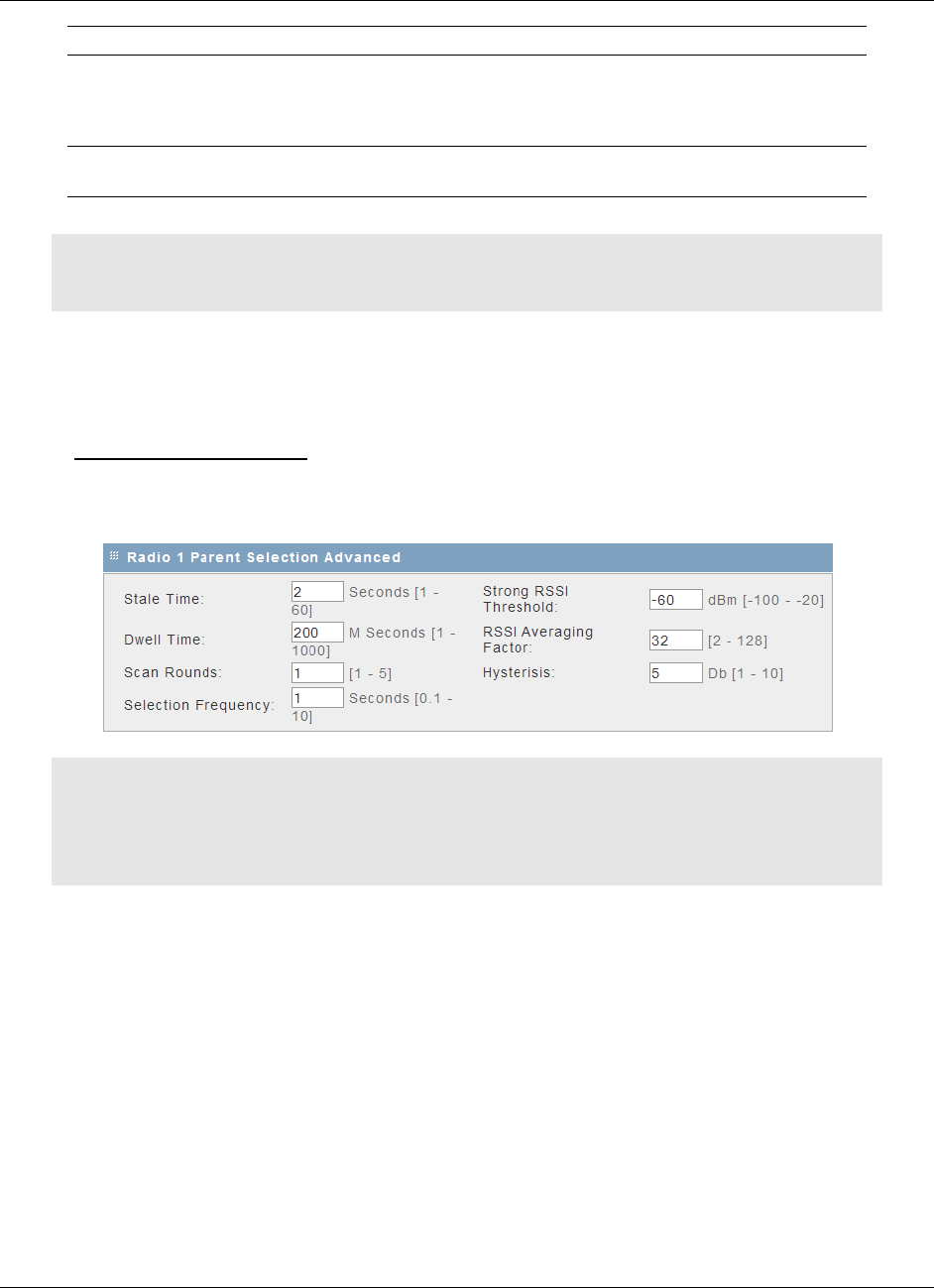
RadioLinx Configuration Manager RLXIB-IHN ♦ 802.11n
User Manual Industrial Hotspot
Page 66 of 171 ProSoft Technology, Inc.
May 23, 2011
Parameter Description
MAC Address List 1 to n Select the MAC address from the dropdown list for each potential
parent. The radio populates the dropdown list with all MAC addresses it
detects on the wireless network, or choose Custom MAC to enter an
address manually.
Custom MAC Address Use the Custom MAC Address field to enter a MAC address that is not
on the dropdown list.
Note: Each Radio's Parent Selection configuration is unique; if the hardware supports two radios,
there will be one instance of the configuration section for each radio.
Click Apply to save your changes.
Click Clear to discard your changes.
Advanced Configuration
Use the Advanced Configuration tab to change the default parent selection
settings.
Note: In most cases, the default settings are appropriate, however you may need to tune these
parameters to overcome environment-specific issues.
Note: Each Radio's Parent Selection configuration is unique; if the hardware supports two radios
there will be two instances of the below configuration section, one per radio.
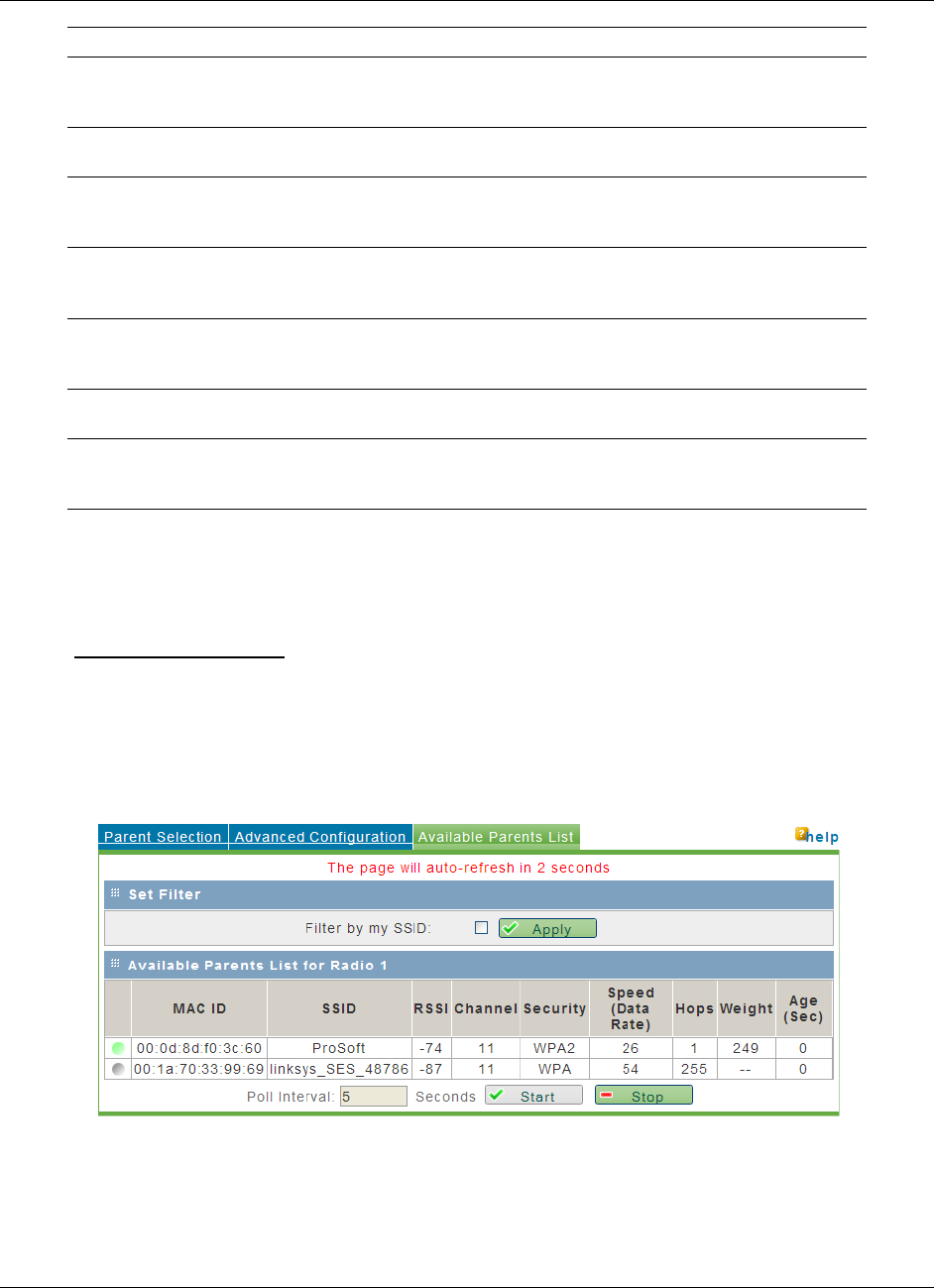
RLXIB-IHN ♦ 802.11n RadioLinx Configuration Manager
Industrial Hotspot User Manual
ProSoft Technology, Inc. Page 67 of 171
May 23, 2011
Parameter Description
Stale Time Enter the maximum age in seconds (1 to 60, default 15 seconds) to
remove an entry from the Available Parent List if a beacon frame is not
received within the stale time.
Dwell Time Enter the time in milliseconds (1 to 1000, default 15 milliseconds) that
the radio should scan each channel for parents.
Scan Rounds Enter the number of times (1 to 5, default 2 rounds) the non-associated
repeater or client should scan all available channels to populate the
Available Parent List, before it connects to a parent candidate.
Selection Frequency Enter the time in seconds (0.1 to 10 seconds, default 1 second) to
check for another parent candidate while the radio is already associated
to a parent.
Strong RSSI Threshold Enter the RSSI value (-100 to -20 dBm, default -60 dBm) above which a
stronger signal is not beneficial in the cost calculation for an available
parent.
RSSI Averaging Factor Enter a value from 2 to 128 to determine how long to average the RSSI
measured from a potential parent. Default is 32.
Hysteresis Enter a value from 1 to 10 dBm (default 3 dBm) to adjust the preference
given to the current parent to prevent inadvertent switching between
parent radios.
Click Apply to save your changes.
Click Clear to discard your changes.
Available Parents List
This page displays the list of available parents for this RLXIB-IHN radio. This
page does not apply to a radio configured as a Master.
Select (check) the FILTER BY MY SSID checkbox and click APPLY to restrict the list
of available parents to those with the same SSID as the radio you are
configuring.
Both the selected parent and all other potential detected parents will be listed. A
green dot in the leftmost column indicates the selected parent.
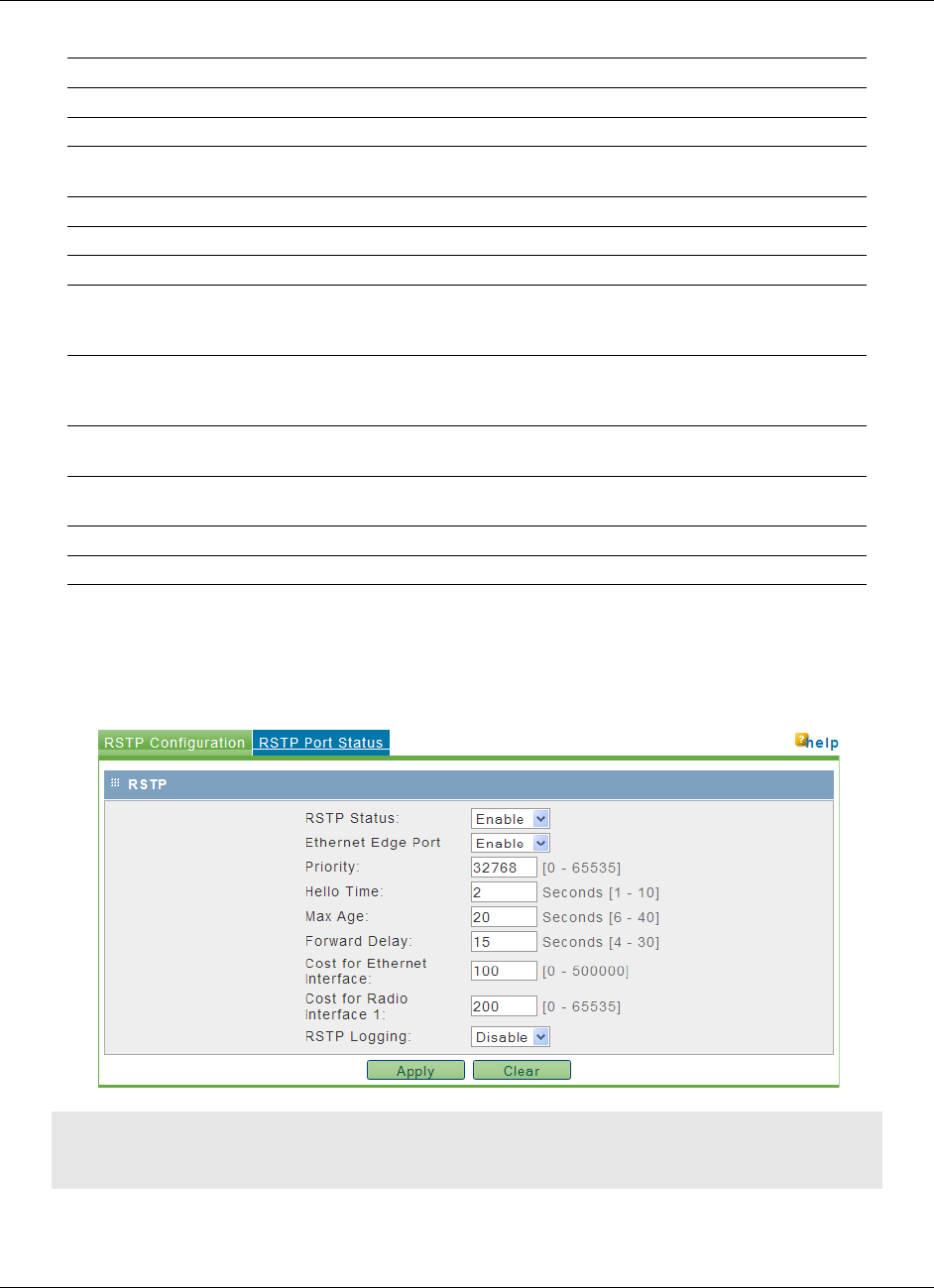
RadioLinx Configuration Manager RLXIB-IHN ♦ 802.11n
User Manual Industrial Hotspot
Page 68 of 171 ProSoft Technology, Inc.
May 23, 2011
Available Parents List (by radio)
Parameter Description
MAC ID A unique hexadecimal number that identifies any Ethernet device.
SSID Network Name (Service Set Identifier).
RSSI The received signal strength indicator (in dBm), or signal strength,
between this radio and the parent.
Channel The radio channel on which the device is transmitting.
Security The encryption type enabled for the device.
Speed (Data Rate) This is the maximum possible data rate (in Mbps) of the parent link.
Hops The number of hops to allow between this radio and the Master (1 to
10). A value of 1 indicates that the radio is directly connected to the
Master.
Weight This is the calculated cost (or weight) given to this parent based on the
automatic parent selection rules. A lower cost is a better parent
candidate.
Age (sec) The length of time (in seconds) since the radio last saw a packet from
this MAC address
Poll Interval Enter the interval in seconds to refresh the list of available parents on
this page.
Start Click to start refreshing the list.
Stop Click to stop refreshing the list.
4.2.7 RSTP Configuration
The software’s built-in Rapid Spanning Tree (RSTP) functionality enables you to
set up full redundancy between radios or other devices.
Note: RSTP is not VLAN aware. If RSTP is enabled in a network that uses VLANs, there may be
paths that have unblocked loops thereby nullifying the effectiveness of RSTP.

RLXIB-IHN ♦ 802.11n RadioLinx Configuration Manager
Industrial Hotspot User Manual
ProSoft Technology, Inc. Page 69 of 171
May 23, 2011
Parameter Description
RSTP Status Use the dropdown menu to enable or disable RSTP for this device.
Ethernet Edge Port Specify whether Ethernet port on the device is connected to another
RSTP enabled device. If yes, the edge port property is set to Disable.
Priority This is the priority component of the bridge identifier of this node. The
priority value should be a multiple of 4096.
Hello Time Hello time of the bridge represents the time interval between
transmissions of RSTP BPDUs. The value should be between 1 and 10
seconds, with 2 seconds as the default.
Max Age Max age is the upper limit on the number of hops the information in a
BPDU can traverse. This can be between 6 and 28 seconds, with 20
seconds as the default.
Forward Delay Forward delay is the time spent by a port in Learning state before
moving to the Forwarding state. This can be between 15 and 30
seconds, with 15 seconds as the default.
Cost for Ethernet
Interface
Cost of using Ethernet interface on AP.
Cost for Radio Interface 1 Cost of using a radio interface 1 based connection.
Cost for Radio Interface 2 Cost of using a radio interface 2 based connection (if applicable).
Click Apply to save your changes.
Click Clear to discard your changes.
Spanning Tree shuts off ports as necessary to prevent loops. If loops are created
in an Ethernet network, packets can be circulated endlessly, consuming all the
bandwidth and making the network unusable.
RSTP allows users to create truly redundant connections between any two points
in the network. The radios detect the redundant paths and keep one connection
alive for communications. If the primary connection fails for any reason, the
secondary connection is quickly transitioned to a state to forward packets,
allowing the network to adapt itself to handle problems without customer
intervention.
RSTP uses active communications between network devices to propagate
changes in the network and to cause transitions to occur much more quickly.
Because RSTP is an IEEE standard, IH radios work in conjunction with wired
Ethernet switches to form a redundant network.
Each RSTP device (RLXIB-IHN Radio or Ethernet switch) communicates with
other RSTP devices in the network via packets called Bridge Protocol Data Units
(BPDUs). BPDUs are sent out each of the devices ports. In a wired switch this
would be from each of the Ethernet ports. In an RLXIB-IHN Radio, in addition to
the Ethernet port, each wireless link is considered a port. These BPDUs are the
communications means to allow each RSTP device in the network to make sure
that the proper connections still exist.
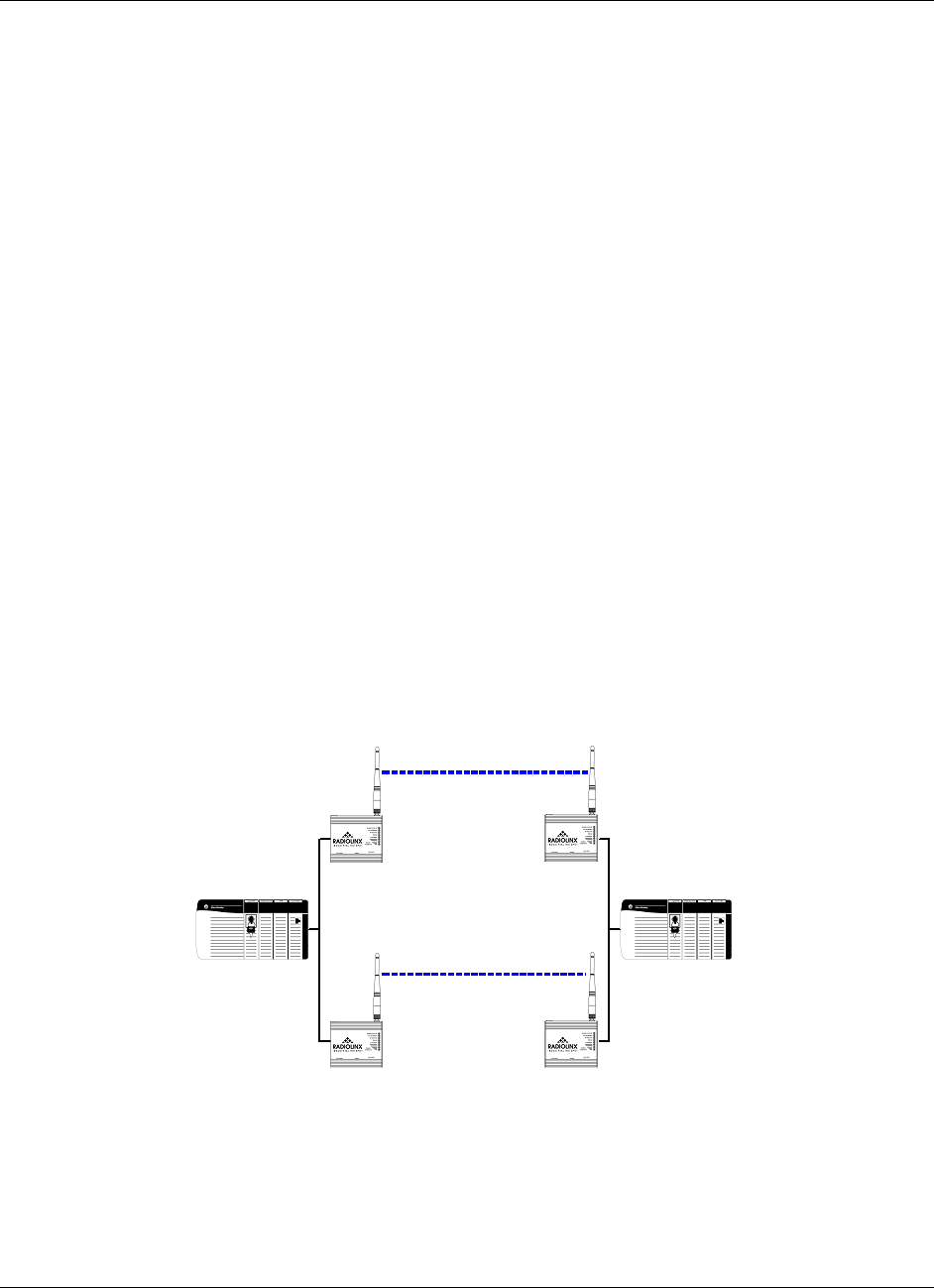
RadioLinx Configuration Manager RLXIB-IHN ♦ 802.11n
User Manual Industrial Hotspot
Page 70 of 171 ProSoft Technology, Inc.
May 23, 2011
BPDUs are sent out the port at a rate called the "Hello Time". The accepted
standard value for this is 2 seconds. If a radio (or any other RSTP device) does
not get a BPDU for 2 Hello Times, it assumes the RSTP device that had been
there is no longer available. It can then open an alternate path if one is available.
This process is much like the STP process. If other devices on the network are
not operating in rapid spanning tree mode, the radio will revert to normal
spanning tree operation on a per-port basis.
RSTP provides a performance enhancement over STP operation. By
comparison, the radio using the STP algorithm would revert its port to the
listening state, and then to the learning state, before returning to the forwarding
state. Each of these states takes at least 15 seconds, during which the STP
devices are listening for BPDUs to re-negotiate the network topology. The
advantage of using the RSTP functionality is that is uses active handshaking
between adjacent RSTP devices to re-negotiate the network topology. This
process takes one to two seconds.
Each RLXIB-IHN Radio contains a switch table, which tells it how to forward
Ethernet packets to get them to their proper destination. When the network
topology changes, the RLXIB-IHN Radio flushes its Ethernet switch table
immediately. This allows it to pass traffic immediately over the new network
topology and learn the configuration in the process. Until the learning is
complete, the packets are broadcast to their destination. As each packet is seen
and the switch table rebuilds, the radios return to directing packets to their
destinations.
The primary reason for creating a Spanning Tree is that it allows you to create
fully redundant paths. If any single radio in a redundant path loses its connection,
another path still exists, and the connection will be updated and communication
restored.
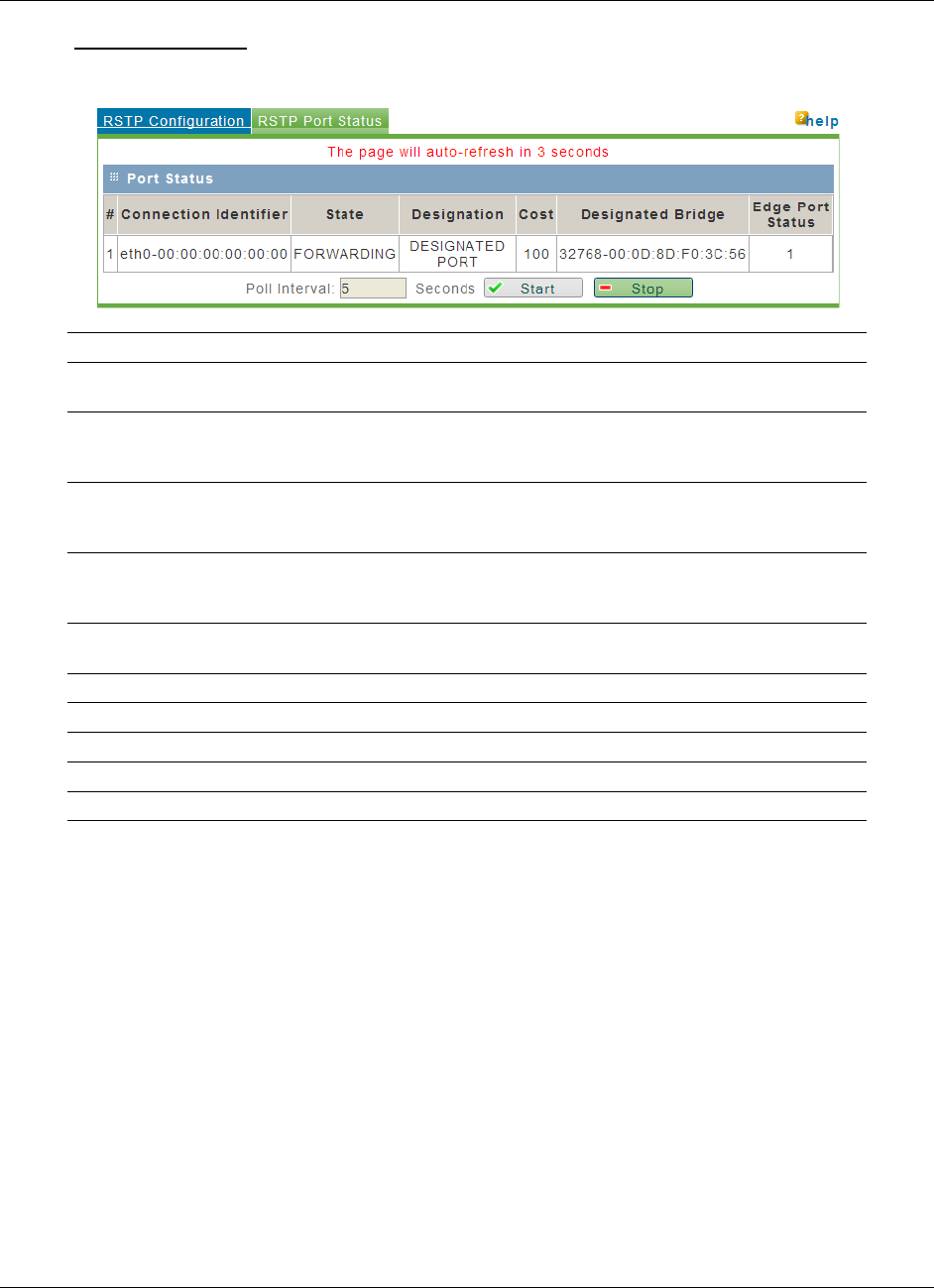
RLXIB-IHN ♦ 802.11n RadioLinx Configuration Manager
Industrial Hotspot User Manual
ProSoft Technology, Inc. Page 71 of 171
May 23, 2011
RSTP Port Status
The RSTP Port Status tab lists all RSTP ports detected on the network.
Parameter Description
Connection Name of the interface on which the connection to a peer has been
made on this device.
MAC Address This is the identifier of a particular connection with this device. It is a
combination of interface name & MAC address based identifier. The
MAC address of the peer is zero for an Ethernet based connection.
State The current Spanning Tree state of the port. Possible states are
Blocking, Learning, Listening, and Forwarding. Forwarding packets can
be transferred.
Designation This field is the RSTP designation for the network branch off a
connection. Possible designations are Designated, Root, Alternate,
Backup, or Disabled.
Cost The cumulative cost of all wired and wireless links from the port to the
Spanning Tree root.
Designated Bridge The next bridge towards the root of tree on this connection.
Edge Port Edge port status of this connection.
Poll Interval Enter the interval in seconds to refresh the Port Status list on this page.
Start Click to start refreshing the list.
Stop Click to stop refreshing the list.
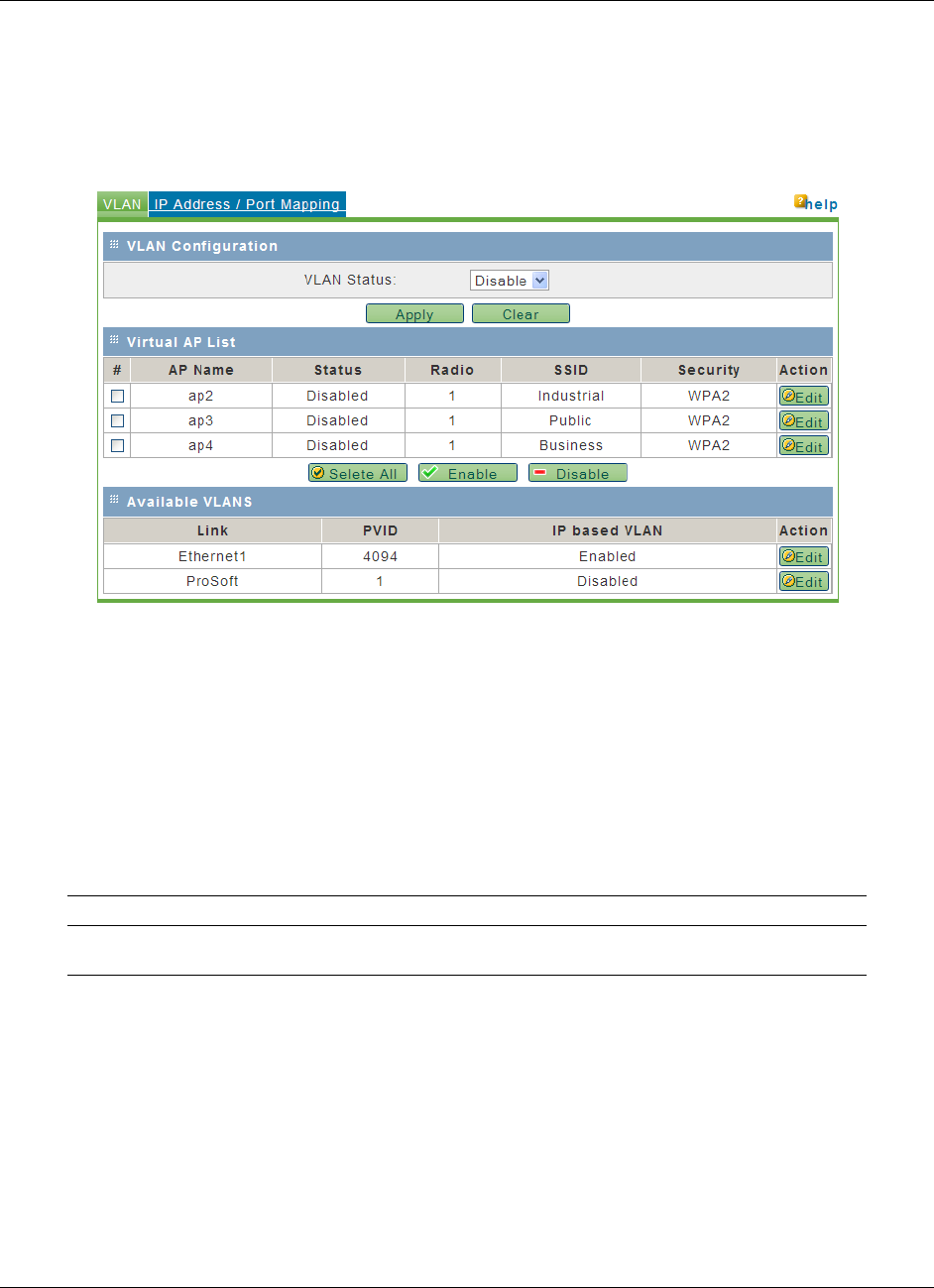
RadioLinx Configuration Manager RLXIB-IHN ♦ 802.11n
User Manual Industrial Hotspot
Page 72 of 171 ProSoft Technology, Inc.
May 23, 2011
4.2.8 VLAN Configuration
The RLXIB-IHN can use VLAN tagging to divide wireless network traffic into
segments. Traffic originating from the Ethernet port can be filtered by VLAN tags
before being transmitted over the wireless network. This is accomplished on the
RLXIB-IHN with virtual APs.
A given radio can have multiple virtual APs (VAPs) configured on it, and these
virtual APs can be active concurrently. There is a general mode AP that is the
default link for parent and child connections. This general mode AP is VLAN-
aware, in that there is filtering for VLAN tags enabled along this link.
When a new virtual AP is created it can be assigned a VLAN tag, and this can be
in use over a radio concurrently with the general mode AP. In this case, only
packets that match the VLAN tag will be sent over this new virtual AP link to
other endpoints in this VLAN. VLAN filtering is particularly useful to limit
broadcast packets of a device in a large network
Parameter Description
VLAN Status Use the dropdown menu to enable or disable VLAN filtering support on
this device.
Click Apply to save your changes.
Click Clear to discard your changes.

RLXIB-IHN ♦ 802.11n RadioLinx Configuration Manager
Industrial Hotspot User Manual
ProSoft Technology, Inc. Page 73 of 171
May 23, 2011
Virtual AP List
The Virtual AP list shows the configured Virtual Access Points on this device.
Parameter Description
AP Name This AP identifier uniquely identifies an AP in the list of configured APs.
Status An AP can be disabled if not in use and enabled when needed.
Disabling an AP does not delete the configuration, but stops the AP
from being broadcast over the configured radio. Enabling the AP
creates a wireless network, where computers and other devices can
join and communicate with the devices connected to the access point or
the devices on the Local Area Network (LAN). The AP must be enabled
for it to appear in the list of available VLANs.
Radio This is the physical radio on which this AP is running on.
SSID The Service Set Identifier (SSID) is the name of the wireless network
serviced by this AP. In order for computers or devices to communicate
via this wireless network serviced by this AP, all devices must select the
same SSID from the list of wireless networks in the area.
Security This field has a brief description of the security, encryption and
authentication combination assigned to the AP.
Edit Opens the APs Configuration page, allowing you to change the profile,
radio, mode, etc. that is used by this AP.
The actions that can be taken on APs are:
Parameter Description
Select All Selects all the APs in the table
Enable Enables the selected APs
Disable Stops the selected APs
The list of Available VLANs displays configured VLANs on this device. All
enabled APs as well as one or two Ethernet interfaces will appear in this list. The
PVID of the AP can be set as need by using the edit button to create a VLAN-
aware wireless network.
Parameter Description
Link This is the SSID of the virtual AP link or the physical Ethernet port
identifier. For devices with two Ethernet ports, both will be unique Links
in this list.
PVID VLAN ID used to classify the traffic from VLAN unaware devices.
IP Based VLAN Displays whether IP based VLAN filtering is enabled on the link.
Edit Opens the VLAN Configuration page, allowing you to edit the fields
described above.

RadioLinx Configuration Manager RLXIB-IHN ♦ 802.11n
User Manual Industrial Hotspot
Page 74 of 171 ProSoft Technology, Inc.
May 23, 2011
Virtual AP Configuration
VLAN support over the wireless network is provided by the use of virtual APs.
This configuration page allows you to create up to three unique VLANs on top of
the default (VLAN ID = 0) per radio, and so up to three unique Virtual APs can be
configured.
Parameter Description
Virtual AP Name The unique AP identifier displayed in the list of configured APs.
SSID The Service Set Identifier (SSID) is the name of the wireless network
serviced by this AP. Each AP should have a unique SSID if it is to be
used to create a VLAN aware wireless network. In order for computers
or devices to communicate via this wireless network serviced by this
AP, all devices must select the same SSID from the list of wireless
networks in the area.

RLXIB-IHN ♦ 802.11n RadioLinx Configuration Manager
Industrial Hotspot User Manual
ProSoft Technology, Inc. Page 75 of 171
May 23, 2011
Parameter Description
Security This defines the security parameters for the Virtual AP. The Master
device in the wireless network defines the security even for VAPs. If this
RLXIB-IHN radio is a Repeater or Client mode, you must use the same
security settings as the network defined by the Master. Choose from
one of the following options:
Parameter Description
None Open/no security. Any wireless device can
connect to this AP (subject to an ACL policy).
WEP 64 bit Select this to use WEP (Wired Equivalent
Privacy) encryption on the data packets. WEP is
not considered to be secure and can be easily
broken. Select this only if there are clients that
can only support WEP security. The 64-bit
encryption type is the least strong of WEP
encryption options.
WEP 128 bit This uses 128-bit encryption for WEP security.
The larger size WEP keys provide stronger
encryption, thus making the key more difficult to
crack (i.e. 64 WEP has a 40-bit key which is less
secure than the 128 WEP, which has a 104-bit
key).
WPA - Personal WPA (Wi-Fi Protected Access) is part of the
wireless security standard (802.11i)
standardized by the Wi-Fi Alliance. It supports
TKIP/CCMP encryption (default is TKIP). The
personal authentication is the preshared key
(PSK) that is an alphanumeric pass phrase
shared with the wireless peer.
WPA - Enterprise This selection allows you to use WPA with
RADIUS server authentication. The
Configuration > Security pages contain
configuration parameters to enable RADIUS
server authentication.
WPA2 - Personal WPA2 is the implementation of the security
standard specified in final 802.11i. It supports
AES encryption, and uses preshared key (PSK)
based authentication.
WPA2 - Enterprise WPA2 is the implementation of the security
standard specified in final 802.11i. It supports
TCKP/AES encryption (default is AES), and
uses RADIUS server (Enterprise) based
authentication.
WPA/WPA2 Key Enter the alphanumeric password for WPA or WPA2 PSK
authentication. Upstream parents or downstream clients must also be
configured with the same password.
WEP Key Choose any alphanumeric phrase (longer than 8 characters for optimal
security) that is shared with upstream parents or downstream clients.
Click Apply to save your changes.
Click Clear to discard your changes.
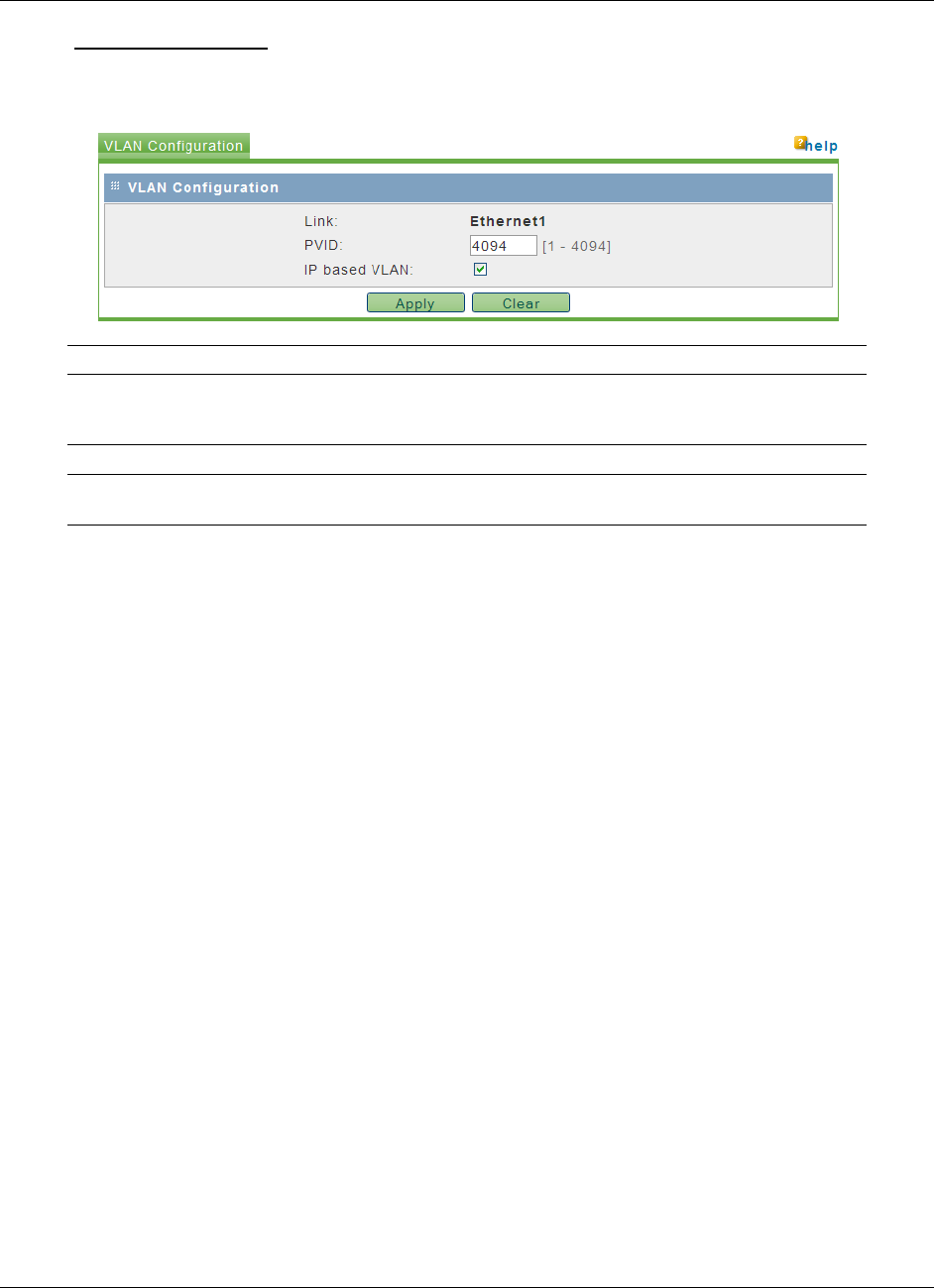
RadioLinx Configuration Manager RLXIB-IHN ♦ 802.11n
User Manual Industrial Hotspot
Page 76 of 171 ProSoft Technology, Inc.
May 23, 2011
VLAN Configuration
This configuration page allows you to modify the PVID of an available VLAN and
indicate if the VLAN is IP based.
Parameter Description
Link This is the SSID of the virtual AP link or the physical Ethernet port
identifier. For devices with two Ethernet ports, both will be unique Links
in this list.
PVID VLAN ID used to classify the traffic from VLAN unaware devices.
IP Based VLAN Displays whether IP based VLAN filtering is enabled on the link. The
default is enabled.
Click Apply to save your changes.
Click Clear to discard your changes.

RLXIB-IHN ♦ 802.11n RadioLinx Configuration Manager
Industrial Hotspot User Manual
ProSoft Technology, Inc. Page 77 of 171
May 23, 2011
IP Address / Port Mapping
In order to assign VLAN tags to packets according to source IP address, the IP
address must be mapped to VLAN in advance.
These mappings apply to the traffic originating from VLAN unaware devices, and
have higher preference over the PVID setting on the link.
Parameter Description
IP Address This is the IP address that will be mapped to a particular VLAN & CoS.
Subnet Mask Subnet mask of the IP Address.
VLAN VLAN ID to classify the traffic from the IP address.
Class of Service (CoS) Class of Service (CoS) prioritizes data traffic over the wireless link.
Select the default Class of Service that best matches the type of data
on your wireless network.
Parameter Description
Voice Highest priority queue, minimum delay. Used
typically to send time-sensitive data such as
Voice over IP (VoIP)
Video High priority queue, minimum delay. Used
typically to send time-sensitive data such as
Video and other streaming media
Best Effort Medium priority queue, medium throughput and
delay. Most traditional IP data is sent to this
queue.
Background Lowest priority queue, high throughput. Bulk
data that requires maximum throughput and is
not time-sensitive is typically sent to this queue
(FTP data, for example).
Edit Opens the IP ADDRESS / PORT MAPPING configuration page, allowing you
to modify the mapping for this IP address.
The actions that can be taken on IP Address mappings are:
Parameter Description
Select All Selects all the address mapping entries in the table
Enable Enables the selected address mapping entries
Delete Stops and deletes the selected address mapping entries
Add Clicking this button will link to the address mapping configuration page.
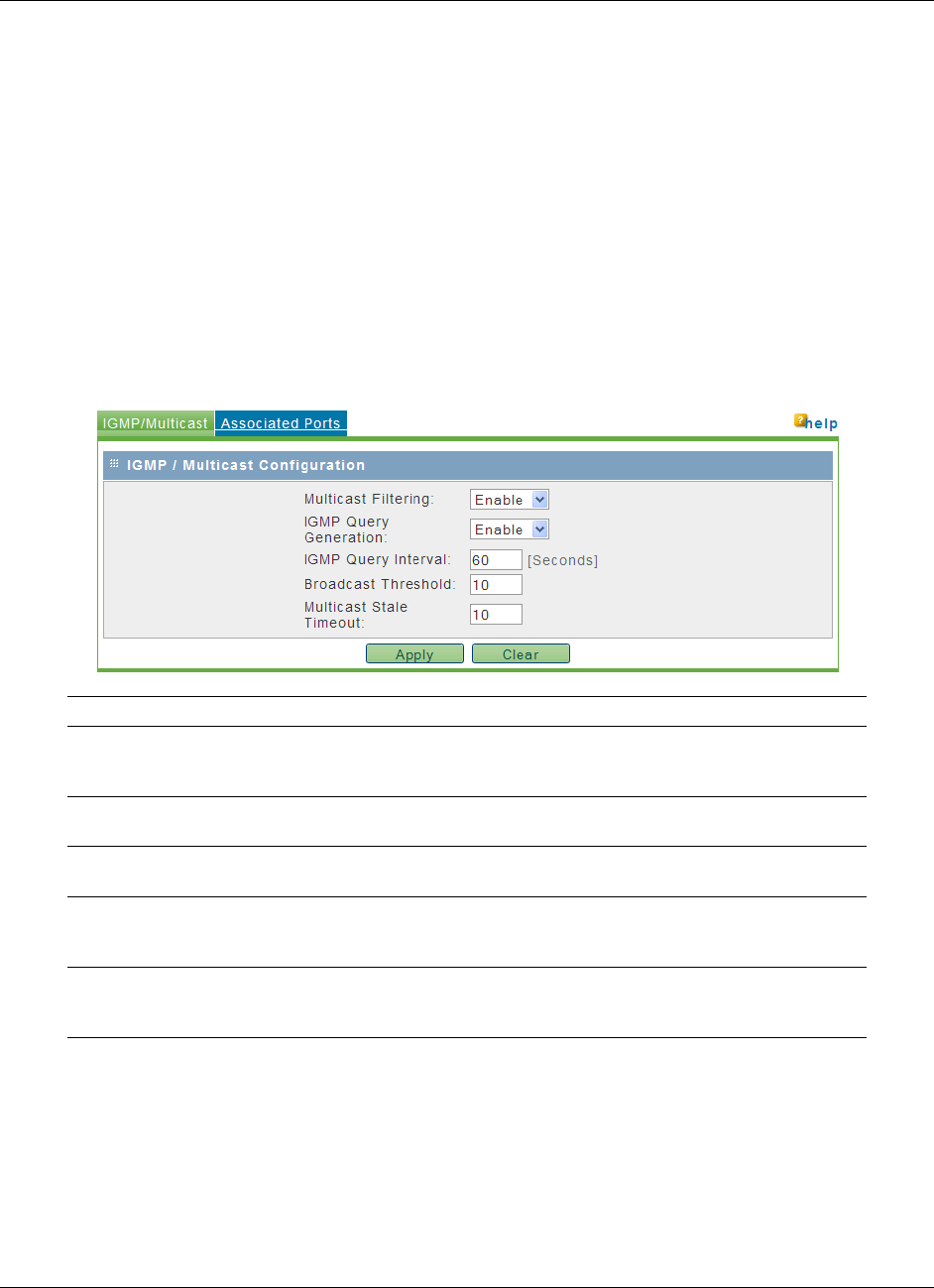
RadioLinx Configuration Manager RLXIB-IHN ♦ 802.11n
User Manual Industrial Hotspot
Page 78 of 171 ProSoft Technology, Inc.
May 23, 2011
4.2.9 IGMP / Multicast Configuration
The device can be configured to ensure multicast traffic is sent out as directed
packets over the 802.11 network.
RLXIB-IHN radios support IGMP v1 and v2. The default operation of the RLXIB-
IHN radios is to have IGMP functionality enabled. Use this page to specify
settings associated with IGMP filtering and snooping.
Unknown multicast addresses can be sent to all ports (flood) or to none (filtered)
by selecting the Multicast Filtering option. You can also specify whether the radio
will generate IGMP queries, and configure the query interval time.
By RFC specification, only one device on a network should generate IGMP
queries. As such, RLXIB-IHW radios will only send a query if another device has
not sent a query within its Query Interval setting, even if Query Generation is
enabled.
Parameter Description
Multicast Filtering Use the dropdown menu to enable or disable Multicast filtering support
on this device. Disabling filtering will cause the radio to flood multicast
packets to all ports.
IGMP Query Generation Use the dropdown menu to enable or disable IGMP query generation
from this device.
IGMP Query Interval Number of seconds between queries (if not pre-emptied by another
devices queries).
Broadcast Threshold This is the number of interested clients (default is 10) for a multicast
group beyond which multicast packets are sent as multiple (3)
broadcasts instead of individually directed packets.
Multicast Stale Timeout Number of queries generated before a device is removed from the
multicast group on this radio if no response is received (default 3). This
is applicable only to dynamically created multicast memberships.
Click Apply to save your changes.
Click Clear to discard your changes.
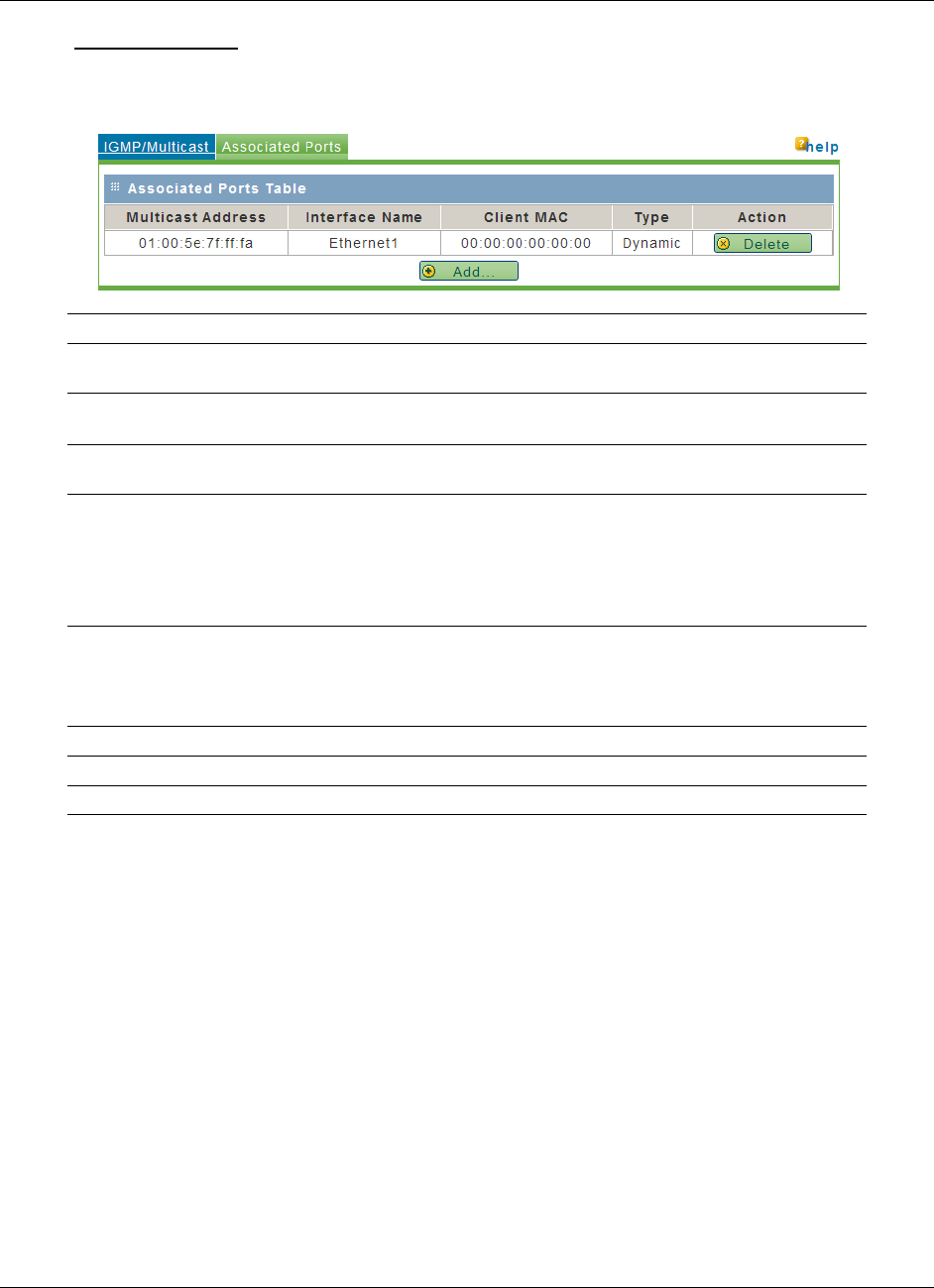
RLXIB-IHN ♦ 802.11n RadioLinx Configuration Manager
Industrial Hotspot User Manual
ProSoft Technology, Inc. Page 79 of 171
May 23, 2011
Associated Ports
The section lists the multicast memberships of all the known multicast addresses
of the device.
Parameter Description
Multicast Address Multicast MAC address of the group. For example 01:00:5e:XX:XX:XX
where XX:XX:XX represents the multicast group address.
Interface Name The interface for this port mapping is either Ethernet1 (the main port),
Parent 1 or AP 1.
Client MAC The MAC address of the client to which the directed multicast packets
have to be sent
Type The type of the Multicast group address. The two possible values are -
static, dynamic. A static entry is created by the administrator from the
Associated Ports page. A dynamic entry is created as a result of
snooping IGMP messages that are being forwarded by the device. This
is done only when multicast filtering is enabled from the IGMP/Multicast
page.
The actions that can be taken on Associated Ports table are:
Parameter Description
Delete Deletes the static multicast membership mapping.
Add This button will link to the Add Associated Port configuration page.
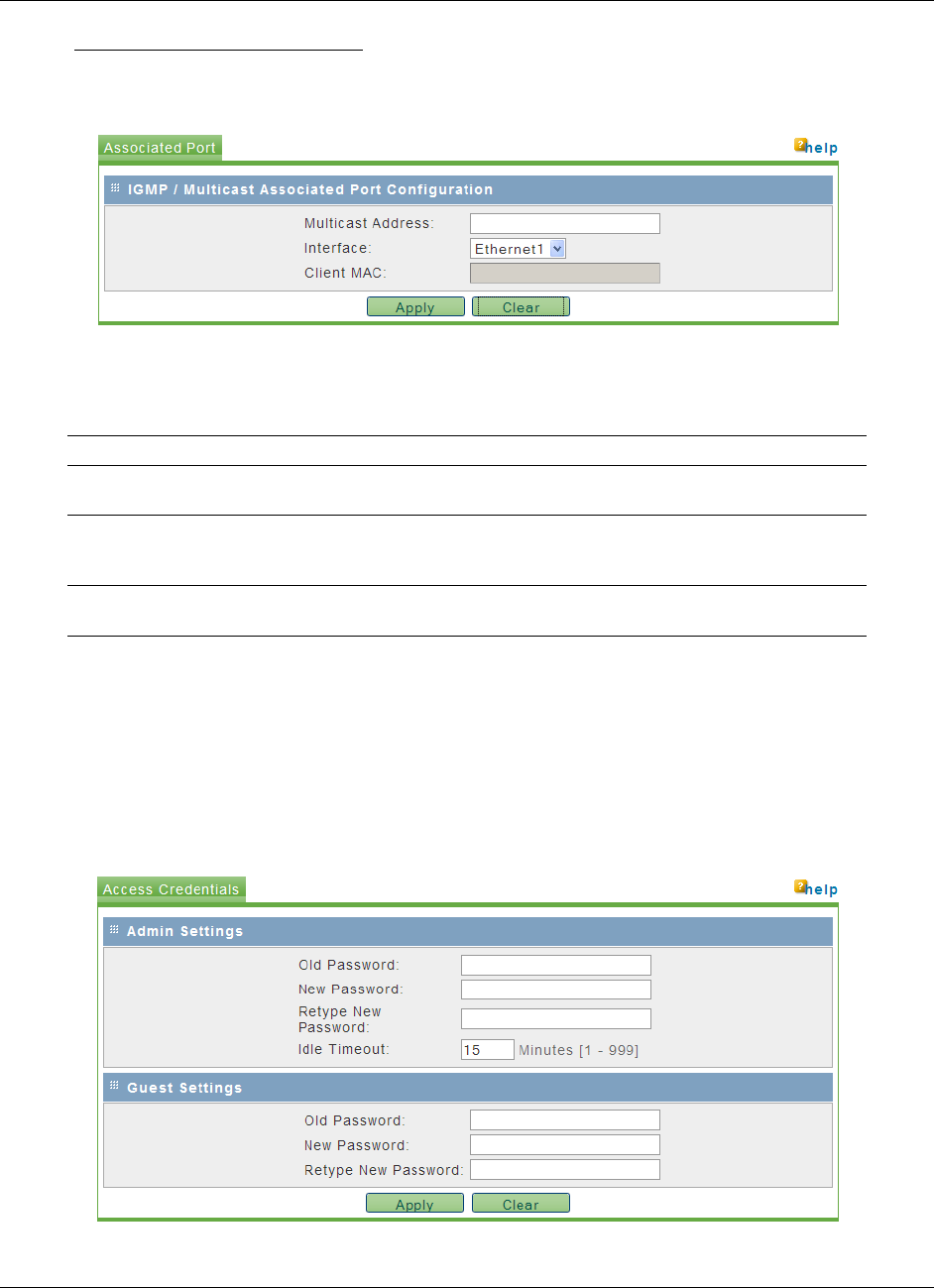
RadioLinx Configuration Manager RLXIB-IHN ♦ 802.11n
User Manual Industrial Hotspot
Page 80 of 171 ProSoft Technology, Inc.
May 23, 2011
Associated Port Configuration
This section allows the administrator to configure the static membership mapping
for a multicast address.
This mapping is used by the device to send directed multicast frames to the client
over the 802.11 link.
Parameter Description
Multicast Address Multicast MAC address of the group. For example 01:00:5e:XX:XX:XX
where XX:XX:XX represents the multicast group address.
Interface Name The interface for this port mapping is either the Ethernet interface,
Radio 1 or Radio 2. Some devices have two physical Ethernet ports, in
this case the Ethernet interface option covers traffic over both ports.
Client MAC The MAC address of the client to which the directed multicast packets
have to be sent
Click Apply to save your changes.
Click Clear to discard your changes.
4.2.10 Access Configuration
This section allows you to edit the configuration of an existing administrator or
guest user.
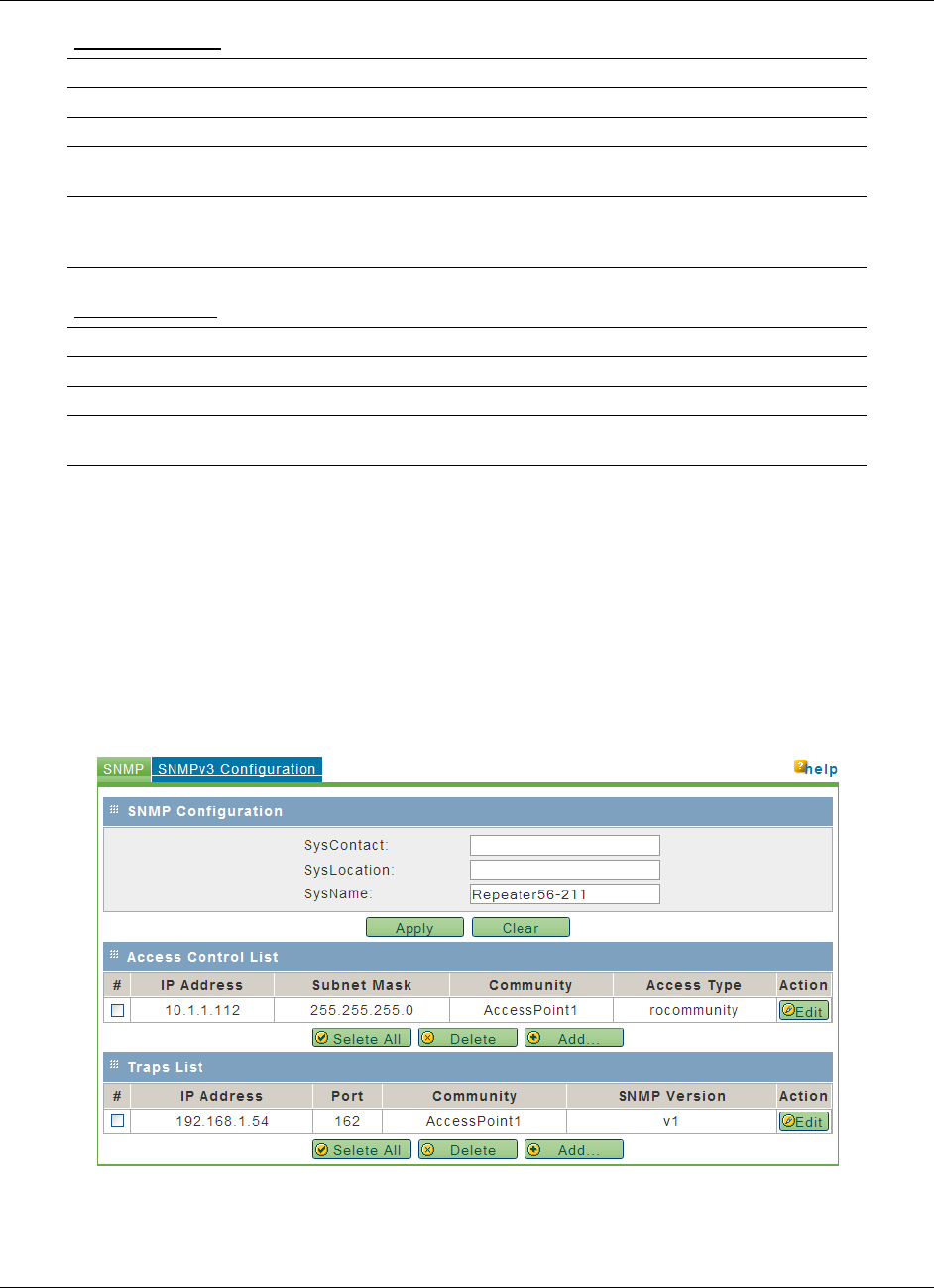
RLXIB-IHN ♦ 802.11n RadioLinx Configuration Manager
Industrial Hotspot User Manual
ProSoft Technology, Inc. Page 81 of 171
May 23, 2011
Admin Settings
Parameter Description
Old Password The current password is required to validate changes to the password
New Password The password may contain only alphanumeric, '-', or '_' characters.
Retype New Password The password entered in this field must match the one above for the
password to be set.
Idle Timeout This is the session timeout for the user. The default is 15 minutes of no
web activity and the timeout counter reset when the web GUI is being
navigated.
Guest Settings
Parameter Description
Old Password The current password is required to validate changes to the password
New Password The password may contain only alphanumeric, '-' or '_' characters.
Retype New Password The password entered in this field must match the one above for the
password to be set.
Click Apply to save your changes.
Click Clear to discard your changes.
4.2.11 SNMP Configuration
SNMP is a network management protocol that is often used with TCP/IP and
Ethernet. As an alternative to using the RadioLinx Configuration Manager, you
can change radio settings and view diagnostics in an SNMP manager
application, if necessary.
The RLXIB-IHN SNMP agent supports the SNMPv2c and SNMPv3 protocol
versions, and can send traps to a specified community.

RadioLinx Configuration Manager RLXIB-IHN ♦ 802.11n
User Manual Industrial Hotspot
Page 82 of 171 ProSoft Technology, Inc.
May 23, 2011
The MIB (Management Information Base) fields settings on this tab populate the
current SNMP system information of the RLXIB-IHN.
Parameter Description
SysContact The name of the contact person for this device.
Examples
admin, John Doe.
SysLocation The physical location of the device
Example
Rack #2, 4th Floor.
SysName A name given for easy identification of the device.
Click Apply to save your changes.
Click Clear to discard your changes.
Access Control List
The SNMP Access Control List is a table of access rules that enables read-only
or read-write access for select IP addresses in a defined SNMP agent's
community.
Parameter Description
IP Address The IP Address of the specific SNMP manager or trap agent on which
to create an access rule.
Subnet Mask The network mask used to determine the list of allowed SNMP
managers.
Community The community string to which the agent belongs to. Most agents are
configured to listen for traps in the Public community.
Access Type The SNMP manager or trap agent can either be allowed to read and
modify all SNMP accessible settings (rwcommunity) or be given read-
only access (rocommunity).
!(Edit) The Edit button will link to the SNMP Access Control Configuration
page, allowing you to make changes to the selected access control
rule.
The actions that can be taken on SNMP access control rules are:
Parameter Description
Select All Selects all SNMP access control rules in the table.
Delete Deletes the selected SNMP access control rule or rules.
Add Clicking this button will link to the SNMP Access Control Configuration
page.
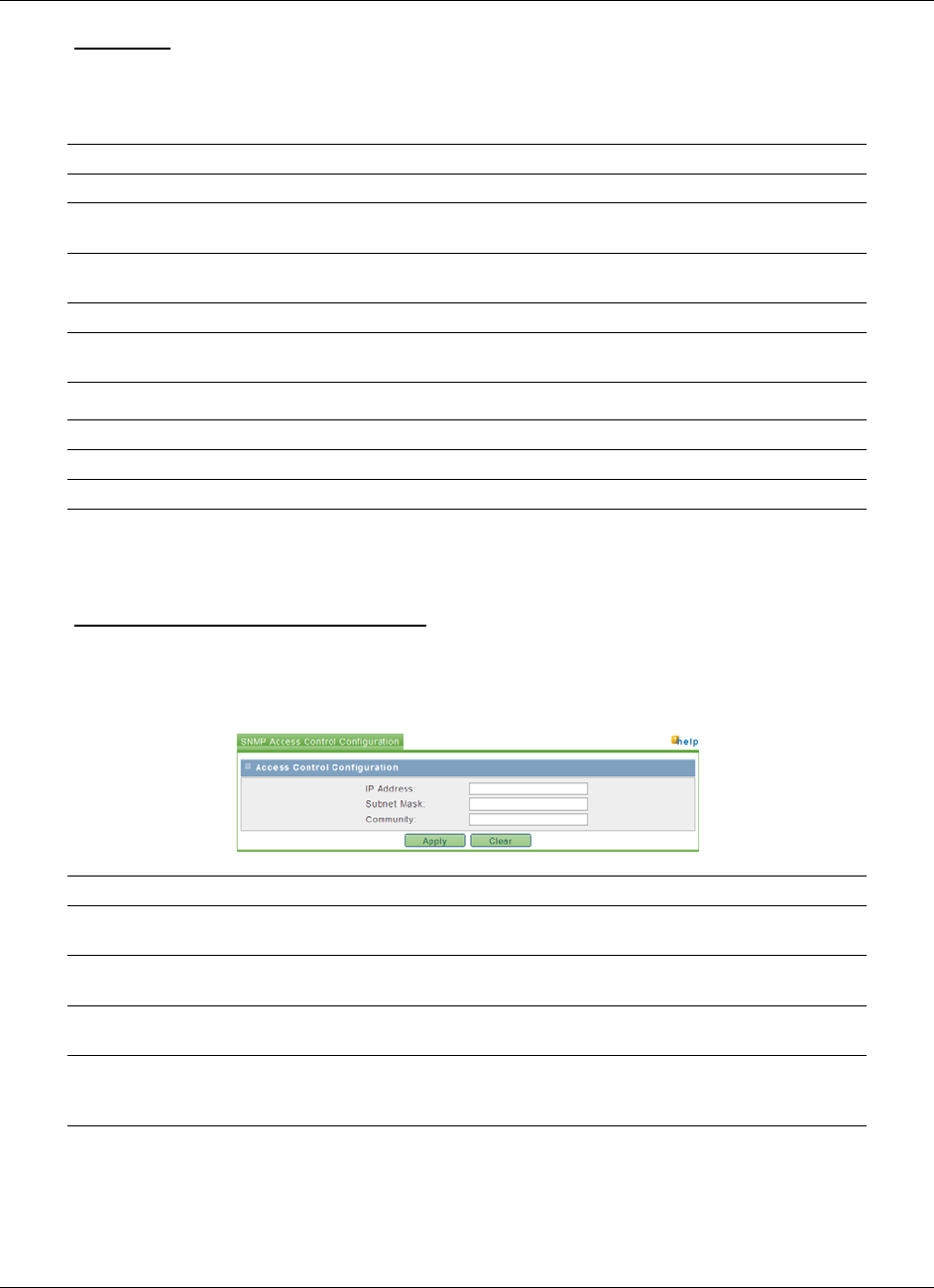
RLXIB-IHN ♦ 802.11n RadioLinx Configuration Manager
Industrial Hotspot User Manual
ProSoft Technology, Inc. Page 83 of 171
May 23, 2011
Traps List
This table lists IP addresses of SNMP agents to which the device will send trap
messages and allows several operations on the SNMP agents.
Parameter Description
IP Address The IP Address of the SNMP manager or trap agent.
Port The SNMP trap port of the IP address to which the trap messages will
be sent (typically UDP port 162).
Community The community string associated to the agent. Most agents are
configured to listen for traps in the Public community.
SNMP Version SNMP protocol version used by the defined trap agent.
Edit Opens the SNMP Trap Configuration page, allowing you to make
changes to the selected SNMP Agent.
The actions that can be taken on SNMP agents are:
Parameter Description
Select All Selects all the SNMP agents in the table.
Delete Deletes the selected SNMP agent or agents.
Add: Clicking this button will link to the SNMP Trap Configuration page.
SNMP Access Control Configuration
This configuration page allows you to add or modify an access control rule for a
given SNMP manager or trap agent as identified by its IP address and
community.
Parameter Description
IP Address The IP Address of the specific SNMP manager or trap agent on which
to create an access rule
Subnet Mask The network mask used to determine the list of allowed SNMP
managers.
Community The community string associated to the agent. Most agents are
configured to listen for traps in the Public community.
Access Type The SNMP manager or trap agent can either be allowed to read and
modify all SNMP accessible settings (rwcommunity) or be given read-
only access (rocommunity).
Click Apply to save your changes.
Click Clear to discard your changes.
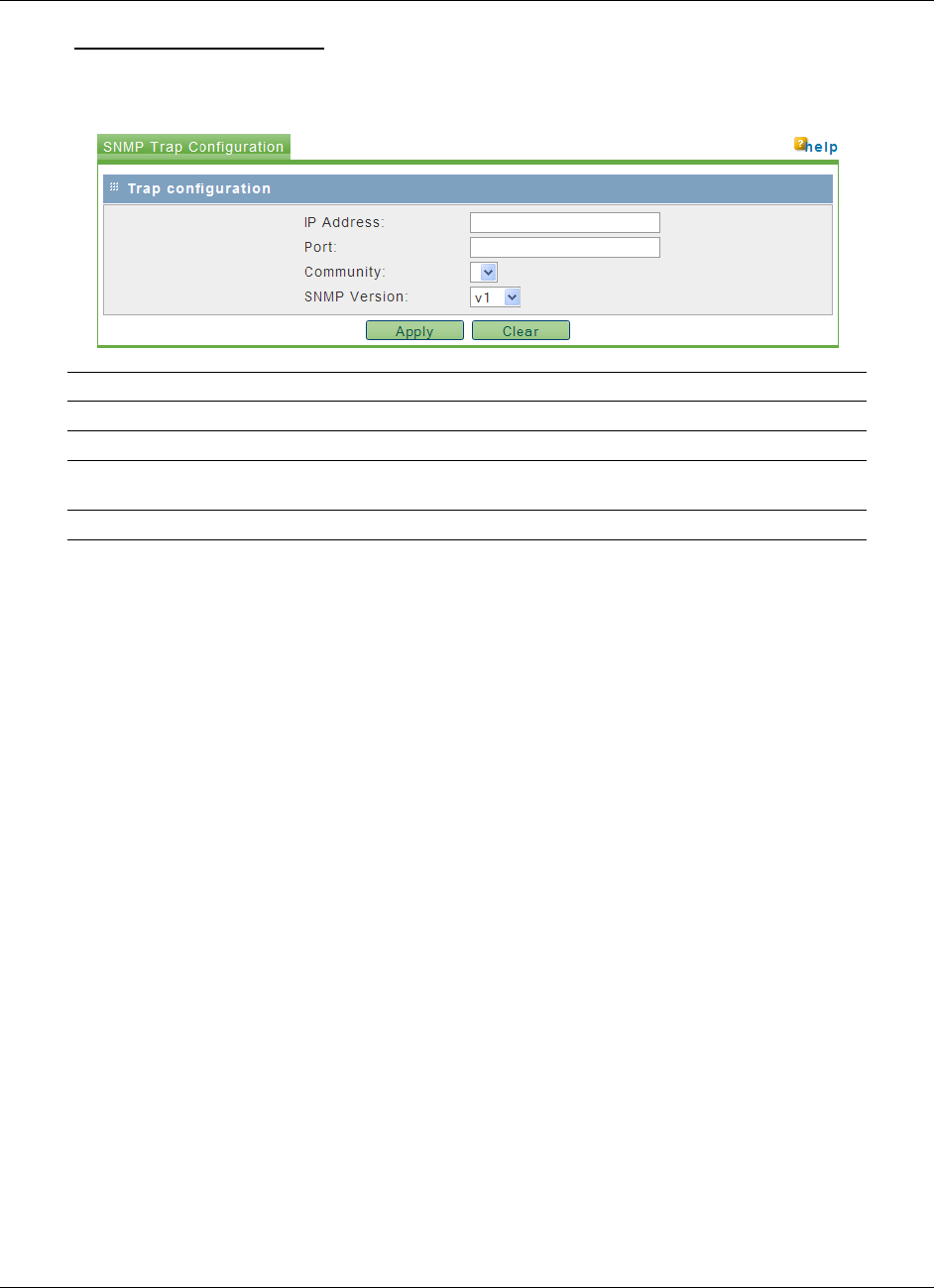
RadioLinx Configuration Manager RLXIB-IHN ♦ 802.11n
User Manual Industrial Hotspot
Page 84 of 171 ProSoft Technology, Inc.
May 23, 2011
SNMP Trap Configuration
This page allows you to add a new SNMP manager/trap agent or edit the
configuration of an existing SNMP manager/trap agent.
Parameter Description
IP Address The IP address of the SNMP agent.
Port The SNMP trap port to which the trap messages will be sent.
Community The community string associated to the agent. Most agents are
configured to listen for traps in the public community.
SNMP Version This device supports SNMP protocols v1, v2c and v3.
Click Apply to save your changes.
Click Clear to discard your changes.
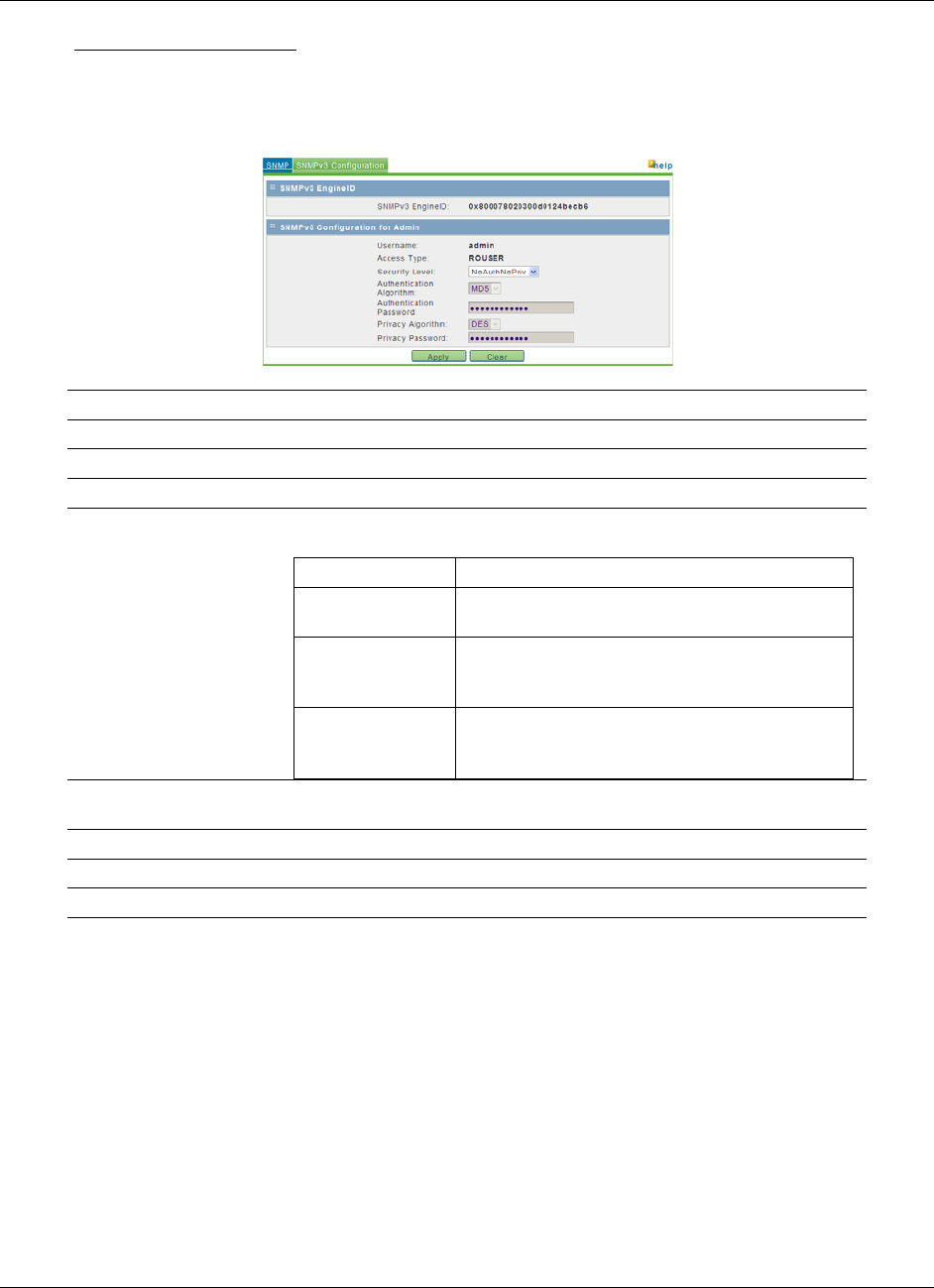
RLXIB-IHN ♦ 802.11n RadioLinx Configuration Manager
Industrial Hotspot User Manual
ProSoft Technology, Inc. Page 85 of 171
May 23, 2011
SNMPv3 Configuration
SNMPv3 adds extra security and remote configuration enhancements to SNMP.
To use an SNMP v3 agent with the RLXIB-IHN, configure the options on this
page.
Parameter Description
SNMPv3 EngineID This is the SNMPv3 identifier common to all ProSoft RLXIB-IHN radios.
Username The SNMPv3 administrator level user has username admin.
Access Type The access privilege assigned to the admin is read-only (ROUSER).
Security Level The authentication and encryption requirements for this user are
defined here.
Parameter Description
NoAuthNoPriv This allows the user to login without
authentication or encryption.
AuthNoPriv This requires only authentication for the user to
login. If selected, the Authentication Algorithm
and Password fields below must be set.
AuthPriv This requires both authentication and encryption
for access. If selected, the authentication and
privacy fields below must be set.
Authentication Algorithm Choose an authentication algorithm from the drop down list - MD5 and
SHA
Authentication Password The authentication password for the user.
Privacy Algorithm Choose a privacy algorithm from the drop down list - DES or AES
Privacy Password The privacy password for the user.
Click Apply to save your changes.
Click Clear to discard your changes.
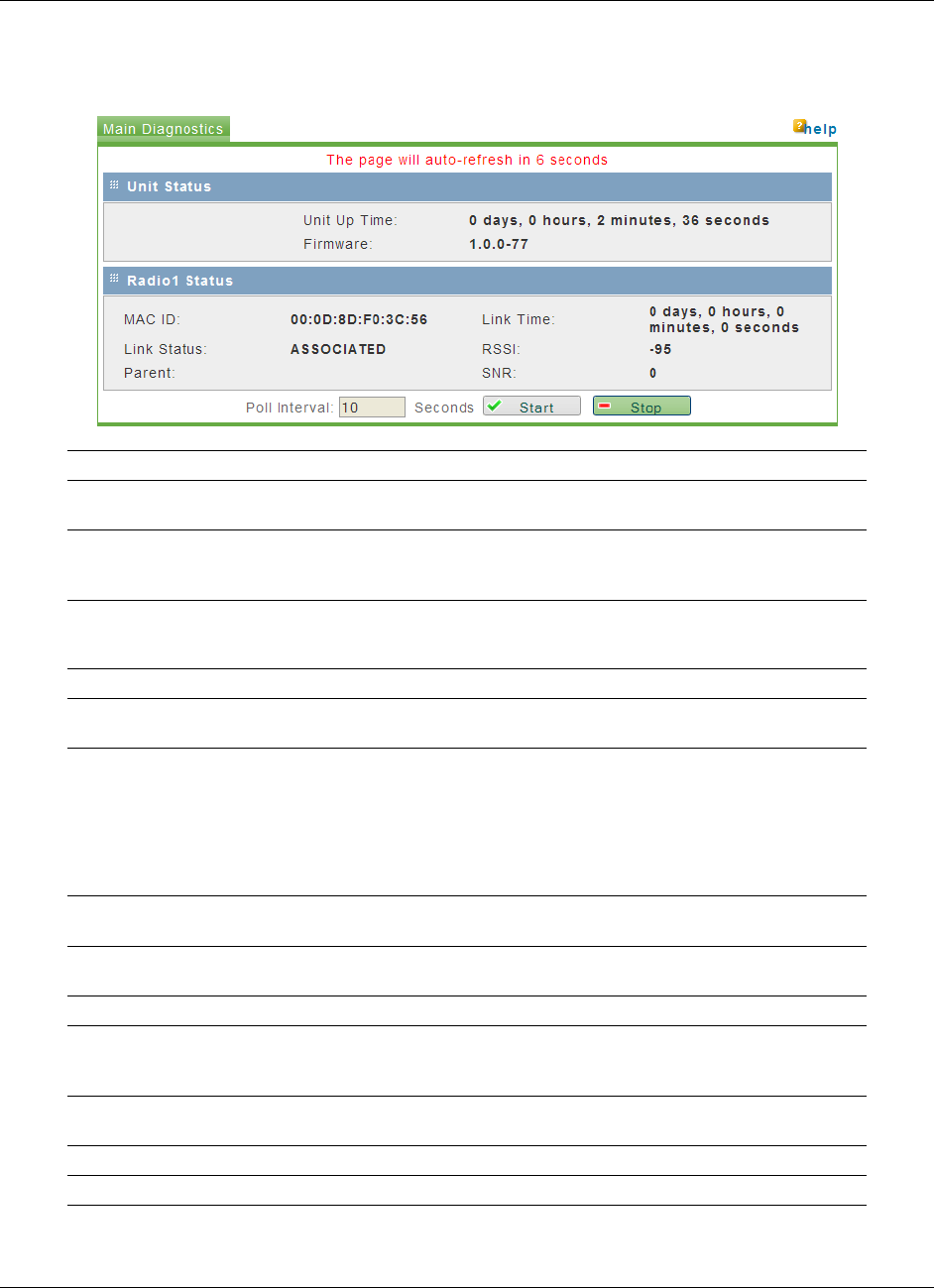
RadioLinx Configuration Manager RLXIB-IHN ♦ 802.11n
User Manual Industrial Hotspot
Page 86 of 171 ProSoft Technology, Inc.
May 23, 2011
4.3 Diagnostics
The Main Diagnostics tab shows basic information about the radio.
Parameter Description
Unit Up Time The length of time the radio has operated since the last system power-
up or last system reset.
Firmware The version of firmware currently installed. All radios on the network
must have the same firmware versions installed. For more information
on firmware versions, refer to Upload Code (page 101).
4.3.1 Radio Status
Parameter Description
MAC ID The MAC address of the selected radio. The MAC ID is also printed on
the side of the radio.
Link Status Master: The radio is configured as a Master.
Connected: The radio is currently connected to a Parent
Associated: The radio is associated with a Parent, but is not
currently connected
Connecting: The radio is attempting to connect to a Parent
Disconnected: The radio is unable to connect to a Parent
Parent The MAC address of the parent radio to which the selected radio is
linked.
Link Time The length of time the radio has been continuously connected to a
parent radio.
RSSI Strength of the signal from the Parent radio, in dBm.
SNR The signal-to-noise ratio is displayed here in dB. Refer to
Understanding Signal to Noise Ratio (page 47) for more information on
how to interpret this value.
Poll Interval Enter the interval in seconds to refresh the status information on this
page.
Start Click to start refreshing the page.
Stop Click to stop refreshing the page.
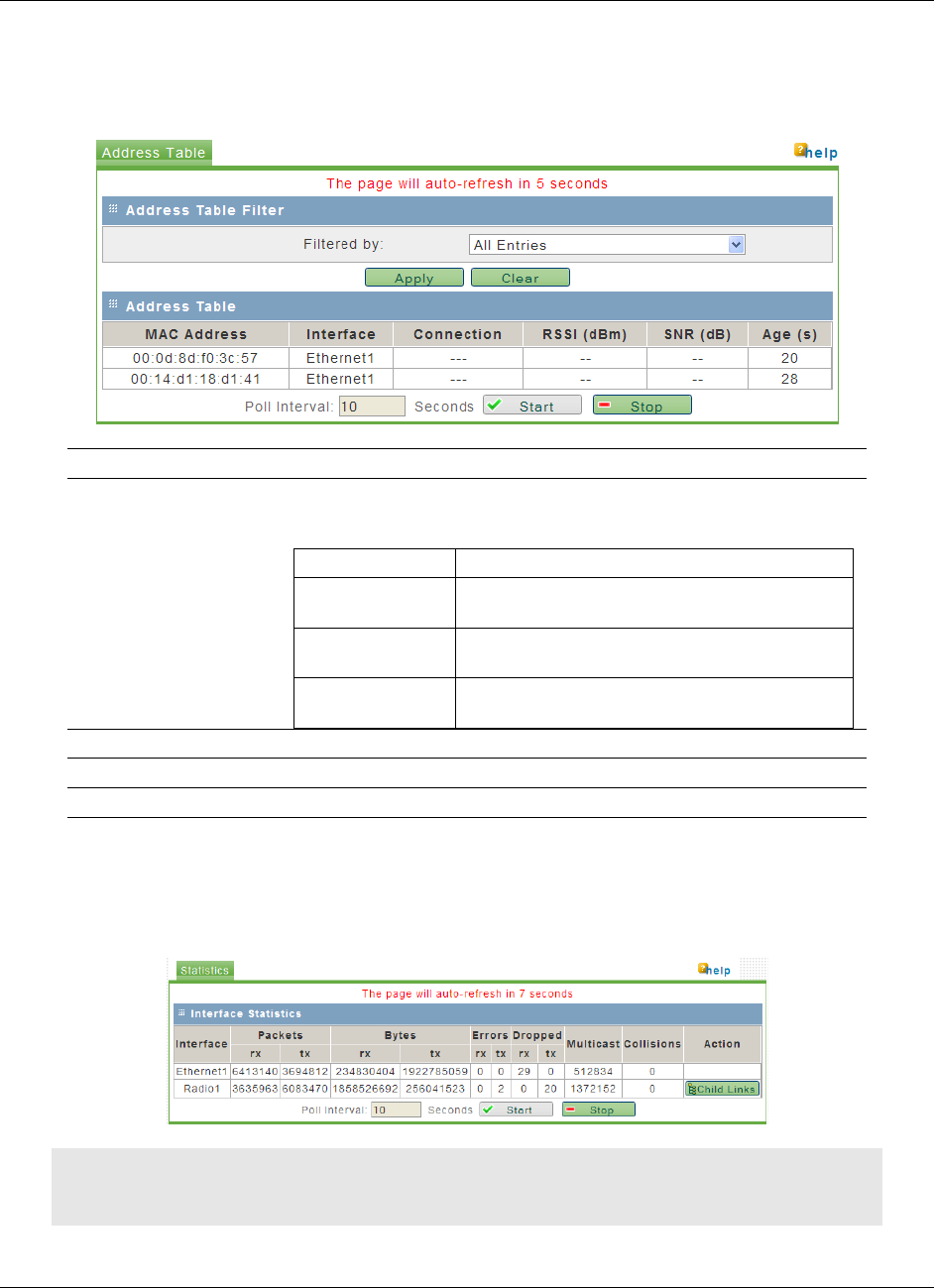
RLXIB-IHN ♦ 802.11n RadioLinx Configuration Manager
Industrial Hotspot User Manual
ProSoft Technology, Inc. Page 87 of 171
May 23, 2011
4.3.2 Address Table
The address table displays a list of all connected nodes in the network (more
specifically, the trunk/management network that is not VLAN aware).
Parameter Description
Filter by By default, the list shows all nodes that are detected by this device as
being part of the 802.11 network. You can filter the list with the following
options
Parameter Description
Radios Directly
Linked
Shows only nodes that have a direct parent/child
connection to this device.
Devices out
Ethernet Port
Shows nodes that are connected via Ethernet to
this device
Devices available
over Radio Links
Shows nodes that have a 802.11 link to this
device
Poll Interval Enter the interval in seconds to refresh the information on this page.
Start Click to start refreshing the page.
Stop Click to stop refreshing the page.
4.3.3 Statistics
The Statistics tab shows traffic data for the radio and Ethernet ports on the
RLXIB-IHN.
Note: Each Radio's configuration is unique. If the hardware supports more than one physical radio,
and more than one Ethernet port, the traffic statistics are cumulative for each pair.
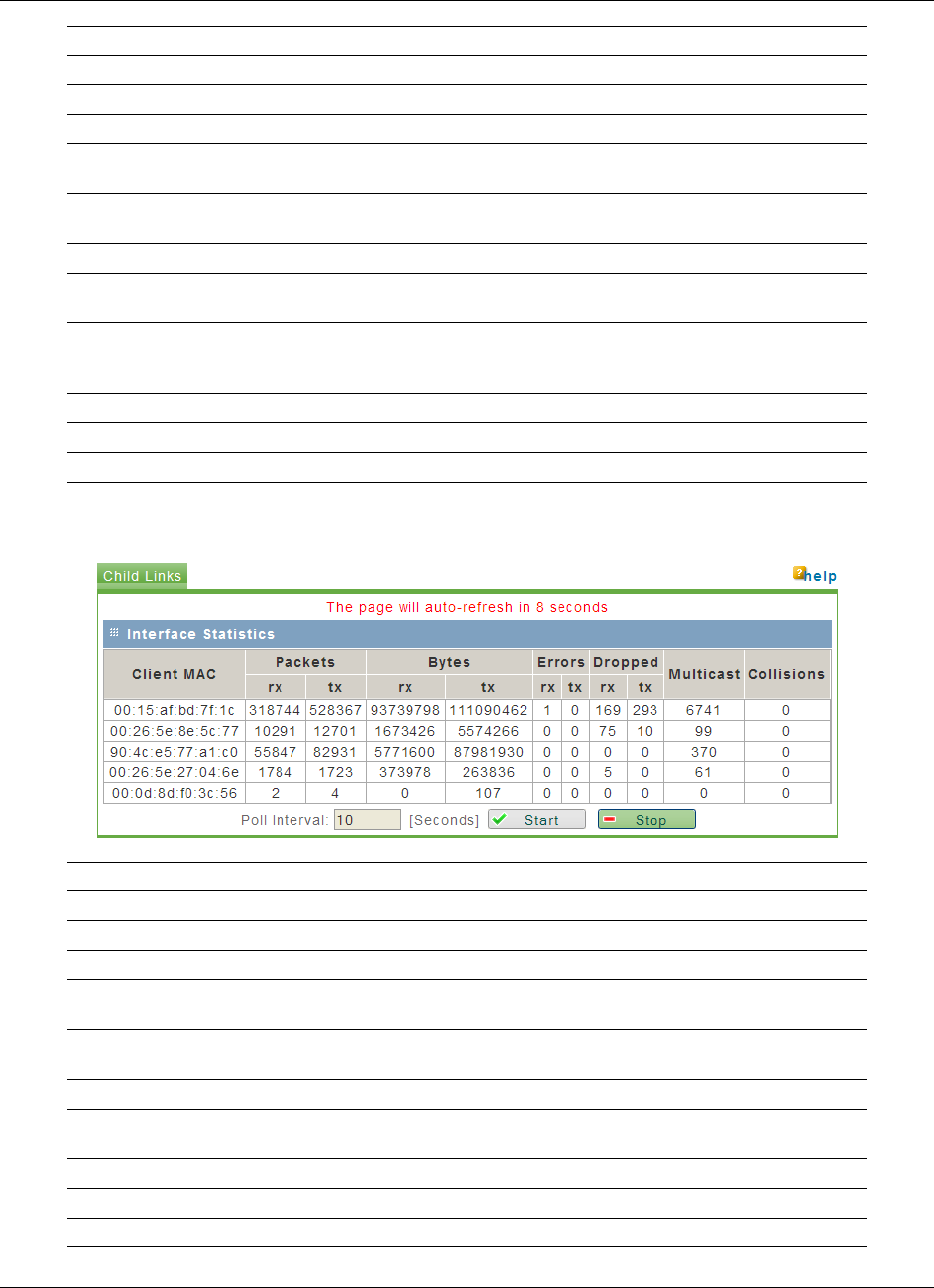
RadioLinx Configuration Manager RLXIB-IHN ♦ 802.11n
User Manual Industrial Hotspot
Page 88 of 171 ProSoft Technology, Inc.
May 23, 2011
Parameter Description
Interface The interface statistics for each physical Ethernet and Radio interface
Packets The number of transmitted/received (tx/rx) wireless packets
Bytes The number of transmitted/received (tx/rx) bytes of data
Errors The number of transmitted/received (tx/rx) packet errors reported to the
device, over all configured APs
Dropped The number of transmitted/received (tx/rx) packets dropped by the
device, over all configured APs
Multicast The number of multicast packets sent over this device
Collisions The number of packet collisions reported to the device, over all
configured APs
Child Links Click to open the interface statistics page for the child links (page 88).
The Child Links page shows traffic statistics for all downstream
children. listed by MAC address.
Poll Interval Enter the interval in seconds to refresh the information on this page.
Start Click to start refreshing the page.
Stop Click to stop refreshing the page.
4.3.4 Child Links
Parameter Description
Client MAC The MAC Address of each client detected by the RLXIB-IHN
Packets The number of transmitted/received (tx/rx) wireless packets
Bytes The number of transmitted/received (tx/rx) bytes of information
Errors The number of transmitted/received (tx/rx) packet errors reported to the
device, over all configured APs
Dropped The number of transmitted/received (tx/rx) packets dropped by the
device, over all configured APs
Multicast The number of multicast packets sent over this device
Collisions The number of packet collisions reported to the device, over all
configured APs
Poll Interval Enter the interval in seconds to refresh the information on this page.
Start Click to start refreshing the page.
Stop Click to stop refreshing the page.
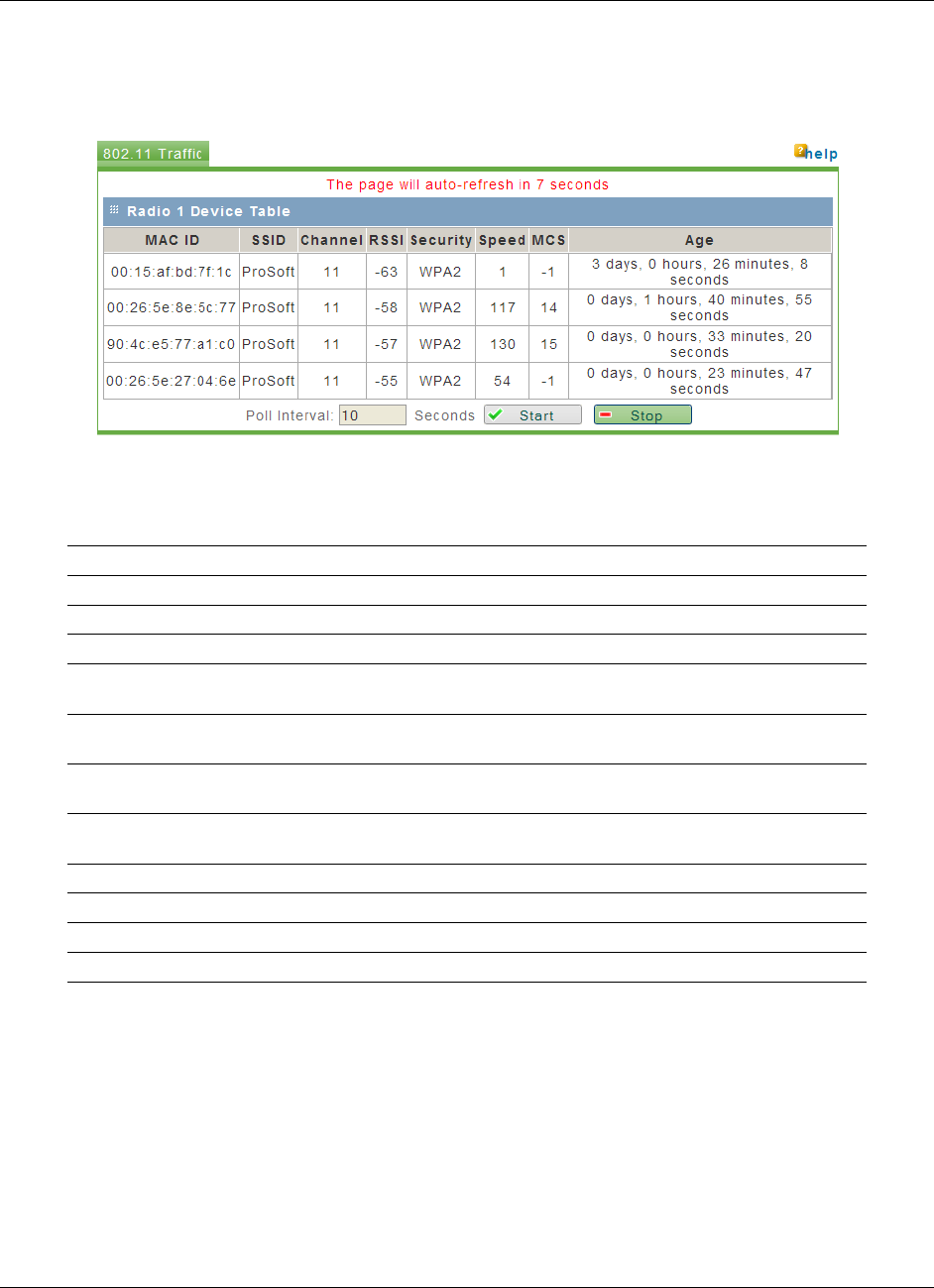
RLXIB-IHN ♦ 802.11n RadioLinx Configuration Manager
Industrial Hotspot User Manual
ProSoft Technology, Inc. Page 89 of 171
May 23, 2011
4.3.5 802.11 Traffic
The 802.11 Traffic tab contains a list of 802.11 devices detected by the radio.
This list is updated at intervals specified in the Poll Interval field.
Depending on the radio's Radio's configuration, this list may include 802.11
devices that are members of other SSIDs.
Parameter Description
MAC ID The detected node's MAC address.
SSID The detected node's SSID if available.
Channel The broadcast channel used by the detected node.
RSSI The received signal strength indicator (in dBm) between detected node
and this device
Security The security settings, if any, in place for connections to the detected
node.
Speed (Data Rate) This is the maximum possible data rate (in Mbps) of a connection to the
detected node.
MCS If the radio is using 802.11n rates, the associated MCS value between
0 and 15 will be displayed.
Age This is the time since detected node was most recently heard.
Poll Interval Enter the interval in seconds to refresh the information on this page.
Start Click to start refreshing the page.
Stop Click to stop refreshing the page.
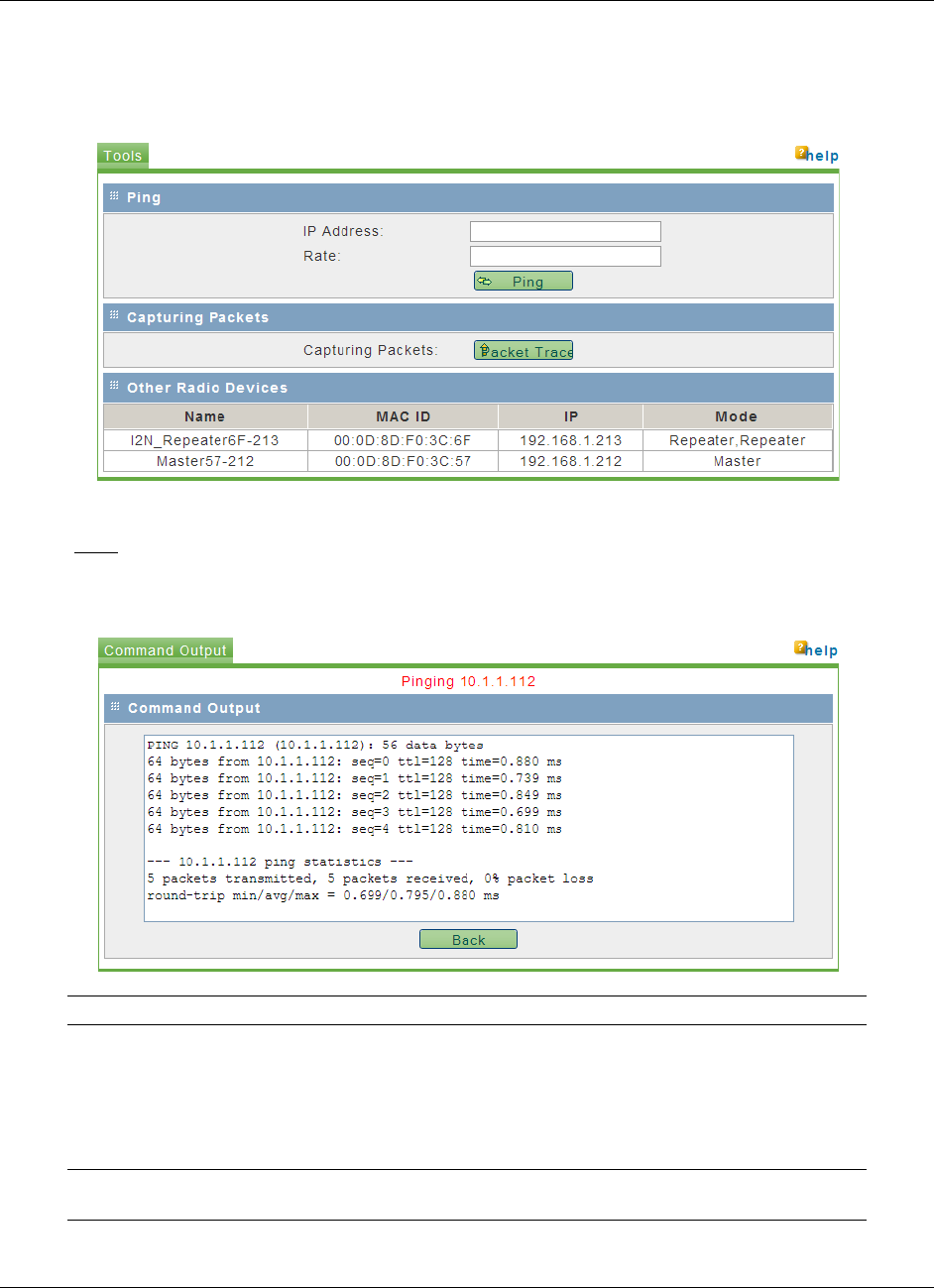
RadioLinx Configuration Manager RLXIB-IHN ♦ 802.11n
User Manual Industrial Hotspot
Page 90 of 171 ProSoft Technology, Inc.
May 23, 2011
4.3.6 Tools
The Tools tab allows you to perform tasks for investigating network issues or
validating connectivity between nodes.
Ping
You can use the radio to ping other IP addresses on the network to test
connectivity between this radio and the network.
Parameter Description
IP Address The IP address where an ICMP echo request packet will be sent.
If the destination IP address is active, it will respond to the ping
command text similar to "64 bytes from
IP_Address:icmp……".
A "response timed out" message indicates that the
destination is either not active or is blocking ping requests.
Rate This setting defines the number of seconds to wait between sending
ICPM echo request packets to the configured IP address.
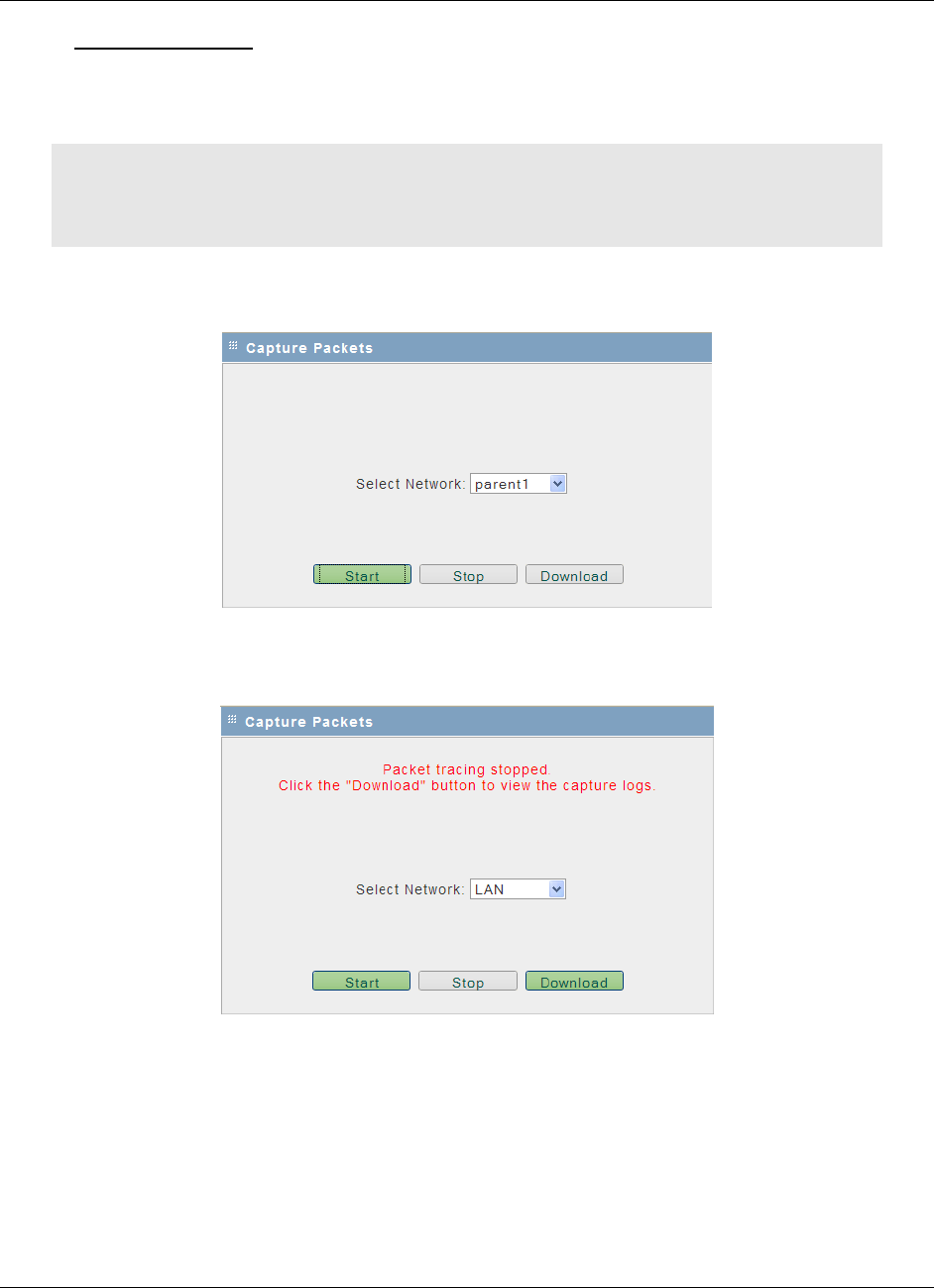
RLXIB-IHN ♦ 802.11n RadioLinx Configuration Manager
Industrial Hotspot User Manual
ProSoft Technology, Inc. Page 91 of 171
May 23, 2011
Capturing Packets
This utility allows you to capture all packets that pass through the selected
interface (Ethernet, Radio 1, or Radio 2).
Note: A detailed discussion of network packet analysis is outside the scope of this manual. Refer
to the documentation for your network protocol analyzer for more information on interpreting packet
captures.
To capture packets, click the PACKET TRACE button.
Select the interface from the dropdown list, and then click START. To stop the
packet capture click STOP.
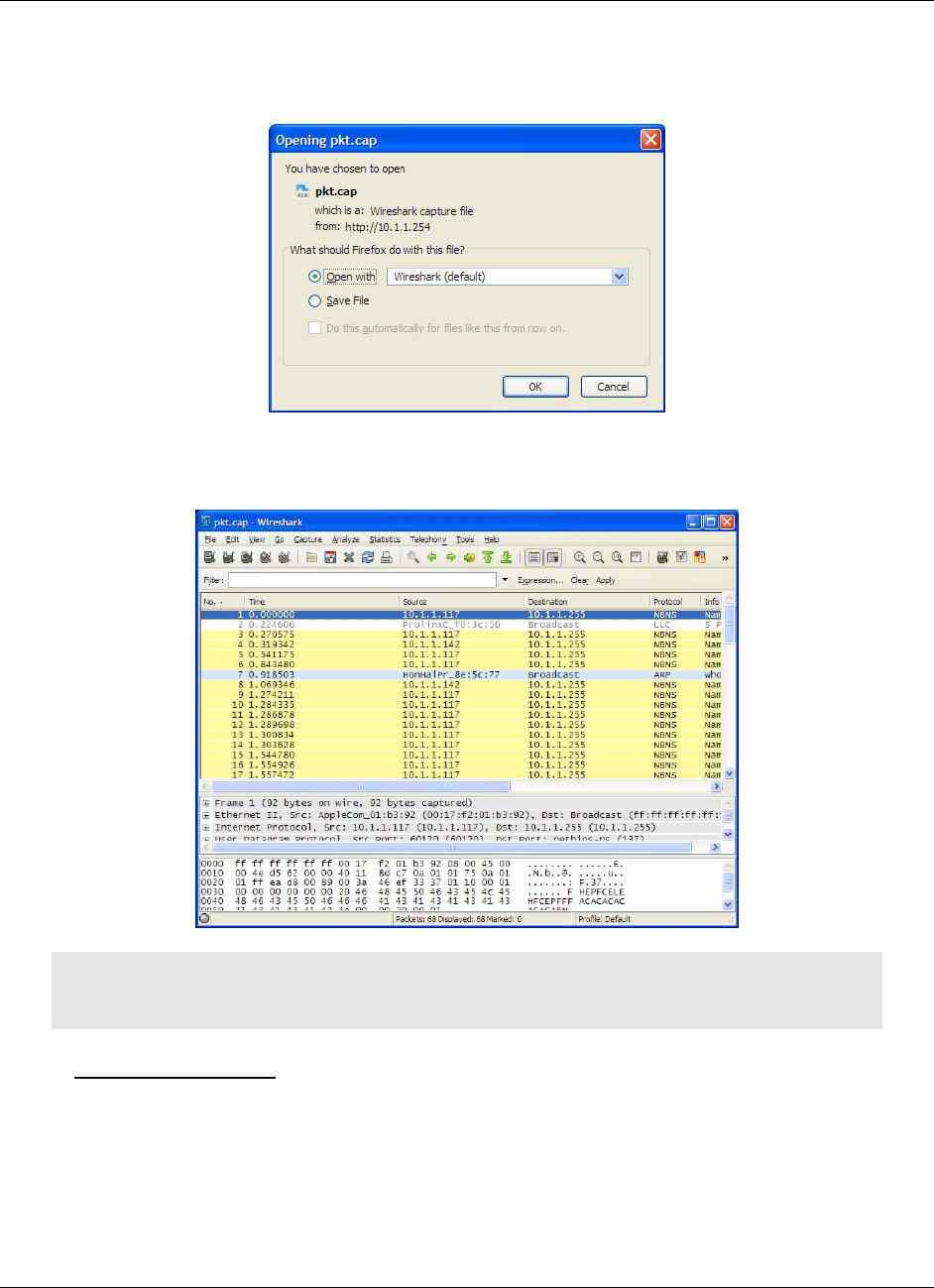
RadioLinx Configuration Manager RLXIB-IHN ♦ 802.11n
User Manual Industrial Hotspot
Page 92 of 171 ProSoft Technology, Inc.
May 23, 2011
To view the contents of the captured packets, you must download the capture
file, and open it in a network protocol analyzer. Click DOWNLOAD to retrieve and
open the capture file.
The following illustration shows the results of the capture in a in a network
protocol analyzer tool.
Note: The packet trace is limited to 1MB of data per capture session. When the capture file size
exceeds 1MB, it will be deleted automatically and a new capture file will be created.
Other Radio Devices
Radio traffic detected on the same 802.11 channel in use by the APs on this
device will be displayed here for reference. The MAC ID, IP address, device
mode (if a RLXIB-IHN radio) and device name will be displayed if detected. The
information on this page is for reference only, and cannot be modified.
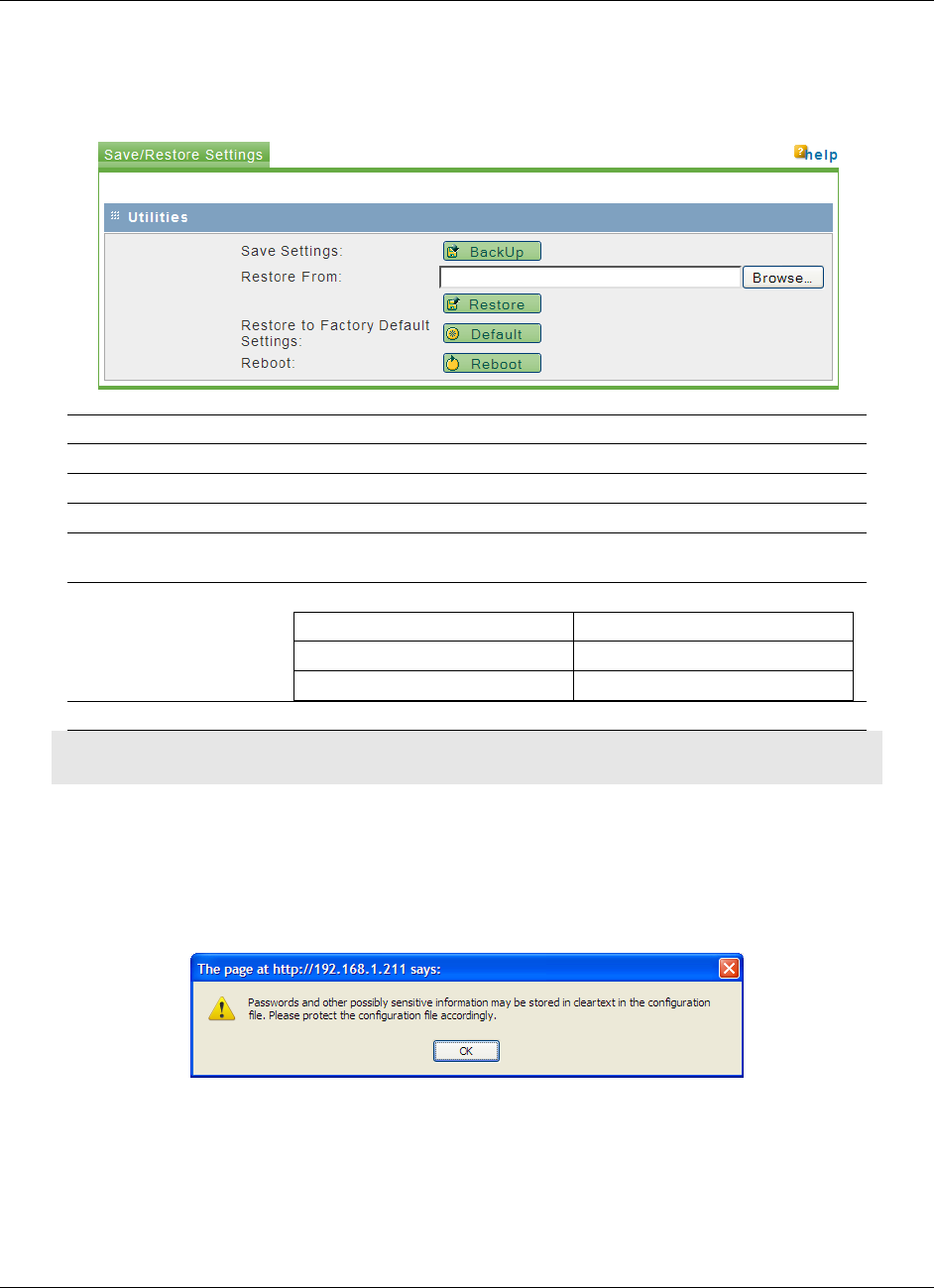
RLXIB-IHN ♦ 802.11n RadioLinx Configuration Manager
Industrial Hotspot User Manual
ProSoft Technology, Inc. Page 93 of 171
May 23, 2011
4.4 Utilities
The Utilities tab allows you to save and restore the the radio's settings, and
reboot (restart) the radio.
Parameter Description
Save Settings Saves the radio configuration to a backup file on your computer
Restore From The path and filename for the file to restore
Browse Opens a File Upload dialog box to locate and select the file to restore
Restore Restores the radio configuration from a saved backup file uploaded
from your computer.
Default Restores the radio to Factory Default Settings.
User Name admin
Password password
LAN Port IP address 192.168.1.1
Reboot Reboots (restarts) the radio.
Note: Network operation will be interrupted while the radio reboots.
4.4.1 Saving and Restoring Settings
1 To save a backup of the current settings, click Backup. This action creates a
file in the format <radio name>.CFG, and saves the file to your computer.
2 Read and acknowledge the information window.
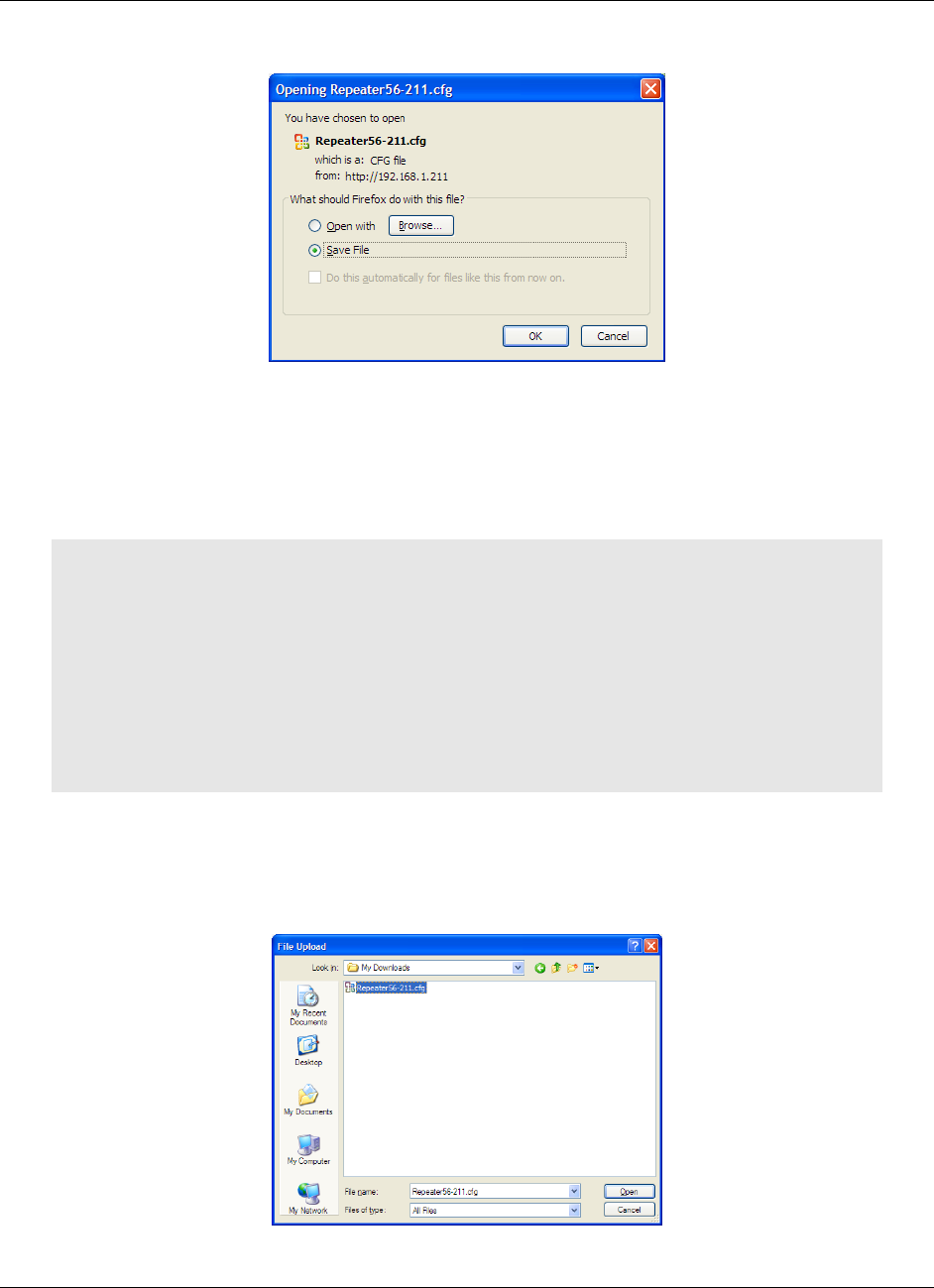
RadioLinx Configuration Manager RLXIB-IHN ♦ 802.11n
User Manual Industrial Hotspot
Page 94 of 171 ProSoft Technology, Inc.
May 23, 2011
3 Choose Save File when prompted.
4 The backup file will be stored in your web browser's default download folder,
for example, "My Downloads" or the Windows Desktop.
Restoring a backup file
Important! If you restore a saved configuration, or reset the radio to its default
configuration, your current settings will be deleted permanently. Always create a backup of
the radio's current settings before restoring or resetting the configuration. Settings cannot
be retrieved unless they have been backed up.
When the the restore operation is in progress:
Do NOT close the browser window.
Do NOT go online.
Do NOT turn off or power-cycle the device.
Do NOT shutdown the computer.
1 To restore a backup of the radio's settings, click BROWSE.
2 In the File Upload dialog box, locate the stored backup file, and then click
OPEN.
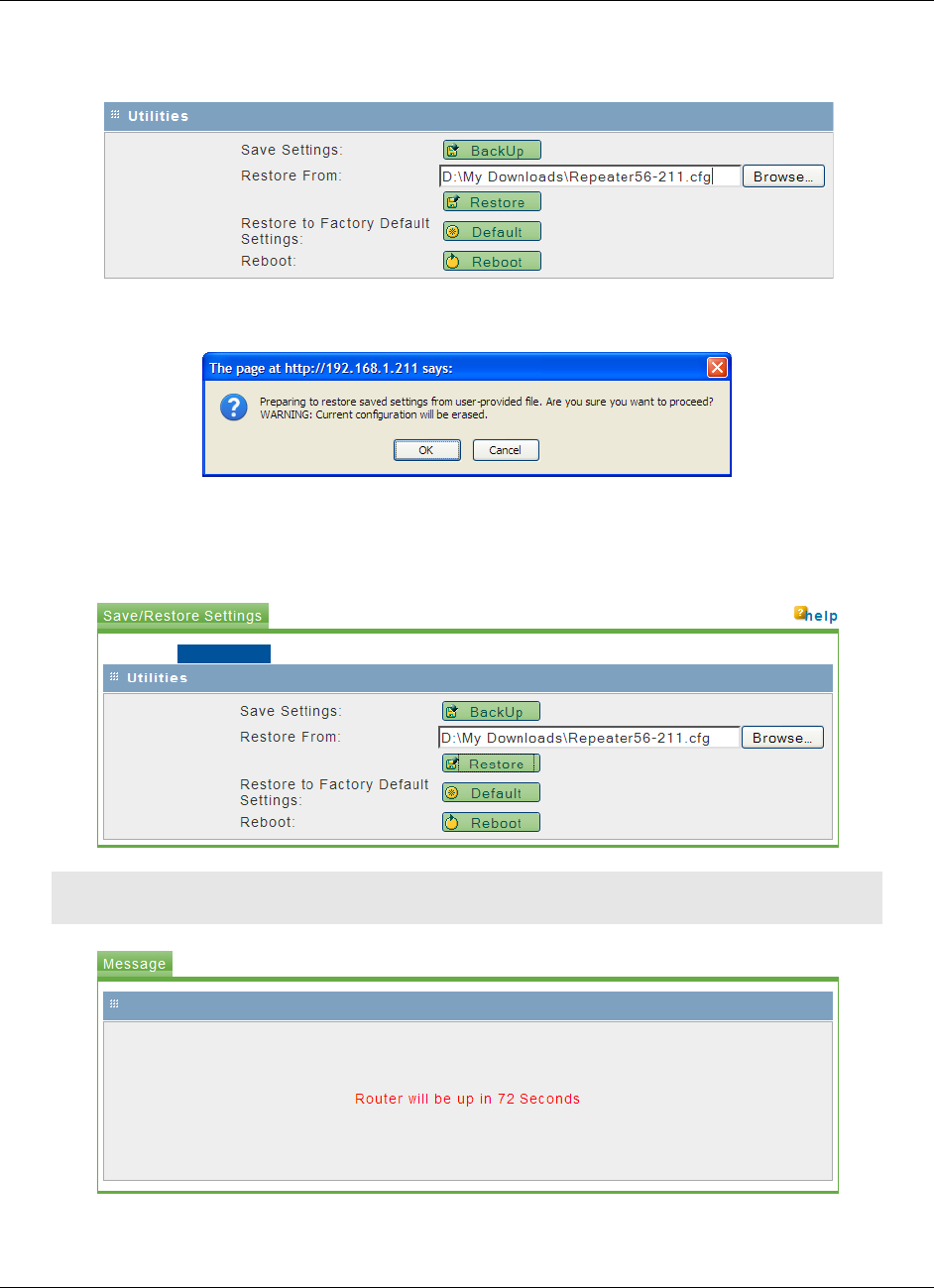
RLXIB-IHN ♦ 802.11n RadioLinx Configuration Manager
Industrial Hotspot User Manual
ProSoft Technology, Inc. Page 95 of 171
May 23, 2011
This action populates the RESTORE FROM field with the file name and location
of the backup file.
3 Click RESTORE, and acknowledge the information window.
The progress bar on the Save/Restore tab indicates that the backup file is
being transferred to the radio. When the file transfer is complete, the radio will
reboot automatically to reload the restored configuration.
Note: Network operation will be interrupted while the radio reboots.
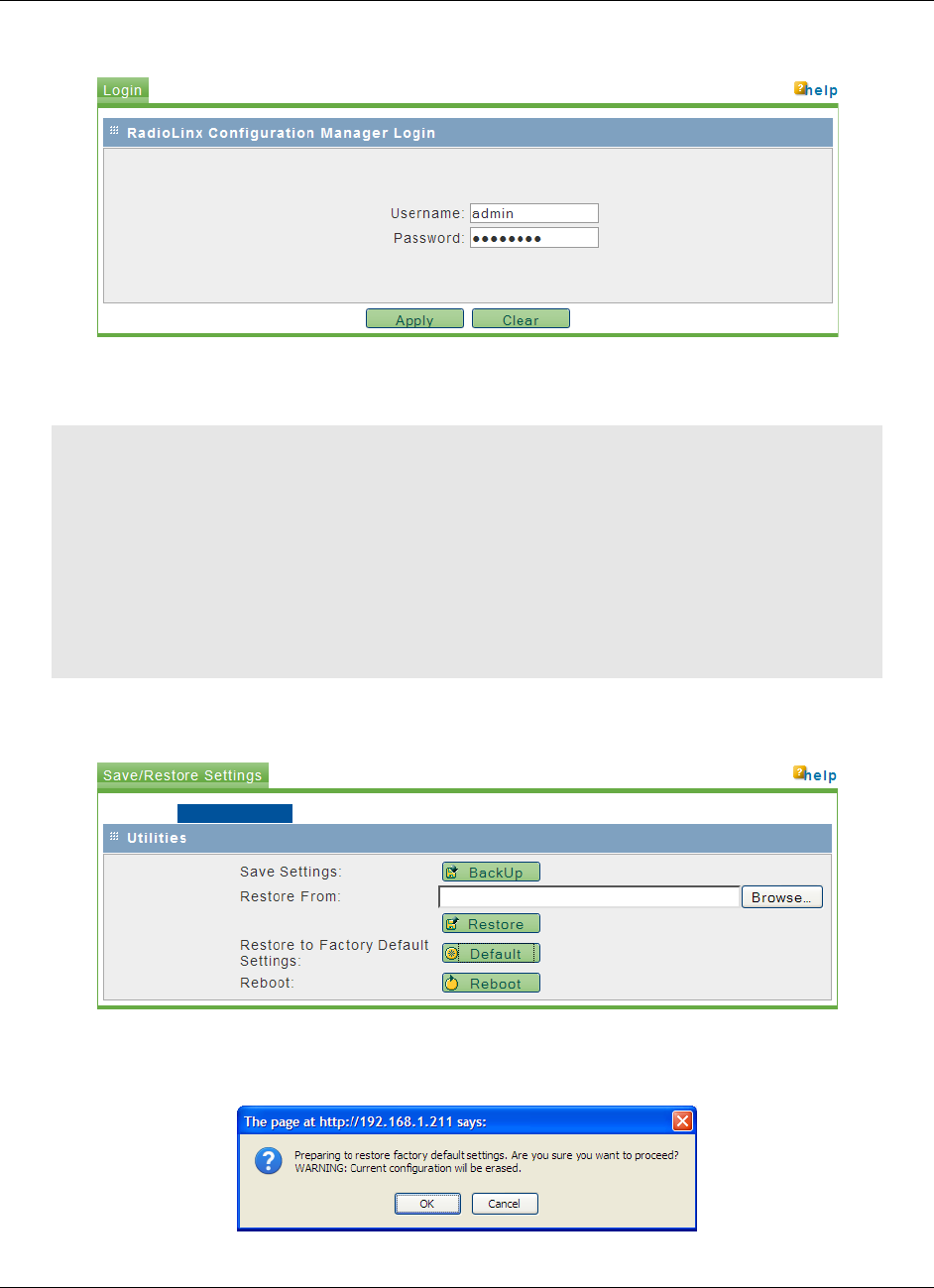
RadioLinx Configuration Manager RLXIB-IHN ♦ 802.11n
User Manual Industrial Hotspot
Page 96 of 171 ProSoft Technology, Inc.
May 23, 2011
4 When the radio finishes rebooting, log in with your username and password.
4.4.2 Factory Reset
Important! If you restore a saved configuration, or reset the radio to its default
configuration, your current settings will be deleted permanently. Always create a backup of
the radio's current settings before restoring or resetting the configuration. Settings cannot
be retrieved unless they have been backed up.
Caution: When the the factory reset operation is in progress:
Do NOT close the browser window.
Do NOT go online.
Do NOT turn off or power-cycle the device.
Do NOT shutdown the computer.
1 To restore the RLXIB-IHN to the factory default settings, save a backup copy
of your settings first (page 93), and then click RESTORE.
2 Read and acknowledge the information window, and then click OK to restore
the RLXIB-IHN to its factory default settings.
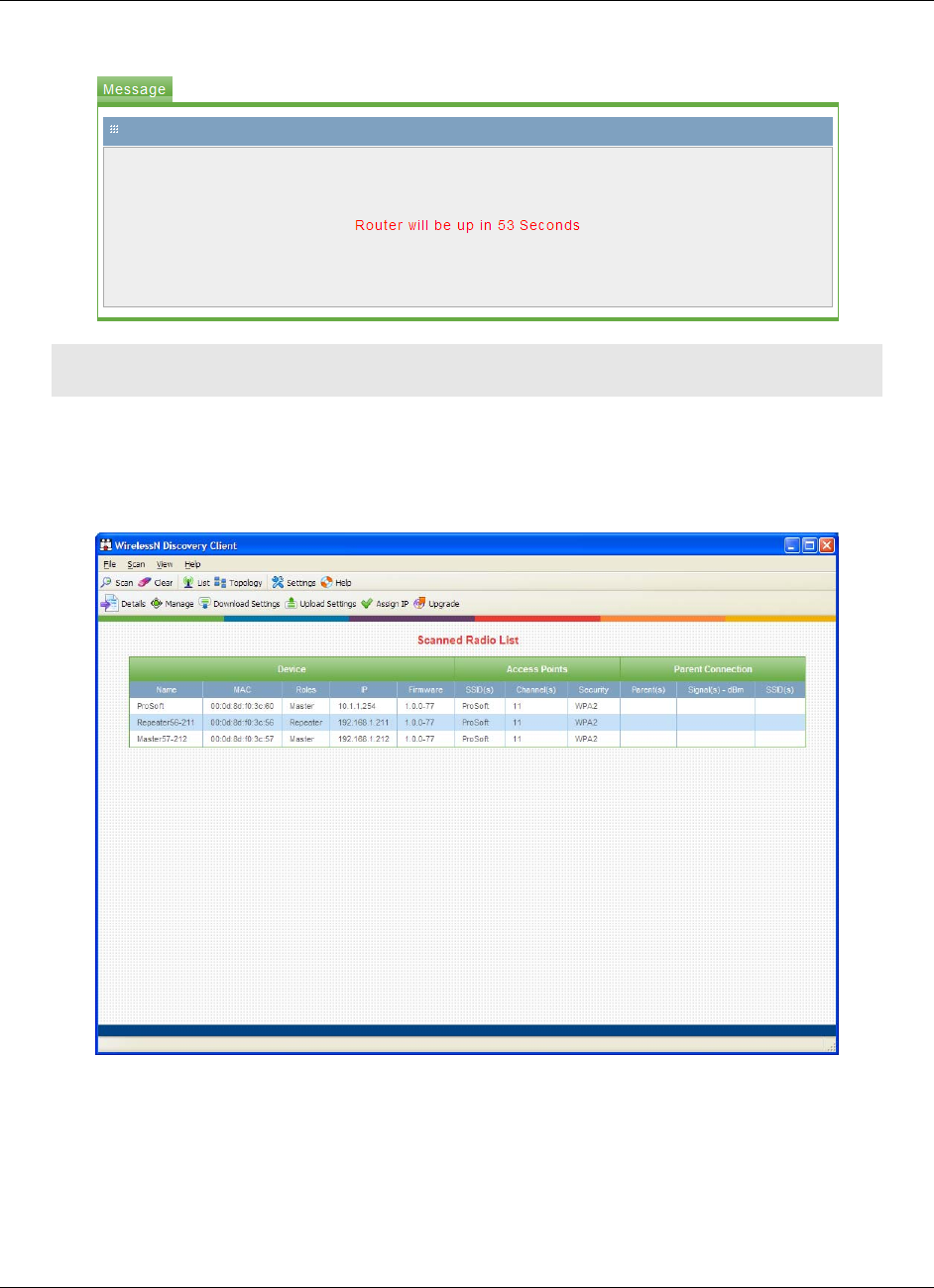
RLXIB-IHN ♦ 802.11n RadioLinx Configuration Manager
Industrial Hotspot User Manual
ProSoft Technology, Inc. Page 97 of 171
May 23, 2011
The radio will reboot automatically to reload the default factory settings.
Note: Network operation will be interrupted while the radio reboots.
3 When the radio has finished rebooting, notice that it reappears in WirelessN
Discovery Tool, with an IP address of 0.0.0.0. You must re-assign the IP
address before you can connect to the Radio Configuration/Diagnostic Utility.
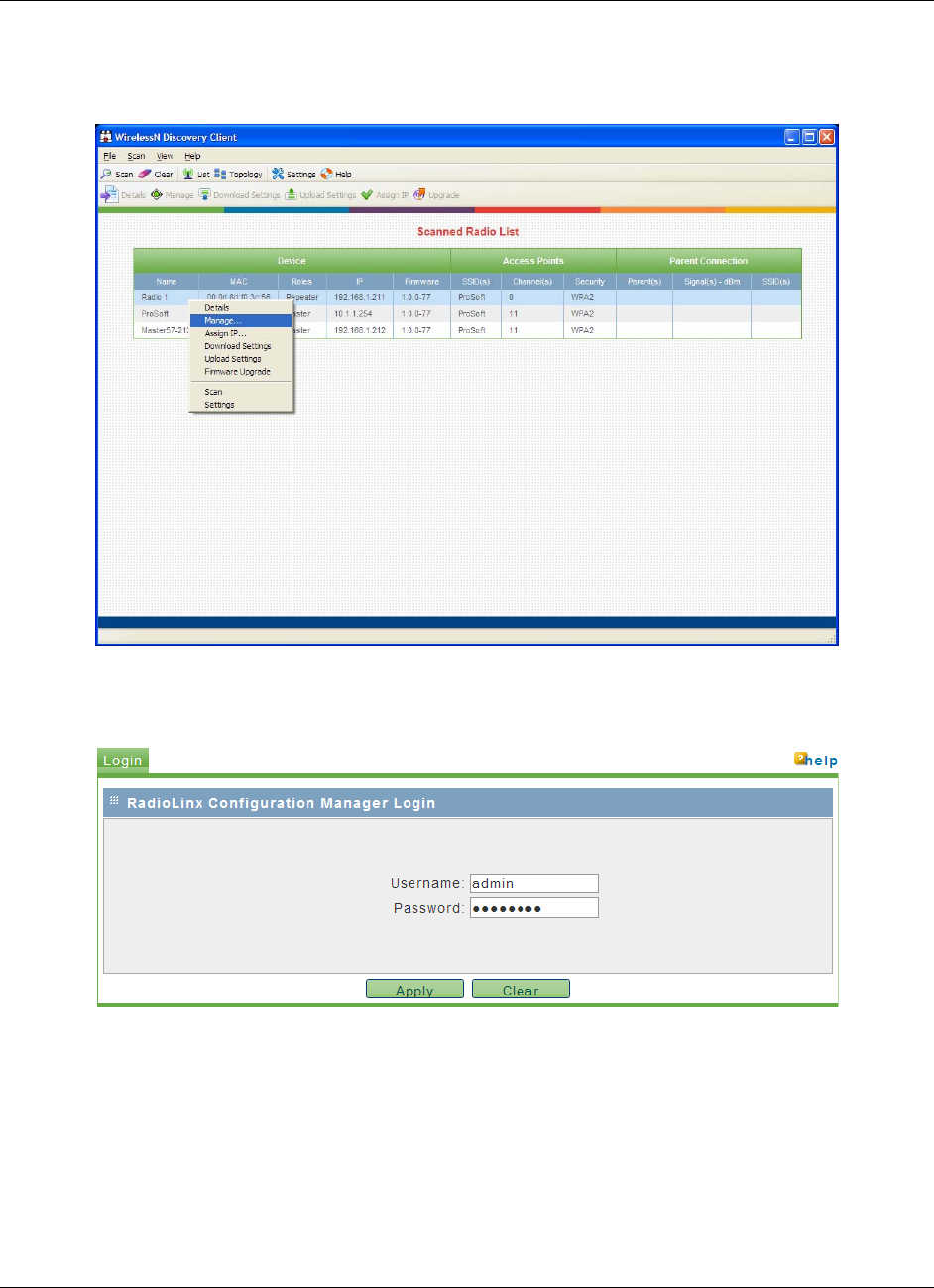
RadioLinx Configuration Manager RLXIB-IHN ♦ 802.11n
User Manual Industrial Hotspot
Page 98 of 171 ProSoft Technology, Inc.
May 23, 2011
4 When the WirelessN Discovery Tool refreshes, right-click the radio and
choose Manage to open the Radio Configuration/Diagnostic Utility in your
web browser (page 121).
5 Log into the radio and restore your settings (page 93), or reconfigure the
radio as needed (page 29).
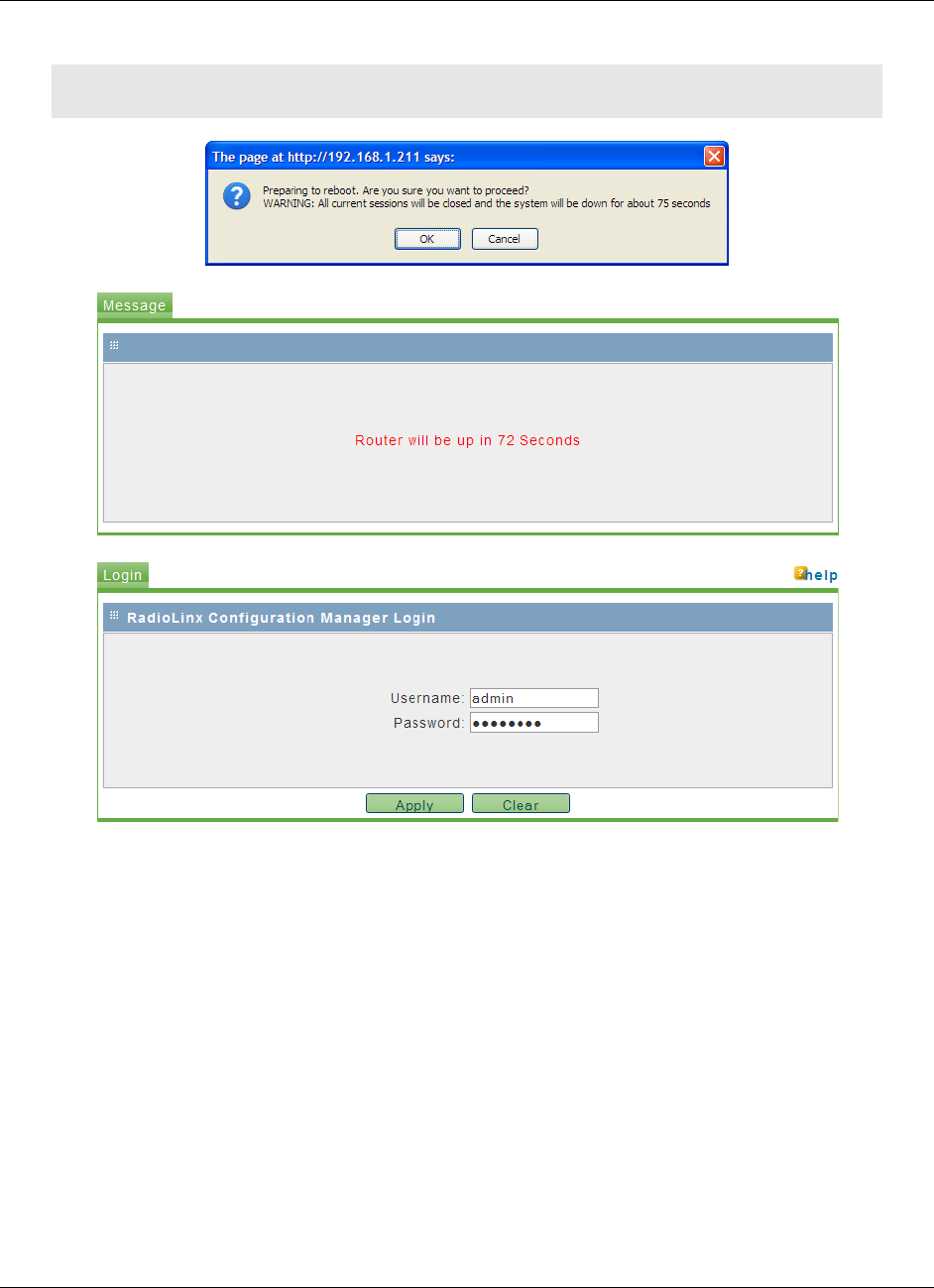
RLXIB-IHN ♦ 802.11n RadioLinx Configuration Manager
Industrial Hotspot User Manual
ProSoft Technology, Inc. Page 99 of 171
May 23, 2011
4.4.3 Rebooting the Radio
Note: Network operation will be interrupted while the radio reboots.
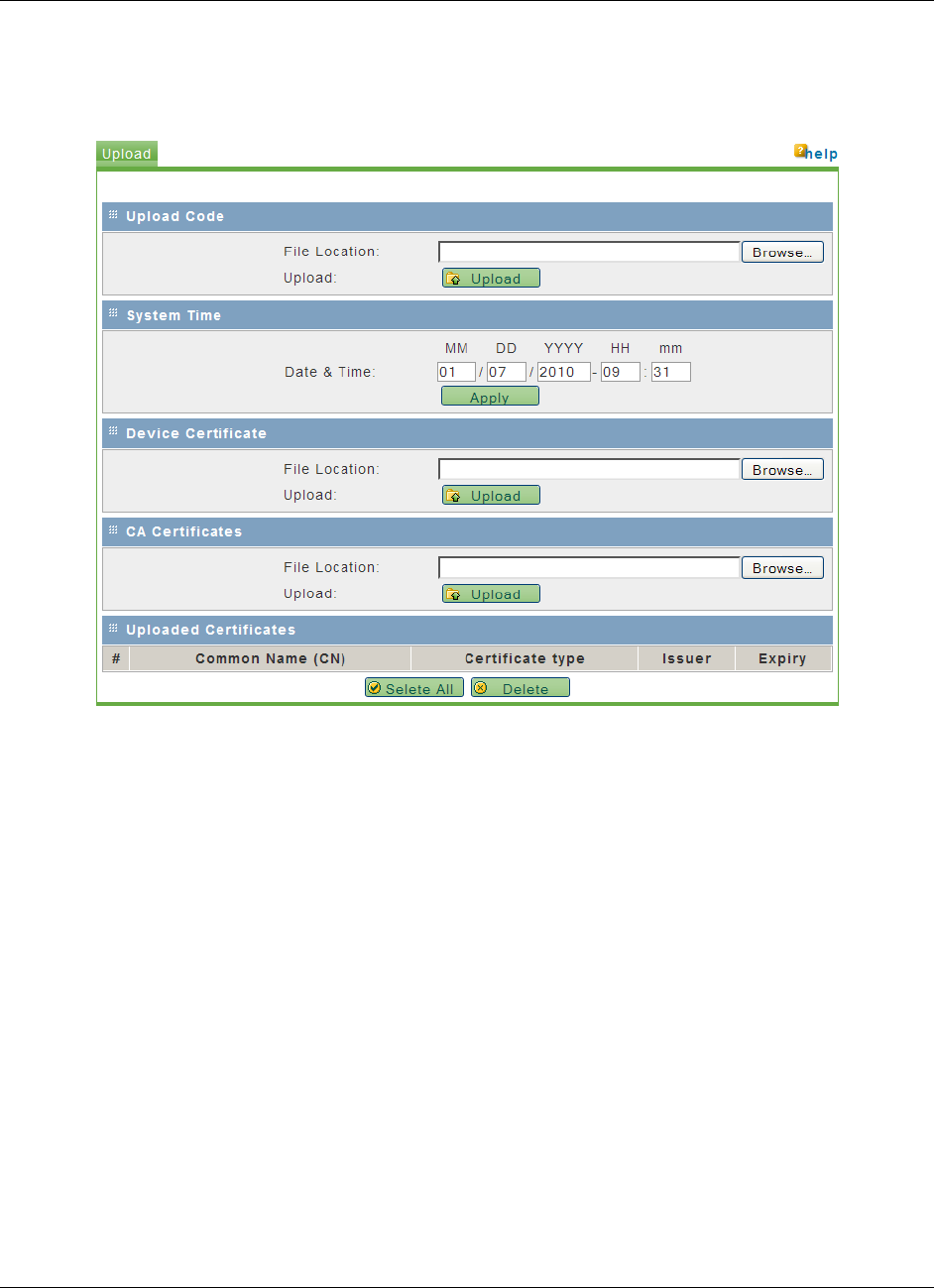
RadioLinx Configuration Manager RLXIB-IHN ♦ 802.11n
User Manual Industrial Hotspot
Page 100 of 171 ProSoft Technology, Inc.
May 23, 2011
4.4.4 Upload
Use the Upload tab to update the radio's firmware, set the system time and date,
or upload RADIUS security certificates.
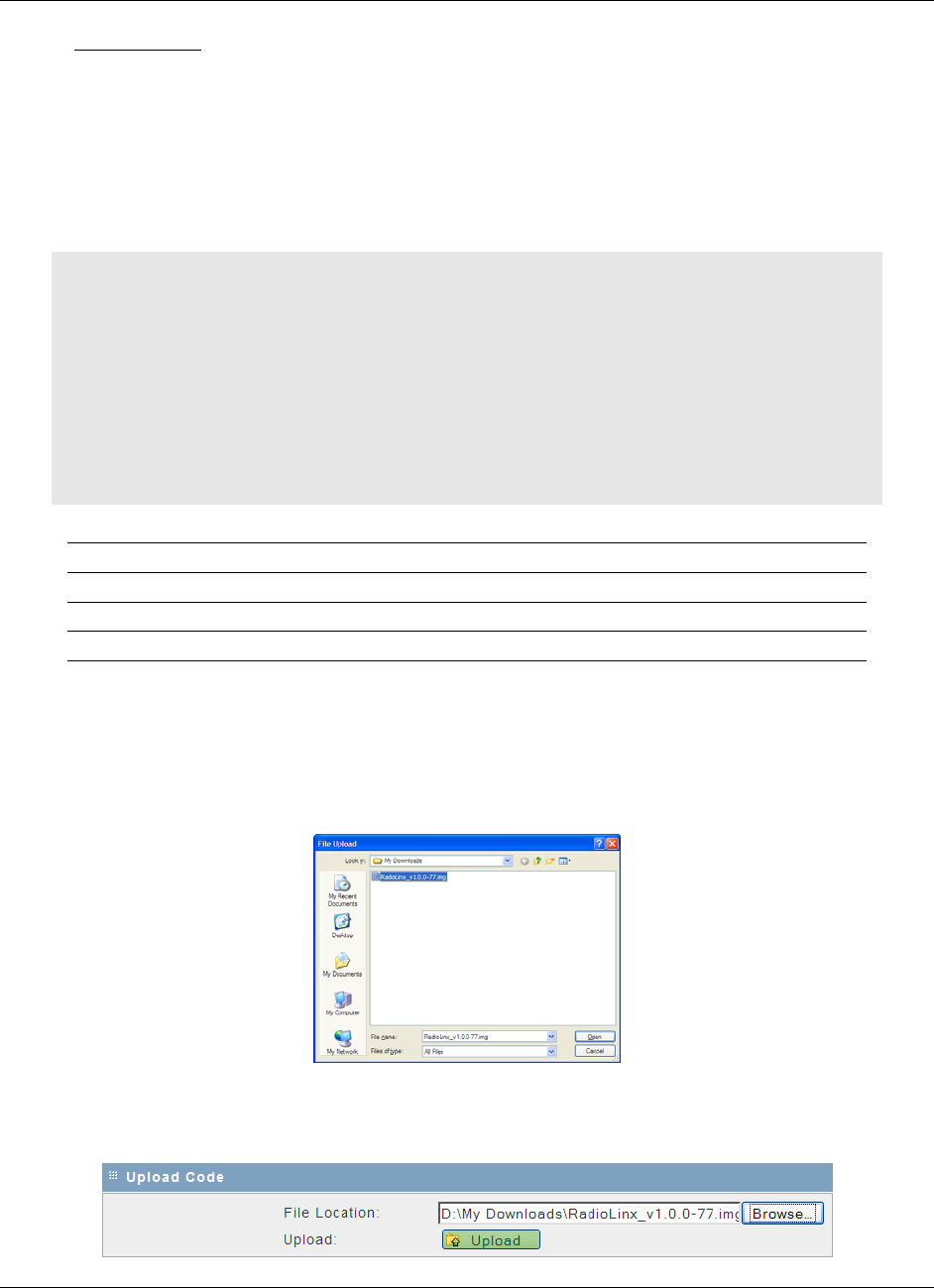
RLXIB-IHN ♦ 802.11n RadioLinx Configuration Manager
Industrial Hotspot User Manual
ProSoft Technology, Inc. Page 101 of 171
May 23, 2011
Upload Code
"Firmware" is the program that runs in the RLXIB-IHN radio that allows it to
communicate and exchange data between devices, using the radio as a network
connection. Different versions of the firmware communicate with other radios in
different ways, and provide different levels of functionality.
In order for your RLXIB-IHN radio to communicate with other RLXIB-IHN devices,
all radios on the network must use the same firmware version.
Important! A firmware upgrade sometimes requires a complete reconfiguration of the
device. See the Release Notes, which are included with the downloaded firmware file, or go
to www.prosoft-technology.com/support/downloads for more information. Read the Release
Notes for any information related to the upgrade before performing the upgrade operation.
Caution: When the code upload operation is in progress:
Do NOT close the browser window.
Do NOT go online.
Do NOT turn off or power-cycle the device.
Do NOT shutdown the computer.
Parameter Description
File Location The path and filename for the file to restore
Browse Opens a File Upload dialog box to locate and select the file to restore
Upload Uploads the firmware file from your PC to the RLXIB-IHN
1 To upgrade the RLXIB-IHN firmware, save a backup copy of your settings
first (page 93),
2 Click BROWSE to locate the firmware file.
3 In the File Upload dialog box, locate the firmware file, and then click OPEN.
This action populates the FILE LOCATION field with the file name and location
of the firmware file.
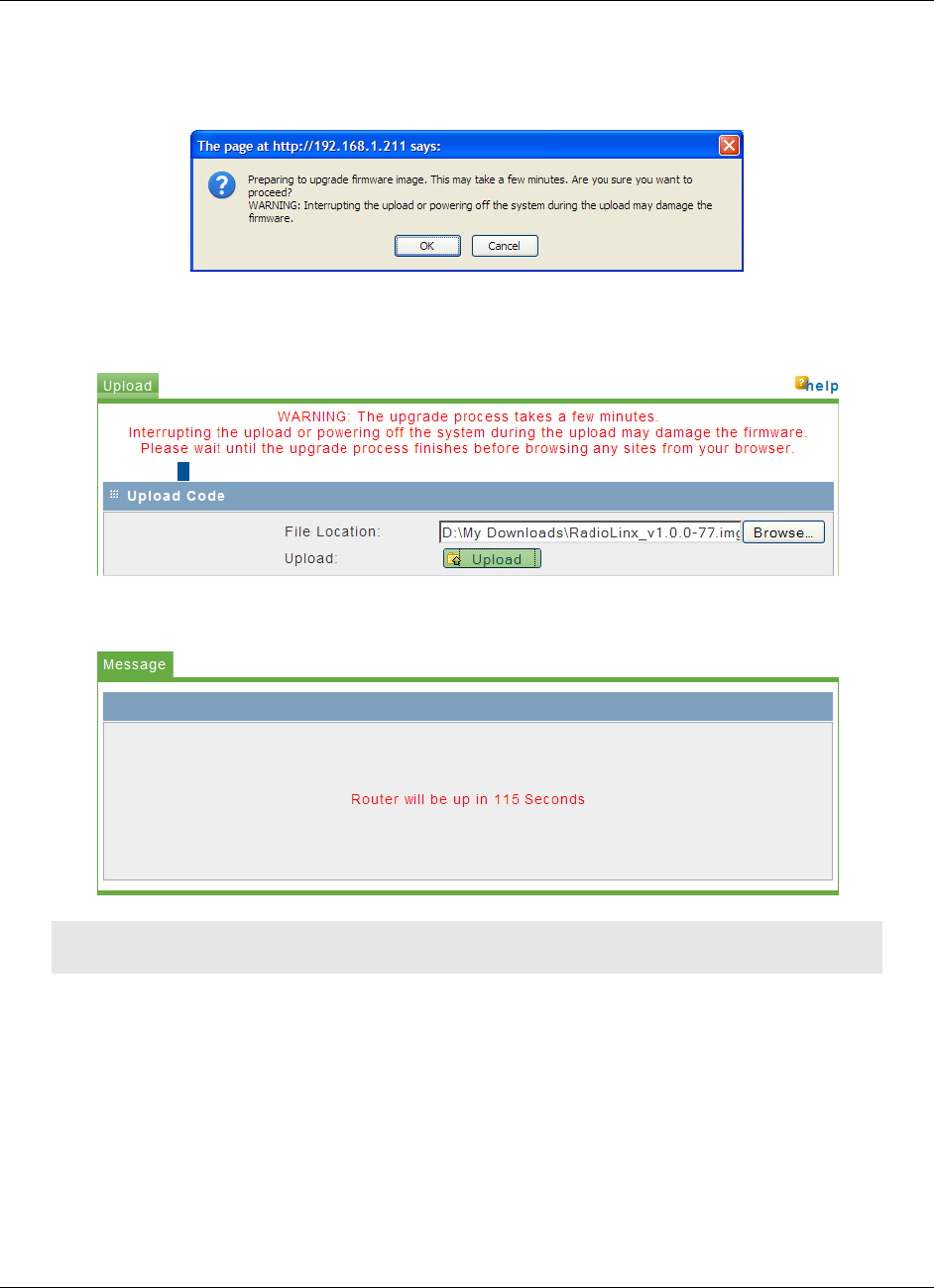
RadioLinx Configuration Manager RLXIB-IHN ♦ 802.11n
User Manual Industrial Hotspot
Page 102 of 171 ProSoft Technology, Inc.
May 23, 2011
4 Click UPLOAD.
5 Read and acknowledge the information window, and then click OK to begin
uploading the firmware.
6 Take care to follow the instructions on the Upload tab. Do not close your web
browser or navigate to other pages while the upload is in progress.
The radio will reboot automatically to load the updated firmware.
Note: Network operation will be interrupted while the radio reboots.
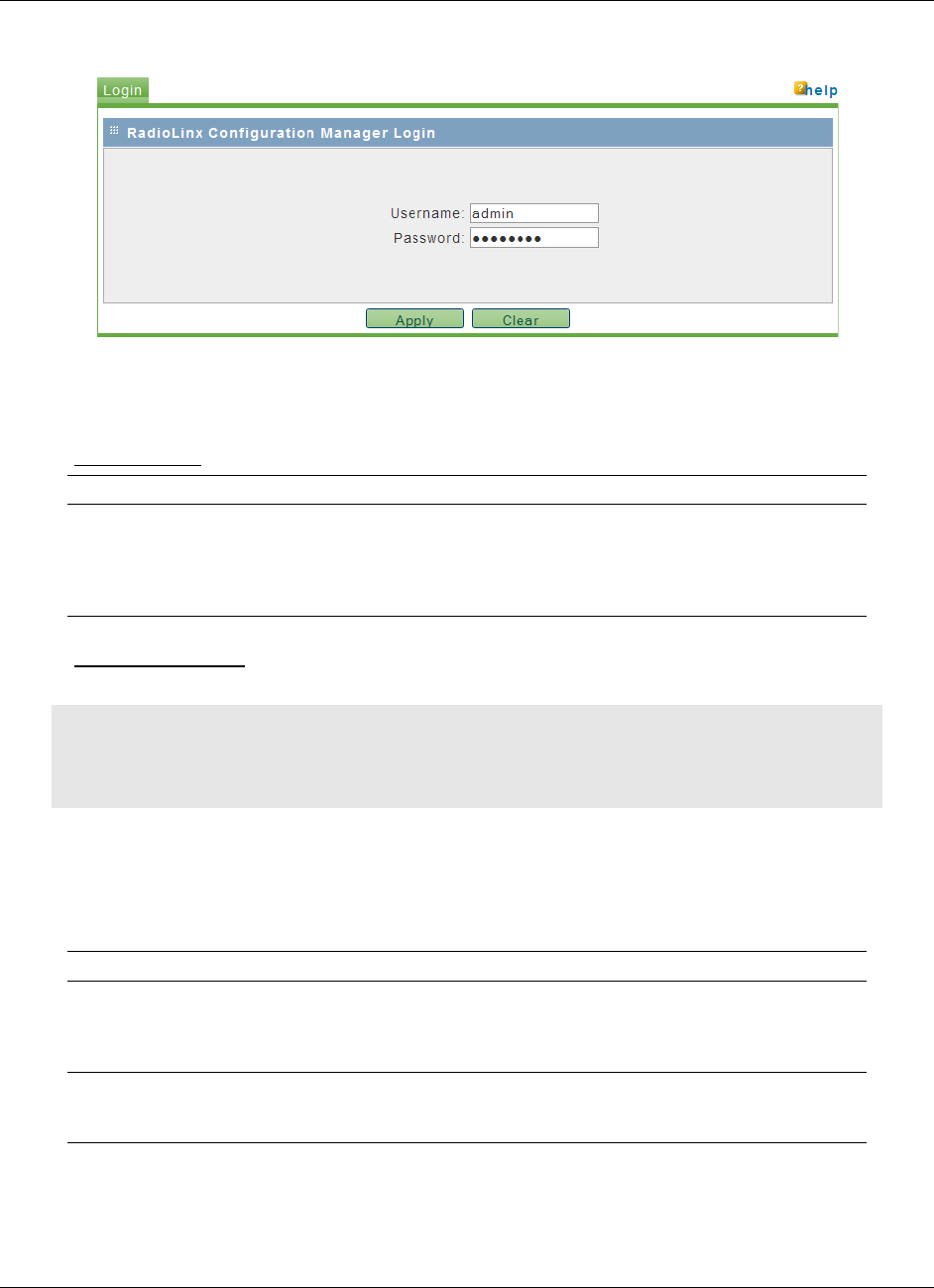
RLXIB-IHN ♦ 802.11n RadioLinx Configuration Manager
Industrial Hotspot User Manual
ProSoft Technology, Inc. Page 103 of 171
May 23, 2011
7 When the radio finishes rebooting, log in with your username and password.
8 If necessary, restore the backup of the radio's settings (page 93), or
reconfigure the radio as needed (page 29).
System Time
Parameter Description
Date & Time The RLXIB-IHN hardware has a real time clock (RTC) used to keep
time. These configuration fields set the system time. Accurate system
time is useful for logging and is required as part of certificate validity
confirmation; expired certificates cannot be used in 802.1X
authentication.
Device Certificate
Note: A detailed discussion of RADIUS authentication and certificates is outside the scope of this
manual. Refer to the documentation for your RADIUS server to determine the proper procedure to
create and use authentication certificates.
Certificates are used to authenticate the identity of users and systems, and are
issued by Certification Authorities (CA) such as VeriSign, Thawte, and other
organizations. Certificates are used by this device for RADIUS server
authentication when using enterprise mode security.
Parameter Description
File Location To upload certificates meant for the device that have been signed by a
trusted CA, the signed certificate file must be stored on the host
computer being used to access this web interface. Click Choose File to
find and select the signed device certificate file.
Upload Once the signed device certificate file is located and its path appears in
the above location field, click Upload. After successful upload this
certificate will be displayed in the below list of Uploaded Certificates.

RadioLinx Configuration Manager RLXIB-IHN ♦ 802.11n
User Manual Industrial Hotspot
Page 104 of 171 ProSoft Technology, Inc.
May 23, 2011
CA Certificate
Trusted Certificates or CA certificates are used to verify the validity of certificates
signed by them. When a certificate is generated, it is signed by a trusted
organization or authority called the Certificate Authority.
Parameter Description
File Location To upload trusted CA certificates, the trusted CA certificate file must be
stored on the host computer being used to access this web interface.
Click Choose File to find and select the trusted CA certificate file.
Upload Once the trusted CA certificate file is located and its path appears in the
above location field, click Upload. After successful upload this certificate
will be displayed in the below list of Uploaded Certificates.
Uploaded Certificates
This table lists the certificates (both device and trusted CA) stored on this unit.
The following fields are displayed:
Parameter Description
Common Name (CN) A unique name used to identify a certificate.
Certificate Type The certificate type should either be device (i.e. meant to authenticate
this RLXIB-IHN radio) or CA (i.e. the signing authority, and must also
exist on the RADIUS server).
Issuer Name The name of the CA that issued the certificate.
Expiry Time The date on which the Certificate expires. You should renew the
certificate before it expires.
The actions that can be taken on uploaded certificates are:
Parameter Description
Select All Selects all the uploaded certificates in the table.
Delete Deletes the selected uploaded certificate or certificates.
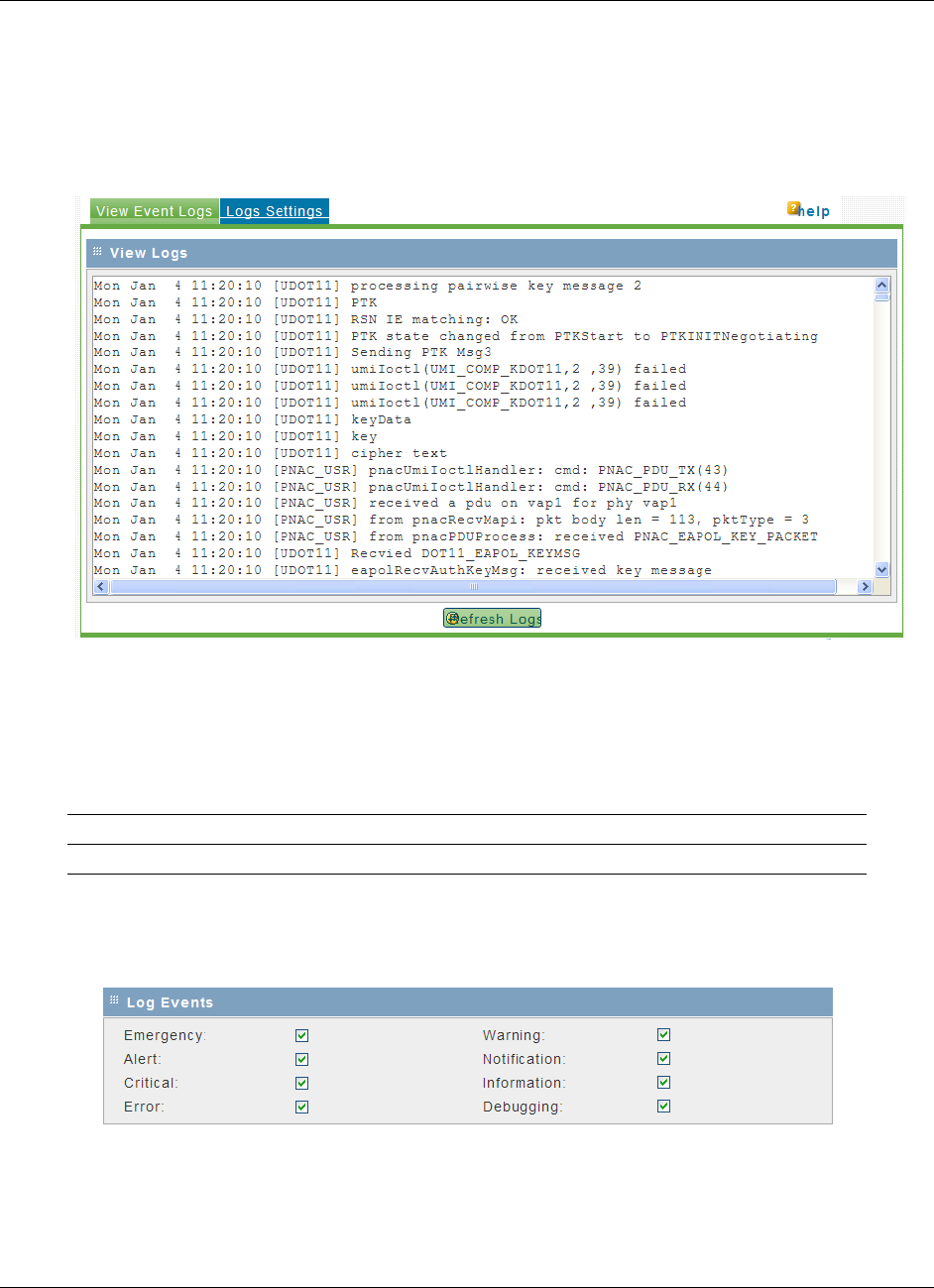
RLXIB-IHN ♦ 802.11n RadioLinx Configuration Manager
Industrial Hotspot User Manual
ProSoft Technology, Inc. Page 105 of 171
May 23, 2011
4.4.5 View Event Logs
This window displays the device's event log viewer. You can record login
attempts, DHCP server messages, reboots, association attempts and other such
information.
Click REFRESH LOGS to view the entries added after the page was opened.
4.4.6 Logs Settings
There are a variety of events that can be captured and logged for review. These
logs can be sent to a system logging (syslog) server or emailed as configured.
Parameter Description
SysLog Server Enter the IP address or Internet Name of the SysLog server.
The following events (in order of severity) can be logged: Emergency, Alert,
Critical, Error, Warning, Notification, Information, Debugging.
When a particular severity level is selected, all events with severity equal to and
greater than the chosen severity are logged on the configured SysLog server.
For example if this is configured as CRITICAL, then logs with severities
CRITICAL, ALERT, and EMERGENCY are logged.

RadioLinx Configuration Manager RLXIB-IHN ♦ 802.11n
User Manual Industrial Hotspot
Page 106 of 171 ProSoft Technology, Inc.
May 23, 2011
The severity levels available for logging are:
Parameter Description
EMERGENCY System is unusable
ALERT Action must be taken immediately
CRITICAL Critical conditions
ERROR Error conditions
WARNING Warning conditions
NOTIFICATION Normal but significant condition
INFORMATION Informational
DEBUGGING Debug-level messages
Click Apply to save your changes.
Click Clear to discard your changes.

RLXIB-IHN ♦ 802.11n WirelessN Discovery Tool
Industrial Hotspot User Manual
ProSoft Technology, Inc. Page 107 of 171
May 23, 2011
5 WirelessN Discovery Tool
In This Chapter
View the List of Detected Radios......................................................... 108
View Radio Network Diagram(s) ......................................................... 109
Configure Radios................................................................................. 110
Scan the Network ................................................................................ 111
Save and Load Snapshots .................................................................. 112
Event Log ............................................................................................113
Firewall Requirements.........................................................................114
Radio List ............................................................................................115
Topology View..................................................................................... 116
Radio Detailed View ............................................................................122
Discovery Tool Menus and Toolbars ................................................... 128
The WirelessN Discovery Tool allows you to manage and monitor supported
radios in a wireless network. This program uses proprietary discovery protocol
messages to display a network topology diagram and current detailed information
for each detected device. For each detected node you can set the IP address or
upgrade the device firmware, or launch the graphical management interface to
access more comprehensive status and configuration options.
The WirelessN Discovery Tool supports Microsoft Windows XP (all editions and
service packs) and Microsoft Vista (all editions) operating systems. Please
contact ProSoft Technology Inc. for questions relating to support for other
operating systems.
The WirelessN Discovery Tool supports the following network discovery and
monitoring activities:
Discover and view the list of radios in the network (page 108)
Display graphically the current network topology and display parent-child links
between various radios in the network (page 116)
Scan the network on demand (page 111)
Save and load network snapshots (page 112)
Upload and download configuration files to/from radio devices (page 119)
Upgrade Radio firmware (page 120)
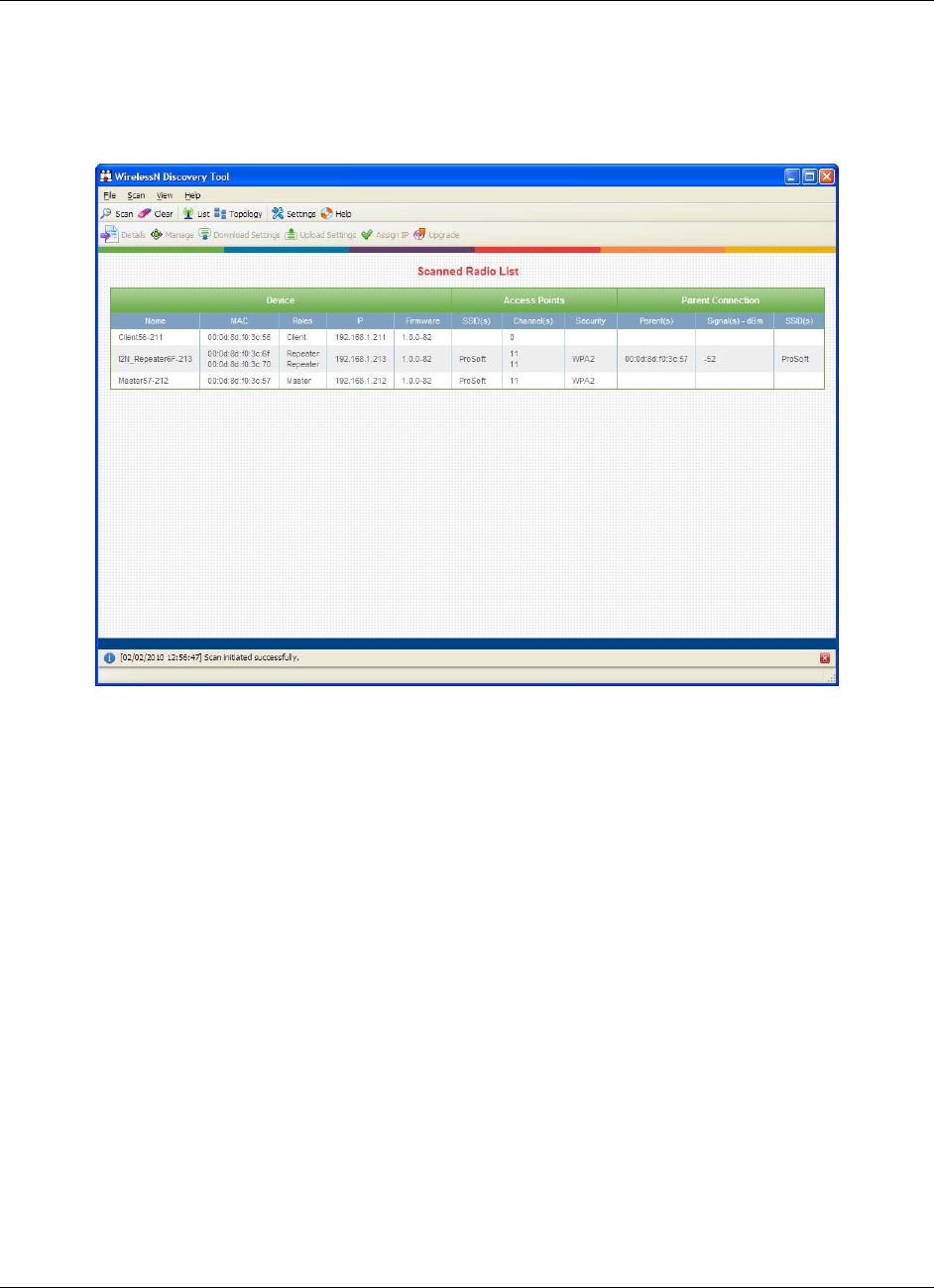
WirelessN Discovery Tool RLXIB-IHN ♦ 802.11n
User Manual Industrial Hotspot
Page 108 of 171 ProSoft Technology, Inc.
May 23, 2011
5.1 View the List of Detected Radios
The Radio List view displays all radios detected by a network scan. This view can
be accessed via the "Radios" toolbar icon or selecting the "Radio List" option in
the View menu.
The Radio List has a table of detected radios in the network. This table allows
you to identify radios by role, MAC address and device name. If a particular radio
has parents or children in the network, they are identified by MAC address, SSID
and security for that wireless link. Clicking on the column heading lets you to sort
the list (in ascending or descending order) based on the selected field.
From this view you can view details of a radio, configure radios and upgrade the
radio firmware.
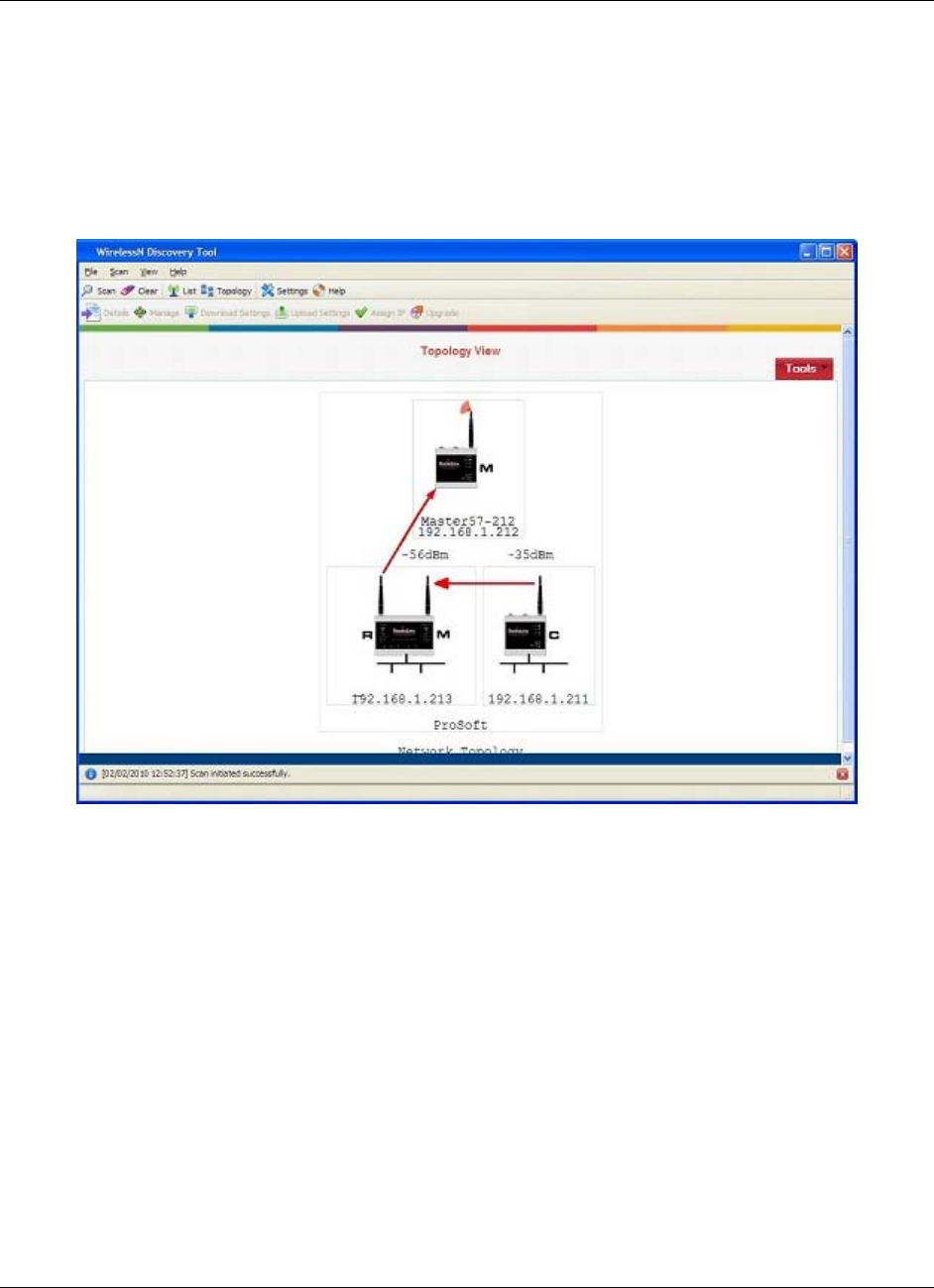
RLXIB-IHN ♦ 802.11n WirelessN Discovery Tool
Industrial Hotspot User Manual
ProSoft Technology, Inc. Page 109 of 171
May 23, 2011
5.2 View Radio Network Diagram(s)
The Topology View displays a network diagram of devices detected by the
Discovery Tool. This view can be accessed via the "Topology" toolbar icon or by
selecting the "Topology View" option in the View menu. The topology view
visually displays the parent-child relationships between various radios in a
wireless distributed network. From this view you can also open details of a radio,
configure radios and upgrade radio firmware.

WirelessN Discovery Tool RLXIB-IHN ♦ 802.11n
User Manual Industrial Hotspot
Page 110 of 171 ProSoft Technology, Inc.
May 23, 2011
5.3 Configure Radios
The WirelessN Discovery Tool can do basic radio configuration changes such as:
upgrading the device firmware
uploading a settings file
setting the IP address of the radio.
When a radio is selected in the list or topology view, the toolbar or right-click
context menu respectively will let you:
download configuration settings to a file on your host
upload saved configuration settings from your host to the device
upgrade the device firmware with a firmware image located on your host
change the LAN IP address and subnet mask of the device
More advanced radio configuration is available in the device's graphical
management interface. Clicking the "Manage" button (or right-clicking on the
device in the Topology or Radio List views and choosing the Manage option) will
launch your default web browser and open the radio's management interface via
the IP address of the device.
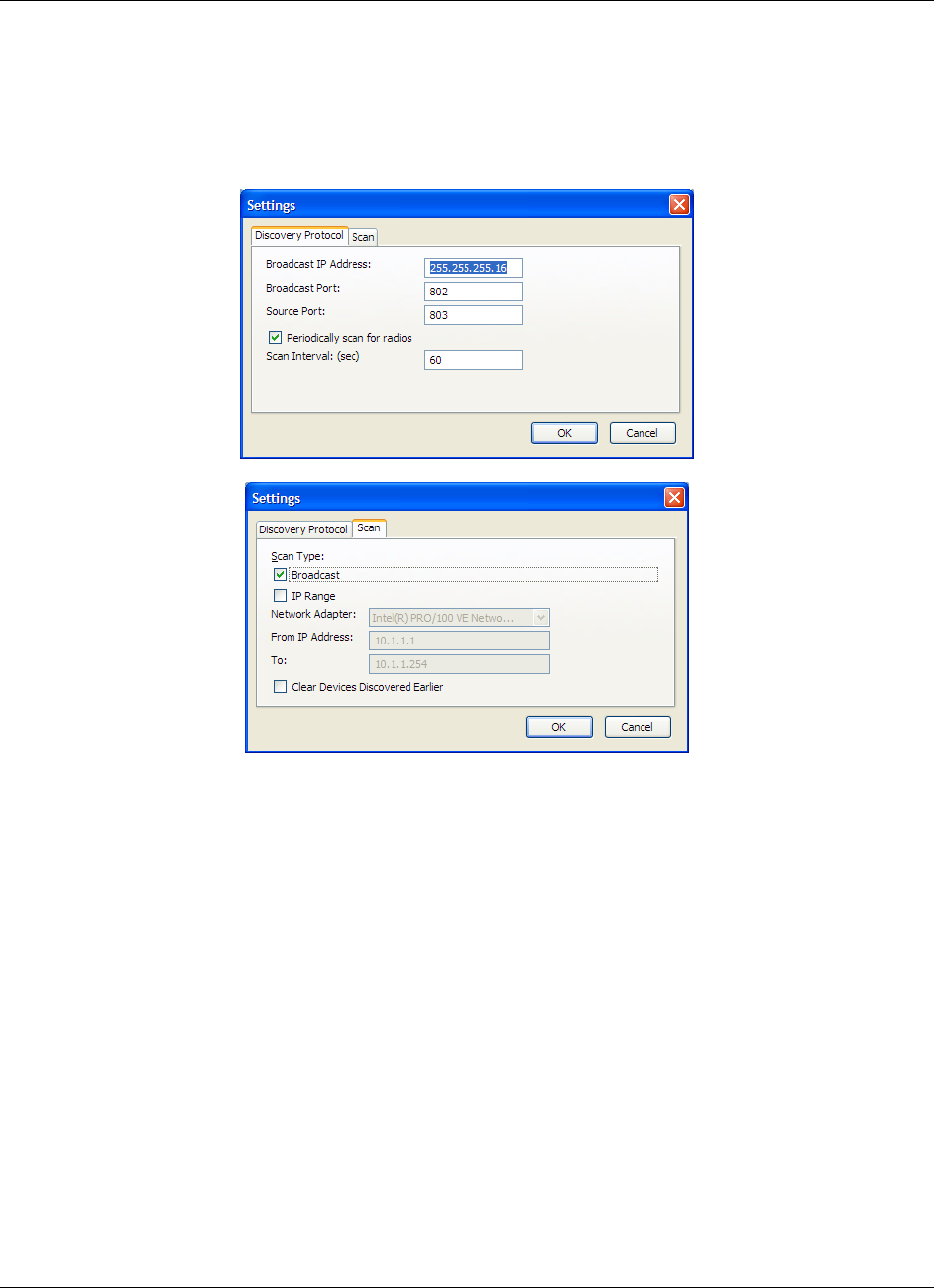
RLXIB-IHN ♦ 802.11n WirelessN Discovery Tool
Industrial Hotspot User Manual
ProSoft Technology, Inc. Page 111 of 171
May 23, 2011
5.4 Scan the Network
The scan settings dialog box is accessible via the Scan menu or by right-clicking
on device in the Topology view or Radio List view and choosing the Setting
option. The broadcast IP range for the scan, scan interval, and the host's network
adaptor(s) to use in the scan can all be configured here.

WirelessN Discovery Tool RLXIB-IHN ♦ 802.11n
User Manual Industrial Hotspot
Page 112 of 171 ProSoft Technology, Inc.
May 23, 2011
5.5 Save and Load Snapshots
The Discovery Tool allows you to save the current snapshot of the network and
load or review the network details later on. This is useful in comparing the current
network configuration or topology with one or more previous configurations.
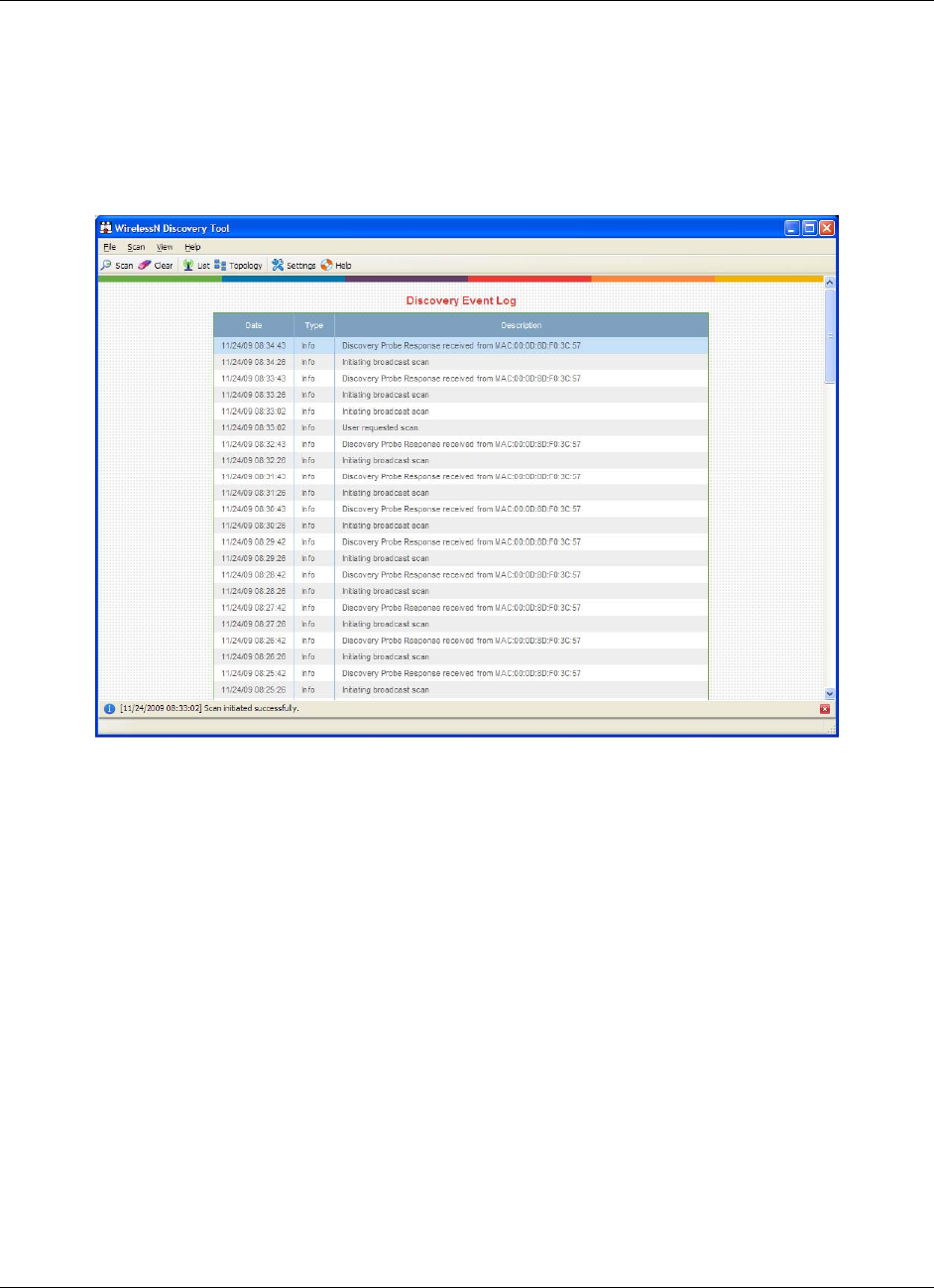
RLXIB-IHN ♦ 802.11n WirelessN Discovery Tool
Industrial Hotspot User Manual
ProSoft Technology, Inc. Page 113 of 171
May 23, 2011
5.6 Event Log
The Event Log displays the events collected by this Discovery Tool during
discovery and configuration operations. Each log entry will have a timestamp and
type setting. The very bottom of the screen allows you to quickly access or the
most recent or earliest set of log messages, and also change the number of log
messages displayed on the screen at any given time.
The following events are logged:
Network events including discovery messages from various devices
User requested operation such as scan requests and configuration requests
Errors in processing user requests or network events

WirelessN Discovery Tool RLXIB-IHN ♦ 802.11n
User Manual Industrial Hotspot
Page 114 of 171 ProSoft Technology, Inc.
May 23, 2011
5.7 Firewall Requirements
Note that a firewall program running on the Windows host for the WirelessN
Discovery Tool must be configured to open this utility's broadcast and source
ports in order for supported network devices to be detected by discovery traffic.
The broadcast and source ports are described in the scan menu section (page
128). This utility uses ports 802 and 803 for receiving discovery UDP messages
from supported radios and thus requires that this port be opened for traffic on the
Windows PC's firewall.

RLXIB-IHN ♦ 802.11n WirelessN Discovery Tool
Industrial Hotspot User Manual
ProSoft Technology, Inc. Page 115 of 171
May 23, 2011
5.8 Radio List
The Radio List shows a table of detected radios in the network. This table allows
you to easily identify radios by role, MAC address and device name. If a
particular radio has parents or children in the network, they are identified by MAC
address, SSID and security for that wireless link.
It is possible for the supported radio unit to have two physical radios, which
would lead to two rows of WLAN card specific information for a single radio IP
address. Each radio's information is classified in three logical groups: device
information, details about access points broadcast by this device, and information
about connected supplicants (children). The columns in the table can be sorted
(in ascending or descending order) by clicking on the field heading.
Parameter Description
Device The details in this section are properties of the supported radio. The
Name, IP address, and firmware version of the device are displayed
here. As well the device's Role, one of Master/Repeater/Client will be
displayed (Client mode is for single radios only). In the case of a unit
having two radios, there will be two entries for roles, depending on how
each radio is configured (do not configure either side of a dual radio as
a Client). The device MAC address is the shared bridge MAC address
and is used for all data packets leaving the unit via the radio or
Ethernet interfaces.
Access Points If a device has radios in Master or Repeater modes, access point
details will be displayed in this section. The management AP (the trunk
link) information for the device is listed for each radio: the SSID(s),
radio channel(s), and security options configured for that link.
Supplicant If a device has radios in Repeater or Client modes, supplicant details
are displayed in this section. These fields identify the parent connection
for this device and the link characteristics. The Parent MAC address,
signal strength of the link (in dBm), and SSID of the link are displayed.
Each Repeater or Client radio can have at most one parent at a given
time.
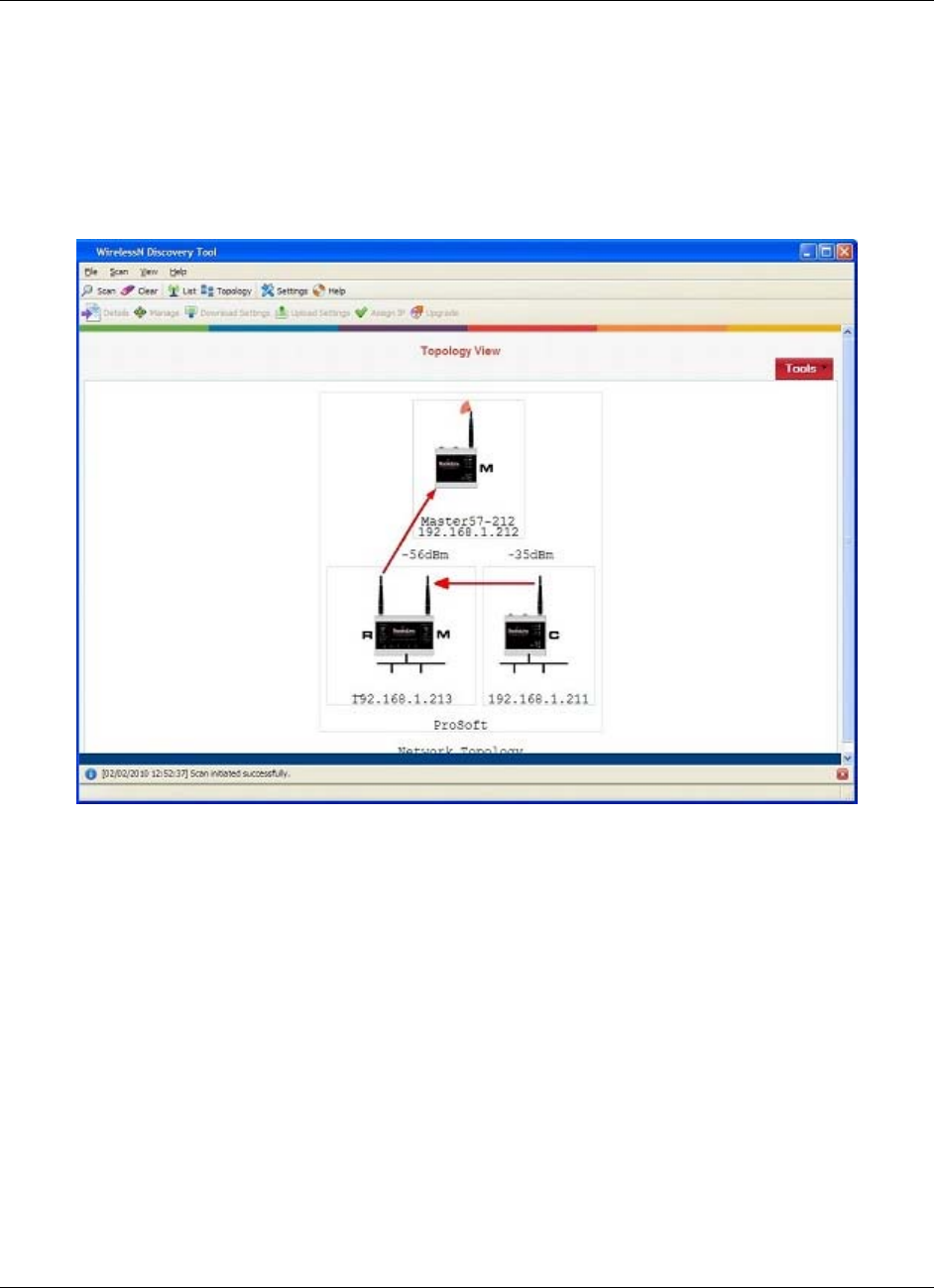
WirelessN Discovery Tool RLXIB-IHN ♦ 802.11n
User Manual Industrial Hotspot
Page 116 of 171 ProSoft Technology, Inc.
May 23, 2011
5.9 Topology View
The Topology view displays a network diagram of devices detected by the client,
and the relationships that exist (or can exist) between these network elements.
The Master, Repeater, and Client roles are presented visually in a color coded
and vertically aligned diagram with the Master radio(s) at the top of the page.
This view allows you to obtain a summary of the entire detected network and also
select specific radios for further analysis or configuration.
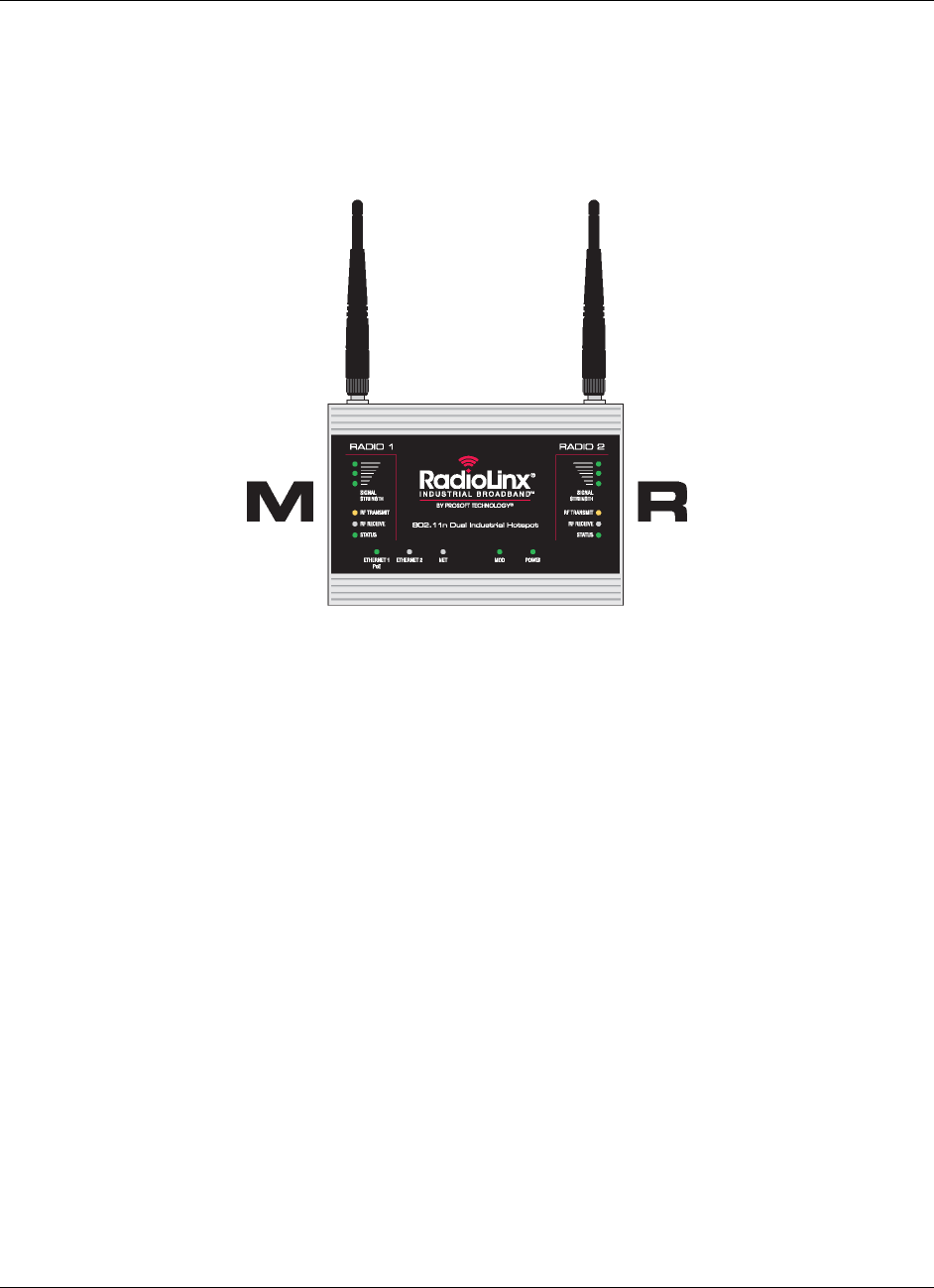
RLXIB-IHN ♦ 802.11n WirelessN Discovery Tool
Industrial Hotspot User Manual
ProSoft Technology, Inc. Page 117 of 171
May 23, 2011
Each radio icon has a letter icon that corresponds to the role - M for Masters, R
for Repeaters, and C for Clients. In the case of a device with two radios (i.e. two
WLAN cards) each having a different role, a letter is shown on the left and right
sides of the image in the topology view, indicating the function of each WLAN
card. For example, the radio in the following illustration has one card configured
as a Master, and the other card configured as a Repeater.
Devices that are connected in the wireless distributed system are identified by an
arrow. The arrow points from the child radio (supplicant) to the parent radio.
Available alternate parents can be viewed on the network diagram by right
clicking to open the context menu and selecting "Show alternate parents" option,
at which point a dashed green line will be drawn from the selected device to
eligible potential parents in the network.
Nodes in the topology diagram are grouped by SSIDs. Nodes within an SSID
network are enclosed by a light grey box. The SSID of the network is displayed at
the bottom of the box. As well the arrow colors of the parent-child links with the
network are specific to the SSID. For example, a dual-radio device in repeater
mode can be connected to two different Masters, each with a unique SSID. In
this case this dual-radio device will have two different color arrow links to the
Masters.
If one or more true wireless clients (i.e. a laptop) are connected to a radio in the
network, the icon's left antenna will display a red ripple-like indicator. Similarly if
the device is connected to the wired LAN, a black wire baseline will be attached
to the bottom of the radio image.
A left click on a radio image will enclose the device in a dashed red box. When a
radio is selected in this manner, a quick summary box will open identifying the
unit's IP address, MAC address, and other device-specific details. Right-clicking
on a device opens a context-menu (Please see "Context Menu" section for
details.).
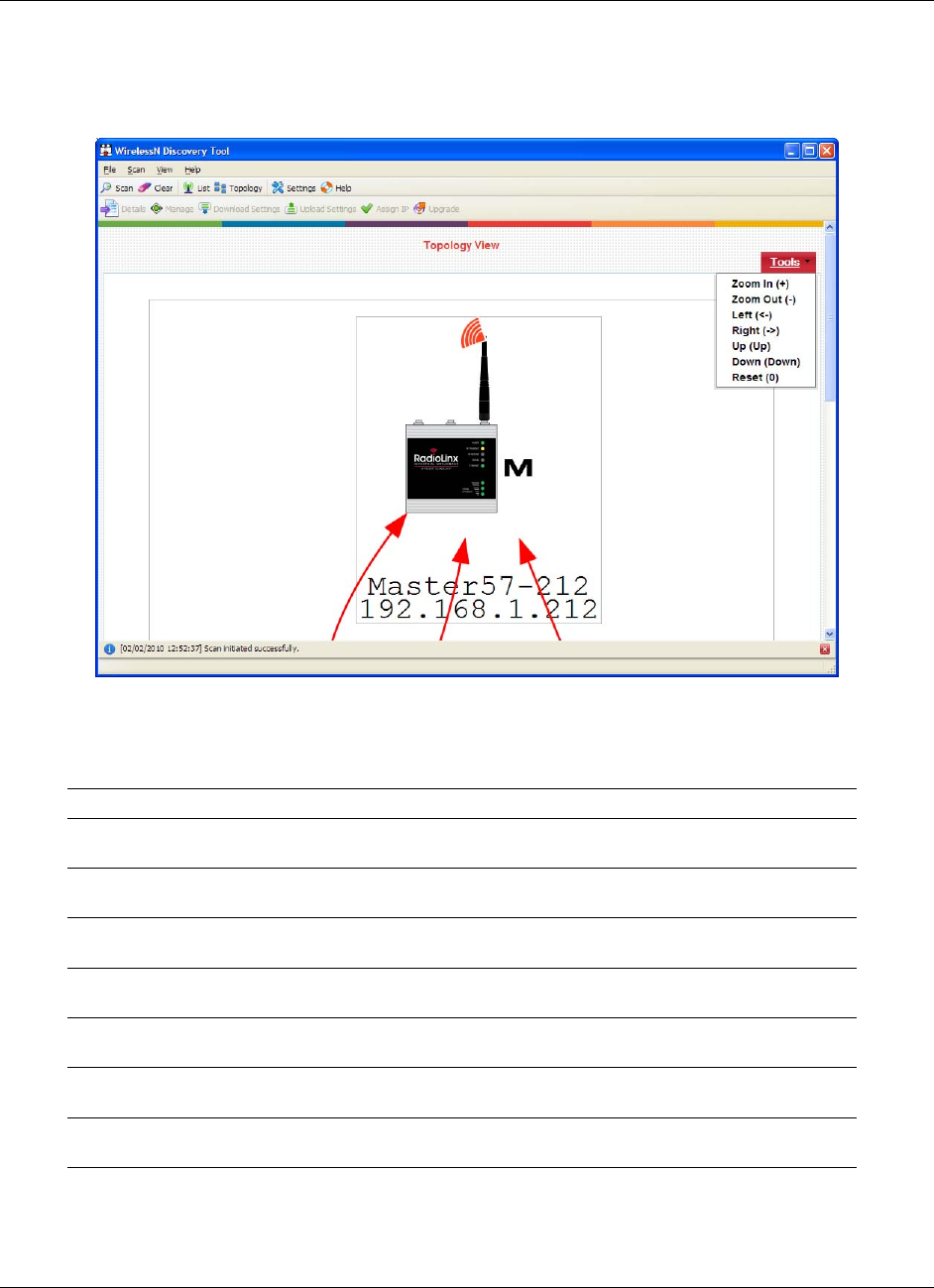
WirelessN Discovery Tool RLXIB-IHN ♦ 802.11n
User Manual Industrial Hotspot
Page 118 of 171 ProSoft Technology, Inc.
May 23, 2011
5.9.1 Display tools
In the Topology view, the utility allows you to focus on a particular network or
device by using zooming and panning capabilities.
The Tool menu on the top left of the Topology view lists the available display
commands:
Parameter Description
Zoom In Zoom in to the center of the view by clicking on this option or using the
"+" key
Zoom out Zoom in from the center of the view by clicking on this option or using
the "-" key
Left Move the view in the display window to the left by clicking on this option
or using the "←" key
Right Move the view in the display window to the right by clicking on this
option or using the "→" key
Up Move the view in the display window up by clicking on this option or
using the "↑" key
Down Move the view in the display window down by clicking on this option or
using the "↓" key
Reset Reset the view to the original defaults by clicking on this option or using
the "0" key
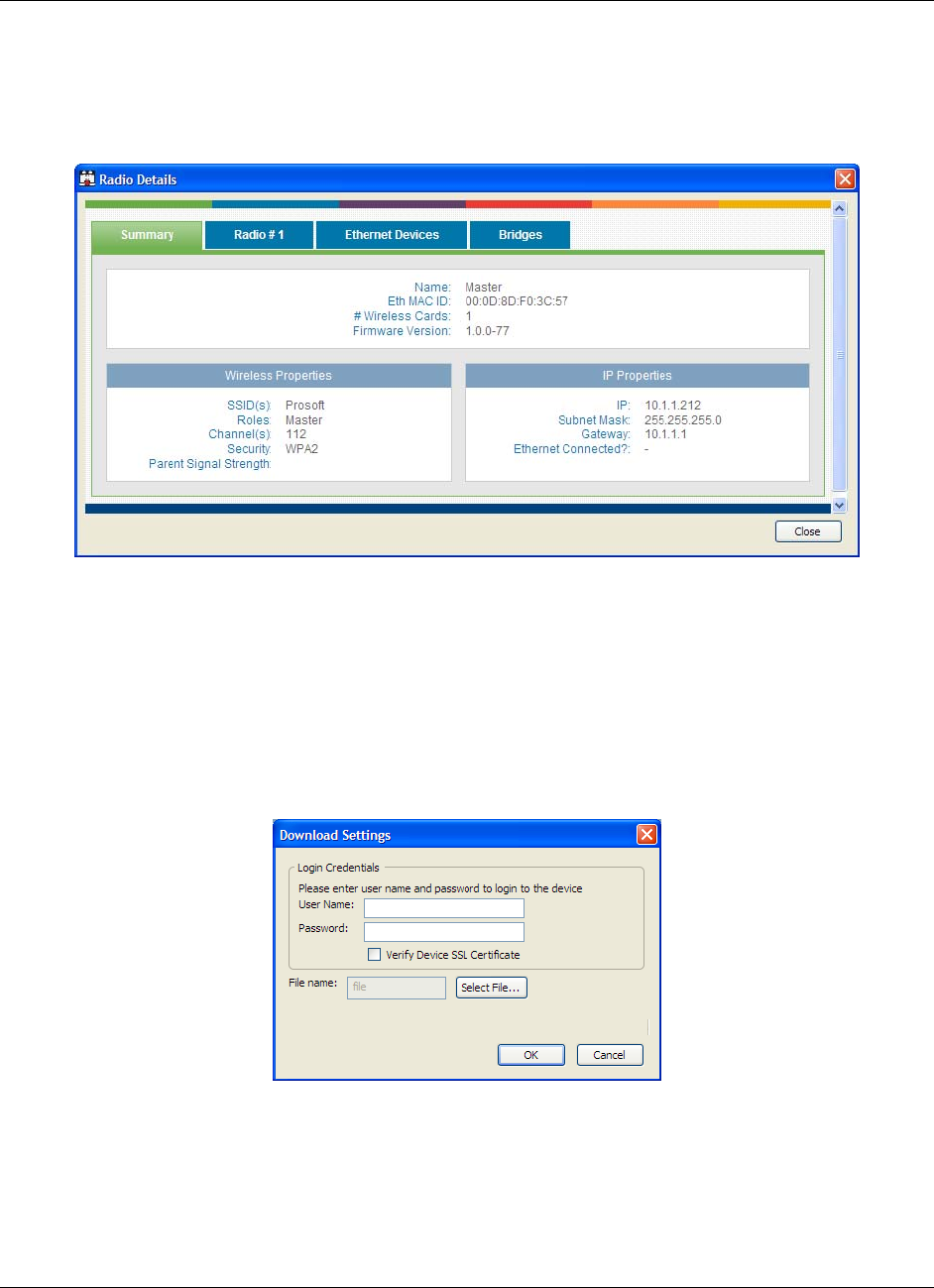
RLXIB-IHN ♦ 802.11n WirelessN Discovery Tool
Industrial Hotspot User Manual
ProSoft Technology, Inc. Page 119 of 171
May 23, 2011
5.9.2 View Radio Details
Radio details can be viewed by double-clicking the corresponding list item in the
table, clicking the "Details" toolbar icon or selecting "Details" from the right-click
context menu.
5.9.3 Download Radio Settings
A radio's configuration settings can be downloaded by selecting a radio and then
clicking the "Download Settings" button on the toolbar. Alternatively, you can
right click on the desired radio and click the "Download Settings" menu option. A
dialog box will request login credentials for the radio and the directory in which to
download the configuration file from the device. Enter the required information
and click "OK" to download the settings for the radio.
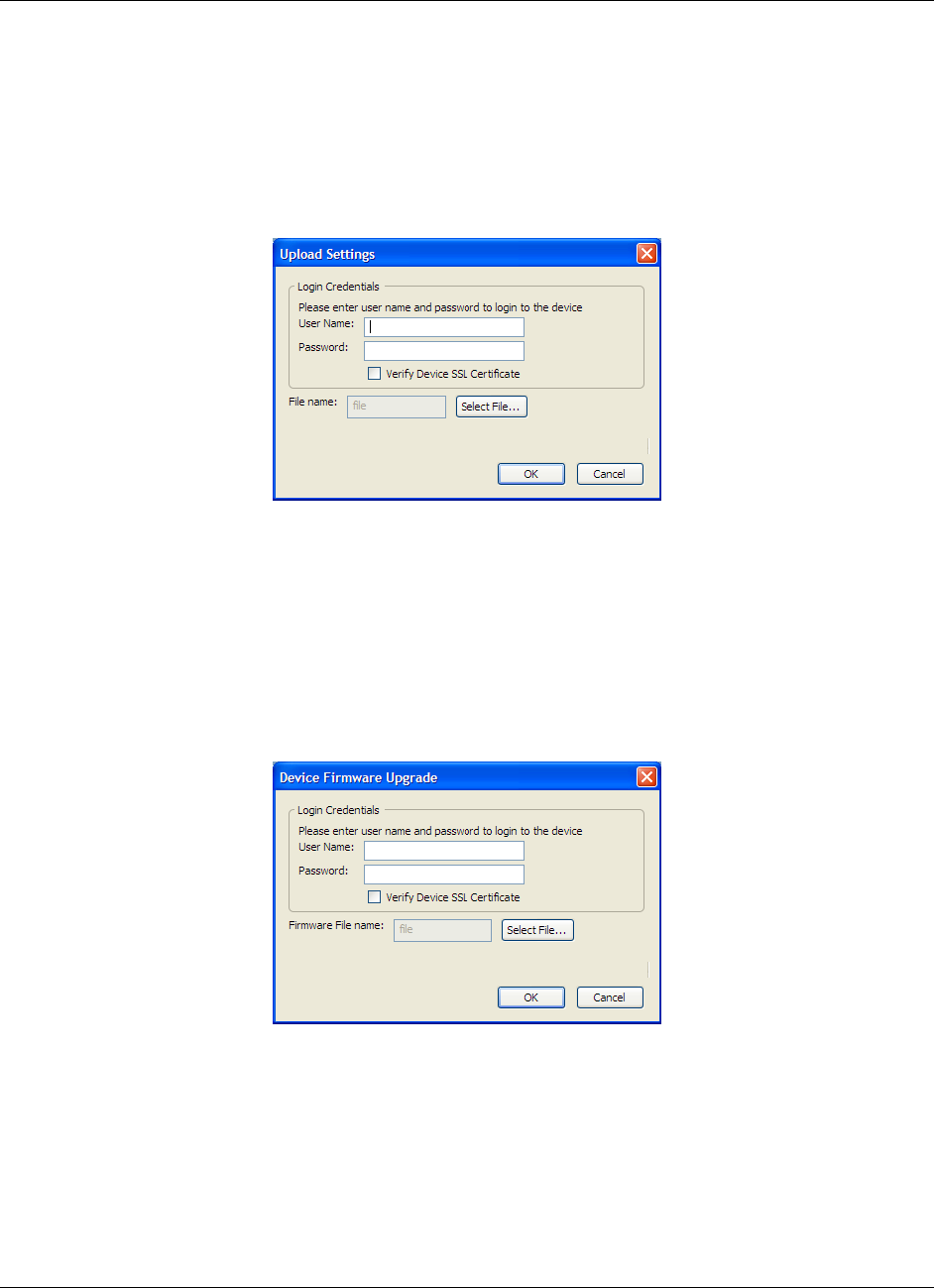
WirelessN Discovery Tool RLXIB-IHN ♦ 802.11n
User Manual Industrial Hotspot
Page 120 of 171 ProSoft Technology, Inc.
May 23, 2011
5.9.4 Upload Radio Settings
A radio's configuration settings can be uploaded by selecting a radio and then
clicking the "Upload Settings" button on the toolbar. Alternatively, you can right
click on the desired radio and click the "Upload Settings" menu option. A dialog
box will request login credentials for the radio and the directory path for the
settings file. Enter the information and click "OK" to upload the settings for the
radio.
5.9.5 Upgrade Radio Firmware
A radio's firmware can be upgraded by selecting a radio and then clicking the
"Upgrade" button on the toolbar. Alternatively, you can right click on the desired
radio and click the "Upgrade" menu option. A dialog box will request login
credentials for the radio and the directory path for the firmware image. Enter the
information and click "OK" to upgrade the radio's firmware. Note that this
operation may take a few minutes to complete.
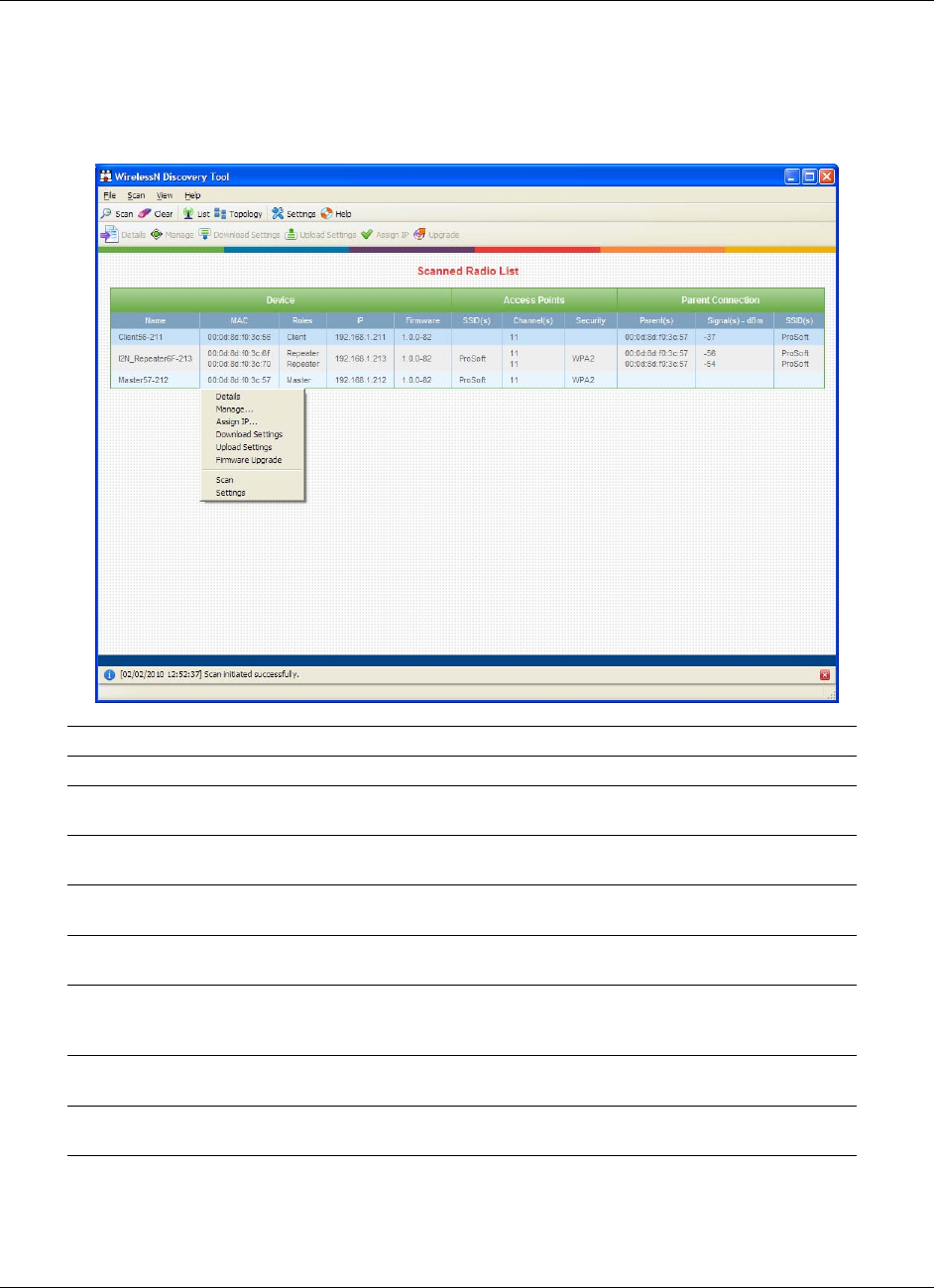
RLXIB-IHN ♦ 802.11n WirelessN Discovery Tool
Industrial Hotspot User Manual
ProSoft Technology, Inc. Page 121 of 171
May 23, 2011
5.9.6 Right click Context Menu
Use your mouse to right click on a device in the radio list view to display the
context menu. This menu allows you to access device details and perform
device-specific commands without changing views.
Parameter Description
Details This will open a pop-up dialog box with the radio's details
Manage This command will launch the device's web based management
interface using your default browser
Assign IP Click this to change the device's IP address and subnet mask of the
selected device
Download Settings This command will open a prompt that allows you to download the
device's configuration file to your host machine.
Upload Settings The prompt opened by this command will allow you to upload a
configuration file from your host to the selected device
Firmware Upgrade Choose this option to get the firmware upgrade prompt, allowing you to
upgrade the device's firmware with an image stored on the Windows
host
Scan Click this to manually scan the network for new device information and
display any changes to the topology view.
Settings This command opens the scan settings dialog box, allowing you to
configure the scan range and frequency.
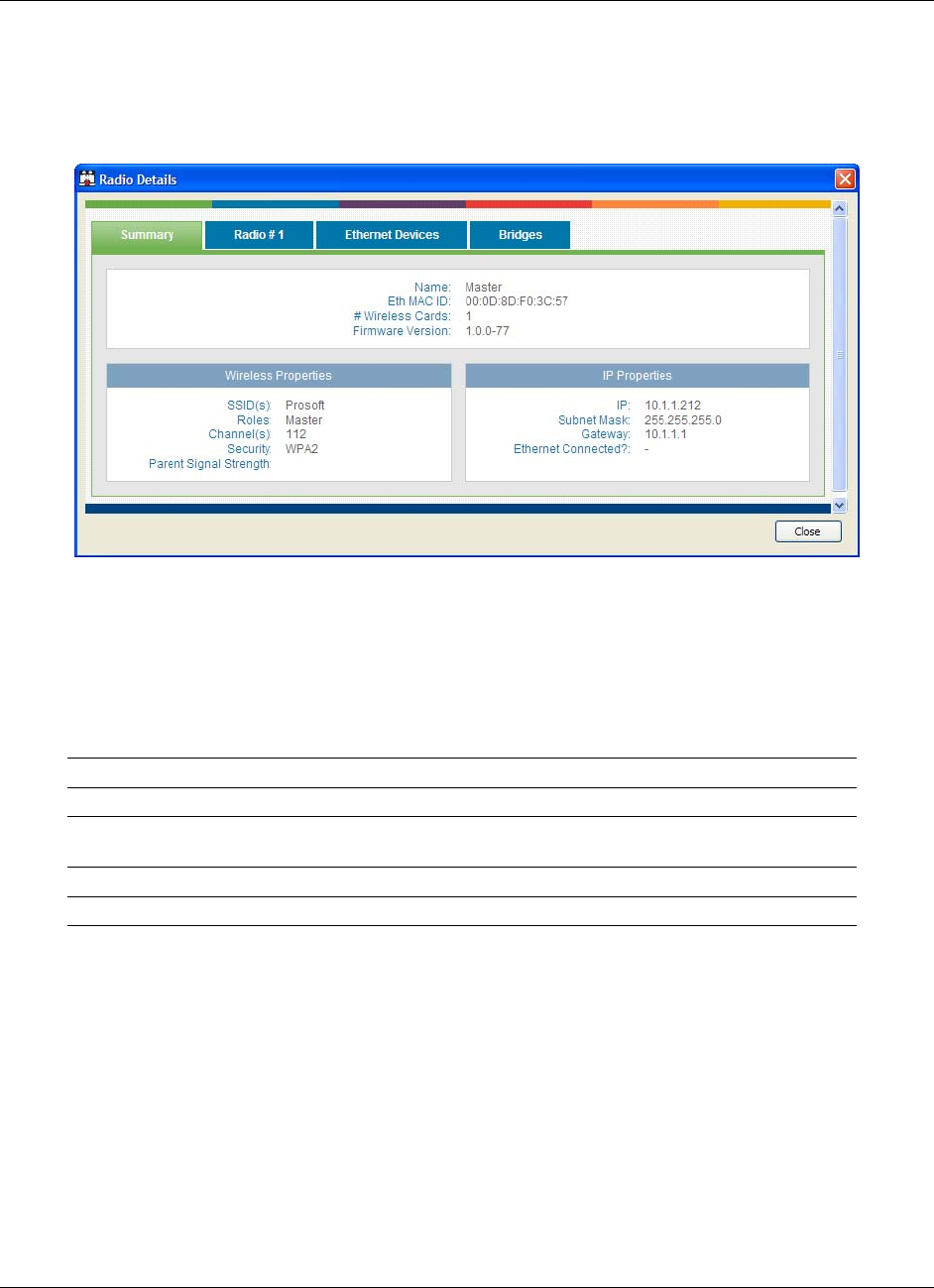
WirelessN Discovery Tool RLXIB-IHN ♦ 802.11n
User Manual Industrial Hotspot
Page 122 of 171 ProSoft Technology, Inc.
May 23, 2011
5.10 Radio Detailed View
Each radio has more specific information available for the user than what is
presented on either the Radio List or Topology view. This section displays
comprehensive device specific properties available to the utility.
5.10.1 Summary
General radio properties are presented here. For devices that support multiple
physical WLAN cards, the information in this section is valid irrespective of the
number of radio cards present in the hardware.
Parameter Description
Name The device name, as configured via the unit's GUI
Eth MAC ID the MAC address of the bridge interface - the Ethernet and Radio MAC
addresses are shared
# Wireless Cards Certain device hardware versions support up to 2 physical WLAN cards
Firmware version The radio firmware version

RLXIB-IHN ♦ 802.11n WirelessN Discovery Tool
Industrial Hotspot User Manual
ProSoft Technology, Inc. Page 123 of 171
May 23, 2011
Wireless Properties
Parameter Description
SSID(s) Each radio on the device is part of a wireless network identified by the
SSID. This SSID is used by the Radio's parent and/or child link as
applicable. The radio can be configured to support more than more
than one network when virtual access points are enabled - the use of
virtual AP's will display multiple SSID entries.
Roles One of Master, Repeater, or Client. Each physical radio (WLAN card)
on the supported device has a configured role.
Channel(s) This is the WiFi communication channel in use by the SSID referenced
above. If virtual AP's are in use, then there can be more than 1 channel
in use by the radio for communication.
Security The type of security used over the wireless link used to connect to the
parent, e.g. WPA, WEP, etc.
Parent Signal Strength For radios that have a link to an upstream parent, the wireless signal
strength (in dBm) of the parent link is displayed here.
IP Properties
Parameter Description
IP The radio's IPv4 address
Subnet Mask The subnet mask used to define this radio's network.
Gateway The network's gateway IP address.
Ethernet Connected? If the radio is part of the wired Ethernet network, this field will show
Connected.
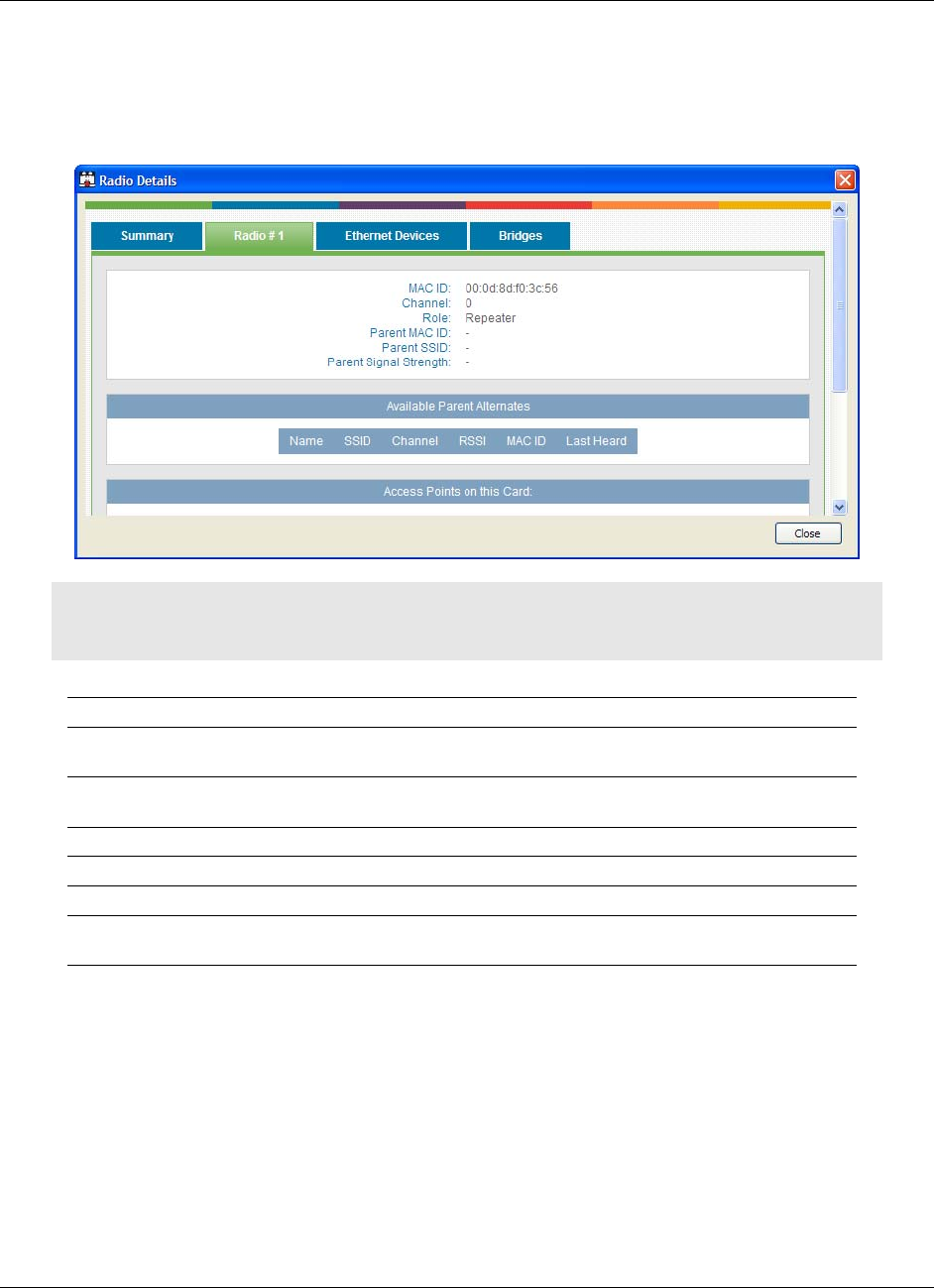
WirelessN Discovery Tool RLXIB-IHN ♦ 802.11n
User Manual Industrial Hotspot
Page 124 of 171 ProSoft Technology, Inc.
May 23, 2011
5.10.2 Radio #
Certain devices support up to two WLAN cards. The card specific details are
captured on these tabs. For hardware that supports a single WLAN card, only the
Card #1 tab will be displayed.
Note: Each Radio's configuration is unique. If the hardware supports two radios, there will be two
instances of the Radio Configuration/Status area, one per radio.
Parameter Description
MAC ID the MAC address of the bridge interface - the Ethernet and Radio MAC
addresses are shared
Channel This is the WiFi communication channel in use by management link
(AP or supplicant connection)
Role One of Master, Repeater, or Client.
Parent MAC ID The MAC address of this radio's parent, if applicable
Parent SSID The SSID of the parent link, if applicable
Parent Signal Strength For radios that are connected to upstream parents, the wireless signal
strength in dBm of the parent link is displayed here.

RLXIB-IHN ♦ 802.11n WirelessN Discovery Tool
Industrial Hotspot User Manual
ProSoft Technology, Inc. Page 125 of 171
May 23, 2011
Available Parent Alternates
This table displays the list of available parents for this particular radio when it is
configured to be in a Repeater or Client role. Master role radios do not have
entries for this table. The following information is displayed:
Parameter Description
Name The name of the available parent
SSID The available parent's SSID; this defines the wireless network.
Channel The broadcast channel used by the available parent and wireless
network in general.
RSSI The received signal strength indicator (in dBm) of the parent; it is an
indicator of signal strength between this device and the available
parent
MAC ID The available parent's MAC address.
Last Heard This is the time in seconds since this available parent was most
recently heard.
Access Points on this Card
This radio card can support up to 4 APs: one management (trunk) link and 3
virtual AP's which can have unique VLAN IDs. This section outlines the
properties of each configured AP.
Parameter Description
SSID The AP is identified by its SSID
Name The unique identifier of this AP
Mode The mode of operation for this AP's role in the wireless network
Master (there can be only 1 per SSID-defined network), Repeater, or
Client.
Security the type of security used by this AP, e.g. WEP, WPA etc.
Attached Clients This table lists all connected clients, whether they are true wireless
clients or bridge devices in Repeater or Client mode. The client Name,
detected RSSI, MAC ID, and Last Heard data is available.
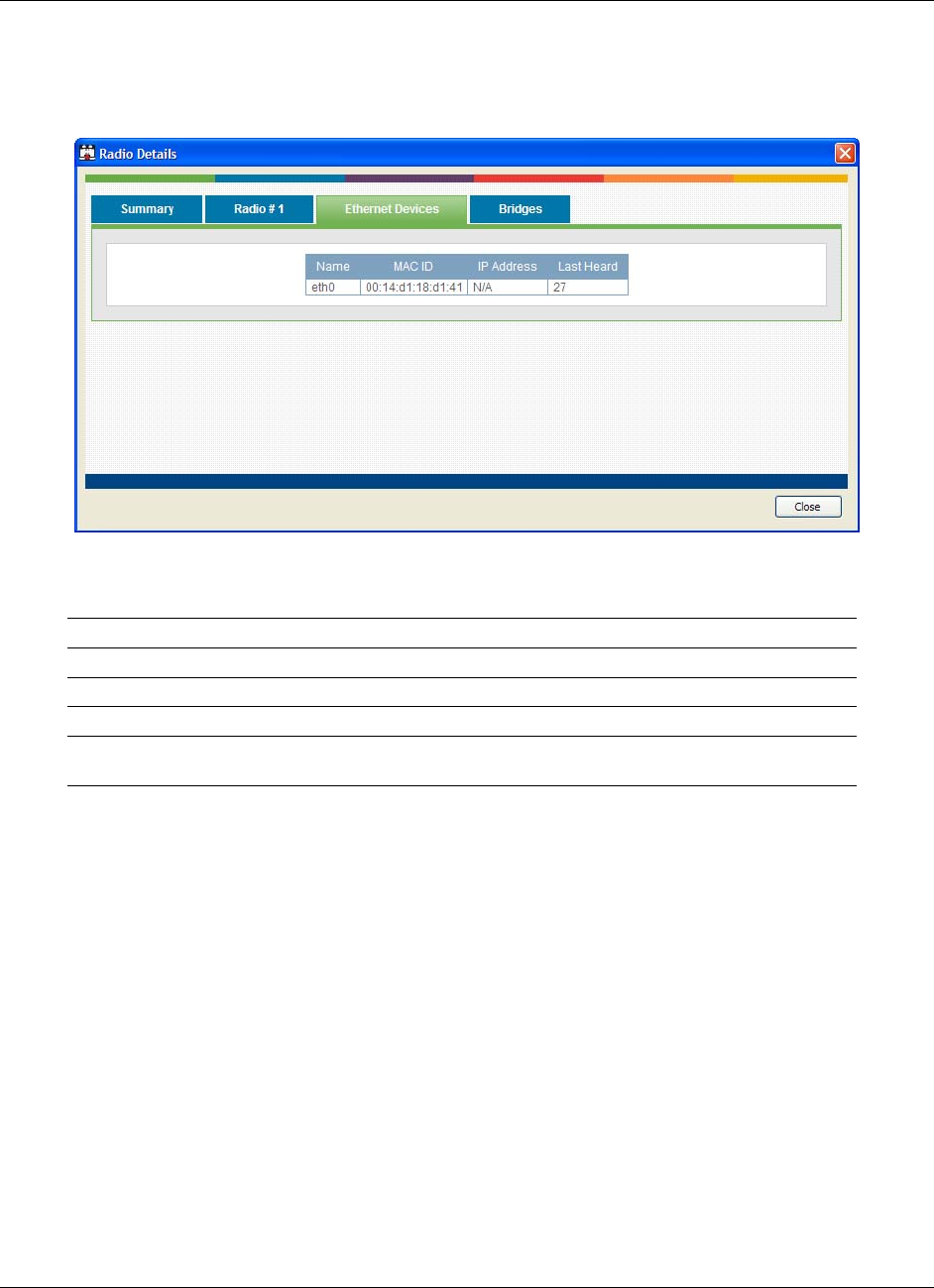
WirelessN Discovery Tool RLXIB-IHN ♦ 802.11n
User Manual Industrial Hotspot
Page 126 of 171 ProSoft Technology, Inc.
May 23, 2011
5.10.3 Ethernet Devices
Nodes connected to the wired Ethernet interface of this device are detected by
ARP scans from the device and listed in a table on this tab.
The following information is displayed:
Parameter Description
Name The identifier assigned to the Ethernet client, if available
MAC ID The Ethernet client's MAC address.
IP Address the IP address of the connected Ethernet client, if available
Last Heard this is the time in seconds since this connected Ethernet client was
most recently heard.
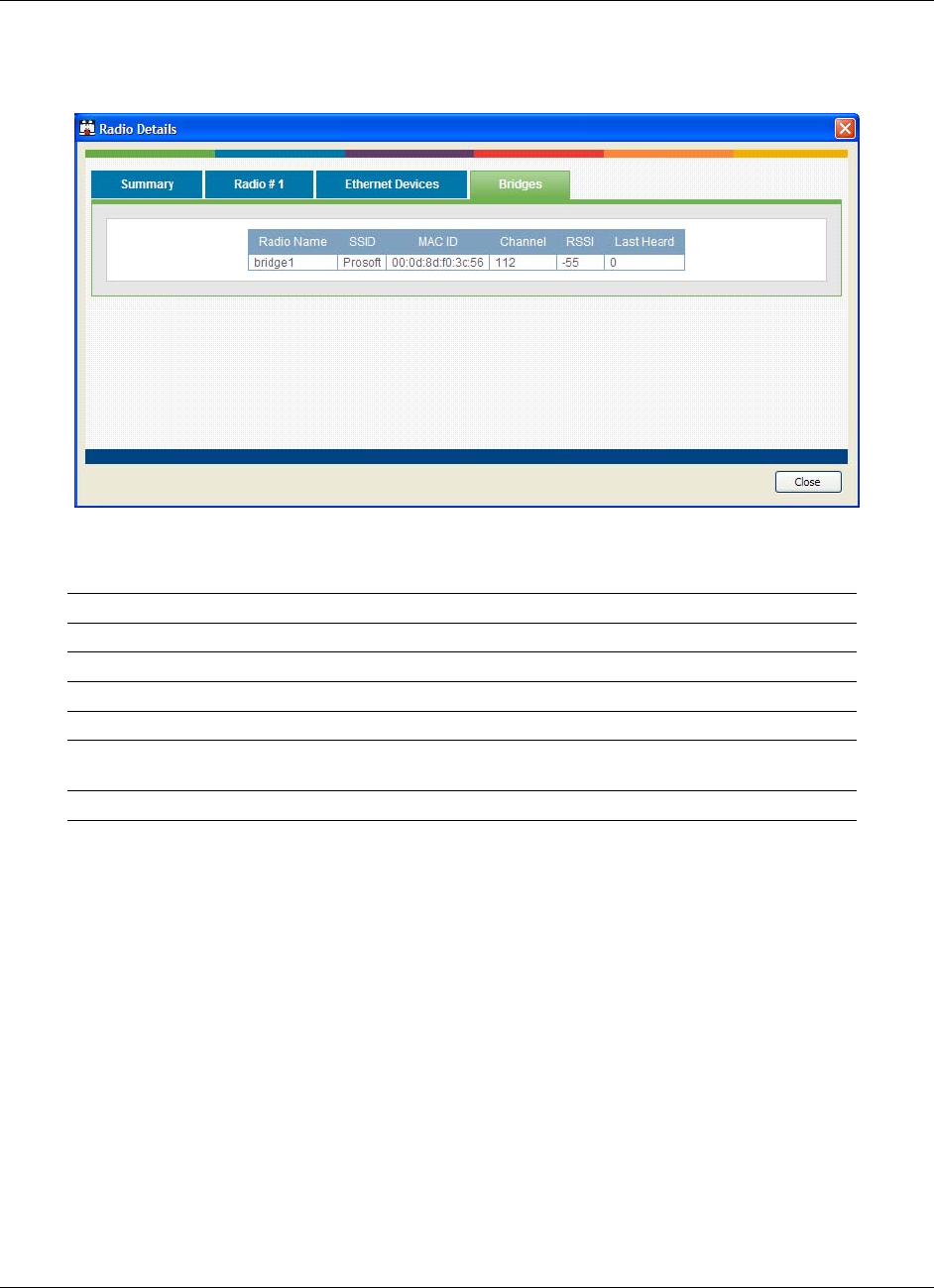
RLXIB-IHN ♦ 802.11n WirelessN Discovery Tool
Industrial Hotspot User Manual
ProSoft Technology, Inc. Page 127 of 171
May 23, 2011
5.10.4 Bridges
Bridges are other nodes that are associated to this device via a wireless link.
The following information is displayed:
Parameter Description
Radio Name The name of the associated bridge node
SSID The network over which this bridge node is accessible
MAC ID The bridge's MAC address.
Channel the broadcast channel used by the network
RSSI the received signal strength indicator (in dBm) of the parent; it is an
indicator of signal strength between this device and the bridge
Last Heard this is the time in seconds since this bridge was most recently heard.
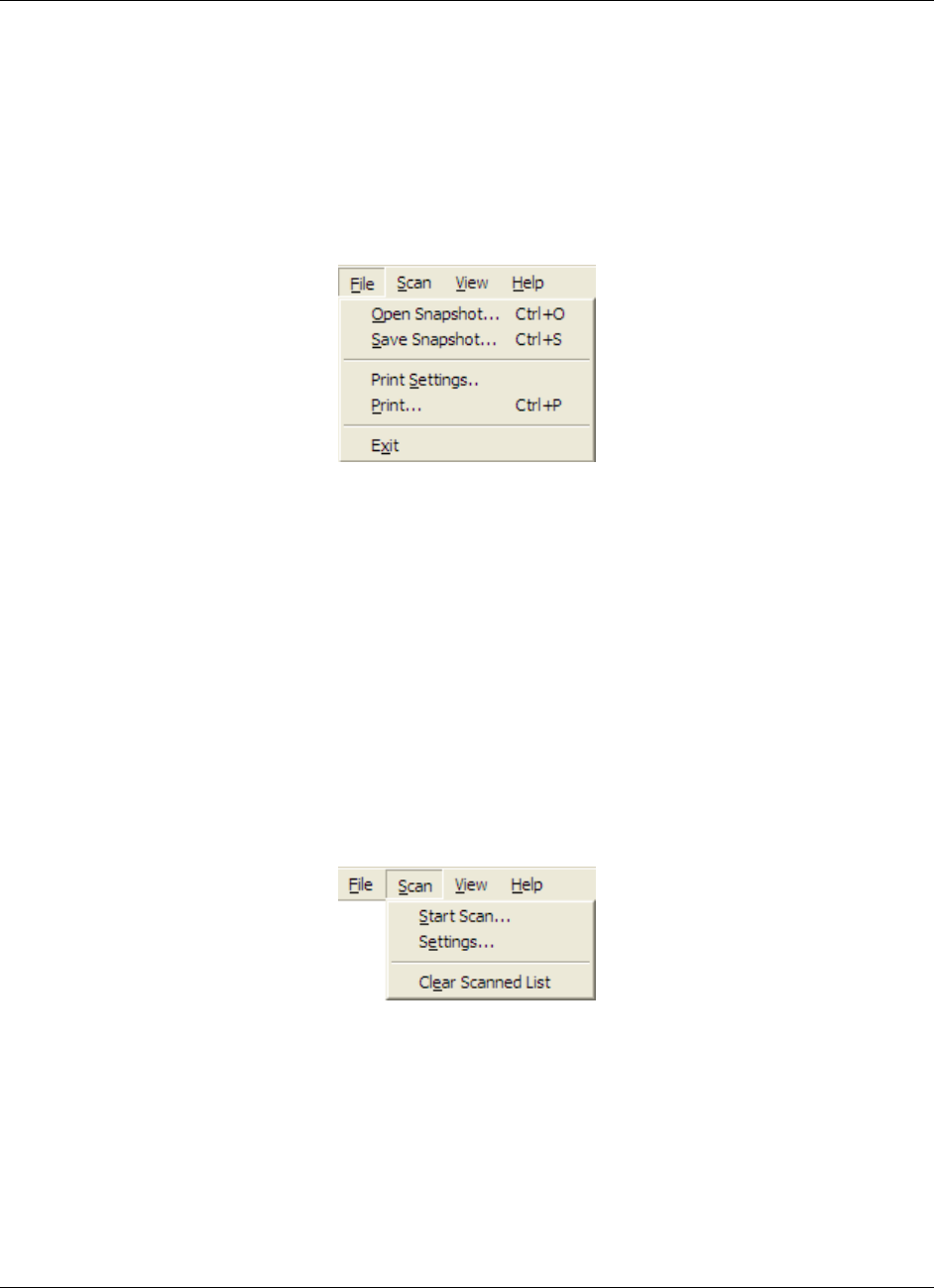
WirelessN Discovery Tool RLXIB-IHN ♦ 802.11n
User Manual Industrial Hotspot
Page 128 of 171 ProSoft Technology, Inc.
May 23, 2011
5.11 Discovery Tool Menus and Toolbars
5.11.1 File Menu
This menu allows you to capture details presented in this interactive
management tool for supported radios. While the radio details in your wireless
network are dynamic, you can save or print details of the detected radios, and
even import a previously saved snapshot file containing non-active Radios to
review radio and topology details.
With the Save Snapshot option, you can save a file to your host PC containing
details of the detected radios. This file can later be imported with the View
Snapshot option to view the details and topology.
The Print Settings command will open print settings dialog to allow you to select
printer and set printer settings. The Print command will print out the current view
(Radio List or Topology).
Choose Exit to close this Windows application and related processes.
5.11.2 Scan Menu
The scan menu allows you to configure and initiate detection of supported radios
within your host machine's network. These supported radios respond to probe
requests initiated from this utility, and the settings in this section allow you to
configure the frequency and protocol settings for these probe requests.
The Start Scan button will let you initiate a scan of your host's entire LAN and
WLAN, or can be configured to only send discovery probe messages with an IP
address range or over a specific network adaptor (in order to restrict the probe
messages to WiFi or Ethernet traffic). When starting a scan, you can choose to
clear earlier network information by enabling the option to Clear Devices
Discovered Earlier. Selecting this option will ensure that all radio details
displayed after the scan are always current.
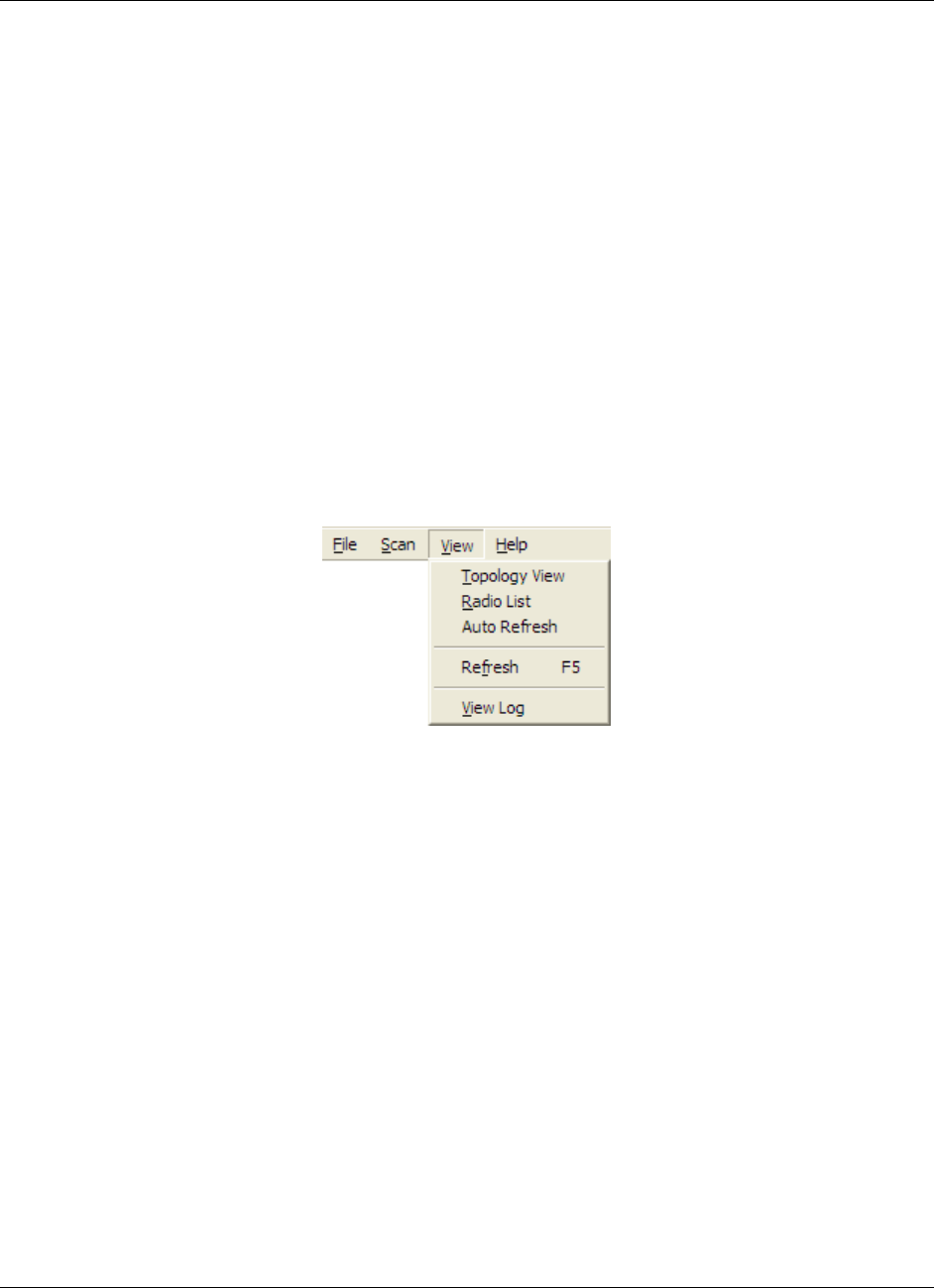
RLXIB-IHN ♦ 802.11n WirelessN Discovery Tool
Industrial Hotspot User Manual
ProSoft Technology, Inc. Page 129 of 171
May 23, 2011
The Settings menu allows you to manage the discovery protocol parameters. The
Broadcast IP Address is set to a default of 255.255.255.255, and this can be
modified to be more restrictive multicast address if required. The Broadcast Port
for protocol messages is the destination port for UDP packets from the device
network and uses port 802. The Source Port is used by the utility running on the
Windows host to send out UDP probe requests to the network and uses port
9092. The device is set to scan the network for radios every 60 seconds, and the
Scan Interval field can be modified to change this frequency. As well the regular
scan can be disabled altogether by deselecting the Periodically Scan for Radios
option.
To remove all detected radios from all views prior to scanning, choose the option
to Clear Scanned List. The view will not have radio information until the next scan
of the network.
5.11.3 View Menu
This menu allows you to navigate to the display options this management utility
has for showing supported radios and network information. Each view presents
radio and network information as well as related configuration options.
The Topology View displays a network diagram of supported devices detected by
the utility. The Master, Repeater, and Client relationships are presented visually
in a color coded and vertically aligned diagram with the Master radio(s) at the top
of the page. This view allows you to get a summary of the entire detected
network or select specific radios for further analysis.
The Radio List shows a table of detected radios in the network. This table allows
you to easily identify radios by role, MAC address and device name. If a
particular radio has parents or children in the network, they are identified by MAC
address, SSID and security for that wireless link. Double clicking on a radio in the
list will take you to the Detailed Radio view.
The current view (whether it be Topology, Radio List, or Detailed Radio) is
updated with new radio and network information as it arrives when Auto Refresh
is enabled. The scan menu contains the discovery protocol configuration
settings. As well, a manual refresh of the view is available by clicking on the
Refresh menu option or pressing F5.
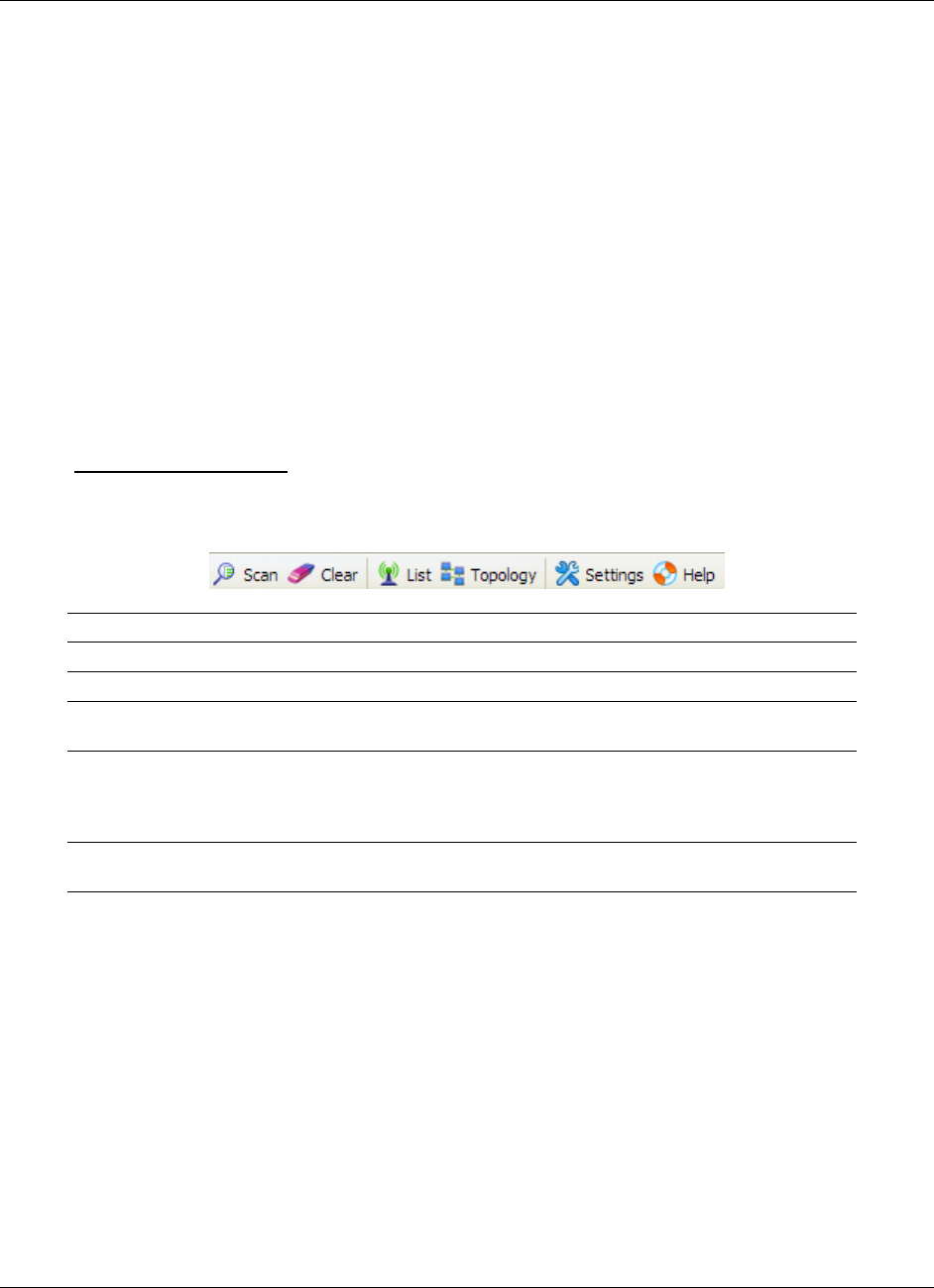
WirelessN Discovery Tool RLXIB-IHN ♦ 802.11n
User Manual Industrial Hotspot
Page 130 of 171 ProSoft Technology, Inc.
May 23, 2011
The View Log option will display the Discovery Event logs collected by this utility
during discovery and configuration operations. Each log entry will have a
timestamp and type setting. The very bottom of the screen allows you to quickly
access or the most recent or earliest set of log messages, and also change the
number of log messages displayed on the screen at any given time.
5.11.4 Help Menu
Most of the information needed to help you use the WirelessN Discovery Tool is
provided in an online help system that is always available whenever you are
running the application.
5.11.5 Toolbars
There are two quick link toolbars available immediately below the
file/scan/view/help menus.
Primary Level Toolbar
These links are available in all views and are not specific to a particular radio in
the network.
Button Description
Radios This button will link to the Radio List view
Topology This button will link to the Topology view
Scan Click this button to perform a scan and refresh based on preconfigured
scan settings
Settings This will open the Setting dialog box, where you can configure protocol-
specific parameters and also change the way a scan of the network is
preformed. This is the same dialog box that is accessed via the
Settings option in the Scan menu.
Help This button opens the help text content for the page you are currently
viewing.
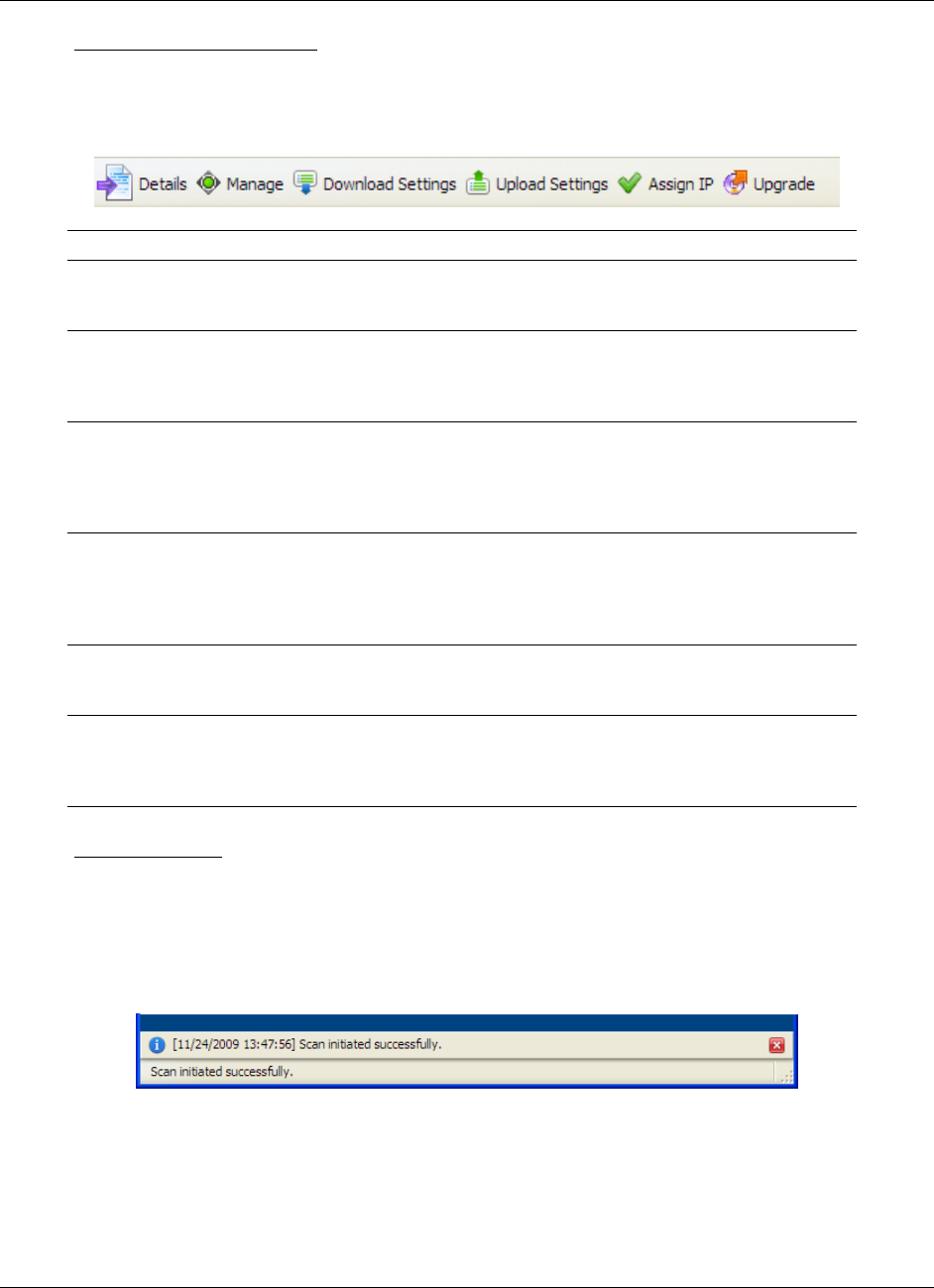
RLXIB-IHN ♦ 802.11n WirelessN Discovery Tool
Industrial Hotspot User Manual
ProSoft Technology, Inc. Page 131 of 171
May 23, 2011
Secondary Level Toolbar
These links are available when a radio is selected in any one of the available
views. Each button will let you access further details or perform operations on the
selected radio.
Button Description
Details This button will open a new dialog box containing the radio's details.
This page contains the same information as the Radio Detailed view
page.
Manage Clicking this button will launch the graphical management interface for
the selected radio using your default web browser. The IP address of
the device is used to access the supported radio's management
interface.
Download Settings this button will launch a dialog box that allows you to download the
radio's ASCII configuration file to your host. You must enter the radio's
username and password (same as the management interface
credentials) and also indicate the file name on your host to save the
downloaded file.
Upload Settings This button will launch a dialog box to upload a device configuration file
on your host to the radio. You must enter the radio's username and
password (same as the management interface credentials) and also
indicate the directory on your host where the configuration file to upload
is located.
Assign IP This button will open a dialog box to let you set a static IP for the radio.
You can define the static IP address, subnet mask, and gateway for the
radio via this interface.
Upgrade This button will launch a dialog box where you can upgrade the radio's
firmware. You must enter the radio's username and password (the
management interface access credentials) and then identify the
directory path and filename of the firmware to upgrade the radio.
Notification Bar
The status bar is located immediately below the main content screen. This bar is
displayed when a status message is present and these messages can highlight a
topology change, scan events, or other information gathered by the utility. Each
message has a timestamp, and if required the status bar can be closed with the
"x" icon on the right of the bar.

WirelessN Discovery Tool RLXIB-IHN ♦ 802.11n
User Manual Industrial Hotspot
Page 132 of 171 ProSoft Technology, Inc.
May 23, 2011

RLXIB-IHN ♦ 802.11n Reference
Industrial Hotspot User Manual
ProSoft Technology, Inc. Page 133 of 171
May 23, 2011
6 Reference
In This Chapter
Product Overview ................................................................................ 134
Radio hardware ................................................................................... 136
Antennas .............................................................................................138

Reference RLXIB-IHN ♦ 802.11n
User Manual Industrial Hotspot
Page 134 of 171 ProSoft Technology, Inc.
May 23, 2011
6.1 Product Overview
The RLXIB-IHN is an industrial high-speed Ethernet radio. You can use it in
place of Ethernet cables to save money, extend range, and make connections
that may not otherwise be feasible. The radio operates as a wireless Ethernet
switch, so any data that you can send over a wired network can also be sent over
the radio.
The RLXIB-IHN is certified for unlicensed operation in the United States, Canada
and Europe at 2.4 GHz and 5 GHz. With an output power of a 50mW (typical)
approved high-gain antennas, the radios can achieve distances of 5 miles line-of-
sight between them. You can use multiple repeaters to extend this range to far
greater distances.
You can develop a highly reliable wireless network by creating redundant
wireless paths. Multiple master radios can be installed without any special
programming or control. Repeater radios can connect to any master at any time;
if one master is unavailable, the repeater connects to another. Likewise, if a
repeater goes down, any repeater that was connected to it can reconnect to a
different repeater, keeping the network intact. You can create large, self-healing
tree-like networks in this fashion. Fully redundant paths are possible because the
Spanning Tree protocol in the radios disables and enables paths as necessary to
avoid Ethernet loops, which would otherwise make your network stop functioning.
In addition to acting as a switch, every master or repeater radio in an RLXIB-IHN
wireless network can simultaneously act as an 802.11n access point. This allows
802.11 Wi-Fi clients to connect and roam between radios for monitoring of the
wireless network or general network access. The RLXIB-IHN has a special client
mode (page 35) that allows connection of any Ethernet device to any existing
802.11n access point, regardless of the brand (An example of an 802.11 client is
a laptop with a WLAN card).
Note: Wi-Fi is a brand name originally issued by the Wi-Fi Alliance, used to describe the underlying
technology of wireless_local area networks (WLAN) based on the IEEE 802.11 specifications.
A high level of security is inherent with AES (Advanced Encryption Standard)
encryption. You also can choose TKIP (Temporal Key Integrity Protocol), and if
necessary add WEP128 or WEP64 (Wired Equivalent Protocol) encryption in
addition to AES or TKIP for clients that do not support AES. A simple Media
Access Control (MAC) filter table restricts the radios or clients that can link to a
selected radio according to the MAC IDs you enter in the table.
The radio is designed for industrial applications with a metal enclosure, DIN-rail
mounting, and shock and vibration tested to IEC 60068.

RLXIB-IHN ♦ 802.11n Reference
Industrial Hotspot User Manual
ProSoft Technology, Inc. Page 135 of 171
May 23, 2011
The RLXIB-IHN is easy to use. Use the RadioLinx Configuration Manager, which
runs in your web browser, to configure the radio; optionally, you can use an
SNMP manager for configuration. The radio comes with a Windows-based utility
called WirelessN Discovery Tool that finds all the radios on the network and lists
information about them. A topology view in the WirelessN Discovery Tool shows
how the wireless network is linked together at any point in time. You can update
firmware at any time from anywhere on the network, even over the wireless link
or over the Internet.
ProSoft Technology radios can easily be installed into new or existing systems.
The software and manuals can be downloaded from the CD or ProSoft
Technology’s web site at www.prosoft-technology.com.
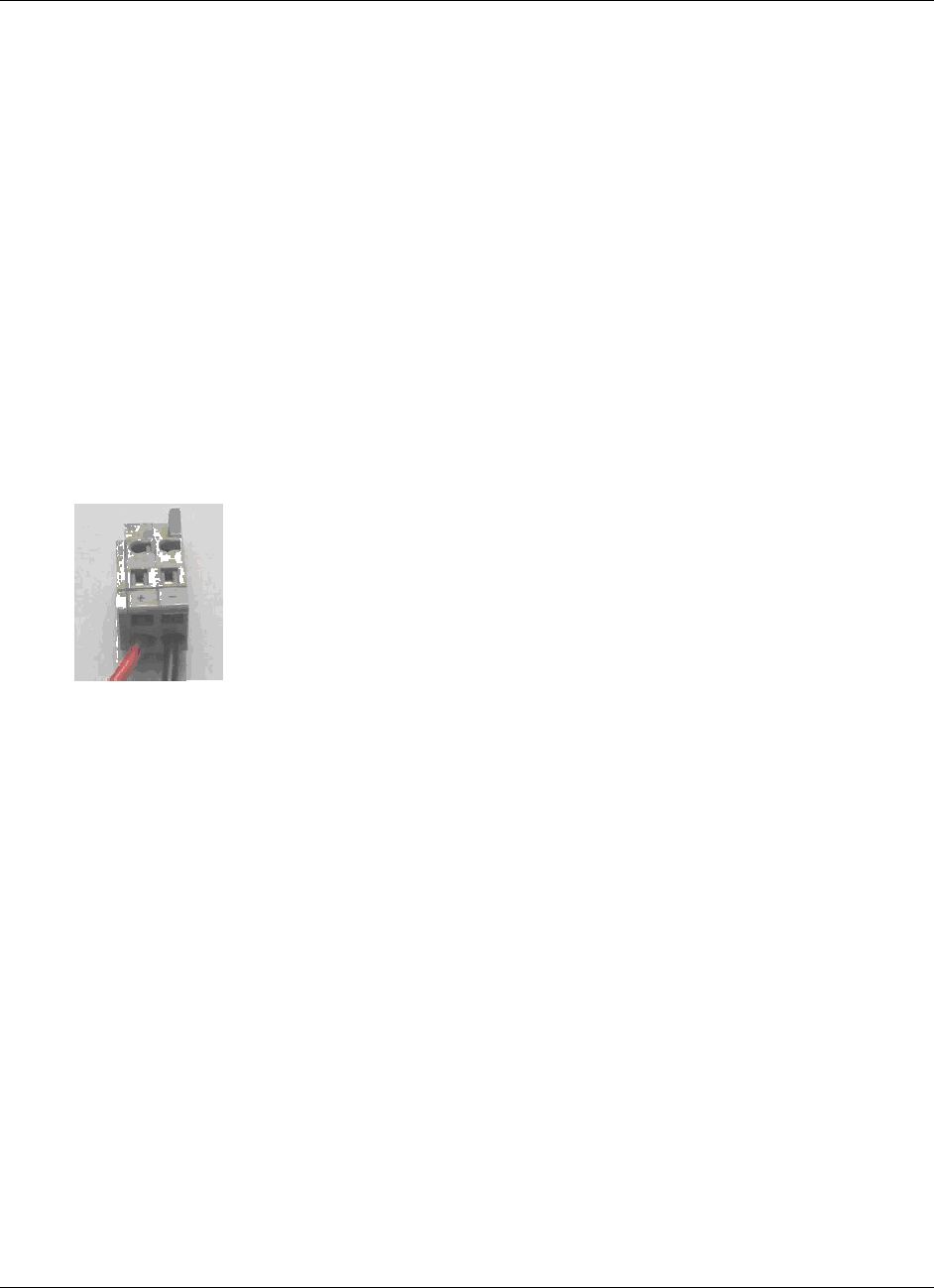
Reference RLXIB-IHN ♦ 802.11n
User Manual Industrial Hotspot
Page 136 of 171 ProSoft Technology, Inc.
May 23, 2011
6.2 Radio hardware
The RLXIB-IHN radio consists of the following components:
1 Three antenna ports (page 39)
2 LEDs (page 44) that indicate the status of the radio
3 Ethernet and serial cable ports (page 137, page 137)
4 Power connection
6.2.1 Radio Power Requirements
The RLXIB-IHN radio accepts voltages between 10 and 24 VDC, with an average
power draw of less than 9 watts. A detachable power connector comes with the
radio, as shown. The connector terminals are labeled + (positive DC connection)
and - (DC ground connection). You can use the provided AC-to-DC power supply
adapter that is pre-wired with a power connector, or you can use power from
another source, for example the power supply for the PLC or the networked
devices.
The DC power wires must be less than 3 m to meet regulatory requirements.
Label Connect to...
+ 10 to 24 VDC
— DC Ground
The RLXIB-IHN radio accepts 802.3af PoE, with an average power draw of less
than 9 watts. You can also order an optional DC PoE Injector if AC is not
available. The DC power wires must be less than 3 m to meet regulatory
requirements.
A solid ground connection should be verified using a meter prior to applying
power to the radio. Failing to secure a proper ground could result in serious injury
or death as a result of a lightning strike.
Using Power over Ethernet (PoE) to power remote devices has several
advantages including:
"Carrier Class" Power Over Ethernet System.
Power can be supplied over long distances, up to 300 feet.
Power can be available wherever network access is available.
The power supply can be centrally located where it can be attached to an
uninterruptible power supply.
The user has the ability to easily power on reset the attached equipment from
a remote location.
There is no need to run additional power cabling to the device as power can
be supplied over the CAT5 Ethernet cable.
Used for remote mounted radios to save on cost of coax and reduce RF
losses.
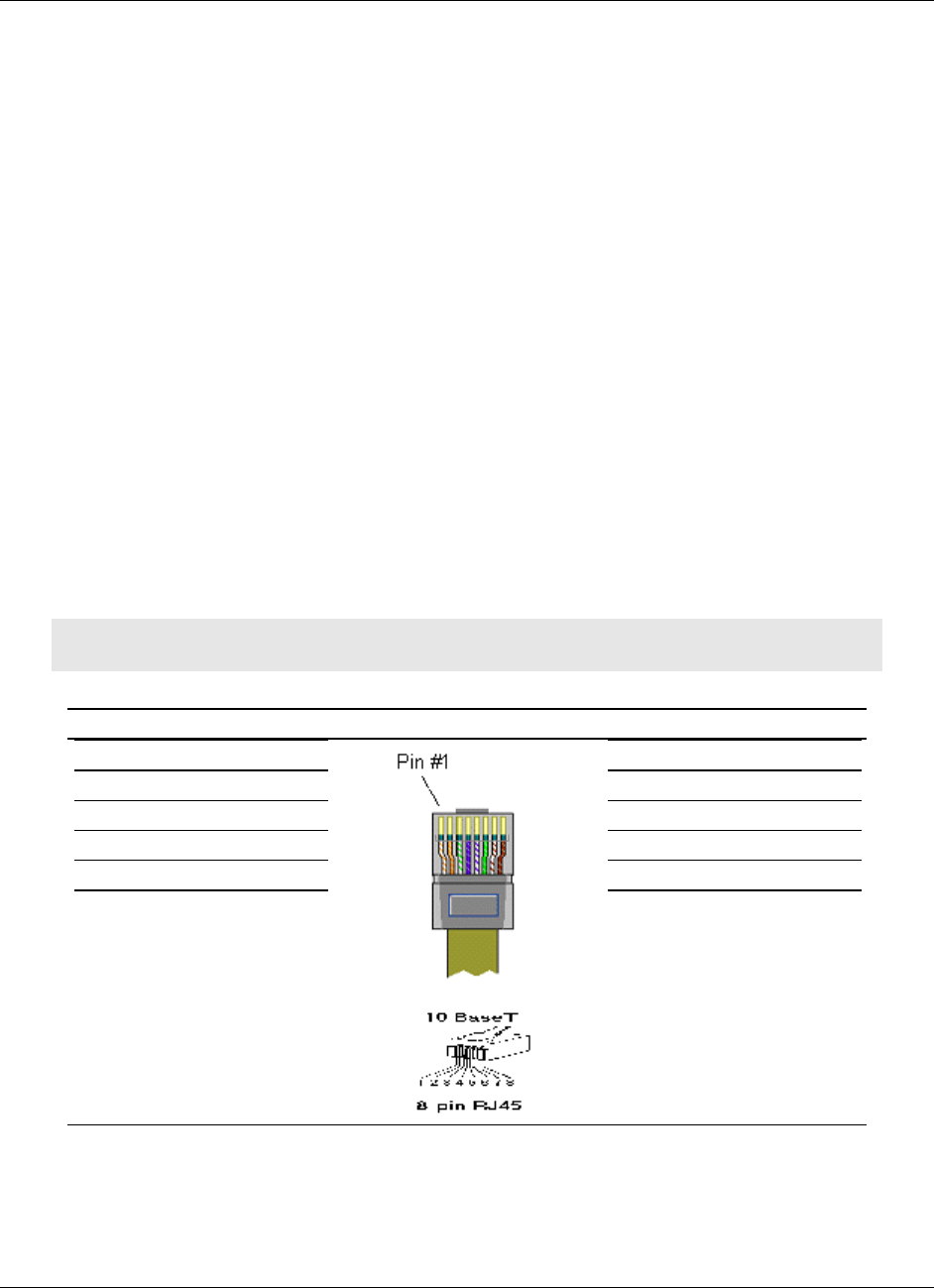
RLXIB-IHN ♦ 802.11n Reference
Industrial Hotspot User Manual
ProSoft Technology, Inc. Page 137 of 171
May 23, 2011
Built-in Ethernet Surge protection to prevent equipment damage.
Overload and Short Circuit protection.
6.2.2 Ethernet Cable Specifications
The recommended cable is Category 5 or better. A Category 5 cable has four
twisted pairs of wires, which are color-coded and cannot be swapped. The
module uses only two of the four pairs.
The Ethernet port on the module is Auto-Sensing. You can use either a standard
Ethernet straight-through cable or a crossover cable when connecting the
module to an Ethernet hub, a 10/100 Base-T Ethernet switch, or directly to a PC.
The module will detect the cable type and use the appropriate pins to send and
receive Ethernet signals.
Ethernet cabling is like U.S. telephone cables, except that it has eight
conductors. Some hubs have one input that can accept either a straight-through
or crossover cable, depending on a switch position. In this case, you must ensure
that the switch position and cable type agree.
Refer to Ethernet cable configuration (page 137) for a diagram of how to
configure Ethernet cable.
6.2.3 Ethernet Cable Configuration
Note: The standard connector view shown is color-coded for a straight-through cable.
Crossover cable Straight- through cable
RJ-45 PIN RJ-45 PIN
1 Rx+ 3 Tx+
2 Rx- 6 Tx-
3 Tx+ 1 Rx+
6 Tx- 2 Rx-
RJ-45 PIN RJ-45 PIN
1 Rx+ 1 Tx+
2 Rx- 2 Tx-
3 Tx+ 3 Rx+
6 Tx- 6 Rx-

Reference RLXIB-IHN ♦ 802.11n
User Manual Industrial Hotspot
Page 138 of 171 ProSoft Technology, Inc.
May 23, 2011
6.3 Antennas
When you are ready to connect antennas to the radio, see Connecting antennas
(page 39).
You must also consider three important electrical characteristics when selecting
antennas:
Antenna pattern (page 138)
Antenna gain (page 139)
Antenna polarity (page 139)
Antenna location, spacing, and mounting (page 143)
6.3.1 Antenna Pattern
Information between two wireless devices is transferred via electromagnetic
energy radiated by one antenna and received by another. The radiated power of
most antennas is not uniform in all directions and has varying intensities. The
radiated power in various directions is called the pattern of the antenna. Each
antenna should be mounted so that its direction of strongest radiation intensity
points toward the other antenna or antennas with which it will exchange signals.
Complete antenna patterns are three-dimensional, although often only a two-
dimensional slice of the pattern is shown when all the antennas of interest are
located in roughly the same horizontal plane, along the ground rather than above
or below one another.
A slice taken in a horizontal plane through the center (or looking down on the
pattern) is called the azimuth pattern. A view from the side reveals a vertical
plane slice called the elevation pattern.
An antenna pattern with equal or nearly equal intensity in all directions is
omnidirectional. In two dimensions, an omnidirectional pattern appears as a
circle (in three dimensions, an omnidirectional antenna pattern would be a
sphere, but no antenna has true omnidirectional pattern in three dimensions). An
antenna is considered omnidirectional if one of its two dimensional patterns,
either azimuth or elevation pattern, is omnidirectional.
Beamwidth is an angular measurement of how strongly the power is
concentrated in a particular direction. Beamwidth is a three dimensional quantity
but can be broken into two-dimensional slices just like the antenna pattern. The
beamwidth of an omnidirectional pattern is 360 degrees because the power is
equal in all directions.

RLXIB-IHN ♦ 802.11n Reference
Industrial Hotspot User Manual
ProSoft Technology, Inc. Page 139 of 171
May 23, 2011
6.3.2 Antenna Gain
Antenna gain is a measure of how strongly an antenna radiates in its direction of
maximum radiation intensity compared to how strong the radiation would be if the
same power were applied to an antenna that radiated all of its power equally in
all directions. Using the antenna pattern, the gain is the distance to the furthest
point on the pattern from the origin. For an omnidirectional pattern, the gain is 1,
or equivalently 0 dB. The higher the antenna gain is, the narrower the
beamwidth, and vice versa.
The amount of power received by the receiving antenna is proportional to the
transmitter power multiplied by the transmit antenna gain, multiplied by the
receiving antenna gain. Therefore, the antenna gains and transmitting power can
be traded off. For example, doubling one antenna gain has the same effect as
doubling the transmitting power. Doubling both antenna gains has the same
effect as quadrupling the transmitting power.
6.3.3 Antenna Polarity
Antenna polarization refers to the direction in which the electromagnetic field
lines point as energy radiates away from the antenna. In general, the polarization
is elliptical. The simplest and most common form of this elliptical polarization is a
straight line, or linear polarization. Of the transmitted power that reaches the
receiving antenna, only the portion that has the same polarization as the
receiving antenna polarization is actually received. For example, if the
transmitting antenna polarization is pointed in the vertical direction (vertical
polarization, for short), and the receiving antenna also has vertical polarization,
the maximum amount of power possible will be received. On the other hand, if
the transmit antenna has vertical polarization and the receiving antenna has
horizontal polarization, no power should be received. If the two antennas have
linear polarizations oriented at 45° to each other, half of the possible maximum
power will be received.
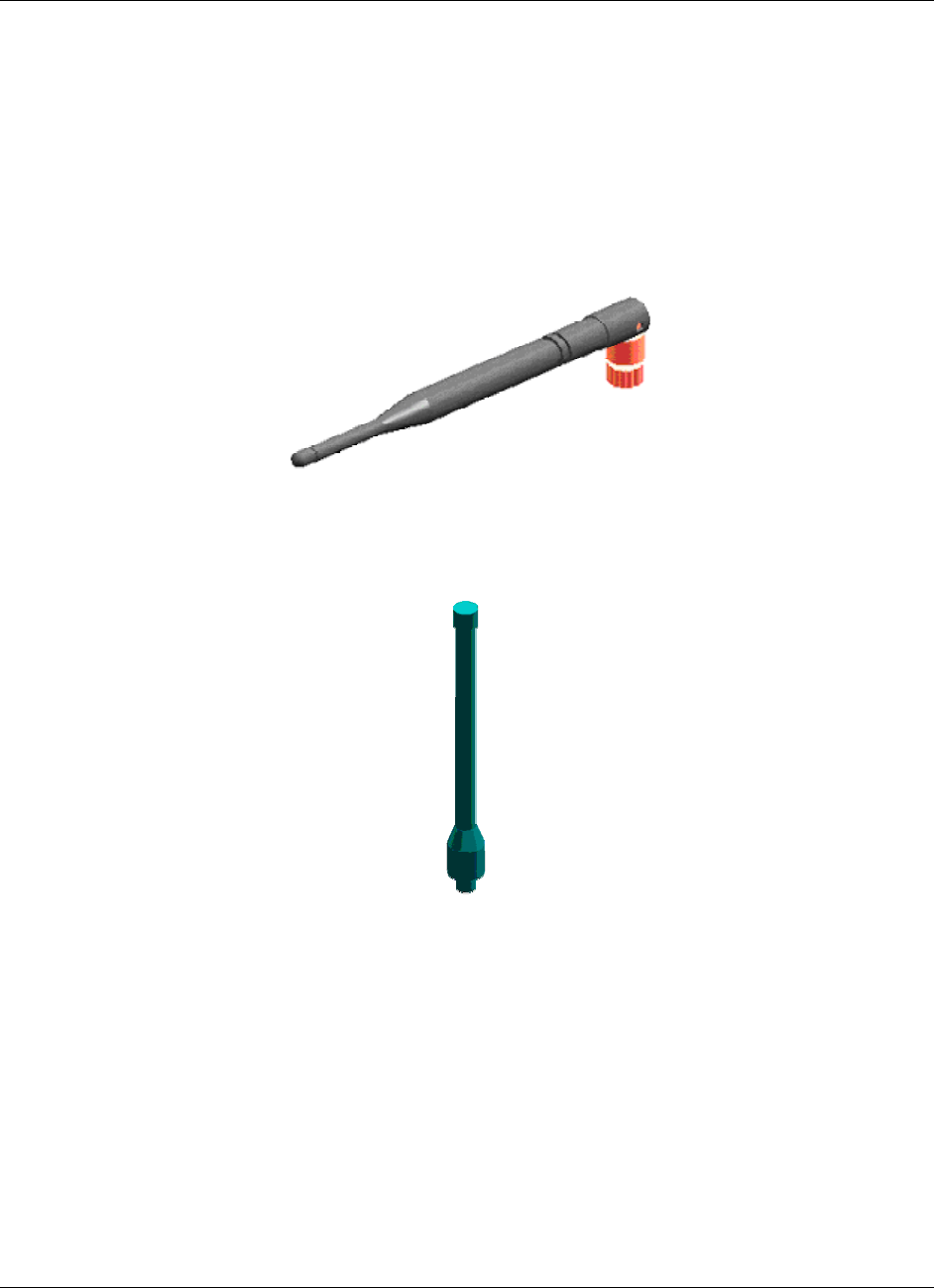
Reference RLXIB-IHN ♦ 802.11n
User Manual Industrial Hotspot
Page 140 of 171 ProSoft Technology, Inc.
May 23, 2011
6.3.4 Whip antennas
You can use a 1/2 wave straight whip or 1/2 wave articulating whip (2 dBi)
antenna with RLXIB-IHN radios. These antennas are the most common type in
use today. Such antennas are approximately 5 inches long, and are likely to be
connected to a client radio (connected directly to the radio enclosure). These
antennas do not require a ground plane. Articulating antennas and non-
articulating antennas work in the same way. An articulating antenna bends at the
connection.
6.3.5 Collinear array antennas
A collinear array antenna is typically composed of several linear antennas
stacked on top of each other. The more stacked elements it has, the longer it is,
and the more gain it has. It is fed in on one end.
The antenna pattern is torroidal. Its azimuthal beamwidth is 360°
(omnidirectional). Its vertical beamwidth depends on the number of
elements/length, where more elements equal narrower beamwidth. The antenna
gain also depends on the number of elements/length, where more elements
produce higher gain. Typical gain is 5 to 10 dBi.
The antenna polarity is linear, or parallel to the length of the antenna.

RLXIB-IHN ♦ 802.11n Reference
Industrial Hotspot User Manual
ProSoft Technology, Inc. Page 141 of 171
May 23, 2011
6.3.6 Yagi Array Antenna
A yagi antenna is composed of an array of linear elements, each parallel to one
another and attached perpendicular to and along the length of a metal boom. The
feed is attached to only one of the elements. Elements on one side of the fed
element are longer and act as reflectors; elements on the other side are shorter
and act as directors. This causes the antenna to radiate in a beam out of the end
with the shorter elements. The pattern depends on the overall geometry,
including the number of elements, element spacing, element length, and so on.
Sometimes the antenna is enclosed in a protective tube hiding the actual
antenna geometry.
The antenna pattern (page 138) is a beam pointed along the boom toward the
end with the shorter elements. The beamwidth varies with antenna geometry but
generally is proportional to the length (where longer length produces a narrower
beam).
The antenna gain (page 139) varies with antenna geometry but generally is
proportional to the length (where longer length produces higher gain). Typical
values are 6 to 15dBi.
The antenna polarity is Linear (parallel to the elements, perpendicular to the
boom).
Refer to the Antenna Types overview section for other types of approved
antennas.
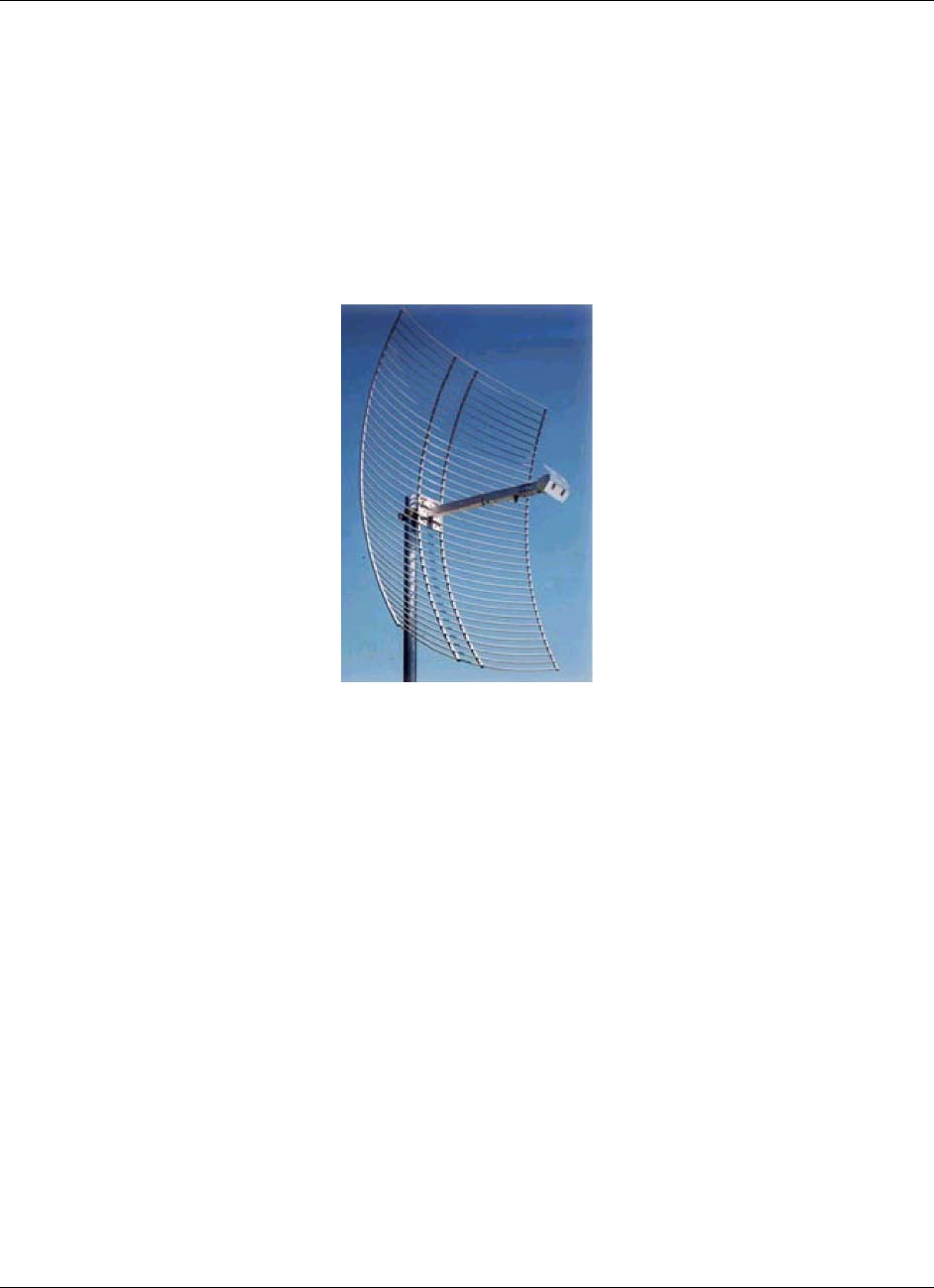
Reference RLXIB-IHN ♦ 802.11n
User Manual Industrial Hotspot
Page 142 of 171 ProSoft Technology, Inc.
May 23, 2011
6.3.7 Parabolic reflector antennas
A parabolic reflector antenna consists of a parabolic shaped dish and a feed
antenna located in front of the dish. Power is radiated from the feed antenna
toward the reflector. Due to the parabolic shape, the reflector concentrates the
radiation into a narrow pattern, resulting in a high- gain beam.
The antenna pattern is a beam pointed away from the concave side of the dish.
Beamwidth and antenna gain vary with the size of the reflector and the antenna
construction. Typical gain values are 15 to 30 dBi.
The antenna polarity depends on the feed antenna polarization.

RLXIB-IHN ♦ 802.11n Reference
Industrial Hotspot User Manual
ProSoft Technology, Inc. Page 143 of 171
May 23, 2011
6.3.8 Antenna location, spacing, and mounting
Consider the following points regarding antenna location, spacing, and mounting:
When placing antennas, ensure a clear line of sight between the master
radio's antenna and all of the other radio antennas.
If the site base contains obstructing terrain or structures, mount the antenna
on a tower or rooftop to provide a line-of-sight path. The line-of-sight
consideration becomes more important as the transmission path becomes
longer.
Mount the antennas as high off the ground as is practical. The higher an
antenna is above the ground, the greater its range.
Mount the antennas away from massive structures. Radio signals bounce off
metal walls, for example, which can compromise a clear signal.
Mount antennas to minimize the amount of nearby metal structures in the
antenna pattern.
Mount the antennas and install radios away from sources of RF interference.
Use the shortest possible antenna cable length. Signals lose power over the
cable's distance.
Choose antennas that are appropriate for the network's intended function.
If antennas are on radios on the same network, mount them so they have the
same polarity. If the antennas are on separate networks, mount them so they
have a different antenna polarity—for example, mount one antenna vertically
and the other horizontally.
Space radios at least three feet (one meter) apart so they do not overload
each other. If antennas must be near each other:
o Mount omnidirectional antennas directly above each other.
o Position directional antennas so they do not point at nearby antennas.
Place antennas side by side if they point in the same direction. Place
antennas back to back if they point in opposite directions.

Reference RLXIB-IHN ♦ 802.11n
User Manual Industrial Hotspot
Page 144 of 171 ProSoft Technology, Inc.
May 23, 2011

RLXIB-IHN ♦ 802.11n Support, Service & Warranty
Industrial Hotspot User Manual
ProSoft Technology, Inc. Page 145 of 171
May 23, 2011
7 Support, Service & Warranty
In This Chapter
Contacting Technical Support ............................................................. 145
Return Material Authorization (RMA) Policies and Conditions............. 147
LIMITED WARRANTY.........................................................................149
Contacting Technical Support
ProSoft Technology, Inc. (ProSoft) is committed to providing the most efficient
and effective support possible. Before calling, please gather the following
information to assist in expediting this process:
1 Product Version Number
2 System architecture
3 Network details
If the issue is hardware related, we will also need information regarding:
1 Module configuration and associated ladder files, if any
2 Module operation and any unusual behavior
3 Configuration/Debug status information
4 LED patterns
5 Details about the serial, Ethernet or fieldbus devices interfaced to the module,
if any.
Note: For technical support calls within the United States, an after-hours answering system allows
24-hour/7-days-a-week pager access to one of our qualified Technical and/or Application Support
Engineers.

Support, Service & Warranty RLXIB-IHN ♦ 802.11n
User Manual Industrial Hotspot
Page 146 of 171 ProSoft Technology, Inc.
May 23, 2011
Internet Web Site: www.prosoft-technology.com/support
E-mail address: support@prosoft-technology.com
Asia Pacific
(location in Malaysia)
Tel: +603.7724.2080, E-mail: asiapc@prosoft-technology.com
Languages spoken include: Chinese, English
Asia Pacific
(location in China)
Tel: +86.21.5187.7337 x888, E-mail: asiapc@prosoft-technology.com
Languages spoken include: Chinese, English
Europe
(location in Toulouse,
France)
Tel: +33 (0) 5.34.36.87.20,
E-mail: support.EMEA@prosoft-technology.com
Languages spoken include: French, English
Europe
(location in Dubai, UAE)
Tel: +971-4-214-6911,
E-mail: mea@prosoft-technology.com
Languages spoken include: English, Hindi
North America
(location in California)
Tel: +1.661.716.5100,
E-mail: support@prosoft-technology.com
Languages spoken include: English, Spanish
Latin America
(Oficina Regional)
Tel: +1-281-2989109,
E-Mail: latinam@prosoft-technology.com
Languages spoken include: Spanish, English
Latin America
(location in Puebla, Mexico)
Tel: +52-222-3-99-6565,
E-mail: soporte@prosoft-technology.com
Languages spoken include: Spanish
Brasil
(location in Sao Paulo)
Tel: +55-11-5083-3776,
E-mail: brasil@prosoft-technology.com
Languages spoken include: Portuguese, English

RLXIB-IHN ♦ 802.11n Support, Service & Warranty
Industrial Hotspot User Manual
ProSoft Technology, Inc. Page 147 of 171
May 23, 2011
7.1 Return Material Authorization (RMA) Policies and Conditions
The following Return Material Authorization (RMA) Policies and Conditions
(collectively, "RMA Policies") apply to any returned product. These RMA Policies
are subject to change by ProSoft Technology, Inc., without notice. For warranty
information, see Limited Warranty (page 149). In the event of any inconsistency
between the RMA Policies and the Warranty, the Warranty shall govern.
7.1.1 Returning Any Product
a) In order to return a Product for repair, exchange, or otherwise, the
Customer must obtain a Return Material Authorization (RMA) number
from ProSoft Technology and comply with ProSoft Technology shipping
instructions.
b) In the event that the Customer experiences a problem with the Product for
any reason, Customer should contact ProSoft Technical Support at one of
the telephone numbers listed above (page 145). A Technical Support
Engineer will request that you perform several tests in an attempt to
isolate the problem. If after completing these tests, the Product is found to
be the source of the problem, we will issue an RMA.
c) All returned Products must be shipped freight prepaid, in the original
shipping container or equivalent, to the location specified by ProSoft
Technology, and be accompanied by proof of purchase and receipt date.
The RMA number is to be prominently marked on the outside of the
shipping box. Customer agrees to insure the Product or assume the risk
of loss or damage in transit. Products shipped to ProSoft Technology
using a shipment method other than that specified by ProSoft Technology,
or shipped without an RMA number will be returned to the Customer,
freight collect. Contact ProSoft Technical Support for further information.
d) A 10% restocking fee applies to all warranty credit returns, whereby a
Customer has an application change, ordered too many, does not need,
etc. Returns for credit require that all accessory parts included in the
original box (i.e.; antennas, cables) be returned. Failure to return these
items will result in a deduction from the total credit due for each missing
item.

Support, Service & Warranty RLXIB-IHN ♦ 802.11n
User Manual Industrial Hotspot
Page 148 of 171 ProSoft Technology, Inc.
May 23, 2011
7.1.2 Returning Units Under Warranty
A Technical Support Engineer must approve the return of Product under ProSoft
Technology’s Warranty:
a) A replacement module will be shipped and invoiced. A purchase order will
be required.
b) Credit for a product under warranty will be issued upon receipt of
authorized product by ProSoft Technology at designated location
referenced on the Return Material Authorization
i. If a defect is found and is determined to be customer generated, or if
the defect is otherwise not covered by ProSoft Technology s warranty,
there will be no credit given. Customer will be contacted and can
request module be returned at their expense;
ii. If defect is customer generated and is repairable, customer can
authorize ProSoft Technology to repair the unit by providing a
purchase order for 30% of the current list price plus freight charges,
duties and taxes as applicable.
7.1.3 Returning Units Out of Warranty
a) Customer sends unit in for evaluation to location specified by ProSoft
Technology, freight prepaid.
b) If no defect is found, Customer will be charged the equivalent of $100
USD, plus freight charges, duties and taxes as applicable. A new
purchase order will be required.
c) If unit is repaired, charge to Customer will be 30% of current list price
(USD) plus freight charges, duties and taxes as applicable. A new
purchase order will be required or authorization to use the purchase order
submitted for evaluation fee.
The following is a list of non-repairable units:
o 3150 - All
o 3750
o 3600 - All
o 3700
o 3170 - All
o 3250
o 1560 - Can be repaired, only if defect is the power supply
o 1550 - Can be repaired, only if defect is the power supply
o 3350
o 3300
o 1500 - All

RLXIB-IHN ♦ 802.11n Support, Service & Warranty
Industrial Hotspot User Manual
ProSoft Technology, Inc. Page 149 of 171
May 23, 2011
7.2 LIMITED WARRANTY
This Limited Warranty ("Warranty") governs all sales of hardware, software, and
other products (collectively, "Product") manufactured and/or offered for sale by
ProSoft Technology, Incorporated (ProSoft), and all related services provided by
ProSoft, including maintenance, repair, warranty exchange, and service
programs (collectively, "Services"). By purchasing or using the Product or
Services, the individual or entity purchasing or using the Product or Services
("Customer") agrees to all of the terms and provisions (collectively, the "Terms")
of this Limited Warranty. All sales of software or other intellectual property are, in
addition, subject to any license agreement accompanying such software or other
intellectual property.
7.2.1 What Is Covered By This Warranty
a) Warranty On New Products: ProSoft warrants, to the original purchaser,
that the Product that is the subject of the sale will (1) conform to and
perform in accordance with published specifications prepared, approved
and issued by ProSoft, and (2) will be free from defects in material or
workmanship; provided these warranties only cover Product that is sold as
new. This Warranty expires three (3) years from the date of shipment for
Product purchased on or after January 1st, 2008, or one (1) year from the
date of shipment for Product purchased before January 1st, 2008 (the
"Warranty Period"). If the Customer discovers within the Warranty Period
a failure of the Product to conform to specifications, or a defect in material
or workmanship of the Product, the Customer must promptly notify
ProSoft by fax, email or telephone. In no event may that notification be
received by ProSoft later than 39 months from date of original shipment.
Within a reasonable time after notification, ProSoft will correct any failure
of the Product to conform to specifications or any defect in material or
workmanship of the Product, with either new or remanufactured
replacement parts. ProSoft reserves the right, and at its sole discretion,
may replace unrepairable units with new or remanufactured equipment.
All replacement units will be covered under warranty for the 3 year period
commencing from the date of original equipment purchase, not the date of
shipment of the replacement unit. Such repair, including both parts and
labor, will be performed at ProSoft’s expense. All warranty service will be
performed at service centers designated by ProSoft.
b) Warranty On Services: Materials and labor performed by ProSoft to repair
a verified malfunction or defect are warranteed in the terms specified
above for new Product, provided said warranty will be for the period
remaining on the original new equipment warranty or, if the original
warranty is no longer in effect, for a period of 90 days from the date of
repair.

Support, Service & Warranty RLXIB-IHN ♦ 802.11n
User Manual Industrial Hotspot
Page 150 of 171 ProSoft Technology, Inc.
May 23, 2011
7.2.2 What Is Not Covered By This Warranty
a) ProSoft makes no representation or warranty, expressed or implied, that
the operation of software purchased from ProSoft will be uninterrupted or
error free or that the functions contained in the software will meet or
satisfy the purchaser’s intended use or requirements; the Customer
assumes complete responsibility for decisions made or actions taken
based on information obtained using ProSoft software.
b) This Warranty does not cover the failure of the Product to perform
specified functions, or any other non-conformance, defects, losses or
damages caused by or attributable to any of the following: (i) shipping; (ii)
improper installation or other failure of Customer to adhere to ProSoft’s
specifications or instructions; (iii) unauthorized repair or maintenance; (iv)
attachments, equipment, options, parts, software, or user-created
programming (including, but not limited to, programs developed with any
IEC 61131-3, "C" or any variant of "C" programming languages) not
furnished by ProSoft; (v) use of the Product for purposes other than those
for which it was designed; (vi) any other abuse, misapplication, neglect or
misuse by the Customer; (vii) accident, improper testing or causes
external to the Product such as, but not limited to, exposure to extremes
of temperature or humidity, power failure or power surges; or (viii)
disasters such as fire, flood, earthquake, wind and lightning.
c) The information in this Agreement is subject to change without notice.
ProSoft shall not be liable for technical or editorial errors or omissions
made herein; nor for incidental or consequential damages resulting from
the furnishing, performance or use of this material. The user guide
included with your original product purchase from ProSoft contains
information protected by copyright. No part of the guide may be duplicated
or reproduced in any form without prior written consent from ProSoft.
7.2.3 Disclaimer Regarding High Risk Activities
Product manufactured or supplied by ProSoft is not fault tolerant and is not
designed, manufactured or intended for use in hazardous environments requiring
fail-safe performance including and without limitation: the operation of nuclear
facilities, aircraft navigation of communication systems, air traffic control, direct
life support machines or weapons systems in which the failure of the product
could lead directly or indirectly to death, personal injury or severe physical or
environmental damage (collectively, "high risk activities"). ProSoft specifically
disclaims any express or implied warranty of fitness for high risk activities.

RLXIB-IHN ♦ 802.11n Support, Service & Warranty
Industrial Hotspot User Manual
ProSoft Technology, Inc. Page 151 of 171
May 23, 2011
7.2.4 Intellectual Property Indemnity
Buyer shall indemnify and hold harmless ProSoft and its employees from and
against all liabilities, losses, claims, costs and expenses (including attorney’s
fees and expenses) related to any claim, investigation, litigation or proceeding
(whether or not ProSoft is a party) which arises or is alleged to arise from Buyer’s
acts or omissions under these Terms or in any way with respect to the Products.
Without limiting the foregoing, Buyer (at its own expense) shall indemnify and
hold harmless ProSoft and defend or settle any action brought against such
Companies to the extent based on a claim that any Product made to Buyer
specifications infringed intellectual property rights of another party. ProSoft
makes no warranty that the product is or will be delivered free of any person’s
claiming of patent, trademark, or similar infringement. The Buyer assumes all
risks (including the risk of suit) that the product or any use of the product will
infringe existing or subsequently issued patents, trademarks, or copyrights.
a) Any documentation included with Product purchased from ProSoft is
protected by copyright and may not be duplicated or reproduced in any
form without prior written consent from ProSoft.
b) ProSoft’s technical specifications and documentation that are included
with the Product are subject to editing and modification without notice.
c) Transfer of title shall not operate to convey to Customer any right to make,
or have made, any Product supplied by ProSoft.
d) Customer is granted no right or license to use any software or other
intellectual property in any manner or for any purpose not expressly
permitted by any license agreement accompanying such software or other
intellectual property.
e) Customer agrees that it shall not, and shall not authorize others to, copy
software provided by ProSoft (except as expressly permitted in any
license agreement accompanying such software); transfer software to a
third party separately from the Product; modify, alter, translate, decode,
decompile, disassemble, reverse-engineer or otherwise attempt to derive
the source code of the software or create derivative works based on the
software; export the software or underlying technology in contravention of
applicable US and international export laws and regulations; or use the
software other than as authorized in connection with use of Product.
f) Additional Restrictions Relating To Software And Other Intellectual
Property
In addition to compliance with the Terms of this Warranty, Customers
purchasing software or other intellectual property shall comply with any
license agreement accompanying such software or other intellectual
property. Failure to do so may void this Warranty with respect to such
software and/or other intellectual property.
7.2.5 Disclaimer of all Other Warranties
The Warranty set forth in What Is Covered By This Warranty (page 149) are in
lieu of all other warranties, express or implied, including but not limited to the
implied warranties of merchantability and fitness for a particular purpose.

Support, Service & Warranty RLXIB-IHN ♦ 802.11n
User Manual Industrial Hotspot
Page 152 of 171 ProSoft Technology, Inc.
May 23, 2011
7.2.6 Limitation of Remedies **
In no event will ProSoft or its Dealer be liable for any special, incidental or
consequential damages based on breach of warranty, breach of contract,
negligence, strict tort or any other legal theory. Damages that ProSoft or its
Dealer will not be responsible for include, but are not limited to: Loss of profits;
loss of savings or revenue; loss of use of the product or any associated
equipment; loss of data; cost of capital; cost of any substitute equipment,
facilities, or services; downtime; the claims of third parties including, customers of
the Purchaser; and, injury to property.
** Some areas do not allow time limitations on an implied warranty, or allow the exclusion or
limitation of incidental or consequential damages. In such areas, the above limitations may not
apply. This Warranty gives you specific legal rights, and you may also have other rights which vary
from place to place.
7.2.7 Time Limit for Bringing Suit
Any action for breach of warranty must be commenced within 39 months
following shipment of the Product.
7.2.8 No Other Warranties
Unless modified in writing and signed by both parties, this Warranty is
understood to be the complete and exclusive agreement between the parties,
suspending all oral or written prior agreements and all other communications
between the parties relating to the subject matter of this Warranty, including
statements made by salesperson. No employee of ProSoft or any other party is
authorized to make any warranty in addition to those made in this Warranty. The
Customer is warned, therefore, to check this Warranty carefully to see that it
correctly reflects those terms that are important to the Customer.
7.2.9 Allocation of Risks
This Warranty allocates the risk of product failure between ProSoft and the
Customer. This allocation is recognized by both parties and is reflected in the
price of the goods. The Customer acknowledges that it has read this Warranty,
understands it, and is bound by its Terms.

RLXIB-IHN ♦ 802.11n Support, Service & Warranty
Industrial Hotspot User Manual
ProSoft Technology, Inc. Page 153 of 171
May 23, 2011
7.2.10 Controlling Law and Severability
This Warranty shall be governed by and construed in accordance with the laws of
the United States and the domestic laws of the State of California, without
reference to its conflicts of law provisions. If for any reason a court of competent
jurisdiction finds any provisions of this Warranty, or a portion thereof, to be
unenforceable, that provision shall be enforced to the maximum extent
permissible and the remainder of this Warranty shall remain in full force and
effect. Any cause of action with respect to the Product or Services must be
instituted in a court of competent jurisdiction in the State of California.

Support, Service & Warranty RLXIB-IHN ♦ 802.11n
User Manual Industrial Hotspot
Page 154 of 171 ProSoft Technology, Inc.
May 23, 2011

RLXIB-IHN ♦ 802.11n Glossary of Terms
Industrial Hotspot User Manual
ProSoft Technology, Inc. Page 155 of 171
May 23, 2011
Glossary of Terms
Symbols & Numeric
802.11
A group of wireless specifications developed by the IEEE. It details a wireless
interface between devices to manage packet traffic.
802.11a
Operates in the 5 GHz frequency range with a maximum 54 Mbit/sec signaling
rate.
802.11b
Operates in the 2.4 GHz Industrial, Scientific, and Measurement (ISM) band.
Provides signaling rates of up to 11 Mbit/sec and is the most commonly used
frequency.
802.11g
Similar to 802.11b but supports signaling rates of up to 54 Mbit/sec. Operates in
the heavily used 2.4 GHz ISM band but uses a different radio technology to boost
throughput.
802.11i
Sometimes Wi-Fi Protected Access 2 (WPA 2). WPA 2 supports the 128-bit and
above advanced encryption Standard, along with 802.1x authentication and key
management features.
802.11n
Designed to raise effective WLAN throughput to more than 100 Mbit/sec.
802.11s
Deals with mesh networking.
A
Access Point
A generic term for an 802.11 radio that "attaches" other 802.11 radios (clients) to
a wired network. APs can also bridge to one another.
ACL
An access control list (ACL) is a list of permissions attached to an object. An ACL
specifies which users, or system processes, are granted access to objects, as
well as what operations are allowed to be performed on given objects.
Ad hoc Mode
Wireless network framework in which devices can communicate directly with one
another without using an AP or a connection to a regular network.

Glossary of Terms RLXIB-IHN ♦ 802.11n
User Manual Industrial Hotspot
Page 156 of 171 ProSoft Technology, Inc.
May 23, 2011
AES
Advanced Encryption Standard. New standard for encryption adopted by the U.S.
government for secure communications.
Amplifier
A device connected to an antenna used to increase the signal strength and
amplify weak incoming signals.
AMSDU
Aggregation of MAC Service Data Units (A-MSDU) collects Ethernet frames to be
transmitted to a single destination, and wraps them in a single 802.11n frame,
thus increasing the user level data rate.
Antenna
A device connected to a wireless transceiver that concentrates transmitted and
received radio waves to increase signal strength and thus the effective range of a
wireless network.
ASCII
American Standard Code for Information Interchange. A communication mode in
which each eight-bit byte in a message contains one ASCII character code.
ASCII characters (or hexadecimal characters) are sometimes used as a key to
encrypt data and ensure its secure transmission.
Association
Process whereby two 802.11 radios establish communications with each other.
Requirements for communication include common SSID (network names) and
encryption settings.
Authenticate
The process of confirming the identity of someone connecting to a network.
Authentication Server
A back-end database server that confirms the identity of a supplicant to an
authenticator in an 802.1x-authenticated network.
B
Band
Another term for spectrum used to indicate a particular set of frequencies.
Wireless networking protocols work in either the 2.4 GHz or the 5 GHz bands.
Bandwidth
(See Throughput)
Base Station
See Wireless Gateway

RLXIB-IHN ♦ 802.11n Glossary of Terms
Industrial Hotspot User Manual
ProSoft Technology, Inc. Page 157 of 171
May 23, 2011
Baud Rate
The speed of communication between devices on the network. All devices must
communicate at the same rate.
bps
Bits per Second. A measure of data transmission speed across a network or
communications channel; bps is the number of bits that can be sent or received
per second.
C
Channel
One portion of the available radio spectrum that all devices on a wireless network
use to communicate. Changing the channel on the access point/router can help
reduce interference.
Client
A client is a software program, or the device on which that program runs, that
makes requests for information from a software program, or the device on which
that program runs, in a client-server relationship.
A Client on an Ethernet network is equivalent to a Master on a serial network.
Configuration PC
A Computer that contains the configuration tools for the RLXIB-IHN.
D
dBi
Decibels referenced to an "ideal" isotropic radiator in free space; frequently used
to express antenna gain
dBm
Decibels referenced to one milliwatt (mW); an "absolute" unit used to measure
signal power (transmit power output or received signal strength)
DCE
Data communications equipment. A modem, for example.
Decibel (dB)
A measure of the ratio between two signal levels; used to express gain (or loss)
in a system.
Default Gateway
The IP address of a network router where data is sent if the destination IP
address is outside the local subnet. The gateway is the device that routes the
traffic from the local area network to other networks such as the Internet.

Glossary of Terms RLXIB-IHN ♦ 802.11n
User Manual Industrial Hotspot
Page 158 of 171 ProSoft Technology, Inc.
May 23, 2011
Device-to-Device Network (Peer-to-Peer Network)
Two or more devices that connect using wireless network devices without the
use of a centralized wireless access point. Also known as a peer-to-peer
network.
DHCP
The dynamic host configuration protocol is an Internet protocol, similar to BootP,
for automating the configuration of computers that use TCP/IP. DHCP can be
used to automatically assign IP addresses, to deliver IP stack configuration
parameters, such as the subnet mask and default router, and to provide other
configuration information, such as the addresses for printer, time, and news
servers.
Direct Sequence Spread Spectrum
One of two approaches (with frequency hopping spread spectrum) for sorting out
overlapping data signals transmitted via radio waves. 802.11b uses DSSS
Directional Antenna
Transmits and receives radio waves off the front of the antenna.
Diversity Antenna
An antenna system that uses multiple antennas to reduce interference and
maximize reception and transmission quality.
DTE
Data Terminal Equipment, for example, a computer or terminal.
Dual Band
A device that is capable of operating in two frequencies. On a wireless network,
dual-band devices are capable of operating in both the 2.4 GHz (802.11b/g) and
5 GHz (802.11a) bands.
E
EAP
Extensible Authentication Protocol. A protocol that provides an authentication
framework for both wireless and wired Ethernet enterprise networks.
EIRP
Equivalent isotropically radiated power (EIRP) is the amount of power that would
have to be emitted by an isotropic antenna (that evenly distributes power in all
directions and is a theoretical construct) to produce the peak power density
observed in the direction of maximum antenna gain.
Encryption
Method of scrambling data so that only the intended viewers can decipher and
understand it.

RLXIB-IHN ♦ 802.11n Glossary of Terms
Industrial Hotspot User Manual
ProSoft Technology, Inc. Page 159 of 171
May 23, 2011
ESD
Electrostatic Discharge. Can cause internal circuit damage to the coprocessor.
ESSID
Extended Service Set Identifier. A name used to identify a wireless network.
F
Firmware
Firmware is the embedded software code that that runs in the module to direct
module function (similar to the BIOS in a personal computer). This is
distinguished from the Setup/Diagnostic Application software that is installed on
the Configuration PC.
Frequency Hopping
A radio that rapidly changes its operating frequency several times per second
following a pre-determined sequence of frequencies. The transmitting and
receiving radios are programmed to follow the same frequency hopping
sequence.
Frequency Hopping Spread Spectrum
Changes or hops frequencies in pattern known to both sender and receiver.
FHSS is little influenced by radio stations, reflections, or other environmental
factors. However, it is much slower than DSSS.
Fresnel Zone
An elliptical area on either side of the straight line of sight that must also be clear
for a long-range wireless network to work.
Full-Duplex
A communications circuit or system designed to simultaneously transmit and
receive two different streams of data. Telephones are an example of a full-duplex
communication system. Both parties on a telephone conversation can talk and
listen at the same time. If both talk at the same time, their two signals are not
corrupted.
G
Gain
The amount by which an antenna concentrates signal strength in a wireless
network.
Gateway
In wireless terms, a gateway is an access point with additional software
capabilities such as providing NAT and DHCP.

Glossary of Terms RLXIB-IHN ♦ 802.11n
User Manual Industrial Hotspot
Page 160 of 171 ProSoft Technology, Inc.
May 23, 2011
H
Half-Duplex
A communications circuit or system designed to transmit and receive data, but
not both simultaneously. CB or walkie-talkie radios are an example of a half-
duplex communication system. Either parties on a radio conversation may talk or
listen; but both cannot talk at the same time without corrupting each other's
signal. If one operator is "talking", the other must be "listening" to have
successful communication.
Hysteresis
A property of a system such that an output value is not a strict function of the
corresponding input, but also incorporates some lag, delay, or history
dependence, and in particular when the response for a decrease in the input
variable is different from the response for an increase.
Hz
Hertz. The international unit for measuring frequency equivalent to the older unit
of cycles per second. One megahertz (MHz) is one million hertz. One gigahertz
(GHz) is one billion hertz. The standard US electrical power frequency is 60 Hz.
802.11a devices operate in the 5 GHz band; 802.11b and g devices operate in
the 2.4 GHz band.
I
IEEE
Institute of Electrical and Electronics Engineers, Inc. IEEE is a professional
organization with members in over 175 countries and is an authority in technical
areas such as computer engineering and telecommunications. IEEE developed
the 802.11 specifications.
IP Address
A 32-bit identification number for each node on an Internet Protocol network.
These addresses are represented as four sets of 8-bit numbers (numbers from 0
to 255), separated by periods ("dots").
Networks using the TCP/IP Protocol route messages based on the IP address of
the destination. Each number can be 0 to 255. For example, 192.168.0.100 could
be an IP address. Each node on the network must have a unique IP address.
IPv6
Internet Protocol version 6 (IPv6) is an update to the Internet Protocol
specification, and is designated as the successor to IPv4, the implementation
most commonly used today. The benefits of IPv6 include support for a 128-bit
address, simplified address assignment, and improved network security.

RLXIB-IHN ♦ 802.11n Glossary of Terms
Industrial Hotspot User Manual
ProSoft Technology, Inc. Page 161 of 171
May 23, 2011
K
Key
A set of information (often 40 to as much as 256 bits) that is used as a seed to an
encryption algorithm to encrypt (scramble) data. Ideally, the key must also be
known by the receiver to decrypt the data.
L
LAN
A system of connecting PCs and other devices within the same physical
proximity for sharing resources such as internet connections, printers, files, and
drives. When Wi-Fi is used to connect the devices, the system is known as a
wireless LAN or WLAN.
LED
Light-emitting diode.
Line of Sight (LoS)
A clear line from one antenna to another in a long-range wireless network.
Link point
The graphical point next to a radio icon that represents the connection point for
RF communications between radios. An RF connection between two radios is
called an RF Link and is represented as a graphical black line between the
radio’s link points.
M
MAC ID
Media Access Control address. Every 802.11 device has its own MAC address.
This is a unique identifier used to provide security for wireless networks. When a
network uses a MAC table, only the 802.11 radios that have had their MAC
addresses added to the network’s MAC table are able to get on the network.
Master device
Device that is connected to the Master radio.
Mbps
Megabits per second, or millions of bits per second. A measure of bandwidth.
Megahertz
A measure of electromagnetic wave frequency equal to one million hertz. Often
abbreviated as MHz and used to specify the radio frequency used by wireless
devices.

Glossary of Terms RLXIB-IHN ♦ 802.11n
User Manual Industrial Hotspot
Page 162 of 171 ProSoft Technology, Inc.
May 23, 2011
Mesh Networking
Features free standing, non wired network nodes that communicate among one
another and form self-configuring networks, with only one node required to hook
into a wired LAN. The other nodes are simply plugged into an electrical outlet, so
cabling is much less of an issue.
MIC
Message Integrity Check. One of the elements added to the TKIP standard. A
"signature" is added by each radio on each packet it transmits. The signature is
based on the data in the packet, a 64-bit value (key) and the MAC address of the
sender. The MIC allows the receiving radio to verify (check) that the data is not
forged.
MIMO
Multiple Input Multiple Output refers to using multiple antennas in a Wi-Fi device
to improve performance and throughput. MIMO technology takes advantage of a
characteristic called multipath, which occurs when a radio transmission starts out
at Point A and the reflects off or passes through surfaces or objects before
arriving, via multiple paths, at Point B. MIMO technology uses multiple antennas
to collect and organize signals arriving via these paths.
Modbus
The Modbus protocol provides the internal standard that the MODICON®
controllers use for parsing messages. During communications on a Modbus
network, the protocol determines how each controller will know its device
address, recognize a message addressed to it, determine the kind of action to be
taken, and extract any data or other information contained in the message. If a
reply is required, the controller will construct the reply message and send it using
Modbus protocol.
Modem
Stands for MODulator-DEModulator, a device that converts digital signals to
analog signals and vice-versa. Analog signals can be transmitted over
communications links such as telephone lines.
N
Network
A series of stations or nodes connected by some type of communication medium.
A network may consist of a single link or multiple links.
Node
An address or software location on the network.
Null Modem Cable
A specialty cross-communication cable with female connectors on each end used
for direct connection between devices when no modems are present. Commonly
used as a quick and inexpensive way to transfer files between two PCs without
installing a dedicated network card in each PC.

RLXIB-IHN ♦ 802.11n Glossary of Terms
Industrial Hotspot User Manual
ProSoft Technology, Inc. Page 163 of 171
May 23, 2011
P
Panel Antenna
An antenna type that radiates in only a specific direction. Panel antennas are
commonly used for point-to-point situations. Sometimes called Patch antennas.
Parabolic Antenna
An antenna type that radiates a very narrow beam in a specific direction.
Parabolic antennas offer the highest gain for long-range point-to-point situations.
Peer-to-Peer Network
Each radio in a Peer-to-Peer network has the ability to receive data from - and
transmit data to - any other radio in the network.
Point-Multipoint (Broadcast) Network
A network type where a single master radio sends data to every remote radio in
the network. This is done repeatedly until every remote radio individually receives
and acknowledges the data. Each remote radio sends pending data to the
master radio that receives and acknowledges data sent from each remote. In this
configuration, there are multiple remote radios referenced to a single master
radio.
Point-Multipoint (Modbus) Network
A network with a single Master radio and multiple Remote radios. The devices
cabled to the radios communicate through the Modbus standard protocol. The
Master radio sends data to a Remote radio based on the Modbus address of the
Modbus device. The data is only sent to the single Remote device based on its
address. Each Remote radio sends its data only to the Master radio. The Master
and Remote radios acknowledge that data was received correctly.
Point-to-Multipoint
A wireless network in which one point (the access point) serves multiple other
points around it. Indoor wireless networks are all point-to-multipoint, and long-
range wireless networks that serve multiple clients usually employ either a single
omnidirectional antenna or multiple sector antennas.
Point-to-Point Network
A network consisting of a single Master radio and a single Remote radio. All data
from the Master is received and acknowledged by one Remote. All data from the
single Remote is received and acknowledged by the Master radio.
Poll
A method of electronic communication.
Power Supply
Device that supplies electrical power to the I/O chassis containing the processor,
coprocessor, or other modules.

Glossary of Terms RLXIB-IHN ♦ 802.11n
User Manual Industrial Hotspot
Page 164 of 171 ProSoft Technology, Inc.
May 23, 2011
Protocol
The language or packaging of information that is transmitted between nodes on a
network.
Q
QoS
Quality of Service. Required to support wireless multimedia applications and
advanced traffic management. QoS enables Wi-Fi access points to prioritize
traffic and optimize the way shared network resources are allocated among
different applications.
R
RADIUS
Remote Access Dial-In Service. This describes a general method for allowing
remote users access to a network. It authenticates the user, specifies passwords
and access rights to network resources. It also keeps track of accounting for
when and how long the user is logged onto the network. It was originally used for
dial-in users, accessing corporate networks via modems. It is now being
specified as part of the 802.11i standard to control access of users to wireless
networks. Any of several protocols can be used by the wireless client to
communicate with the RADIUS server to gain access to the network resources.
These protocols include EAP-TLS (Windows), LEAP (Cisco) and EAP-TTLS.
Range
The distance covered by a wireless network radio device. Depending on the
environment and the type of antenna used, Wi-Fi signals can have a range of up
to a mile.
Remote Access Point
One of a number of secondary access points in a wireless network that uses
WDS to extend its range. Remote access points (sometimes called relay access
points) connect to a master access point.
Remote device
Devices connected remote radios
Repeater
A Repeater is a device used to extend the range of a Wi-Fi signal. Placed at the
edge of signal reception, a repeater simply receives and re-transmits the signal.
RS-232
Recommended Standard 232; the standard for serial binary signals between
DTE and DCE devices.

RLXIB-IHN ♦ 802.11n Glossary of Terms
Industrial Hotspot User Manual
ProSoft Technology, Inc. Page 165 of 171
May 23, 2011
RTU (Remote Terminal Unit)
Modbus transmission mode where each eight-bit byte in a message contains two
four-bit hexadecimal characters. There are two transmission modes (ASCII or
RTU). The main advantage of the RTU mode is that its greater character density
allows better data throughput than ASCII mode for the same baud rate; each
message is transmitted in a continuous stream (See also ASCII, above).
S
Sector Antenna
An antenna type that radiates in only a specific direction. Multiple sector
antennas are commonly used in point-to-multipoint situations.
Signal Diversity
A process by which two small dipole antennas are used to send and receive,
combining their results for better effect.
Signal Loss
The amount of signal strength that’s lost in antenna cable, connectors, and free
space. Signal loss is measured in decibels. Also referred to as gain loss.
Signal Strength
The strength of the radio waves in a wireless network.
Simplex
A communications circuit or system designed to either transmit data or receive
data, but not both. Broadcast television is an example of simplex communication
system. A television station sends a TV signal but cannot receive responses
back from the television sets to which it is transmitting. The TV sets can receive
the signal from the TV station but cannot transmit back to the station.
Site Survey
A comprehensive facility study performed by network managers to ensure that
planned service levels will be met when a new wireless LAN, or additional WLAN
segments to an existing network are deployed. Site survey’s are usually
performed by a radio frequency engineer and used by systems integrators to
identify the optimum placement of access points to ensure that planned levels of
service are met. Site surveys are sometimes conducted following the deployment
to ensure that the WLAN is achieving the necessary level of coverage. Site
surveys can also be used to detect rogue access points.
Spectrum
A range of electromagnetic frequencies.
Spread Spectrum
A form of wireless communication in which a signal’s frequency is deliberately
varied. This increases bandwidth and lessens the chances of interruption or
interception of the transmitted signal.

Glossary of Terms RLXIB-IHN ♦ 802.11n
User Manual Industrial Hotspot
Page 166 of 171 ProSoft Technology, Inc.
May 23, 2011
SSI
Service Set Identifier is a sequence of characters unique to a specific network or
network segment that’s used by the network and all attached devices to identify
themselves and allow devices to connect to the correct network when one or
more than one independent network is operating in nearby areas.
Subnet Mask
A mask used to determine what subnet an IP address belongs to. An IP address
has two components: the network address, and the host (node or device)
address. For example, consider the IP address 150.215.017.009. Assuming this
is part of a Class B network (with a subnet mask of 255.255.0.0), the first two
numbers (150.215) represent the Class B network address, and the second two
numbers (017.009) identify a particular host on this network.
T
TKIP
Temporal Key Integrity Protocol. The wireless security encryption mechanism in
Wi-Fi Protected Access. TKIP uses a key hierarchy and key management
methodology that removes the predictability that intruders relied upon to exploit
the WEP key. In increases the size of the key from 40 to 128 bits and replaces
WEP’s single static key with keys that are dynamically generated and distributed
by an authentication server, providing some 500 trillion possible keys that can be
used on a given data packet. If also includes a Message Integrity Check (MIC),
designed to prevent the attacker from capturing data packets, altering them, and
resending them. By greatly expanding the size of keys, the number of keys in
use, and by creating an integrity checking mechanism, TKIP magnifies the
complexity and difficulty involved in decoding data on a Wi-Fi network. TKIP
greatly increases the strength and complexity of wireless encryption, making it far
more difficult (if not impossible) for a would-be intruder to break into a Wi-Fi
network.
U
UART
Universal Asynchronous Receiver/Transmitter
W
WAP
Wireless Application Protocol. A set of standards to enable wireless devices to
access internet services, such as the World Wide Web and email.
WDS
Wireless Distribution System. Enables access points to communicate with one
another in order to extend the range of a wireless networks. Used in 802.11g
based access points.

RLXIB-IHN ♦ 802.11n Glossary of Terms
Industrial Hotspot User Manual
ProSoft Technology, Inc. Page 167 of 171
May 23, 2011
WEP
Wired-Equivalent Privacy protocol was specified in the IEEE 802.11 standard to
provide a WLAN with a minimal level of security and privacy comparable to a
typical wired LAN, using data encryption.
Wi-Fi
A certification mark managed by a trade group called the Wi-Fi Alliance. Wi-Fi
certification encompasses numerous standards including 802.11a, 802.11b,
802.11g, WPA, and more. Equipment must pass compatibility testing to receive
the Wi-Fi mark.
Wi-Fi CERTIFIED™
The certification standard designating IEEE 802.11-based wireless local area
network (WLAN) products that have passed interoperability testing requirements
developed and governed by the Wi-Fi alliance.
Wi-Fi Interoperability Certificate
A statement that a product has passed interoperability testing and will work with
other Wi-Fi CERTIFIED products.
Wi-Fi Protected Setup
Wi-Fi Protected Setup™ (previously called Wi-Fi Simple Config) is an optional
certification program developed by the Wi-Fi alliance designed to ease set up of
security enabled Wi-Fi networks in the home and small office environment. Wi-Fi
Protected Setup supports methods (pushing a button or entering a PIN into a
wizard-type application) that are familiar to most consumers to configure a
network and enable security.
Wireless Gateway
Term used to differentiate between an access point and a more-capable device
that can share an internet connection, serve DHCP, and bridge between wired
and wireless networks.
Wireless Network
Devices connected to a network using a centralized wireless access point.
WLAN
Wireless Local Area Network. A type of local area network in which data is sent
and received via high-frequency radio waves rather than cables or wires.
WPA
Wi-Fi Protected Access is a data encryption specification for 802.11 wireless
networks that replaces the weaker WEP. It improves on WEP by using dynamic
keys, Extensible Authentication Protocol to secure network access, and an
encryption method called Temporal Key Integrity Protocol (TKIP) to secure data
transmissions.

Glossary of Terms RLXIB-IHN ♦ 802.11n
User Manual Industrial Hotspot
Page 168 of 171 ProSoft Technology, Inc.
May 23, 2011
WPA2
An enhanced version of WPA. It is the official 802.11i standard. It uses Advanced
Encryption Standard instead of TKIP. AES supports 128-bit, 192-bit, and 256-bit
encryption keys.
Y
Yagi Antenna
An antenna type that radiates in only a specific direction. Yagi antennas are used
in point-to-point situations.

RLXIB-IHN ♦ 802.11n Index
Industrial Hotspot User Manual
ProSoft Technology, Inc. Page 169 of 171
May 23, 2011
Index
8
802.11 • 155
802.11 Traffic • 42, 89
802.11a • 155
802.11b • 155
802.11g • 155
802.11i • 155
802.11n • 155
802.11s • 155
A
About the RadioLinx® RLXIB-IHN • 14
Access Configuration • 24, 28, 52, 80
Access Control List • 63, 82
Access Point • 155
Access Points on this Card • 125
ACL • 155
Ad hoc Mode • 155
Address Table • 87
Admin Settings • 81
Advanced Configuration • 66
AES • 156
Agency Approvals & Certifications • 16
Agency Approvals and Certifications • 4
Allocation of Risks • 152
Amplifier • 156
AMSDU • 156
Antenna • 156
Antenna Gain • 138, 139, 141
Antenna location, spacing, and mounting • 138, 143
Antenna Pattern • 138, 141
Antenna Polarity • 138, 139
Antenna spacing requirements for user safety • 4
Antennas • 21, 138
ASCII • 156
Assign an IP Address • 28
Associated Port Configuration • 80
Associated Ports • 79
Association • 156
ATEX Approval • 5
Authenticate • 156
Authentication Server • 156
Available Parent Alternates • 125
Available Parents List • 67
Available Parents List (by radio) • 68
B
Band • 156
Bandwidth • 156
Base Station • 156
Baud Rate • 157
bps • 157
Bridges • 127
C
CA Certificate • 104
Capturing Packets • 91
Channel • 157
Check the Ethernet cable • 42, 43
Child Links • 88
Client • 157
Collinear array antennas • 140
Configuration • 53
Configuration PC • 157
Configure Radios • 110
Configured Security Servers • 62
Configuring the Radios • 24
Connecting antennas • 39, 136, 138
Contacting Technical Support • 145, 147
Controlling Law and Severability • 153
CSA C22.2 213-M1987 and N. American Standard
ANSI/ISA 12.12.01 listing • 5
D
dBi • 157
dBm • 157
DCE • 157
Decibel (dB) • 157
Default Gateway • 157
Default Password • 29, 42, 52
Detecting the Radio • 27
Device Certificate • 103
Device-to-Device Network (Peer-to-Peer Network) •
158
DHCP • 158
Diagnostics • 42, 86
Diagnostics and Troubleshooting • 27, 28, 41
Direct Sequence Spread Spectrum • 158
Directional Antenna • 158
Disclaimer of all Other Warranties • 151
Disclaimer Regarding High Risk Activities • 150
Discovery Tool Menus and Toolbars • 128
Display tools • 118
Diversity Antenna • 158
Download Radio Settings • 107, 119
DTE • 158
Dual Band • 158
E
EAP • 158
EIRP • 158
Encryption • 158
ESD • 159
ESSID • 159
Ethernet Cable Configuration • 21, 27, 136, 137
Ethernet Cable Specifications • 21, 27, 136, 137
Ethernet Devices • 126
EU Requirements • 7
European CE certification • 7
Event Log • 113

Index RLXIB-IHN ♦ 802.11n
User Manual Industrial Hotspot
Page 170 of 171 ProSoft Technology, Inc.
May 23, 2011
F
Factory Reset • 96
File Menu • 128
Firewall Requirements • 114
Firmware • 159
Frequency Hopping • 159
Frequency Hopping Spread Spectrum • 159
Fresnel Zone • 159
Full-Duplex • 159
G
Gain • 159
Gateway • 159
Guest Settings • 81
H
Half-Duplex • 160
Help Menu • 130
How to Contact Us • 2
Hysteresis • 160
Hz • 160
I
IEEE • 160
IGMP / Multicast Configuration • 78
Important Safety Information • 3
Improve signal quality • 38, 47
Install ProSoft Wireless Designer • 20
Install the WirelessN Discovery Tool • 19
Installation Questions • 22
Installing the Radios • 37
Intellectual Property Indemnity • 151
IP Address • 160
IP Address / Port Mapping • 77
IP Properties • 123
IPv6 • 160
IPv6 Configuration • 58
K
Key • 161
L
LAN • 161
LED • 161
LED display • 24, 36, 44, 136
Limitation of Remedies ** • 152
LIMITED WARRANTY • 147, 149
Line of Sight (LoS) • 161
Link point • 161
List of MAC Addresses • 63
Login • 52
Login User Name and Password • 52
Logs Settings • 105
M
MAC Filter Configuration • 63
MAC ID • 161
Master device • 161
Mbps • 161
Megahertz • 161
Mesh Networking • 162
MIC • 162
MIMO • 162
Modbus • 162
Modem • 162
N
Network • 162
No Other Warranties • 152
Node • 162
Notification Bar • 131
Null Modem Cable • 162
O
Other Radio Devices • 92
Overall • 42, 53
P
Package Contents • 17
Panel Antenna • 163
Parabolic Antenna • 163
Parabolic reflector antennas • 142
Parent Selection • 34, 38, 64
Password, default • 29, 42, 52
Peer-to-Peer Network • 163
Ping • 90
Pinouts • 137
Planning the Network • 21
Planning the Physical Installation • 23
Plug In the Cables • 26
Point-Multipoint (Broadcast) Network • 163
Point-Multipoint (Modbus) Network • 163
Point-to-Multipoint • 163
Point-to-Point Network • 163
Poll • 163
Power Supply • 163
Power Supply and Accessories Warning • 7
Primary Level Toolbar • 24, 130
Product Overview • 134
ProSoft Technology® Product Documentation • 2
ProSoft Wireless Designer • 21, 22
Protocol • 164
Q
QoS • 164
R
Radio # • 124
Radio 1 • 55, 61
Radio Configuration • 55, 59
Radio Detailed View • 122
Radio hardware • 136
Radio List • 115
Radio Power Requirements • 136
Radio Specifications • 15

RLXIB-IHN ♦ 802.11n Support, Service & Warranty
Industrial Hotspot User Manual
ProSoft Technology, Inc. Page 171 of 171
May 23, 2011
Radio Status • 42, 86
RadioLinx Configuration Manager • 49
RADIUS • 164
Range • 164
Rebooting the Radio • 99
Reference • 133
Remote Access Point • 164
Remote device • 164
Repeater • 164
Retrieve the Default Password • 42, 45
Return Material Authorization (RMA) Policies and
Conditions • 147
Returning Any Product • 147
Returning Units Out of Warranty • 148
Returning Units Under Warranty • 148
Right click Context Menu • 98, 121
RS-232 • 164
RSTP Configuration • 68
RSTP Port Status • 71
RTU (Remote Terminal Unit) • 165
S
Save and Load Snapshots • 107, 112
Save the Radio Configuration • 32
Saving and Restoring Settings • 93, 96, 98, 101, 103
Scan Menu • 114, 128
Scan the Network • 107, 111
Secondary Level Toolbar • 131
Sector Antenna • 165
Security Configuration • 31, 61
Session Timeout • 52
Set the Date and Time • 32
Set up a Client • 35, 134
Set up a Repeater • 24, 33
Set up the Master Radio • 24, 29, 98, 103
Signal Diversity • 165
Signal Loss • 165
Signal Strength • 165
Simplex • 165
Site Survey • 165
SNMP Access Control Configuration • 83
SNMP Configuration • 81
SNMP Trap Configuration • 84
SNMPv3 Configuration • 85
Spectrum • 165
Spread Spectrum • 165
SSI • 166
Start Here • 13
Start WirelessN Discovery Tool • 24, 25
Statistics • 42, 87
Subnet Mask • 166
Summary • 122
Support, Service & Warranty • 145
System Requirements • 18
System Time • 103
T
Test the Network Installation Plan • 23, 40
Time Limit for Bringing Suit • 152
TKIP • 166
Toolbars • 130
Tools • 90
Topology View • 107, 116
Traps List • 83
Troubleshoot missing radios • 26, 42, 46
U
UART • 166
Understanding Signal to Noise Ratio • 47, 86
United States FCC & Industry Canada rules • 6
Upgrade Radio Firmware • 107, 120
Upload • 100
Upload Code • 54, 86, 101
Upload Radio Settings • 120
Uploaded Certificates • 104
Using Multiple Antennas (MIMO) • 39
Utilities • 93
V
Verify Communication • 36
View Event Logs • 42, 105
View Menu • 129
View Radio Details • 119
View Radio Network Diagram(s) • 109
View the List of Detected Radios • 107, 108
Virtual AP Configuration • 74
Virtual AP List • 73
VLAN Configuration • 72, 76
W
WAP • 166
WDS • 166
WEP • 167
What Is Covered By This Warranty • 149, 151
What Is Not Covered By This Warranty • 150
Whip antennas • 140
Wi-Fi • 167
Wi-Fi CERTIFIED™ • 167
Wi-Fi Interoperability Certificate • 167
Wi-Fi Protected Setup • 167
Wireless Gateway • 167
Wireless Network • 167
Wireless Properties • 123
WirelessN Discovery Tool • 107
WLAN • 167
WPA • 167
WPA2 • 168
Y
Yagi Antenna • 168
Yagi Array Antenna • 141
Your Feedback Please • 2